

The ultimate road trip in Lofoten – Itinerary | Norway

On our recent trip to the Lofoten islands in Norway, we spent most of our time backpacking on Sordland, the south islands. But we couldn’t leave without exploring the other islands of Lofoten and with the amount of time we had, we could only squeeze in a road trip to explore Lofoten north to south. What we love about road trips is the freedom to explore at our own pace, spending time at great sights and zooming past the ordinary ones. But, this time we found ourselves surrounded by such stunning idyllic mountain and seascapes throughout the drive that it made it hard for us to just move on from one stop and get to the next planned stop. We had to trick our mind and heart, which did not always work. So it actually took us 4 days to finish a stretch of 140 miles on the E10.
The lofoten National tourist route or E10 in short is the only major road that runs north to south on Lofoten islands and ends at the town of A. But there are lot of off roads that branch off E10 and we had our fair share of driving on most of them.

Getting to the Lofoten islands & renting a car
The most common way is to take a flight to one of the two major airports on the island, Leknes or Solvaer. Another option is to fly to Bodo on mainland and take a ferry either to Solvaer or Moskenes. Cars can be rented in Bodo or on the islands itself. Usually renting a car in Norway can get really tough on the wallet, on the islands it gets even more pricier. Many people rent it either in Sweden or mainland Norway and take the ferry to get to Lofoten. We by some stroke of luck found a good deal with rent a car moskenes . The cars aren’t the newest, so are a little cheaper but are usually in great condition. They are a locally run business and were extremely helpful and flexible with pick up and drop off times. For us the added advantage was that the rental office was right outside the ferry terminal in Moskenes. Read on for our travelogue on the road.

Village of A
We started the drive from south to north and what better than to start chronologically from the village of A. This fishing village is the last motorable road on the island of Moskenesoya. The next islands. Vaeroy and Rost both require a ferry from Moskenes. The port of Moskenes is itself stunningly beautiful and makes for a great picnic stop watching the ferry boats come in and leave, which actually is only a few times a day. Most other times the port is idle and the calm waters reflect the mountains that meticulously frame the cute little port.

Most imaginations of a great Lofoten holiday are based out of Reine. This cute town is dotted with the famous red fishing homes called rorbuer. These houses are perched on the edge of water while majestic cliffs that rise straight out of the sea form a background that can’t be matched. Make sure you stop at the cafe next to Reine church for a bite or two of their scrumptious cakes. We made it a day long stop and hiked to the top of Reinebringen for the best views.

We then stayed back for another day to explore the fjords. The Kjerkfjord lying right behind the town of Reine is not accessible by the road. We kayaked in the midnight through this fjord at our own pace watching the sun paint the sky in a vivid orange hue that lasted for hours. Its also possible to take a ferry that shuttles between Reine and the village of Vindstadt. Its a great way to take in the beauty of the calm fjord and the laid back lifestyle of the Norwegians.

Driving in Norway you can’t help but marvel at the great mix of modern architecture and the striking beauty of the fjords. This can be best seen at Hamnoy where E10 connects the tiny islands like pearls on a string.

A diversion we highly recommend from here is to the village of Ferdvang. We passed by two iconic bridges which can easily get anyone thinking they are on the The Atlantic Road which is way south but holds the same charm. The sea stretches on both sides and the bridges curve and sway while the water below shines in a silver. This offroad ends dramatically at the Yttersand beach, a white sand beach with the turquoise blue water and the wide panoramas of the mountains striking the perfect balance.

Back on the E10 passing through Ramberg, we get to the island of Flakstadoya. Ramberg beach is one of the longest beach on the island and gets lot of crowds. While most people come for soaking the sun, there are also a handful who are busy kitesurfing. Just a few kilometers further is Flakstad. The Flakstad beach is our favorite beach to see the midnight sun. It is unobstructed by any mountains unlike most beaches on the Lofoten. There are also camping and public facilities available. A small cafe also serves freshly baked goodies and we loved their apple strudel. After Flakstad the road goes briefly inland tracing contours of a U shaped fjord. This part of the drive the fjord water is so shallow that one can see the reefs below effortlessly.

Kite surfing at the Ramberg Beach

A great side trip from here is to drive to the south coast and the village of Nusfjord. This best preserved fishing village, named the same as the fjord is a UNESCO world heritage site. The village itself has an eerily calm and serene mood to it. We spent our time sitting at the harbor and watching the tranquil water and the cliffs towering behind.

Arriving at Vestvagoy, the next island on the Lofoten we drove towards Leknes. Leknes, an urban town was our stop to get fueled up and stack up on food. There are also convenient stores, great restaurants and sports shop. It was kind of a breather after the stunning scenery that had our eyes peeled throughout.
Just outside of Leknes a road branching off from the e10 leads to Uttakleiv and a beach with the same name that had our jaw drop in awe. Another beach right next to it is Haukland with white sand. It is the one of the most beautiful beach on the island of Vestvagoy and is conveniently accessible by car.

Eggum & Unstad
On the northern part of Vestvagoy island, a lesser known gem is Eggum national reserve. There is a camping spot, a run down stone fort and lots of soft sand at the beach. There is a short coastal walk of 1km that leads to the Unstadt. Unstadt is also accessible by car through a tunnel so bare you can see the stones dug randomly. Unstadt is a local favorite for adventure sports with organized tours for paddling and kite surfing. The cute town leading to the beach has colorful houses that urge you to just call one of them home.

Eggum beach bathed in the golden hues

A coastal walk from Eggum to Unstad
Driving back on the e10 highway we passed by a bridge that connects the island of Vestvagoy and Gimsoy. Although this island is the smallest in Lofoten, it boasts of a golf course in the most secluded setting. We spent the evening watching midnight sun dazzle the sea from our tent with the only sound being of the crashing waves. We woke up the next day to the pretty meadows and fields of wildflowers. It was very hard to bid bye to this place and get back to the road towards the island of Austvagoya.

Watching the midnight Sun grandeur at Gimsoy beach

Bridge connecting the Gimsoyland
Henningsvaer
Austvagoya island is also home to the town of Hennigsvaer. This charming port town has a picturesque harbor, excellent cafés, pastel colored houses. For a taste of this quaint town head straight to the climbers cafe even if you are not into climbing. There freshly baked cakes are out of the world and the atmosphere itself is electric and abuzz with. adventure enthusiasts. Take a stroll in the village or hike up to the Glomtinden. This short and easy hike offers a beautiful view of the town itself and the two bridges that connect the rocky islands, while the fjords and sea stretch in both directions in the backdrop.

Taking a stroll in Hennigsvaer
Svolvaer is the biggest town, the closest a city on the islands. This is where the casual travelers and adventure seekers come together. There is a famous boat tour to trolls fjord through a 2 mile long fjord where the boats almost kiss the walls is a thrilling ride in itself. There are also lot of challenging climbs around Svolvaer. The most iconic of them is to Svolvaergeita, where climbers can jump from one pinnacle to the other. We took a hiking route that allowed seeing climbers do the jump. We continued onto the devils window. E10 continues on to the island of Hinnoya, but for the lack of time we had to turn back.

Appreciating the view over the town of Svolvaer

A climber touting the pinnacles of Svolvaer’s famous rocks
Read our other posts on Lofoten islands
Kayaking a craft in the fjords of Reine
Backpacking from sea to sky in Lofoten islands
Best hikes in the Lofoten islands

Share this:
- Click to share on Facebook (Opens in new window)
- Click to share on Twitter (Opens in new window)
- Click to share on Pinterest (Opens in new window)
- Click to share on Tumblr (Opens in new window)
Related posts:

8 Comments:
Hey Leela. you have done great job here. thanks for such a useful information. Thank you! I am also planning the exact same itinerary in June and need your suggestions. I am coming from London to Copenhangen, stay 3 nights then fly to stockholm and stay 3 nights and then start Norway. I want to end the itinerary in such a way that i go to Reykavik for 04 days. please suggest me how should i go. i can spend 14-16 days in Norway but want to do the best possible itinerary. i love driving and so dont wish to do this bya a cruise. please advise. Also mention some very unique properties if you can. I am travelling with my wife with two kids aged 12 and 14 resp. they are more adventurous then me.
Hi Leela, good sharing on the Islands! Your pictures brought out the best of Lofoten! If dont mind, Can I ask which are the places you rest for the night everyday for the 4 days in Lofoten?
Hi Alex, Thanks a bunch! We stayed for 10 days and mostly used campsites in Moskenes, Gimsoy, Flakstad beach, Eggum. We also stayed at Munkebu hut for one night.The rorbuer in Reine, Hennigsvaer and Nusfjord are a good option if you are looking for comfort.
Fajnie gdyby coś podobnego jeszcze się pojawiło
Your blog is so great, thank you! Can you tell me what month you were there and how many days you’re in Lofoten islands? My husband and I are planing go to Norway in the end of Sep and early Oct. We like to visit the beautiful islands and hope to see the Northern lights too. Thanks again.
We went in the month of July for two weeks and enjoyed making the most of the sun being up all the time hiking, road tripping and kayaking. We can’t wait to go back when the sky will be full of stars and the northern lights. 🙂
we found your blog a lot awesome and I just wanna thank you for that. We hope that u keep up this perfect work!
Thanks Carel!
Comments are closed
- Search for: Search
Connect on Facebook
Start Planning

The Ultimate 3, 4 or 5 Days in Lofoten Itinerary
Disclaimer: This article contains affiliate links. That means if you click a link and make a purchase, we may make a small commission. As an Amazon Associate we earn from qualifying purchases. For more information, see our privacy policy.
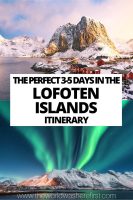
Planning the perfect Lofoten itinerary is a pure joy and an incredible addition to any trip to Norway. Far beyond the Arctic Circle, high up on the wild Norwegian coast, lies the island archipelago of Lofoten.
Majestic mountains pierce the skyline, plunging down onto white sand beaches, hiking trails weave through untamed wilderness, quaint fishing villages dot the coastline and a fascinating history full of Viking tales unfold.
Whether you plan on visiting during the summer or the polar winter, use this Lofoten Islands itinerary to make the most out of your 3, 4 or 5 days in the Lofoten Islands.
Table of Contents
How Many Days in the Lofoten Islands?
7 primary islands make up the archipelago, and unlimited activities to take part in, so deciding how many days to spend in the Lofoten Islands can be a challenge. Because of how remote it is, it can also take up an entire day just to travel there, so bear this in mind when booking time off work and planning out your greater Norway itinerary .
With 3 days in the Lofoten Islands, you will be able to explore the two largest villages, Svolvær and Henningsvær — the latter of which has become recognised worldwide for its football pitch on social media.
You will also have time to head out on the water to explore the fjords and at least one hike to experience some of the incredible views. There is also just enough time to squeeze in one of Lofoten’s jaw-dropping, pristine beaches and go horse riding on day 3.
If you can spare another day to spend 4 days in the Lofoten Islands, you’ll also be able to visit the iconic Viking Museum and ride on one of the traditional wooden longboats. After delving into the island’s Viking history, we then head over to the Lonely Planet’s ‘Best Beach in Europe’ and hike up above it into the mountains.
This cluster of islands off the Norwegian coast is one of the most beautiful places in the world, so ideally, you will want to spend as much time here as possible. With 5 days in the Lofoten Islands, you’ll have time to head down to the southern tip, exploring the town of Reine and the old fishing village at the very end of the archipelago, Å.
There is plenty to do on this side of the archipelago, including some of Lofoten’s best hikes, kayaking, galleries and museums.

Getting To & Around the Lofoten Islands
Take a look at a map of Norway and you will instantly see how remote the Lofoten islands really are. Reaching them is not as tricky as it may seem at first but it may take an entire day of travel, depending on where you are arriving from.
The most efficient way to get to the Lofoten Islands is by plane. The most popular route is to fly into the major airports in Bodø or Harstad/Narvik Airport. From there, during the summer, you can take a connecting flight to a much smaller domestic airport on Lofoten.
There is one in Leknes and another in Svolvaer. If you are travelling outside of the summer or plan on hiring a car anyway, the quickest and most dependable way to travel is to pick up your car from Bodø or Harstad/Narvik then drive across to Lofoten either via the ferry or the bridge.
If you’re coming from another place in Northern Norway, like Tromsø , you can also drive across the bridge to the Lofoten archipelago and avoid the ferry altogether. If you need to rent a car for your trip, you can browse Rentalcars.com to compare prices of major companies.
If you fly into Bodø, you will take the ferry across to Lofoten. This is a 3.5-hour crossing that can get rough and wild in bad weather. So, if you are prone to seasickness, consider flying into Harstad/Narvik and driving across the bridge instead. The ferry does sell out in advance during the peak tourist months, so make sure to book ahead if you opt for this route.
There are no train stations anywhere near Lofoten. The nearest railway is in Bodø. From here, you would need to hire a car to take the ferry. It can be a more affordable option than air travel if you are visiting from Oslo or Trondheim, but you will still need to hire a car so a road trip in Norway is unavoidable.
Whether you are bringing your own car or picking up a hire from the airport, getting around the Lofoten Islands is best done on four wheels. There are buses that link the islands but they are unreliable and during the winter, some only run once or twice a day.
There are hundreds of hiking trails to get around on, including ‘The Long Crossing’ which traverses the Lofoten Islands. It is around 160 km, depending on added diversions and takes roughly 11 days so it’s definitely one of the longest hikes in Lofoten. If you are visiting during summer and want to ditch the motor, this is a truly epic adventure.

3, 4 or 5 Days in the Lofoten Islands Itinerary
Now you know how to get there, it’s time to dive into our Lofoten Islands itinerary. To really make the most out of your time, this schedule is packed to the brim. Full of hikes, cultural centres, beautiful beaches and unique places to visit.
Because the islands are connected by bridges and driving times are relatively short between destinations, you could easily mix and match this itinerary to suit your plans whether you have 3 or 5 days to explore Lofoten.
Day 1 – Svolvær, Trollfjord & Northern Lights
Svolvær .
Svolvær is the ‘capital’ of the Lofoten Islands. It is the largest settlement in the archipelago, so it makes sense to begin our Lofoten road trip here. Nestled between soaring mountains and a serene harbour, this charismatic town is home to a rainbow of fishermen’s cabins lining the waterfront.
Spend the morning strolling around the town. There are several galleries and artisan boutiques as well as a church, an ice bar and an aquarium to explore.
Svolvær is often referred to as the adventure hub of Lofoten. There are several options for day trips from the town, but the most popular is the Trollfjord cruise. Trollfjord, or “Trollfjorden” in Norwegian, is a narrow fjord known for its dramatic sheer cliffs.
The main attraction of Trollfjord cruises is, of course, the breathtaking scenery. As you sail through the narrow fjord, you’ll be surrounded by towering, nearly vertical cliffs that rise dramatically from the water. The fjord is often shrouded in mist and fog, adding to its mystical allure.
There are several vessels to choose from: large cruise ships, fishing boats and much smaller ribs. There is also a silent, electric boat tour so you can hear the sound of the lashing waves and the call of seabirds without a boat engine in the background.
The Trollfjord cruise can also become part of a longer trip out on the sea. Whale watching and fishing are popular day trips from Svolvær. You can see whales from October to January, but if you are visiting over the summer, don’t worry, there are plenty of other animals to spot and wildlife tours to join , such as seals and otters. You can also take this cruise that focuses on sea eagles
Svolværgeita
Lofoten is one of the best places in Europe to go hiking. Towering mountains, pristine white beaches and quaint fishing villages often rolled into one hike. There are hundreds of trails to choose from, but one of the most popular hikes is Svolværgeita or “The Svolvær Goat,” which refers to a pair of distinctive rock peaks that resemble the horns of a goat.
From young adventurers to active seniors, the first peak of Tjeldbergtind is easily accessible, and the path is well signposted from Svolvær town. From this plateau, you will be treated to the most incredible views, not only over Svolvær but across to Vestfjord, the high peaks of Svolværgeitathe and Fløyen. This hike is 2 hours out and back with 360m of elevation.
Beyond this viewpoint, climbers don their helmets and harnesses to tackle the vertical peaks above. If you are not an experienced climber but still want to scale the ‘horns’, you can hire equipment and a guide to take you up from Svolvær.
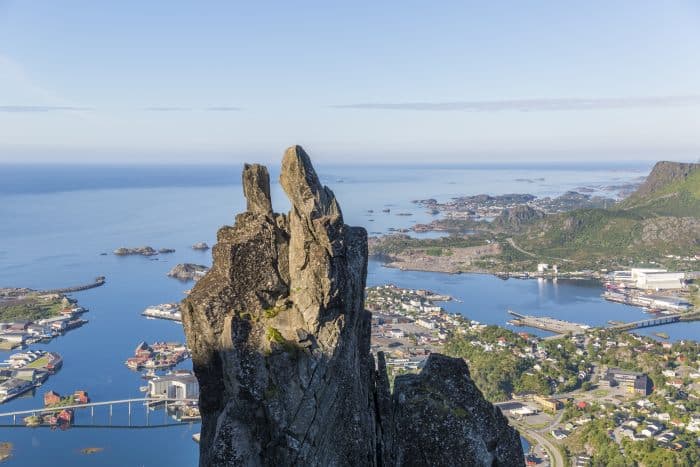
Dinner
It’s no surprise that the local cuisine in the Lofoten Islands revolves around fish. Everywhere you go, you will see traditional outdoor cod drying racks, also known as hjell. The harsh winds and cold temperatures provide the perfect conditions for drying fish.
The most famous dish, especially in Svolvær, is the grilled stockfish. The perfect golden seer on local cod, served with various vegetables, depending on what is available seasonally. For the best grilled stockfish, head to a restaurant that specialises in fish such as Børsen Spiseri.
Northern Lights
Experiencing the Northern Lights, or Aurora Borealis, in the Lofoten Islands is a once-in-a-lifetime experience. The dancing wisps of green, blue and purple glide across the sky, putting on a show for anyone lucky enough to witness it. The aurora are most active from September to March, so if you are hoping to spot them during your trip, you’ll want to avoid visiting during the summer months.
There are several nighttime tours available , which usually include boarding a boat or a minibus to chase the Northern Lights to where they are most visible. If you are a camera enthusiast or want to learn more about night photography, you can even join a photographer on a guided tour.
Of course, you don’t have to join a tour to see the Northern Lights. You could wrap up warm and head out to find them yourselves, but doing it this way, you may miss out on some of the hidden spots only the locals know of.
Day 2 – Explore the Lofoten Coastline
Kabelvåg .
Day two, and it’s time to set off on our Lofoten road trip itinerary. Just a 10-minute drive from Svolvær, you’ll find our first stop, Kabelvåg. Kabelvåg is a charming coastal village known for its rich history.
It is one of the oldest fishing villages in Lofoten, with a history of over a thousand years. It was once a centre for the fishing industry, and remnants of its maritime heritage can still be seen in the historic buildings and docks.
One of Kabelvåg’s prominent landmarks is the Lofoten Cathedral, also known as Vågan Church. This Gothic-style church, built in the 19th century, is one of the largest wooden churches in northern Norway and serves as a cultural and historical focal point for the village.
There are a variety of activities on offer in Kabelvåg. You could discover marine wildlife in the aquarium, learn about the history of Norway’s coastal steamer service, known as Hurtigruten, in the museum or visit the art gallery Galleri Espolin.

Henningsvær
One of the most popular villages in the Lofoten Archipelago is Henningsvær. Recognised worldwide for its football pitch, surrounded by quaint fishing huts and dramatic mountains. It’s an up-and-coming destination, growing in popularity with new art galleries, artisan producers, cafes and restaurants opening every year.
Located on the southern coast of the island Austvågøya, the village is connected to the mainland by a series of bridges, including the famous “Bridge of Henningsvær”. As you drive across, you are greeted by stunning views of the village, surrounding islands, and the Norwegian Sea.
Like many places in the Lofoten Islands, Henningsvær has a rich fishing heritage. The village was historically a hub for cod fishing, and remnants of its maritime history can still be seen in the fishing cabins, docks, and the lively harbour. You can sample some of the fresh seafood in one of the cafes or restaurants.
One of the best ways to experience the magical Lofoten coastline is by taking to the water. Paddle through crystal-clear waters, tracing the contours of rugged cliffs, hidden coves, and charming fishing villages. Glide beneath dramatic peaks that rise from the Arctic Sea, their reflections creating a mirror-like magic.
Whether you’re a novice or an experienced kayaker, there are several routes to discover around the coastline, from serene fjord explorations to thrilling open-water journeys. Encounter wildlife like seabirds and seals, all while basking in the awe-inspiring beauty of Lofoten’s coastal landscape.
There are several kayak rental shops in Henningsvær where you can pick up a kayak and safety equipment. Some of these offer experienced tour guides who can provide insights into the local environment, history, and geography along the way. You can pre-book some experiences such as this half-day tour or this evening tour.
You can head out on a self-guided tour, but make sure to check the weather forecast and wear appropriate clothing. It can get very cold out on the open water, especially if visiting Lofoten during the winter months.
Henningsvær is also the epicentre for climbing on the Lofoten Islands. If you have a head for heights and want to explore some of the notable climbing spots in the vicinity, you can hire equipment and an experienced guide from the village to help you scale the sheer rock faces.
If you are an experienced climber with your own gear, the most iconic routes in the region include Vågakallen, a prominent peak offering a range of climbing routes with varying levels of difficulty or Presten, an iconic granite tower that attracts climbers from around the world, offering both traditional and sport climbing routes.
Day 3 – Explore Gimsøy
After spending the evening in Henningsvær, we are now heading onto the next island in the archipelago, Gimsøy. Seeing as there is no major settlement on Gimsøy, it can often be overlooked and driven through on the main road heading south, but take the long way around and drive the coastal road to discover hidden gems, incredible views and our next stop, Hov Beach.

Hov Beach
Hov Beach is a coastal gem that truly encapsulates the essence of Arctic beauty and it is a must-visit place on any trip to the Lofoten Islands. Its soft, golden sands stretch along the wild Norwegian Sea, framed by dramatic mountains and rolling dunes.
Because it is not on the typical tourist route around Lofoten, it is a much quieter beach than those featured in days 4 & 5, so if you are searching for tranquillity, this is the ideal location.
Horse Riding at Hov Beach
Whilst you could simply stroll along the beach, leaving footprints in the sand, one of the best ways to explore the surroundings is on horseback. Saddle up your Icelandic horse to tolt (the Icelandic version of a trot) through the lapping waves.
Whether you’re a seasoned equestrian or a beginner, Hov Gard Horse Riding Centre has a trek to suit you. Choose from full-day sightseeing treks to shorter beach rides or even Northern Lights tours on horseback.
Låven Restaurant
After riding across the golden sands, you are sure to have built up an appetite. Hov Beach may be off the beaten path, but you don’t have to stray far to find a fantastic restaurant.
Låven Restaurant is housed in a restored barn, offering a cosy and rustic ambience. Savour locally sourced ingredients in dishes that reflect the region’s traditions, including fresh seafood, reindeer, and Arctic herbs.
Hoven Mountain
Perhaps one of the easiest mountain hikes in the Lofoten archipelago, Hoven Mountain rises up 360m from Hov Beach.
Despite the modest elevation and a gentle main trail, the views from the summit are breathtaking. The ascent should take between 1-2 hrs and is accessible no matter what your previous hiking experience. The trail is well-signposted and begins at the golf course.
On a clear day in the summer, you can see across to the islands of Vesterålen in the north. During the winter months, the ascent will most likely be in the dark, but this is a great spot for watching the Northern Lights so make sure to pack a head torch and a picnic blanket.
The trail is well-signposted and begins at the golf course. Of course, if you don’t want to hike, you could always opt to play a round of golf at the world-famous Lofoten Golf Links instead.

Stay in a campervan or tent at Hov
If you are road-tripping in a campervan or travelling with a tent, you can camp at Hov Beach. Hov camping offers incredible views out to the North Sea, with open access to the golden sands and fresh ocean breeze.
They have all the usual facilities, showers, toilets and camper services, along with a wooden sauna you can either book privately or enjoy in a public session.
Day 4 – Viking Museum, Haukland Beach & More!
Lofotr viking museum.
Another 35 minutes along the E10, the main highway through Lofoten, you will be transported on a captivating journey back in time to the Viking Age.
The Viking Museum is centred around the reconstructed Chieftain’s House, a vast longhouse that showcases authentic Viking architecture and artefacts. With so many immersive experiences and historical insights, the Lofotr Viking Museum offers a fascinating glimpse into the lives and legends of the Norse seafarers who once roamed these rugged shores.
Here, you can travel back in time to experience Viking culture, participating in activities like archery, crafting, and feasting on traditional Viking cuisine such as lamb soup and mead.
The museum also boasts a full-scale replica of the Viking ship Gokstad (from the 800s). Subject to the weather forecast, the museum offers a 30-minute sailing aboard this ship, which is included in your admission price. In the event of bad weather, the ship is moored, but you can still go inside to explore.
Unstad Surf Beach
After returning to the present era, it’s time to head on to one of the most iconic beaches in the Lofoten Islands, Unstad. Here, you will find towering mountains, rolling dunes and, most importantly, the world’s most northern surf school.
Lofoten is renowned for its consistent and powerful waves, making it a top destination for both seasoned surfers and novices. The surf scene at Unstad is well-established, with a surf camp and rental facility catering to all levels.
The chance to ride Arctic waves under the mesmerising Northern Lights or the midnight sun is an adventure like no other.
Haukland Beach
If you are not interested in plunging into the North Sea and riding the waves, head on to the next beach on our itinerary, Haukland. This beach holds many accolades, and as soon as you arrive, it’s not hard to see why.
It has been voted as Norway’s Best Beach as well as the Lonely Planet’s most stunning beach in the whole of Europe. Haukland, along with the neighbouring bay Uttakleiv, makes up a true Arctic paradise. Powder white sands contrast vividly with the turquoise Norwegian Sea.
Towering peaks and emerald-green hills envelop the beach, creating a breathtaking backdrop whether you want to relax on the beach, walk along the shore or set up a picnic. This area is also popular among hikers, with several routes starting from the beach.
If you want to view this picturesque coastline from above, the best hike is up mountain Mannen.
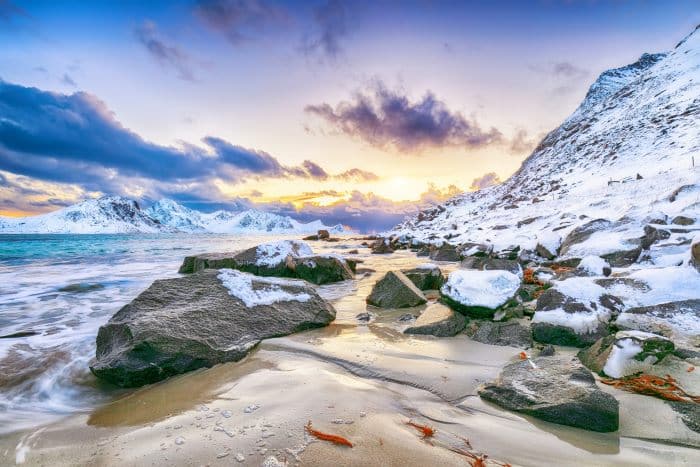
Mountain Mannen
Rising majestically from the sea, Mannen offers an iconic peak to conquer. The relatively short trail meanders through pristine Arctic landscapes, winding up rugged slopes and moss-covered rocks. It is one of Lofoten’s most popular hikes and is a must-visit spot for photographers. As you ascend, the panoramic views expand, revealing the beauty of the surrounding fjords and dramatic coastal vistas.
The entire hike takes around 2-3 hours and is accessible to anyone who is comfortable with a little elevation (around 400m).
Day 5 – Iconic Lofoten Villages
Sund blacksmith.
Day 5 begins with a brief stop-off along the E10 highway. It may look unassuming at first, but the blacksmith museum and shop in the tiny fishing village of Sund is well worth stopping for.
The original blacksmith who built this workshop, Hans Gjertsen is famous for surging through the crowd at the 1963 opening of the E10 road (also known as King Olav V’s Way) to present the king with a hand-forged iron cormorant as a gift.
Now, these metal birds, perched on rocks, are made here all year round. Stand and watch as the blacksmith bends and shapes the red-hot iron to create the long, winding necks of these majestic birds.
You can purchase one of these sculptures to take home and place on your mantelpiece to forever remind you of your Arctic adventure.
As we head further south, the next stop is the picturesque fishing village that could have easily been plucked straight out of a fairy tale. Surrounded by towering granite peaks that plunge straight down into the Norwegian Sea, Reine boasts breathtaking views from every angle.
The iconic red Rorbuer (fishermen’s cabins) lining the harbour paint the village with a splash of colour against the dramatic landscapes.
Reinebringen Hike
One of the most renowned hikes in the archipelago is the Reinebringen hike. Starting in the quaint village of Reine, the trail ascends steeply, offering panoramic views of Reinefjorden, the red Rorbuer cabins, and the surrounding jagged peaks. The terrain can be challenging, with rocky and sometimes slippery paths, but the payoff at the summit is truly breathtaking.
The entire hike is just 3km, but with 510m of ascent and a risk of rockfall, this trail may not be suitable for everyone.
Stone steps lead most of the way up the mountain to both viewpoints. The views from the summit are truly breathtaking. It is a popular hike for good reason. On a clear day, you can see across several islands in the archipelago, including Reine, Hamnøy, and Sakrisøy, with the dramatic, rocky mountains rising from the ocean behind.

The village with the world’s shortest name, Å sits at the southern tip of the Lofoten island archipelago. Pronounced “Aw,” this picturesque fishing village is steeped in history, with its roots dating back centuries as a fishing hub.
With only 123 residents, this quaint village is one of the best-preserved traditional fishing villages in Norway, with a history dating back to the 1800s. Characterised by its distinctive red Rorbuer cabins and traditional wooden architecture, Å feels as if it is truly frozen in time.
As soon as you walk into the village, you are welcomed by the warm, comforting smell of baking cinnamon buns. These sweet treats are one of Lofoten’s most popular dishes, but Å is where you will find the tiny bakery that makes the best cinnamon rolls, Nordlandsbåt.
After sampling the local speciality you could explore the open-air Norwegian Fishing Village Museum or take a fishing tour from the harbour.
Å is the end of the road both literally and figuratively on our Lofoten Islands road trip. It may seem like we have come a long way, but the entire trip is just 2.5 hours of driving from Svolvær to Å. To return to the mainland, you can either drive back up to Svolvær and across the bridge or take the ferry from Moskenes to Bodø.
Where to Stay in the Lofoten Islands
Henningsvær Guesthouse – Located in the village of Henningsvær, this guesthouse is an excellent base when exploring Lofoten. They have a great location for getting around the archipelago, a number of cosy rooms available and a continental breakfast available in the mornings. Click here to check availability
Thon Hotel Svolvær – Luxury travellers visiting Lofoten will love this sophisticated hotel in Svolvær. Perfectly poised for exploring all that these incredible islands have to offer, they have a range of chic and modern rooms available along with plenty of great amenities on offer to guests. Click here to check availability
Lofoten Cabins – Kåkern – These classic cabins located in Ramberg are an excellent option for those looking for a self-catering option while in the Lofoten Islands. They have a range of units available, all fully furnished and equipped with all you may need during your stay. Click here to check availability
Furu Hostel – Budget and solo visitors to the Lofoten Islands will love this highly-rated hostel located in Leknes. They have a range of stylish dorms and private rooms to choose from along with great self-catering facilities and convivial common areas to enjoy. Click here to check availability
Not quite what you’re looking for? Click here to browse more Lofoten hotels!
A true Arctic paradise, a trip to Lofoten is the adventure of a lifetime. The twinkle of the midnight sun, the swirling rivers of purple, blue and green Aurora Borealis in the night sky. Rugged mountains, narrow fjords and pristine beaches. Whether you have 3, 4 or 5 days in the Lofoten Islands, you are guaranteed to fall in love with the incredible scenery. There is nowhere else on the planet quite like it.
Are you planning to visit the Lofoten Islands? Have any questions about this itinerary? Let us know in the comments!

Related Posts:

A Guide to Visiting the Lofoten Islands in Winter

The Perfect 2 to 3 Days in Bergen Itinerary

The Perfect 7 to 10 Days in Norway Itinerary

About Neota Langley
Neota is a writer for The World Was Here First. Born and bred in Cornwall, she can usually be found with hiking boots on, ready to embark on an adventure. For the last 6 years, she has travelled throughout Europe in her self-built campervan with her trusty canine companion, Ivy. She loves exploring France, the Nordics and spending time in Alpine destinations.
Leave a Comment Cancel reply

Tromso To Lofoten: The Ultimate Bucket List Road Trip Itinerary
By: Author Angela Price
Posted on Last updated: March 25, 2024

Norway is one of the most beautiful countries to visit in Europe, and you will see why when you drive from Tromso to Lofoten. In this post, I highlight the most spectacular scenery, beautiful beaches, and remote villages you will see on this epic Northern Norway self-drive itinerary to Lofoten from Tromso.
I have included helpful directions with driving times and an interactive map that follows the route from Tromso to the Lofoten Islands. Find out about driving in Norway, places of interest between main destinations, and places to stay overnight. So, buckle up – you are in for a memorable drive high above the Arctic Circle!
Depending on how far you want to drive, you can adjust this Tromso to Lofoten road trip to suit your preferences. However long you spend visiting the Lofoten Islands, it is one of the best things to do in Norway, and it is definitely one of the prettiest!
This travel guide may contain affiliate links – please read my disclaimer and privacy policy for more information.

Table of Contents
Driving from Tromso to Lofoten – What to Expect
Aside from some of the most incredible mountainous scenery you could imagine and the phenomena of the midnight sun in summer, the drive to Lofoten from Tromso will allow you to stop at traditional fishing villages, stay in a rorbuer, take a wildlife cruise, walk along sandy beaches, eat the freshest seafood, visit a Viking museum, and stand on the most southernly tip of the Lofoten Peninsula to mention just a few activities.
Sounds good? Of course, it does, so let me inspire you with my 12-day Tromso to Lofoten road trip itinerary. It will help you plan a similar trip, including driving times, places to stay and Lofoten attractions to visit along the way.
- Tromso for three nights
- Senja Island for one night
- Svolvaer for one night
- Nusfjord Arctic Resort for four nights
- Lofoten Links for one night
- Harstad/Narvik Airport hotel for one night
Tromso to Lofoten Map
This Tromso to Lofoten map pinpoints all the places I mention in this travel post, from places to stay, attractions to visit and viewpoints to stop at during the drive.
Things to know about driving in Lofoten
- Petrol Stations are few and far between, so don’t let your tank go too low.
- Convenience shops are also hard to find, so stop and re-stock when you see one. Get water, snacks, chocolate, etc., to keep you going during the drive.
- Norwegians drive on the right-hand side of the road.
- Be prepared to go slow behind camper vans in some of the more touristy places. This part of the country is popular for caravanning in summer!
- Be aware of the speed limits on all roads and stick to them.
- Cars must have headlights switched on at all times while driving.
- Many car parks are pay-and-display. Download the EasyPark App so you are ready to pay when you’ve parked up.
Best time to do a Tromso to Lofoten Road Trip
Lofoten is an all-year-round destination; however, the best time to make a Lofoten road trip is in the summer when the roads and countryside aren’t cloaked with snow and driving visibility is good.
Travelling to Lofoten in summer will mean not having to walk around wearing numerous layers of clothes! When I visited in July, most of the days had temperatures in the high 20s, which was a big surprise for us and, so it seems, the local people we spoke to. That said, it was cloudy on a couple of days with light showers, so while not cold, it can be wet. As with summer in the UK, be prepared for all eventualities in Northern Norway.
Day 1 – Fly into Tromso
Three nights in tromso.

We flew from London to Oslo (2 hours) and then from Oslo to Tromso (2 hours). There are no direct flights into Tromso. Getting from the airport is easy by using the airport shuttle bus, which you will find to the right of the arrivals hall. I wouldn’t recommend pre-booking a taxi, as I did that, and it didn’t show up.
We had booked for one night at the Comfort Hotel Express as I knew we would be arriving close to midnight and didn’t want to splash the cash on just a few hours of sleep. It turned out it was a really comfortable room, and the receptionist gave us some good recommendations for coffee shops and attractions to visit in Tromso.
Day 2 and 3 – Exploring Tromsø
Our second two nights were spent at Clarion – The Edge , which is a luxury hotel on the waterfront by the Hurtigruten Terminal.
Other hotels in Tromsø around the harbour include:
Scandic Ishavshotel ,
Radisson Blu Hotel
Clarion Collection Hotel Aurora .
Private rentals like the Red Old House are available in the local neighbourhood.

Tromso is well known as a winter destination where tourists head to participate in snowy activities and see the northern lights , but not so much as a place to visit in summer. Mistake! Tromso is a fantastic summer destination with plenty to see and do.
We spent two full days wandering around town, visiting the botanical gardens, taking the cable car to the top of Storsteinen, seeing the Arctic Cathedral, hunting out the street art, souvenir shopping, visiting the museums and getting our heads around the fact it never goes dark thanks to the Midnight Sun!

Tromso is full of attractions, so I don’t think it will be boring just because it’s high in the Arctic Circle – no, sir! It’s a vibrant place and is a university city, so there’s a young vibe running through the town.
You can read about Tromso in more detail in my post: 16 Great Reasons Why Tromso in Summer Is Worth Visiting .

Day 4 – Driving to Senja
Driving time from Tromso to Senja is 3 hours. Take the E8 out of Tromso, drop onto the E6 at Vollan, and then at Olsborg, drop onto the 855. Continue on the 855 to Finnfjordbotn, then onto the 86, which will take you into Senja. Add extra time for photo stops.
On our last morning in Tromso, we picked up a rental car and headed to the next overnight stop on our Tromso to Lofoten road trip, Norway’s second-largest island – Senja.
There are many reasons to visit Lofoten , and you will see why as you drive further into the Lofoten Archipelago. The further south you go, the more dramatic the scenery gets. There will be a lot of ‘oh wows’ being said on this trip.
Here are the stops we made on our way from Tromso to Senja:
- Ramfjordbotn
- Nordkjosbotn – two supermarkets and a burger joint are here, so stock up on supplies while you can!

One Night in Senja
Senja is often overlooked by travellers who want to stay on the main route and go straight from Tromso to the Lofoten Islands. However, this short detour meant we could stay in a traditional Norwegian lighthouse and visit some of the island’s attractions – it’s the perfect place to spend 24 hours.
Wondering what to do in Senja? You can find out in my post: Senja Norway: How to Spend One Day on Senja Island in Summer .

Want to stay in this lighthouse in Senja? You can book online at Norwegian Wild.

For alternative accommodations in Senja, please check Senja hotel availability and pricing on Booking.com .
Day 5 – Driving to Svolvaer
The driving time from Senja to Svolvaer is 5 hours and 40 minutes. Take the 86 and 855 back out of Senja, drop onto the E6 and continue to Bjerkvik, where you will need to turn onto the E10 into Svolvaer.
A car ferry goes from Grylleford on Senja to Andenes, which can cut driving time. We didn’t use this service as it is not pre-bookable. You have to turn up, and I hope you get on. If you don’t, it could throw your plans out. For this reason, we opted to drive from Senja to Svolvaer.
It’s a long drive from Senja to Svolvaer; however, there are some charming places to stop along the route, and of course, the scenery just gets better and better. Expect to see rivers, lakes, streams, waterfalls, mountains, valleys, and cute red wooden villages dotted throughout the landscape. It’s like a fairytale!
Here are the stops we made on our way from Senja to Svolvaer:
Sir Henrik Waterfall is an easy 15-minute walk in and out of the car park (which is a simple layby). Turn off the E6 onto the Fv161, and the waterfall is close to the Polar Park, which, sadly, we didn’t have time to visit.


This is an interesting stop if you are interested in WW2 historic sites. This Narvik memorial marks the place where the Norwegian army made their first strike back against the Nazi army in 1940.

Husjordoya is an island in the middle of a fjord, which you will cross over via a bridge. We parked up here and went for a little walk along the river, where we came across information boards telling of Viking history and traditions. It’s a really green and picturesque location, as you can see from my photo.

If you are drawn to churches, you’ll spot a red-roofed chapel at the tip of an outlet. Take a quick detour, stretch your legs, and have a look at the 19th-century Sildpollne’s Chapel. It’s very remote and has beautiful lupins nearby (they are a regular sight in Lofoten).

Svolvaer – capital of the Lofoten Islands
One night in svolvaer.
After a day of driving, we officially arrived in the Lofoten Islands at Svolvaer. We checked in for one night at the Thon Hotel Lofoten , a modern building on the waterfront.
For alternative accommodations in Svolvaer, please check Svolvaer hotel availability and pricing on Booking.com .
Svolvaer wasn’t exactly what I imagined it would be. I had a picture in my head of a traditional mountain town similar to Tromso. It wasn’t – and I felt a little underwhelmed by its concrete buildings and parking lots, which made a blot on the otherwise incredibly beautiful landscape.

Nevertheless, Lofoten’s capital is a working port, has some good restaurants and is where you can board a cruise to the inner Trollfjorden, making it a tourist hotspot. It has red wooden cabins, which Lofoten is famous for, and a park with an interesting and unexpected art trail, so it’s a place you either warm to or choose to drive on through.

Day 7 – Driving to Nusfjord Arctic Resort
The driving time from Svolvaer to Nusfjord Arctic Resort is 1 hour and 40 minutes ( allow extra time for photo stops ). Take the E10 out of Svolvaer and continue on for around 90 minutes until you see the sign for Nusfjord. Turn onto the Fv807 and continue straight into the resort, where the road stops.
This part of your road trip in Lofoten will be completely incredible. Expect to see beautiful Lofoten beaches with golden sands that wouldn’t look out of place in the Caribbean. See mighty mountains rising from inky lakes and sea inlets, drive past waterfalls, and, of course, visit a traditional fishing village and see the fjords that make up the Lofoten islands. If you have ever travelled to New Zealand and found the scenery amazing, Lofoten is like NZ South Island but on steroids!
Here are the stops we made on our way from Svolvaer to Nusfjord Arctic Resort:
- Rorvikstranda
Henningsvaer
- Bostad (you will pass back this way on the return journey)
- Haukland Beach
- Uttekliev Beach

Henningsvaer was one of my favourite places we visited during our Lofoten to Tromso trip. We spent around two hours wandering around this beautiful island, browsing its cute shops, stopping for coffee, cakes and beer, taking hundreds of photographs and checking out its football pitch – one of the world’s most famous due to its location. If you are a football fan, you will want to see this pitch!


Nusfjord Arctic Resort – Lofoten’s Historic Fishing Village
Four nights in a traditional fisherman’s rorbuer on stilts (you could reduce nights spent here to save time – however, you probably won’t want to!).
If you love unique places to stay, Nusfjord Arctic Resort is a must. All the buildings are original traditional structures, from the fisherman’s cabins (rorbuer) to the bakery and the fish processing barns.
Almost everything in the resort is historically authentic, making a stay here so special. In fact, if you watch BBC’s Amazing Hotels: Life Beyond the Lobby, you may have spotted this magical Lofoten resort being featured.
Day One – Arrived in the evening, headed for dinner at Karoline Restaurant and snuggled up in our fisherman’s rorbuer.
Day Two – Explored the village and learned about the history of Nusjord. Relaxed in the outdoor spa and enjoyed fabulous food.
Day Three – Took a private boat out to the fjords for half a day. Spent the rest of the day in the rorbuer relaxing with a book and wine.
Day Four – Drove to the most southern point of the Lofoten Peninsula, the village of Å. On route, we took photos of Reine from the bridge and had lunch at Lofoten’s one and only Anita’s Seafood Restaurant .
Pricing and availability for Nusfjord Arctic Resort on Booking.com.


Wondering what to do in Å? You can find out in my post: What To Do In Å: Lofoten’s Most Remote Preserved Fishing Village .
Day 11 – Driving to Lofoten Links
Today should have been the end of our time in the Lofoten Islands, and we should have been catching a plane from Leknes Airport to Oslo. Sadly, that wasn’t going to happen.
On our last day, we heard SAS Airlines had gone on strike, and the next flight we could get was four times as expensive and would be in two days’ time with Norwegian Air. Not ideal as we had plans in Oslo, but like all good travellers, we got on with the job of scouring the internet to find somewhere to stay for the next two nights.
We went to Lofoten Links for one night – a golf course and accommodations in Gimsoya.
And we stayed at the Aiden Hotel by Best Western at Narvik Airport the other night.
The driving time from Nusfjord Arctic Resort to Lofoten Links is 80 minutes (allow time to stop at Lofotr Viking Museum). Take the road out of Nusfjord Arctic Resort, continue on the E10, and cross the bridge at Sundklakkstraumen bru (I have plotted it on the map). Turn onto the Fv861 and continue to Saupstad, where the Fv862 takes over. Then it’s straight into Lofoten Links.
Here are the stops we made on our way from Nusfjord Arctic Resort to Lofoten Links:
Vikten is a beach village with red cabins dotted along the shoreline. We stopped here to visit the glassblowing studio , and I’m glad we did. I came home with a beautiful pink glass heart as a souvenir.
You can watch the glass-blower at work creating beautiful bowls, vases and hearts and then grab refreshments from the on-site cafe. Afterwards, wander along the beach and see the glass ornaments that are welded to the rocks.

Bostad – Lofotr Viking Museum
If my original flight hadn’t been cancelled, the Viking Museum wouldn’t have made it onto my itinerary due to time limitations, so getting the chance to visit it was great. It is a superb museum with a reconstruction of a Viking Longhouse on the grounds.
Step inside the longhouse and see how the Viking chieftain lived. You can dress up, play games, and, for a little extra, buy soup, bread and mead to enjoy at the wooden table that runs along the wall in part of the longhouse.
Afterwards, follow the path through the fields and down to the river, where you can sail around the lake in a scaled reconstruction of the Viking ship that is displayed in the Oslo Viking Ship Museum.
On my sailing, things got out of hand when the wind turned, and the sails became hard to control. I had visions of swimming back to land. All turned out well and added to the fun. You can also try axe throwing for free.

Lofoten Links
After a full day, we arrived at Lofoten Links in the evening. You can read about my stay at Lofoten Links in this post: Lofoten Links: Lodges and Golf in the Arctic Circle . It will give you a better idea of the accommodation and what to do there.

Day 12 – Driving To Harstad Narvik Airport
The driving time from Lofoten Links to Aiden Hotel at Harstad Narvik Airport is 3 hours . Take the E10 all the way to the airport.
Before we left Lofoten Links, we had a lovely morning walk along Hov Beach and then hopped in the car for our last drive before returning it to the airport.

We chose not to stop as we passed back through places we had already been, like Henningsvaer and Svolvaer. It was a straight drive to the hotel this time, with some dinner and an early night.
Day 13 – Flight from Narvik to Oslo
After a comfortable night in the Aiden Hotel , we called a taxi for the 5-minute journey to the terminal. Yes, you read that correctly! There is no way to cross from the hotel to the terminal as the wide main road (E10) is between you and it. So we had no choice but to call a taxi which charged us £50 for the 5-minute ride.
We felt very ripped off. This was a joke, even knowing how expensive it is in Norway; however, it was a case of paying up or watching the plane depart without us. After being stranded for two extra days, we were ready to be on our way, so we paid up and headed to Oslo for three days . Oh, and in case you are wondering, only two taxi firms are in the area, so they can charge what they like! It’s a shame our Tromso to Lofoten road trip ended on a sour note, but it would never detract from the enjoyment we had experienced in Northern Norway on this marvellous journey.

Is a Tromso to Lofoten Road Trip Worth Doing?
Yes, yes, and yes again! I have been fortunate to travel to amazing countries and see amazing sights, but Northern Norway has to be at the top of my list. Its raw natural beauty is spellbinding, and journeying through its mighty landscapes under the midnight sun is an experience I will never forget. Where else but in the Arctic can you sit on a beach close to midnight, and it’s still light?
Norway is one of Europe’s most mountainous countries, and its fjords are undoubtedly breathtaking. So do yourself a favour and visit Northern Norway and uncover its Nordic magic on a Tromso to Lofoten Bucket List Road Trip; you won’t be disappointed!
Please PIN for Future Travel to Norway

HEADING TO NORWAY? CHECK OUT MY TRAVEL GUIDES ↓
Oslo Travel Guides
Is Oslo Worth Visiting? Here Are 16 Reasons Why You Should Visit Oslo in Norway
10 Best Things to Do in Grünerløkka: Oslo’s Quirky Neighbourhood
8 Best Things to See in Tjuvholmen: Oslo’s Modern Art Neighbourhood
Damstredet: Prettiest Street in The Heart of Oslo
Vigeland Sculpture Park in Oslo: Norway’s Most Unusual Tourist Attraction
How to Visit the Oslo Fjord Islands in Norway: the Perfect Island Hopping Guide
Do you need to arrange travel insurance, car hire or accommodation? Please check out my travel resources page to help you plan your trip.
I would like to receive occasional updates and new travel posts.
Notify me of follow-up comments by email.

- Hawaii Islands
- Philippines
Lofoten Road Trip I The Perfect 7 Day Itinerary
For years we have been dreaming of a Lofoten road trip. The Lofoten Islands in Northern Norway are one of the biggest scenic highlights in Norway. As much as we appreciated Norway’s south on our southern Norway road trip , a Lofoten road trip is a completely different experience . The nature highlights you can experience at every corner are something you would definitely not expect north of the Arctic Circle. Here you can expect imposing mountains, strenuous hikes, picturesque wooden cabins and, of course, powdered sugar beaches that look like in the Caribbean .
The water is so clear that you can see several meters deep down to the bottom of the sea. Lofoten Islands are simply beautiful and unique in Norway. A road trip to the Lofoten has always been our dream since we been to Norway for the first time. Only the extremely long journey from germany has deterred us for a long time.

We are Sabrina and Andreas, two adventurous travelers who never miss an opportunity to discover the world. Whether by plane to distant countries or with our campervan Bruno, we just love to travel. We hope to give you helpful tips for your next trip on our blog.
Sabrina & Andreas Globetrotters, Travelers, Adventurers

Lofoten Itinerary Overview
Campervan or motorhome rental in lofoten.
If you don’t have your own motorhome or campervan, then you will probably want to rent one locally in Lofoten. This makes most sense in Tromsø, since there is also a large airport. From Tromsø you drive about 5 hours to the Lofoten, so you should plan one day for the journey. If you want to rent a camper in Lofoten, you should check out Arctic Camper .
Wild Camping in Lofoten
The best thing about camping in Norway and especially on the Lofoten Islands is the possibility of wild camping. Due to the right of roam in Norway it is possible to camp in the middle of nature with your camper. So you don’t necessarily have to go to a campsite in Lofoten, but you can choose a wonderfully secluded spot by a fjord or directly on the coast. You only need to follow a few rules, such as:
- do not camp on private property
- keep 150 meters distance from residential houses
- do not stay longer than 2 nights at a time
- do not leave garbage
In general, however, wild camping is seen quite casually in Norway, although strictly speaking, the right to roam does not apply to motorhomes and campervans. Most campers abide by the above rules and so also the locals accept the annually increasing number of campers.
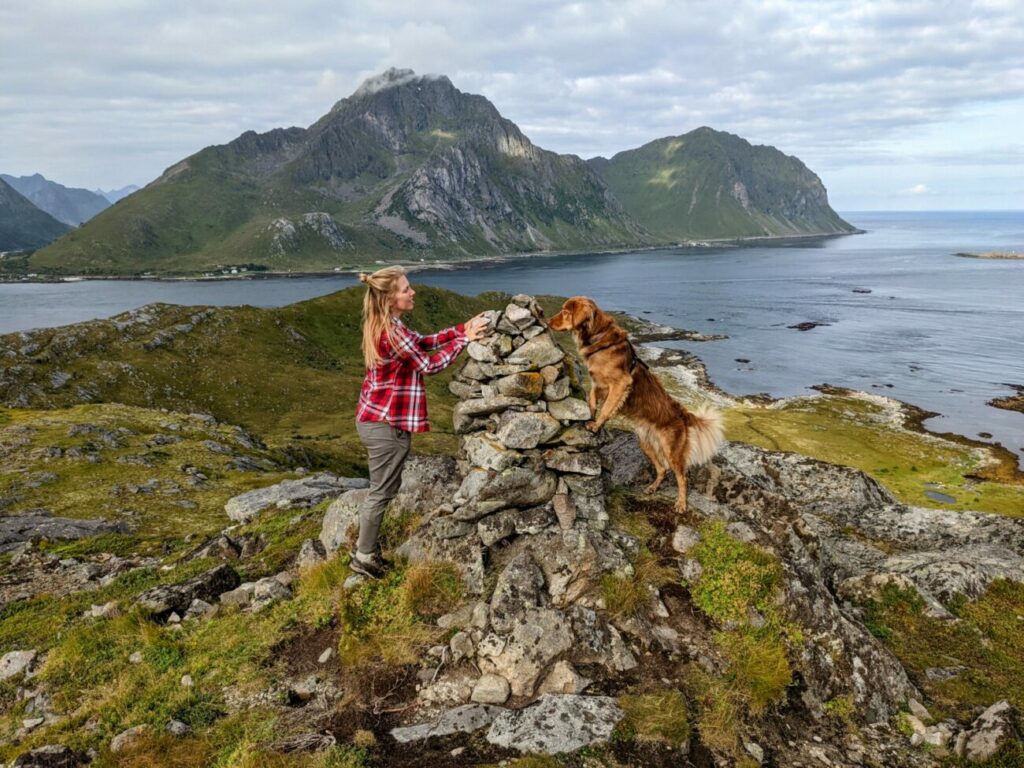
There are really many free spots in Lofoten where you can wild camp. Unfortunately, there are also many tourists who travel with a camper and also look for sites in nature. So it can be quite difficult, especially in the southern part of Lofoten, to find a free place to stay overnight.
You should look for a place before 5 pm, especially in the high season, so that you can still find one. Otherwise it can be quite difficult. We used the app Park4Night during our Lofoten road trip. Here you can choose from an almost infinite number of parking spaces. Most of them have reviews and photos, so you can find the best place to stay in Lofoten.
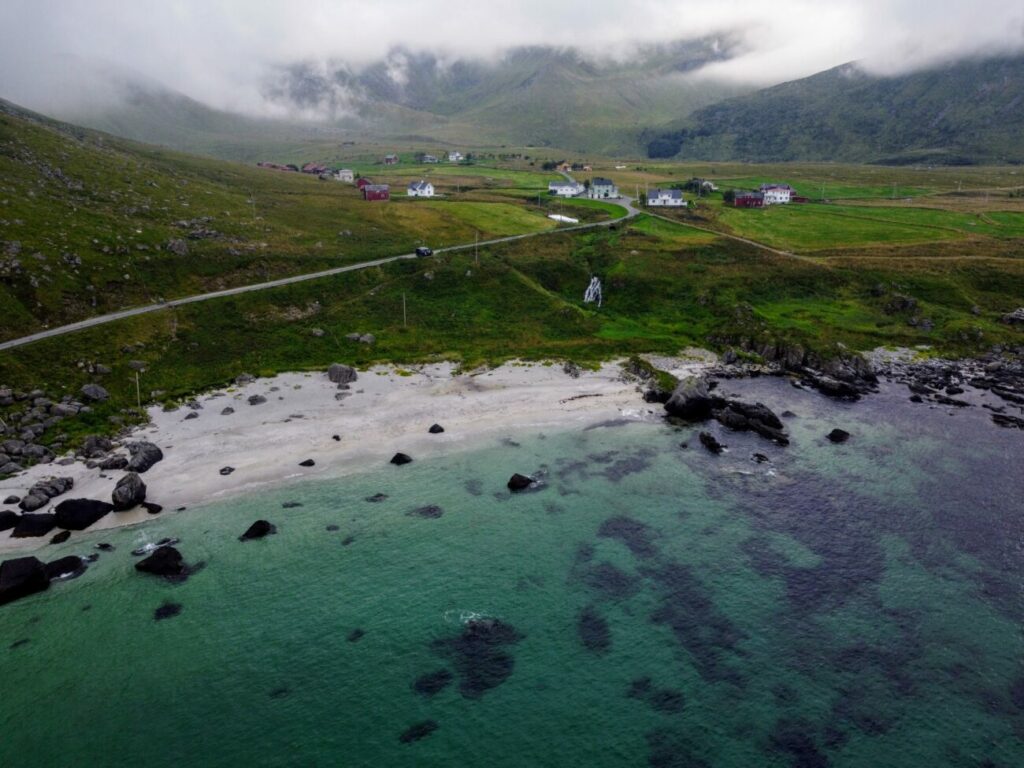
How many Days for a Lofoten Road Trip? 7 or 14 Days Round Trip?
We think that (provided the weather is good) you can see the best things to do on the Lofoten in 7 days. But of course it is no problem to spend 2 weeks in Lofoten. There are so many beautiful hikes and beaches in Lofoten that you can easily fill 14 days or more. But if you travel from Germany with your own car, then you will hardly have more than a week for your Lofoten road trip. But this is not bad, because the archipelago of Lofoten is relatively small.
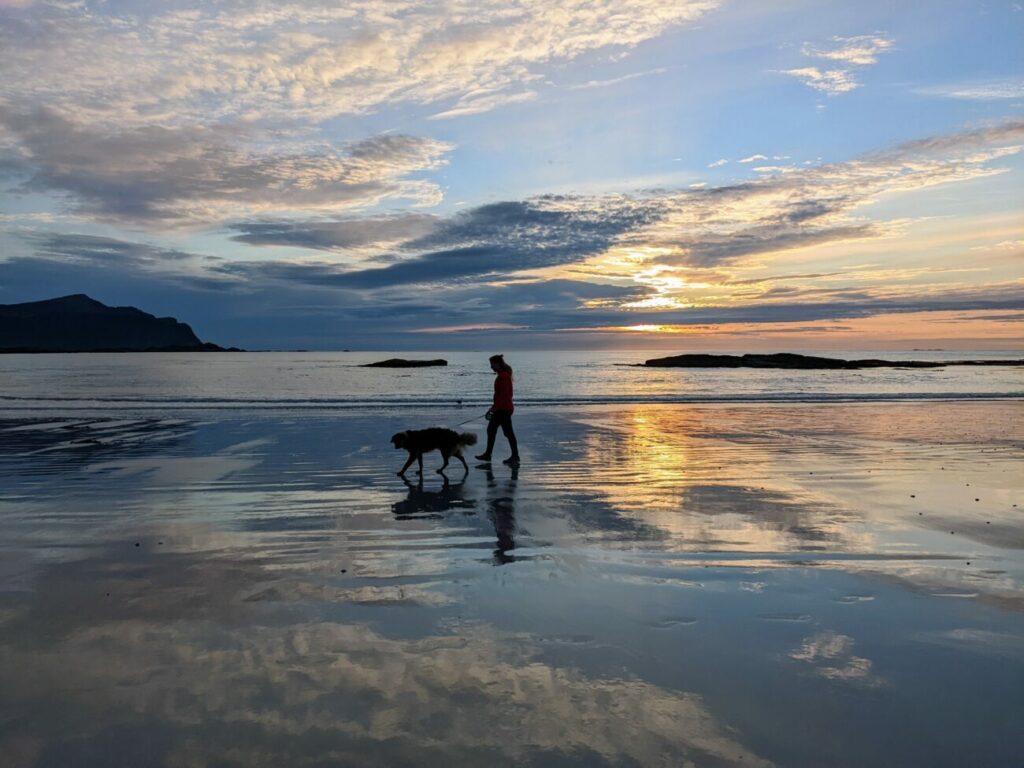
From Lødingen in the east of Lofoten to the town of Å (yes, it’s really called that ) it’s only 240 km for which you need just under 5 hours. You could even cross the Lofoten in one day. But then you have not seen much and have not discovered the numerous side roads and branches.
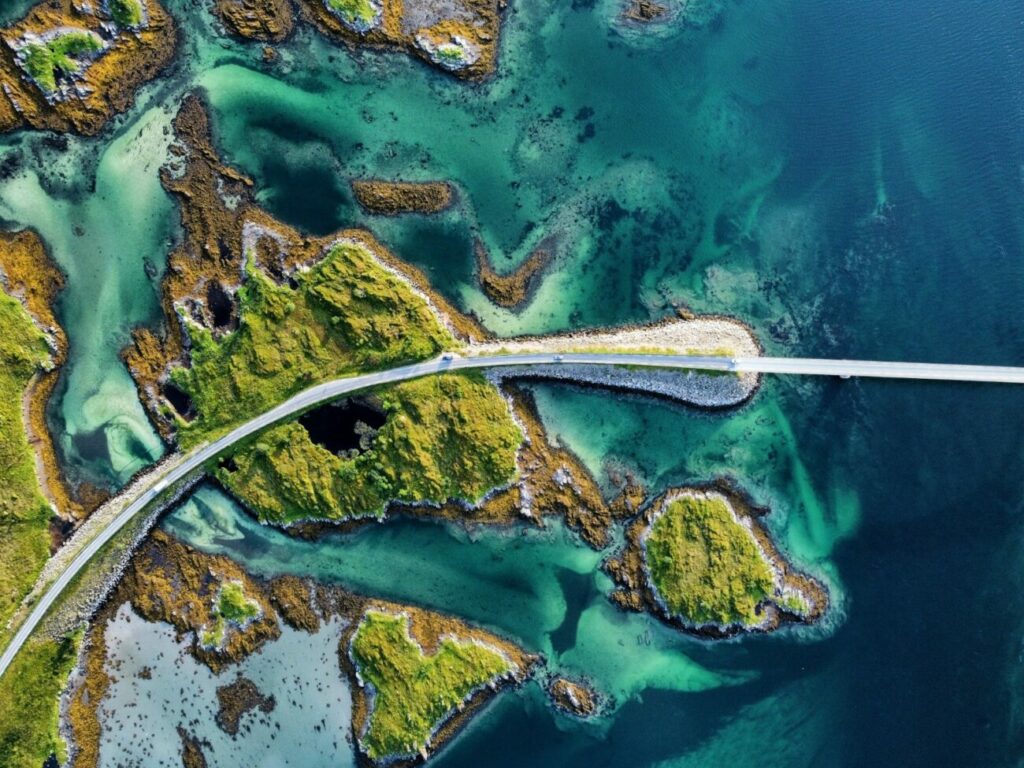
The Norwegian Scenic Route Lofoten
There are not many roads in the Lofoten, and therefore not many possibilities to plan your road trip across Lofoten. But there are a lot of side roads and byways, which also offer great things to do. A very good basis for a Lofoten road trip is the European Road E10, which forms a large part of the Norwegian Landscape Route Lofoten .
Norwegian scenic routes are particularly scenic roads that lead through special areas and are wonderful as a basis for planning a road trip. The Lofoten Scenic Route corresponds to the European Road E10 and leads from Å to Raftsundet with detours to Nusfjord , Uttakleiv and Eggum. If you follow this route you can’t go wrong and you will automatically pass the most beautiful Lofoten highlights.
Lofoten Round Trip or North/South Crossing
If you want to make a real round trip on your Lofoten road trip and leave the Lofoten Islands via the same ferry port that brought you to the archipelago, then it makes sense to take the “main road” E10 for one stretch and to use the numerous side roads for the return trip.
This way you will get the most comprehensive insight into the nature of Lofoten. Alternatively, you can also enter Lofoten via the northern ferry port in Lødingen and leave again in the south via Moskenes. Thus, you do not drive any road more than once.
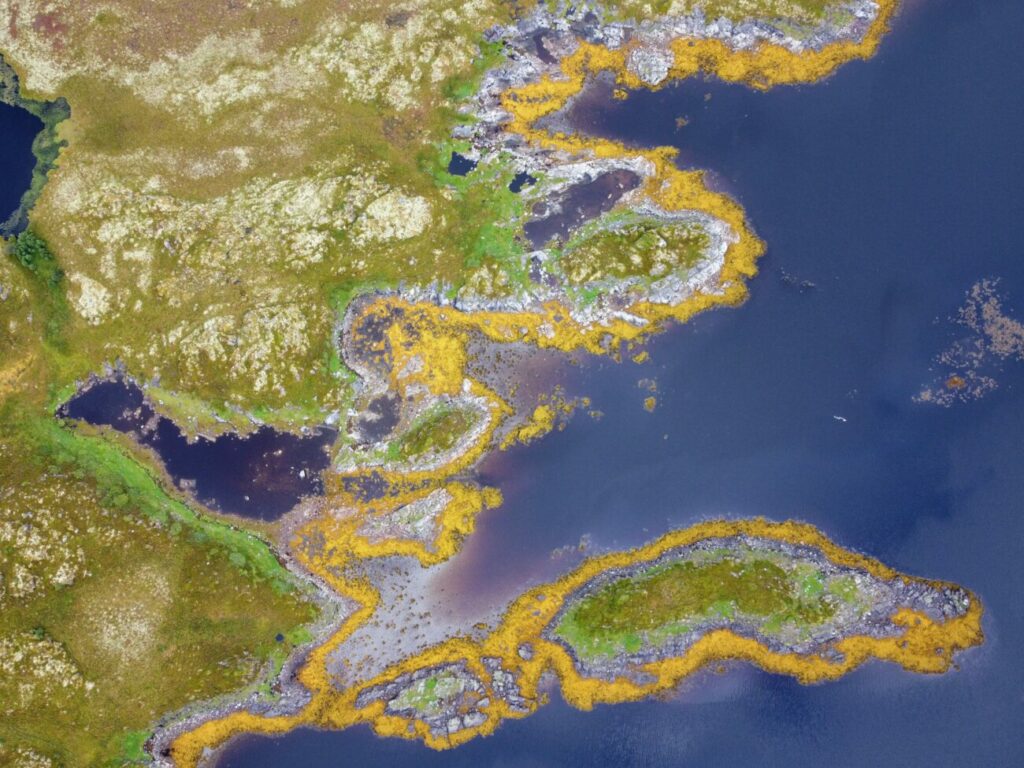
We would recommend you to make a round trip out of your Lofoten road trip and to leave the archipelago from the same ferry port. Driving the lonely side roads is especially fun on the Lofoten Islands and offers special scenic views. Since there are also many must sees on the main route E10, you will not miss any of the places worth seeing.
Where are the most beautiful places in Lofoten?
During our research for our Lofoten road trip, we spent a long time researching the best things to do in Lofoten and finding out which corner of Lofoten is actually the most beautiful. We can now clearly say that Lofoten becomes more and more spectacular the further south you go.
In the north of Lofoten (from the ferry port in Lodingen to Raftsund) the landscape is similar to the rest of (Northern) Norway and you would not even suspect that you are in Lofoten. By the way, the Norwegian Scenic Route Lofoten also starts from Raftsund and here the landscape slowly starts to become really interesting and then also extremely beautiful.
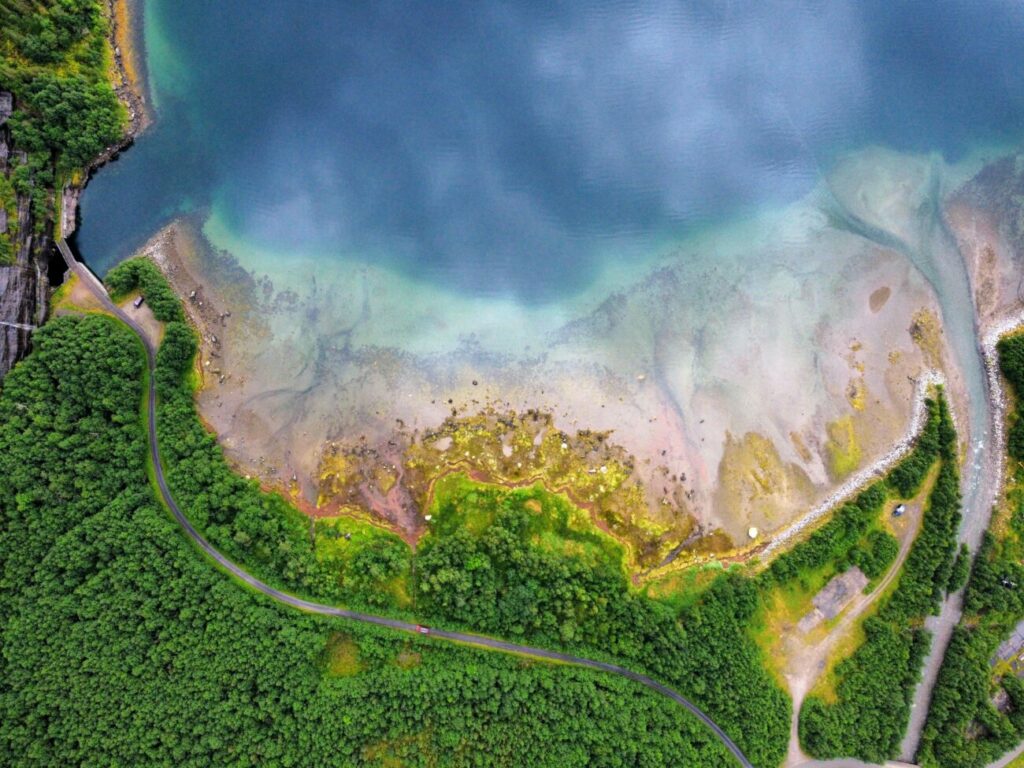
The typical picture that most people have of Lofoten, you will find more in the deep south of Lofoten in small towns like Reine , Hamnoy and Å. Here it looks like on the postcards you might have received from friends. So if you have extremely little time in Lofoten, you should spend it in the south of Lofoten.
Our Lofoten Road Trip
In our Lofoten itinerary you cross the archipelago once from north to south and enter Lofoten at the small ferry port in Lodingen. You can also do the Lofoten road trip the other way around and if you want to spend more than one week in Lofoten, we have planned a few optional days for you.

Mit dem Laden der Karte akzeptieren Sie die Datenschutzerklärung von Google. Mehr erfahren
Karte laden
Google Maps immer entsperren
Day 1 | Ferry Port Lodingen to Laukvika
When you leave the ferry in Lodingen on the first day of your Lofoten road trip, you turn directly onto the European road E10. This road crosses Lofoten from north to south. After about half an hour, the Norwegian Scenic Route Lofoten begins almost imperceptibly in Raftsund.
You continue to follow the E10 and turn off at Arnoya on the road 82 and then follow the road Midnattsolveien. This is much narrower and much less traveled than the main route E10, but offers some beautiful phot spots and landscapes.
If you want to see the Lofoten Islands from another perspective you can also do a cruise around the beautiful Trollfjord in this area *. In this way you can see the beautiful scenery from the sea. this is a total unique experience and definitely a must do on the Lofoten Islands.
Lofoten Island Trollfjord Cruise | Check Prices*
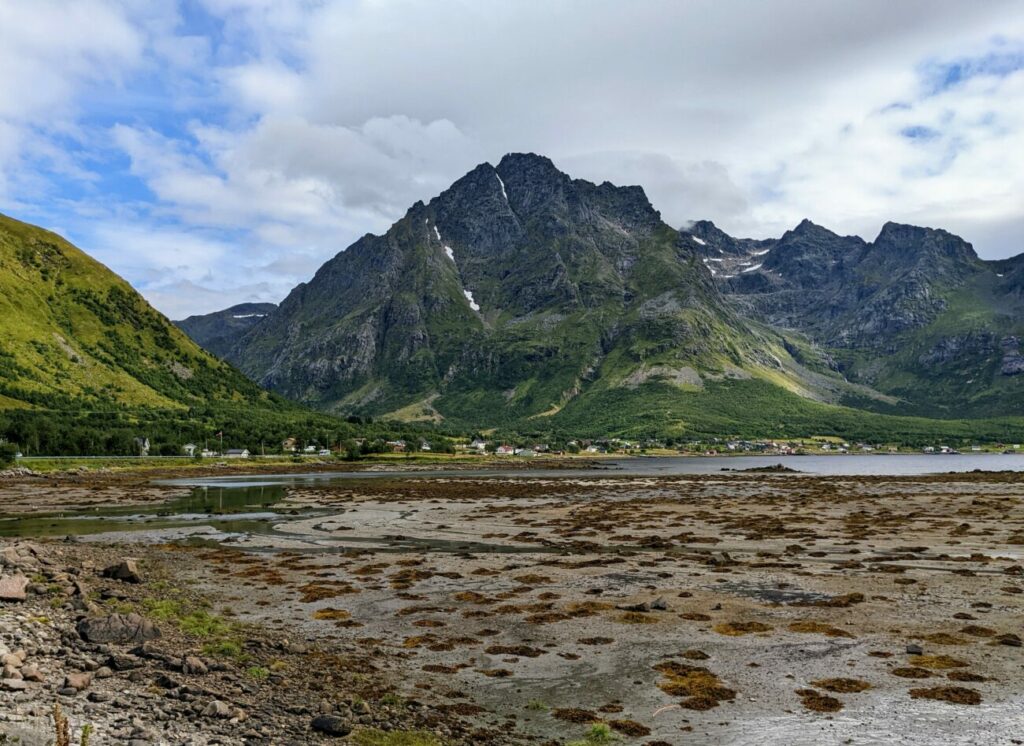
You will first pass the beautiful Hessand Beach, where are unfortunately only extremely few parking spaces. If you find a parking space, you can enjoy an almost untouched beach.
You drive closely along the coast and pass a rather unknown sight: Rolfs Bar . It is located right next to Grunnfør Bicycle Shelter, where you can also park your car. Rolfs Bar is not a real bar at all, it just looks like one, and a really rustic one at that. It’s an old, rickety wooden hut right by the sea, where visitors have placed numerous bottles of spirits and signed a guest book.
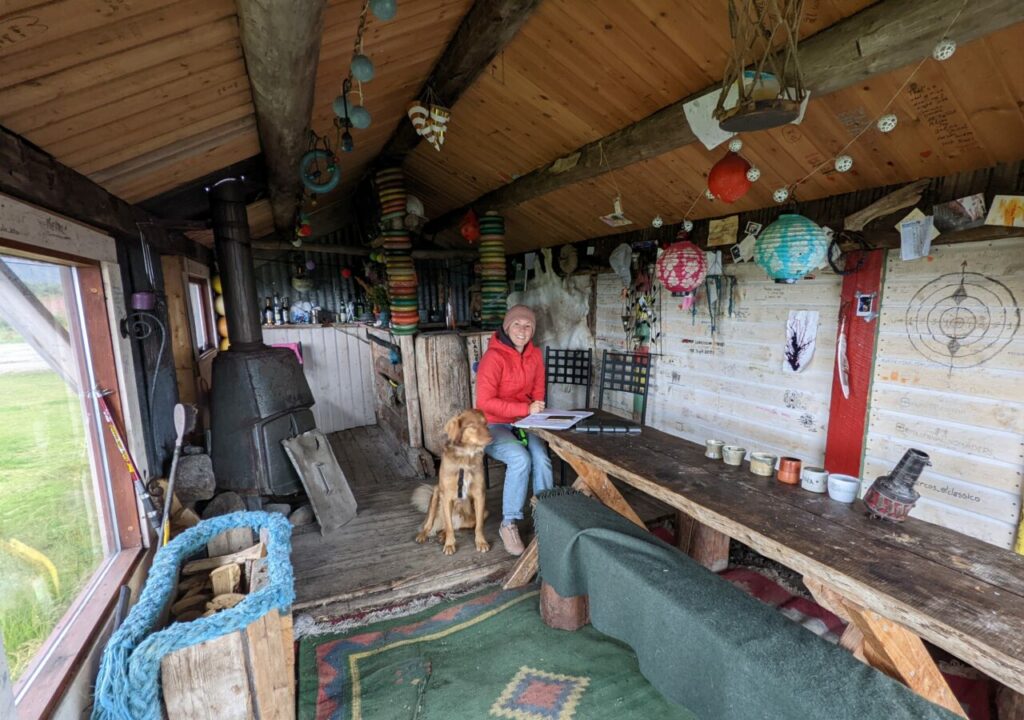
If you continue along the coastal road, you will pass the starting point for the hike to Mount Matmora (Google Maps ), which is a tough one with 1000 meters of elevation gain and a length of 17 km. Alternatively, you can also climb the Delpen, which is only 377 meters high. Today’s destination is the campsite (Bobilcamp) in Laukvika.
Overnight Tip
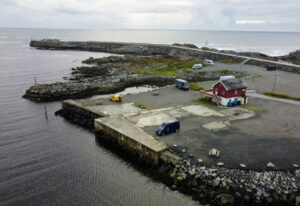
Location : Google Maps
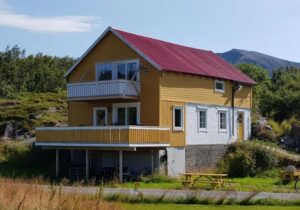
Farmer Apartments Laukvik | Show Prices*
Day 2 | Drive to Henningsvær
Today we drive back to the European road E10 and there we pass the resting area Austnesfjorden (Google Maps ). It’s strange to recommend a resting area as a place of interest , but you should stop here and take a look at the view. From the parking lot, a short path leads to a hill that gives you a great view of the fjord and the surrounding mountains.
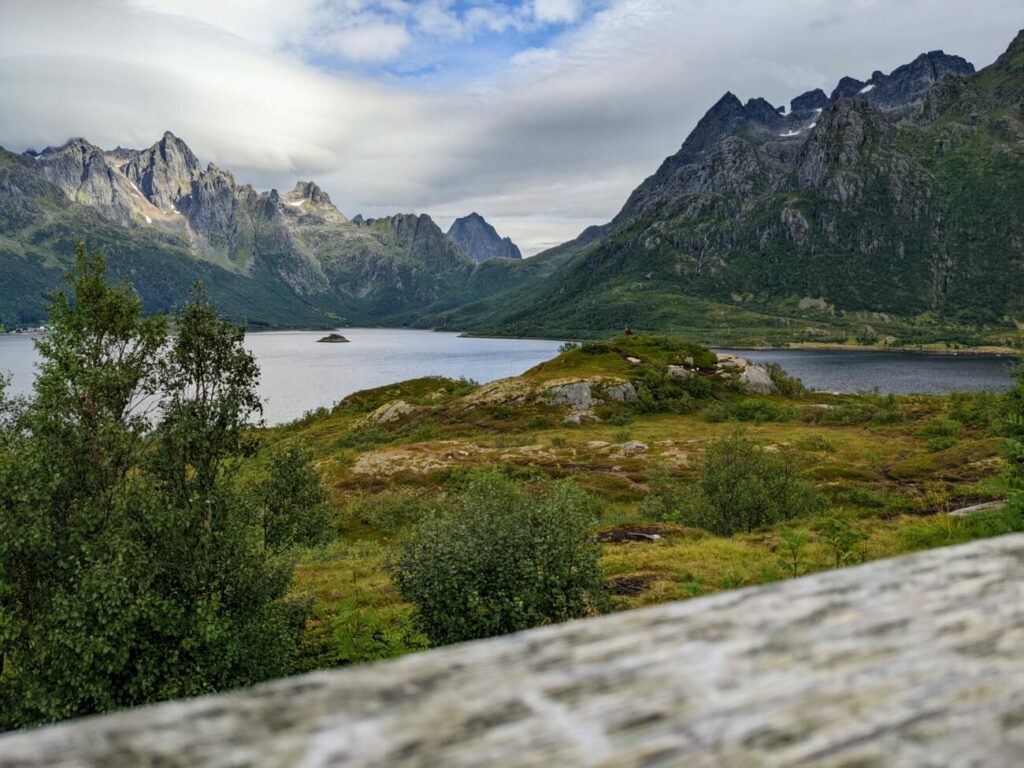
If you continue on the E10, you will pass the town of Svolvær, the capital of Lofoten . There is not much to see here. But you can take the opportunity to refuel and buy food.
Henningsvær
After a few more kilometers you will come to the first highlight of Lofoten, the mini village Henningsvær. The village has only 500 inhabitants and is spread over many small islands. Already the drive to Henningsvær is great, because you drive over some bridges high above the sea and the water is so incredibly clear that you can hardly believe it.
Shortly before the actual place there are already some parking lots, but you can drive past quietly to look for a free place in the city center. We parked directly in town on a small paid lot (Google Maps ), which you can pay very easily with the app EasyPark.
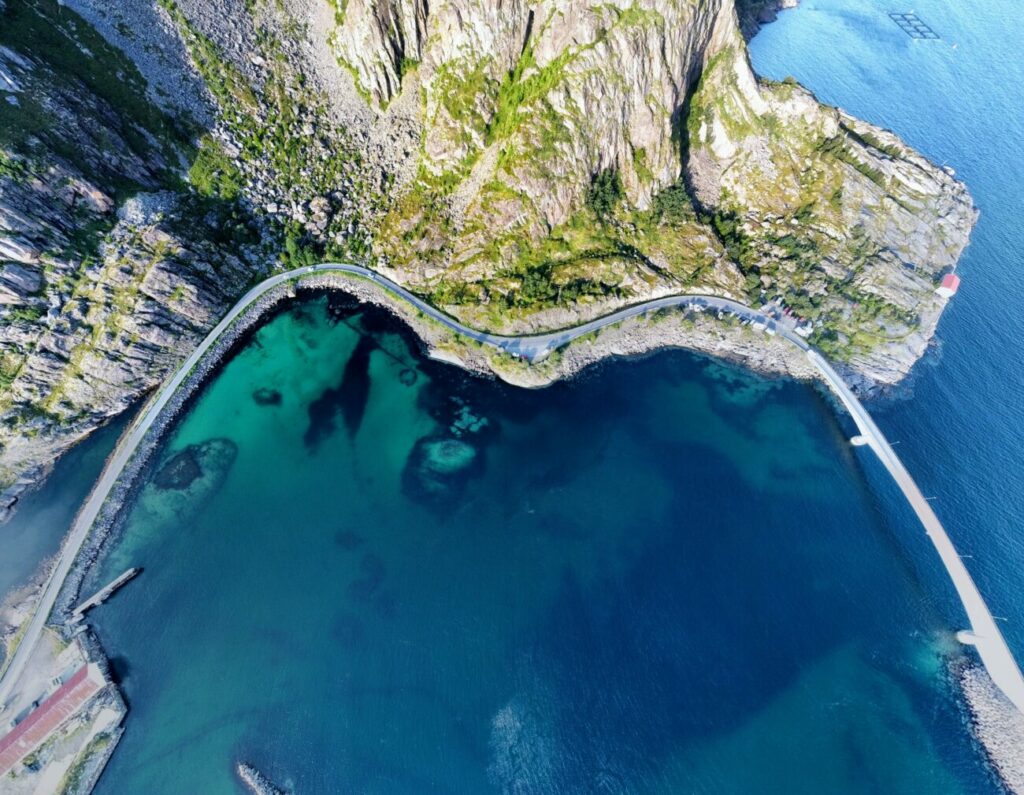
Henningsvær is a very cute little town with a nice pedestrian zone, a nice big harbor and many cute shops. Just park your car and walk a bit through the place to get an impression
The Soccer Field
But the real highlight – and the reason why most people come here – is the soccer field of Henningsvær. It’s actually a normal place where young people play soccer. But it is so spectacularly situated on a small rocky island that some people already call it the most beautiful soccer field in the world .
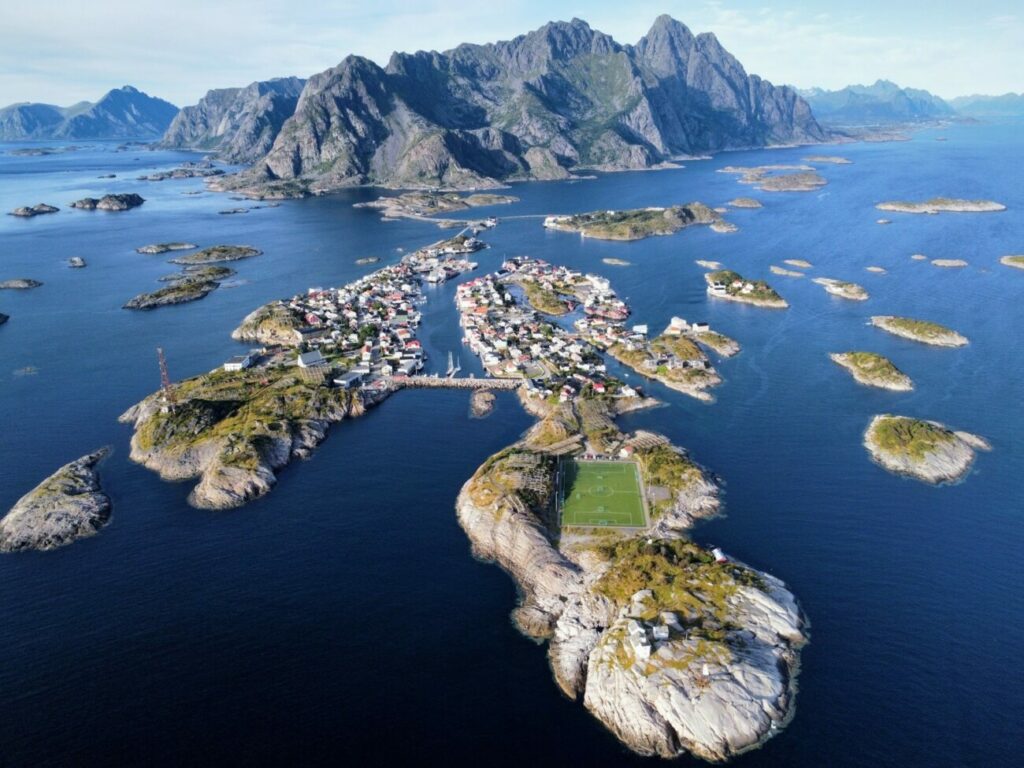
Of course, the field looks much more spectacular from a drone than from the ground, but you should still take a look at this sight from below.
Near Henningsvær there is Kabelvåg Feriehus and Camping. Here, as the name suggests, there are cottages and the possibility to camp. The sanitary facilities are new and clean and the site is beautifully situated.
Location : Google Maps Booking.com : Check prices*
Wooden Cabins
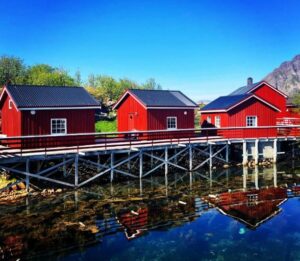
Henningsvær Rorbuer Wooden Cabins | View Prices*
Day 3 | Eggum, Haukland & Uttakleiv Beach
Today is a beach day and we first head to the secluded Eggum beach. Eggum is an extremely small village a bit off the E10 scenic route. To get to the beach (Eggum Picnic) you have to drive over a private road and pay 40 NOK into a mailbox. There is no possibility to pay with credit card here.
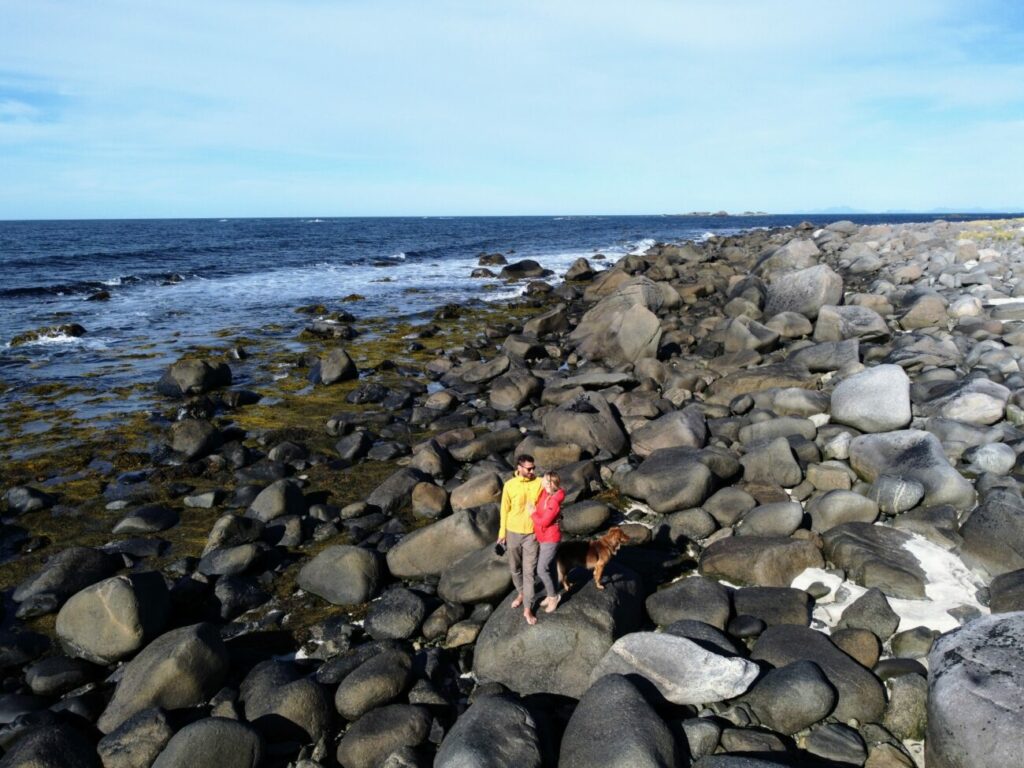
After a few kilometers you come to a parking lot from where it is only a few meters to the beach. The beach does not consist of powdered sugar sand as usual from the Lofoten, but of thousands of extremely large and round washed boulders. You can scramble around on the boulders.
Haukland & Uttakleiv Beach
From Eggum we continue to the famous Haukland Beach. Haukland Beach is probably one of the most famous beaches in Lofoten. It offers a true postcard motif with its powdered sugar sand and the mighty mountain massif in the background. Here you find the exactly 400 meter high Mountain Mannen, on which a relatively easy hiking trail leads.

From Hauklland you should take the hiking trail to Uttakleiv beach behind the Mountain Mannen. Here you can walk along the beautiful coast in about 1 hour to the other beach. The route is just under 4 km long and completely flat and is therefore suitable for everyone. The Uttakleiv beach is again a real Caribbean beach and spoils you with fine, golden sand and turquoise blue water. At Uttakleiv Beach you can also stay overnight with your camper.
At Uttakleiv beach you can also spend the night. You can simply choose a nice place for the night at the official parking lot. You can also pitch tents here. You pay 250 NOK per night and fall asleep with an amazing scenery in front of your eyes.
Beach Villa
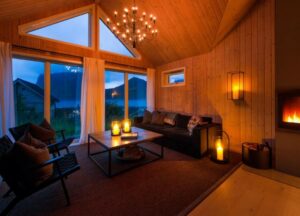
Haukland Beach Panorama | View Prices*
Day 4 | Offersoykammen Hike
Today its time for the first hike and with Offersoykammen there is a relatively unknown mountain to climb. The Offersøykammen hike is nevertheless a very special one in Lofoten, because from the summit you have a spectacular 360 degree view of the numerous peaks of Lofoten and the Haukland Beach you visited the day before.
Offersoykammen is 436 meters high and can be climbed (including the way back) within 4 hours. The degree of difficulty can be classified as medium. Difficult is, however, that the hiking trail is not signposted at all and you should therefore be very careful that you take the right path and do not get lost.
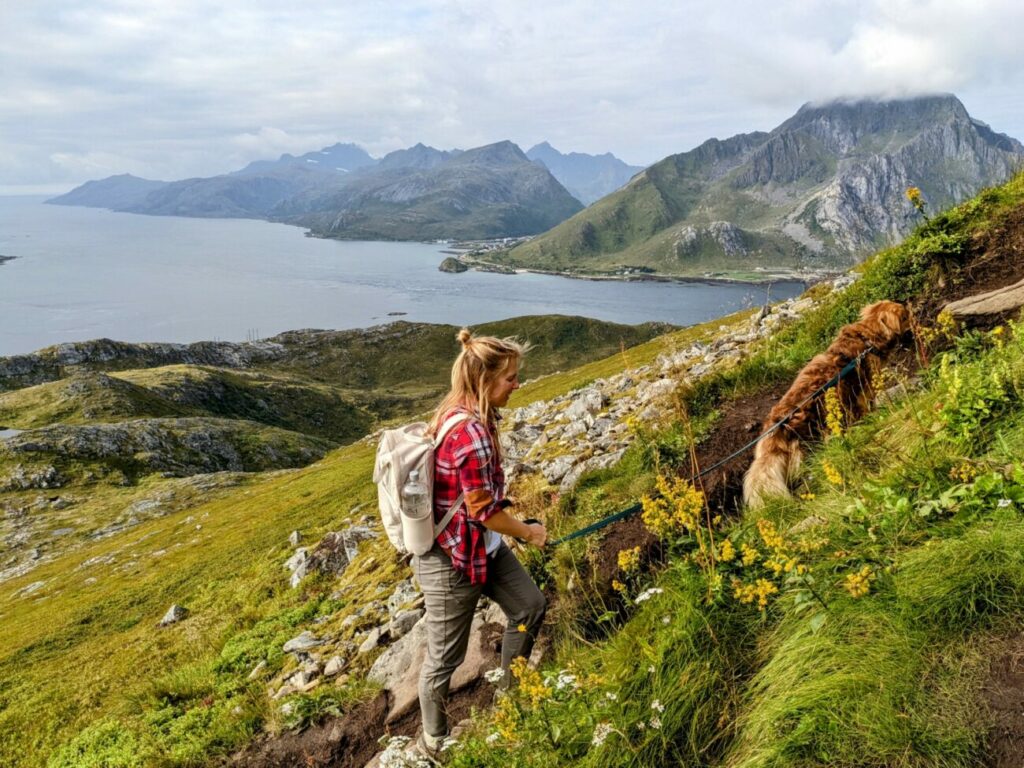
You should therefore stick to the GPX route, which you can find in our travelogue for the hike . The view from up here is really fantastic and we couldn’t get enough of it. Especially because the mountain is not as crowded as some other hikes in Lofoten (e.g. the hike up Reinebringen ), we could really enjoy the panorama.
Wild camping at Myrland Beach
Just 15 minutes away, on a super quiet coastal road, there are several places for wild camping. These are located directly on the road, but this is hardly traveled. You walk in a few seconds to the beach and are at the beautiful sea. The view is also fantastic! What more could you ask for?
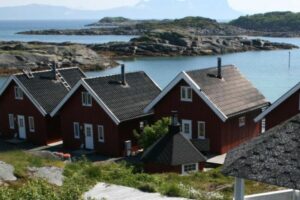
Wooden cabins Offersøy | show prices*
Day 5 | Nusfjord, Lofoten Road & Ramberg Beach
On this day you continue to the oldest museum town in Lofoten. Nusfjord was the leading fishing village in Lofoten until 1989 and was economically extremely successful. Even today stockfish is still produced here and exported to the world. But the main source of income is of course tourism. Today Nusfjord is developed as an open-air museum and can be visited as such.
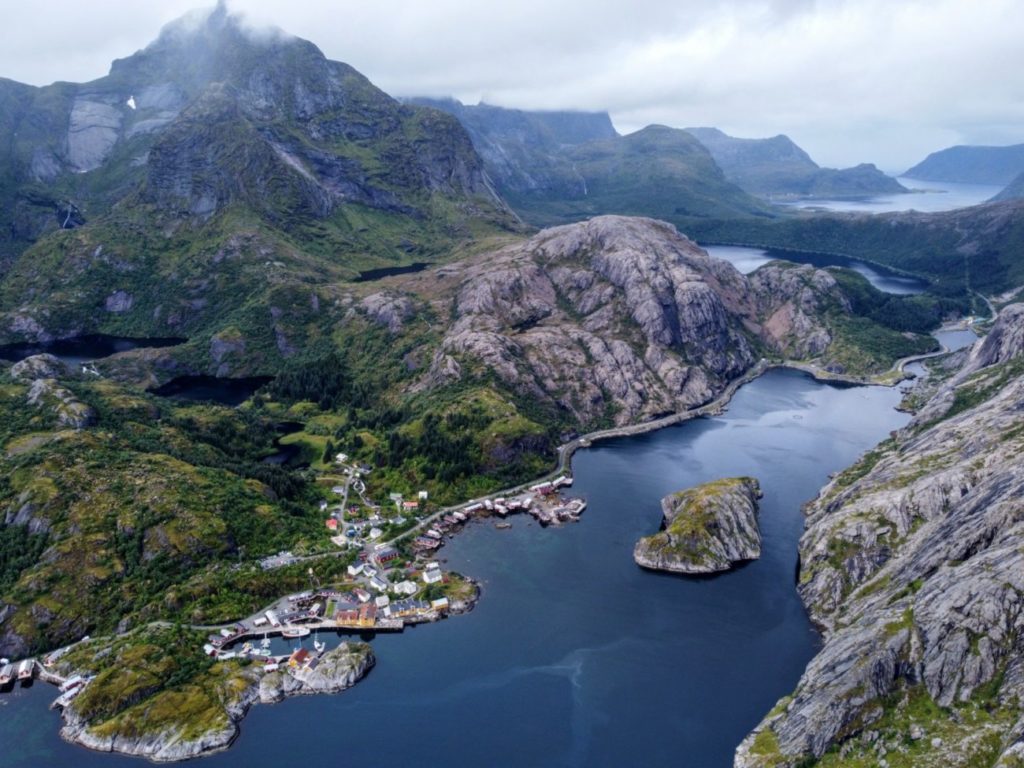
You can expect Nusfjord to be a historical place, which is (in parts) also beautifully laid out. But it is no longer a lively fishing village with real life, but in the best and worst sense… a museum.
The Lofoten Road
On the way there you will pass an Instragam photo spot , the so-called Lofoten Road. You should definitely stop here and take a photo, because here the road runs straight towards the imposing mountains in the background and creates a spectacular panorama (which was unfortunately very cloudy in our case). If you also want to have such a photo then you should park your car here (Google Maps ) and then walk a few meters further to take a (typical Instagram ) photo there.
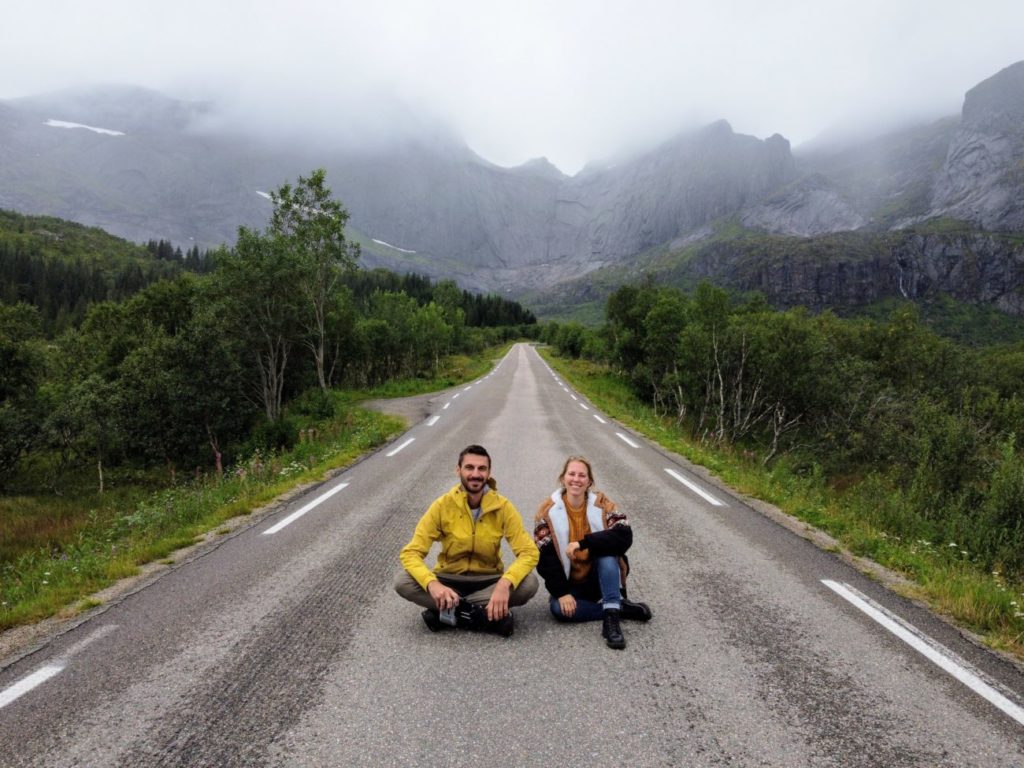
Ramberg Beach
Less than 20 minutes along the E10, you’ll come to what we consider the most beautiful beach in Lofoten . This slightly curved beach is almost 900 meters long and you can walk along it and enjoy the atmosphere. The beach Rambergstranda is located in the small town of Ramberg and the atmosphere here is somewhat different and more urban than on the other beaches of Lofoten.
However, we did not find that negative at all, but felt right at home here. The only thing missing here was a cool beach bar to feel like on a surfer beach in South Africa. But of course there is nothing like that here in Lofoten, it is too pristine for that.

Lofoten Beach Camp
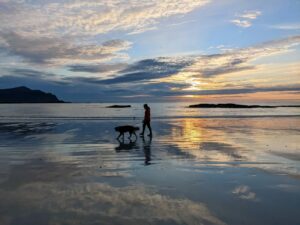
Nusfjord Wooden Cabins | Show Prices*
Day 6 | Ryten Hike & Kvalvika Beach
The hike up Ryten mountain is one of the most beautiful hiking highlights in Lofoten . The ascent of Ryten is truly a classic in northern Norway and is therefore also a very popular hike. Due to a new starting point of the hike (with a large parking lot), you can combine Ryten very well with the hike to one of the most beautiful beaches in Lofoten: Kvalvika Beach.
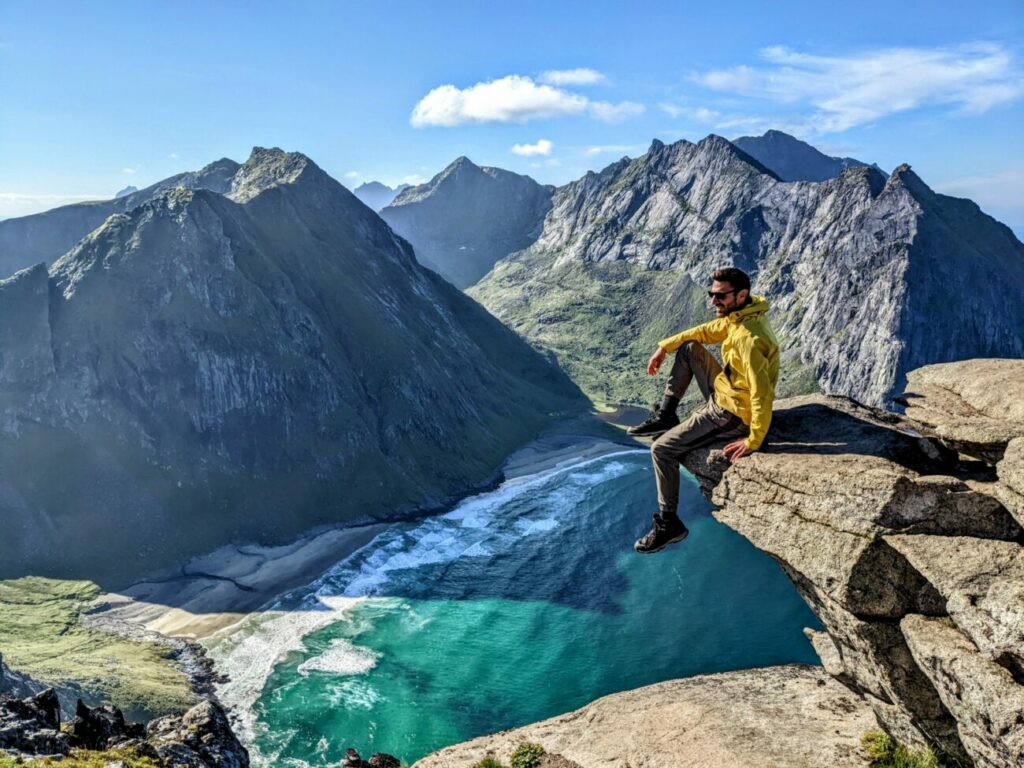
Mount Ryten is 543 meters high and is located in the southern Lofoten not far from the museum village of Nusfjord . The hike up this imposing mountain is one of the most popular and also most beautiful in all of Lofoten. Accordingly, you will meet many other tourists on this tour. But that’s not so bad, if you start very early and secondly, the view from the top is just spectacular.

From a viewpoint you look down to Kvalvika beach, which you can hike to, but you don’t have to. If you don’t visit the beach then you will need about 4 hours for the 8 km. Everything about the hike you can read in our travelogue:
Ryten Hike + Kvalvika Beach I Tips for Lofoten Highlights
Camping at Ryten Parking Lot
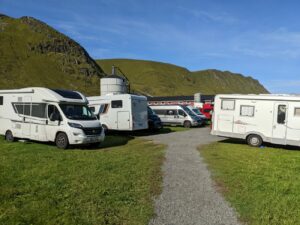
Double Room with Sea View
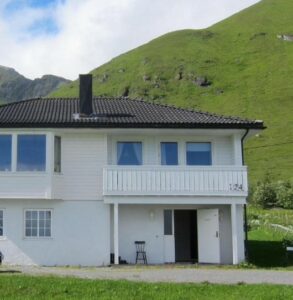
Double Room with Sea View | Show Prices*
Day 7 | Fishing Villages Hamnoy, Reine, A
Today you will go to the deep south of Lofoten and visit the most beautiful fishing villages of Lofoten . Following the E10 you will first pass the small village Hamnoy.
Hamnoy is located in Lofoten on the island of Moskenes and is a tiny village with only a few inhabitants, but a picture book scenery that is unique in Lofoten. Here you just have to stop to take one or preferably several photos.
The typical red Rorbuer wooden huts can be found here and are extremely picturesque against a great mountain backdrop. More than stopping to take the obligatory photos is not possible in Hamnoy. This place does not have much more to offer.
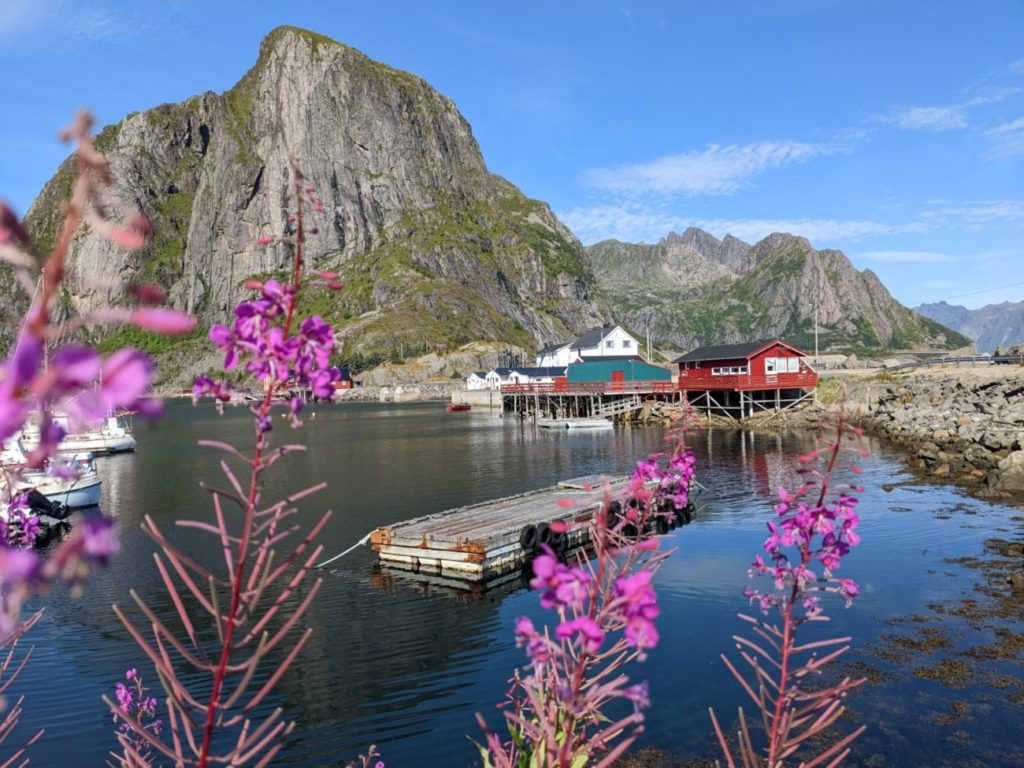
Directly on the other side of the fjord is the somewhat larger town of Reine. Reine is one of the most visited and most photographed places on the Lofoten archipelago. Reine is one of the most famous fishing villages in Lofoten and exists since 1743.
Here you can capture one of the typical Lofoten photo spots and take photos from one of the most popular Lofoten viewpoints. You could say that Reine is typical Lofoten. This is also where one of the most beautiful hikes in Lofoten starts, the hike up Reinebringen . Since this takes several hours, we save it for the next day.

Å is not only the last letter in the Norwegian alphabet, but also the last (or most southern) place on Lofoten. Å is really very small and you can walk through it quickly. The highlight of this fishing village is the viewpoint in the south of the town. From the free parking lot ( Google Maps ) you walk only a few minutes through the green until you reach a large flat rock.

This is the southernmost point in Lofoten that you can officially reach. If the weather is good, you can see for miles towards the offshore islands of Væroy and Mosken and have a beautiful view of the Atlantic Ocean and watch the seagulls gathering food.
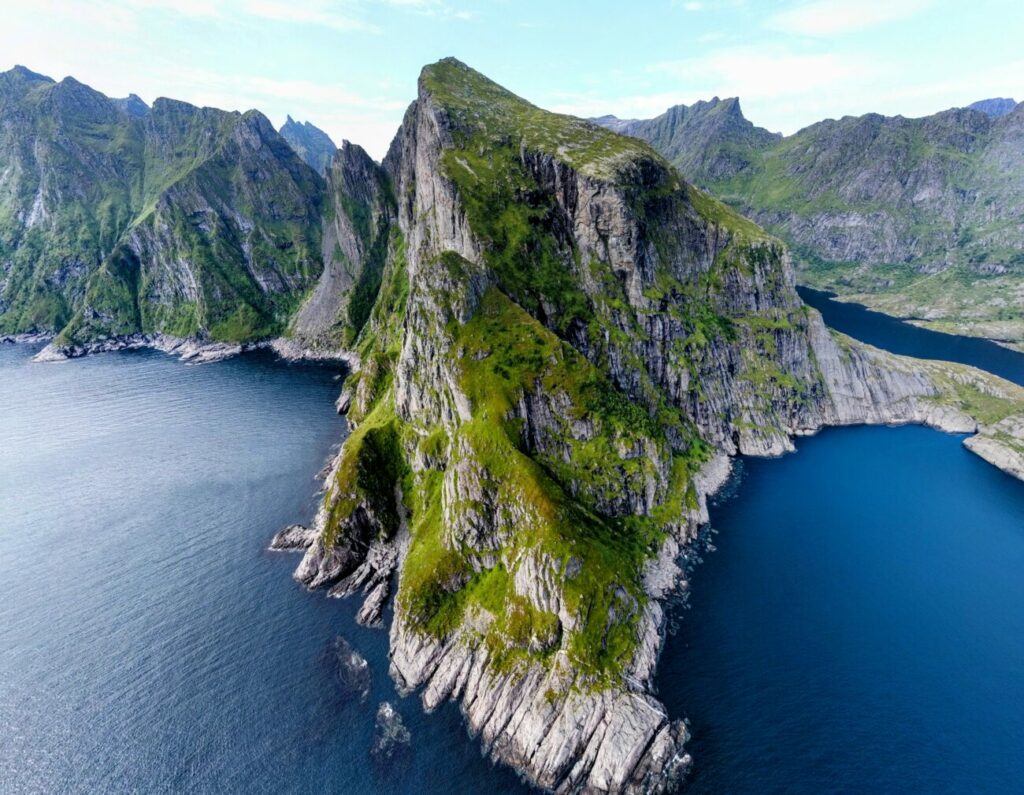
By the way, from the parking lot you can also get directly to the small town itself in a few minutes. But you don’t have to spend too much time here, because you should rest for the strenuous hike tomorrow.
Moskenes Camping
Here you are at a beautiful campsite right by the sea and are also super fast at the ferry to the mainland, if you have to leave early the next day.
Wooden Cabins by the Sea
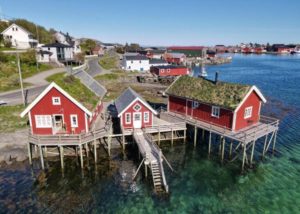
Rorbuer Cabins | Check Prices*
Day 8 | Reinebringen Hike
Today another very great hike is on the schedule on your Lofoten road trip. The Reinebringen is probably the Lofoten hike with the most amazing view . The panorama you will have from the 460 meter high mountain to the town of Reine and the mountain ranges of Lofoten is incomparable and unique in Lofoten.
You should definitely do this hike. Over 1500 steps were carved into the rock a few years ago by Nepalese Sherpas to lead you as safely as possible up the mountain.
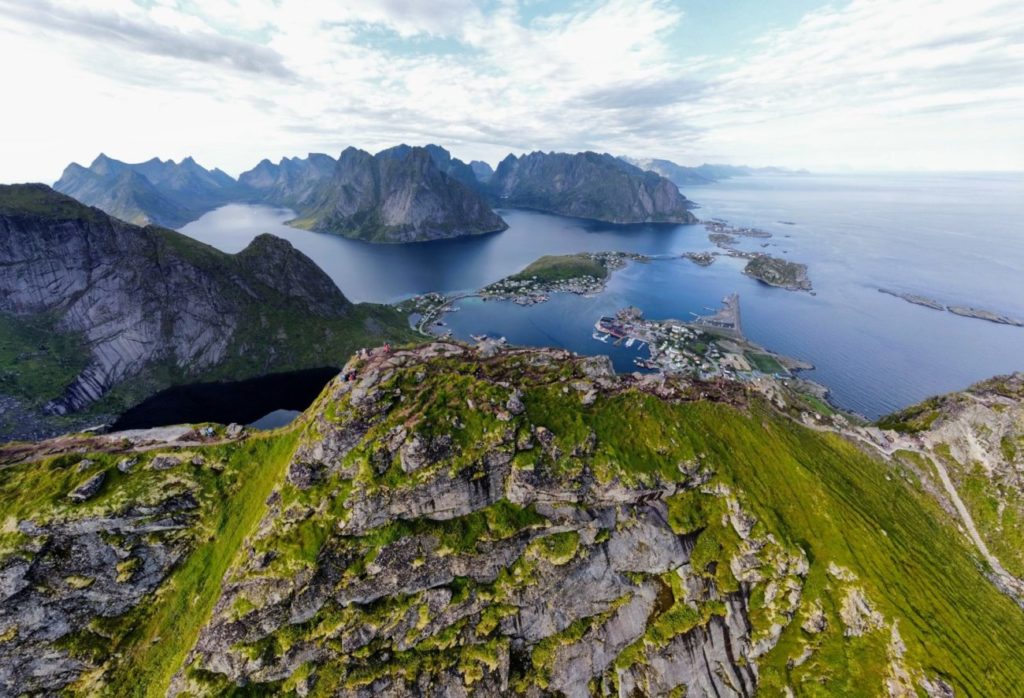
At the top of the mountain there are several viewpoints depending on whether you go left or right at the end of the stairs. From everywhere you have a wonderful panoramic view of Reine and the rest of Lofoten. For us an absolute must-do! Learn more about the Reinebringen hike in our travel report: Reinebringen Hike I The most beautiful viewpoint in Lofoten
You can take the ferry from Moskenes to Bodo to get back to the mainland. But if you want to go back to Lodingen, because you have more time or you want to return your rental car in Tromso, you can cross the Lofoten in another direction and take some other roads.
(O ptional Round Trip) Day 9 – x
You can head north again if you skipped some Lofoten must sees on your previous Lofoten road trip, perhaps because it rained or you just want to do some more hiking. What you should do in any case is to shift your Lofoten itinerary more to the smaller roads and also just drive along a smaller road without knowing exactly what is coming up.
The best thing about such a road trip is to enjoy the unexpected things and also to let the beautiful landscape pass by without necessarily rushing from one highlight to the next. We have a few suggestions for side roads in Lofoten that you should drive along.
Fv804 near Napp
Take a little detour along the coast here. Unfortunately, you can not go completely around the small peninsula, so you have to drive along 2 spur roads and then in between back to the E10.
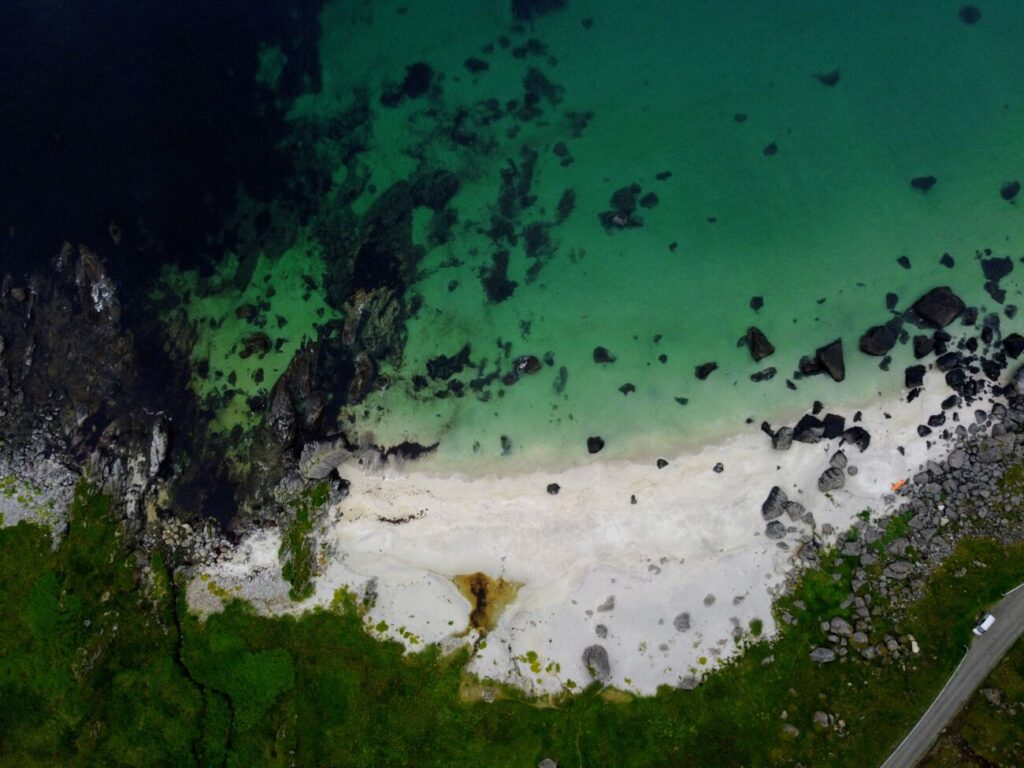
The two routes lead along the coast past Vikten Beach and Myrland Beach, among others, and are extremely sparsely traveled. Enjoy the seclusion here and perhaps look for a nice campsite on one of the beaches on the route.
- Google Maps Route
Road 815 between Hag and Sundklakkbrua
This route is actually not a detour at all, as it runs almost parallel to the E10. It is relatively easy to drive and also runs directly along the coast for the most part. A very good and scenic alternative to the busy main route E10.
Fv862 on Gimsøy
Around the small Lofoten island Gimsøy a narrow road leads you past several lonely beaches. You will also pass the Butterfly House (Google Maps ), which is covered with colorful graffiti. Just enjoy the impressive landscape and the creative street art here.
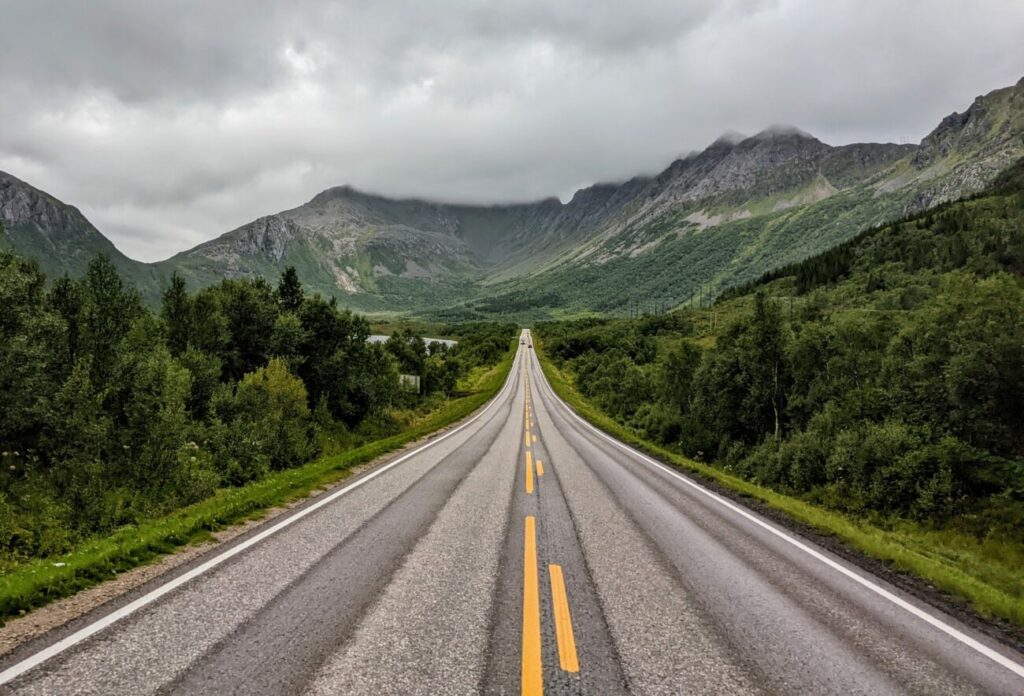
Midnattsolveien
This road is located on the island Austvagsoya and leads wonderfully along the coast and through beautiful, almost untouched landscapes. If you have already stayed at the Laukvika campsite on the outward journey, then you already know the route. If not, then you should definitely plan this detour. The route is wonderfully pristine and offers many nature highlights with very little traffic.
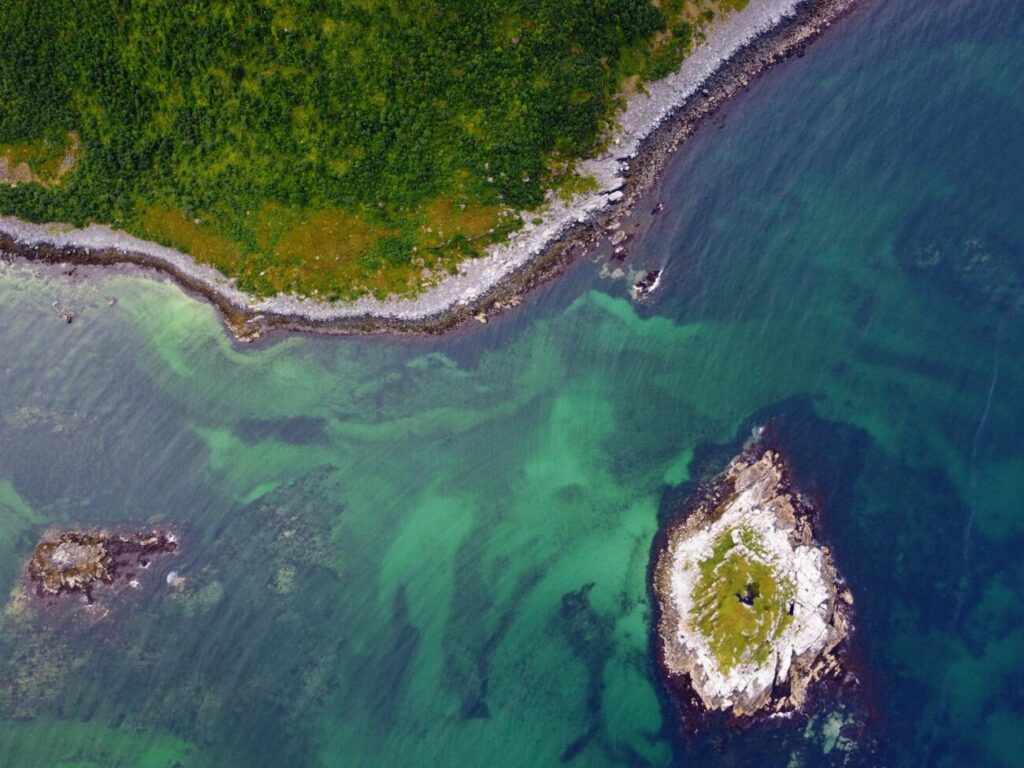
Vesteralen & Senja
Do you have more time available and want to go to islands that are much less visited than Lofoten? Then we have 2 tips for you. The first one is the archipelago of Vesteralen. These islands are really a little insider tip and are much less visited than the Lofoten, although they are located directly north of it and are at least as beautiful. Particularly noteworthy here is the island of Andøya.
The second tip is the island of Senja. It is located a few hours north of Lofoten and is also still totally unspoiled and scenically beautiful. Unfortunately, we did not manage to visit these islands, but if you still have at least a week available, then you should head for these destinations.
Leave a Reply Cancel reply
Your email address will not be published. Required fields are marked *
Save my name, email, and website in this browser for the next time I comment.

- Sep 26, 2022
- 11 min read
Lofoten Islands & Northern Norway: 10-14 Day Tromsø to Lofoten Road Trip Itinerary
Updated: Oct 5, 2022
The Lofoten Islands are located within the Arctic Circle in Northern Norway. With jaw-dropping landscapes, long stretches of white-sand beaches, narrow fjords, and small fishing villages, this is truly one of the most beautiful destinations in the entire world. We were lucky to spend 14 days traveling from Tromsø to the Lofoten Islands. This time allowed us to see the highlights of the region as well as some lesser-visited spots outside the Lofoten. In this article, we’ll share our road trip itinerary for 10 to 14 days, including the things you can’t miss and how long you should stay in each place.
Check out our video on the Lofoten Islands & Northern Norway to get a sense of what it's like there!
Lofoten Islands Table of Contents
If you want to skip to a specific section faster, click one of the bullet points below
Important things to know before you go
Stop 1: Tromsø
Stop 2: kvaløya, stop 3: senja, stop 4: lofoten islands - austvågøy, stop 5: lofoten islands - vestvågøy, stop 6: lofoten islands - flakstadøya, stop 7: lofoten islands - moskenesøy, stop 8: lyngen alps.
Tips to save money on your trip + other resources
Important things to know before you go to the Lofoten Islands
There are a few things you should know before visiting the Lofoten Islands. The following tips will help you prepare for your trip:
Lofoten Islands weather
First, the weather in the Lofoten Islands and Northern Norway is very unpredictable . As it's located well above the Arctic Circle, it can be cold even during the summer time. In fact, you can have all seasons in one day, even if the day starts out with clear blue skies. Regardless of what the weather forecast is saying, you should always bring rain gear and warm layers that you can remove when the sun comes out. Check the most up-to-date weather forecast on yr.no .
Best time to travel
The best time to travel to the Lofoten Islands and Northern Norway is from May to September . From late May until mid-July, you can enjoy the midnight sun, meaning that the sun doesn’t set! During these months, the daily temperature generally hovers around 15°C and may even reach 20°C on hot days. It’s also the best time to go hiking as most of the snow will have melted!
Things to do in the Lofoten Islands
Northern Norway is known for its magnificent nature. So it comes as no surprise that the top things to do are outdoor activities, such as hiking, kayaking, and climbing . Expect very muddy and wet conditions when doing these activities, even during the peak summer season. During the autumn and winter it’s also possible to see the magical northern lights dancing in the sky. However, the sun doesn’t rise from early December to early January, so it’s best to avoid that time.
Accommodation
Norway has an amazing law (“allemansretten”) that gives you the right to enjoy and stay in nature for FREE . This means that you can camp anywhere in Northern Norway, whether that is with a tent or in your campervan , as long as it’s at least 150 meters from a house or cabin and not on cultivated land. You must also move spots every two days if you’re not in remote areas. This means that you can save a lot of money on accommodation during your trip. And while we decided to camp most of our days, we don’t necessarily recommend it. The heavy winds and random rain showers can make it extremely challenging, even in summer. We recommend renting a campervan or booking a warm, dry place to stay instead. Under each stop, you can find the places that we stayed at.
It’s not easy to get around Northern Norway and the Lofoten Islands with public transportation. We highly recommend getting a rental car or campervan so you can easily get to trailheads and beaches. If you have a rented vehicle, you will see a small box right next to your rearview mirror. This automatically registers all the toll stations you pass and the ferries you take. If you drive your own car, your license plate will be registered and you will receive the bill by mail a few weeks after your trip. Keep in mind that the roads are quite narrow, which makes it harder for larger vehicles!
Cost of traveling
When it comes to cost of living, Norway is one of the most expensive countries you could choose to visit in the world . The cost of food and alcoholic drinks is extremely high. The best way to save money is to cook your own meals as much as you can and to make use of the free camping law.

10-14 Day Road Trip Itinerary from Tromsø to the Lofoten Islands
Use the map to navigate between different highlights and stops!
Length: 1-2 days
Highlights: harbor, arctic church, fjellstua viewpoint, polar museum, polaria
Where we stayed: Scandic Grand Hotel
Our road trip itinerary starts in the city of Tromsø . This is the biggest city in northern Norway, and the cheapest place to fly into and rent your vehicle from. We picked up our car from the airport, which we found online via RentalCars .
It’s best to spend one or two days in Tromsø to cover the main highlights of the city. These include the harbor, the Arctic church, the fjellstua viewpoint, the polar museum, and polaria. Find more in-depth suggestions in our article about the best things to do in Tromsø .
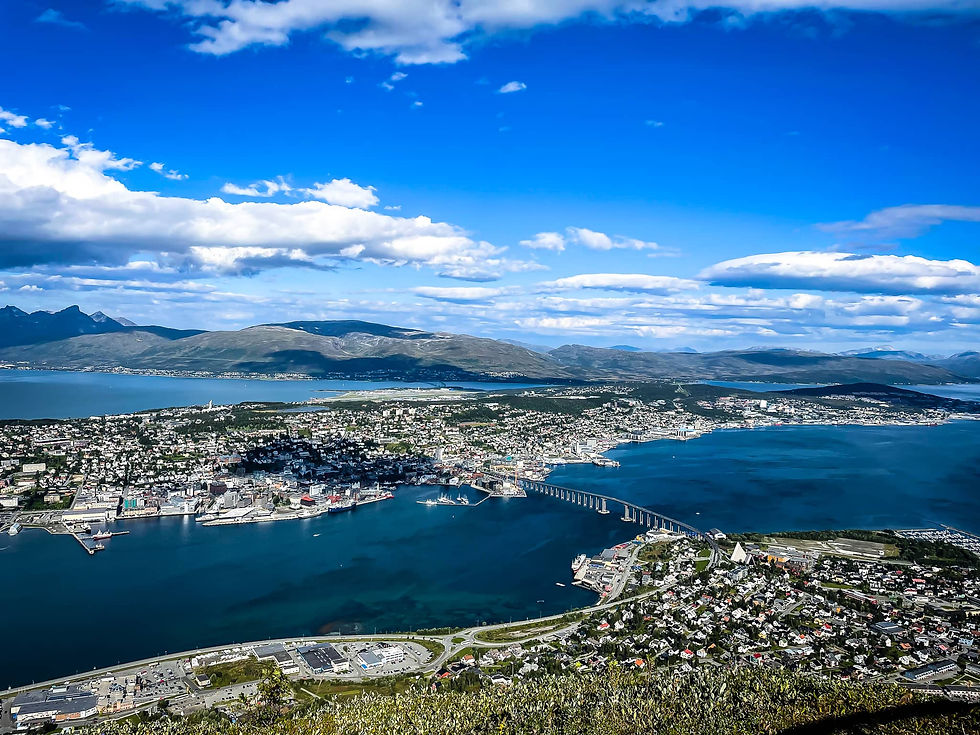
Best Hikes (click link to follow route map ): Brosmetinden hike , Ørnfløya hike
Other Highlights: Sommarøy fishing islands, Grøtfjordbotn beach, Sandneshamn beach
Where we stayed: we camped at Steinsvika beach
The island of Kvaløya is only a short drive away from Tromsø. With breathtaking views of immense mountains and fjords, this is a great introduction of what is to come. Take your time to drive around and visit the most beautiful spots: Ersfjordbotn, Grøtfjordbotn beach, Sandneshamn beach, and the fishing islands of Sommarøy . If the weather is nice, we recommend hiking to Brosmetinden and ørnfloya . Both hikes are relatively short and easy.
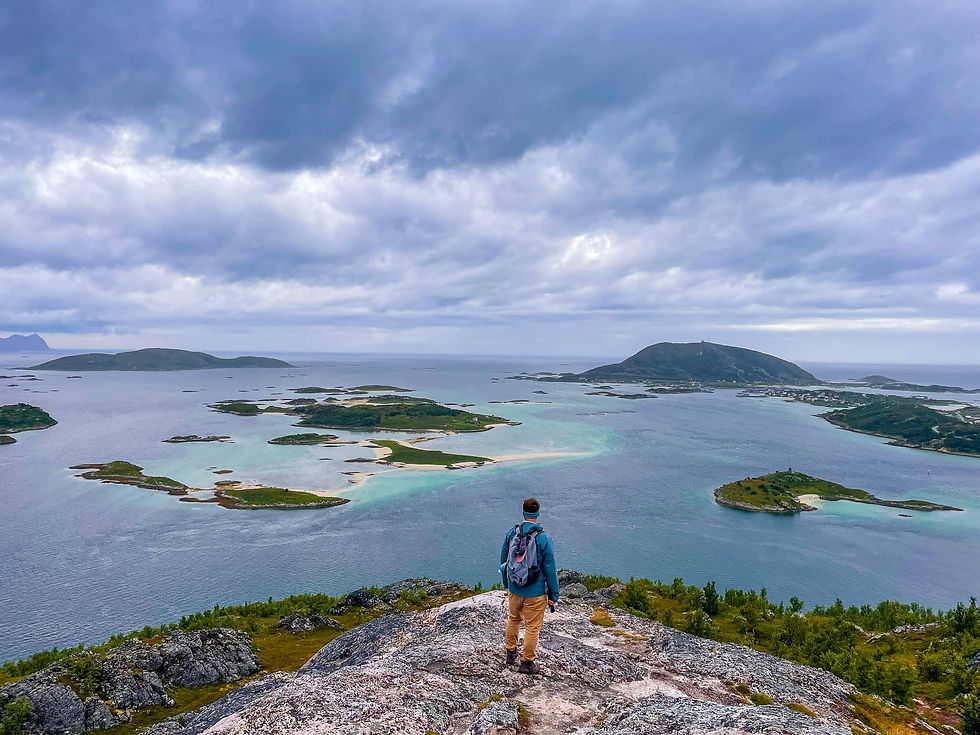
Best Hikes (click link to follow route map ): Hesten hike , Sukkertoppen hike , Husfjellet hike
Other Highlights: Tungeneset viewpoint, Husøy island
Where we stayed: camped at the summit of Hesten & stayed at the Skagi Senja Lodge
The breathtaking island of Senja is next. Take a short ferry ride from Brensholmen to Botnhamn in the morning or later during the day. You can find the ferry schedule here.
Senja is Norway’s second-biggest island, famous for its jagged peaks. Fun things to do on Senja include sightseeing at Husøy island , the Tungeneset viewpoint and the Sukkertoppen hike . The most iconic peak is undoubtedly Segla , towering above the town of Fjordgård . The best view of this needle-like mountain is from the summit of the Hesten hike , which is about 4.6 kilometers total. We decided to start this hike at 9pm and camp at the summit since the weather was calling for blue skies at sunrise. As we set up camp, we crossed our fingers that the sun would come out in the morning…
Best Hikes (click link to follow route map ): Festvågtind hike , Tjeldbergtind hike
Other Highlights: National Tourist Road (on Andøya), Austnesfjorden, Svolvær, , Trollfjord cruise, Henningsvær
Where we stayed: Fast Hotel Svolvær
After Senja, it’s finally time to head to the Lofoten, a chain of seven main islands (Austvågøy, Gimsøy, Vestvågøy, Flakstadøy, Moskenesøy, Vaerøy and Røst) . We recommend catching a 2-hour ferry ride from Gryllefjord to Andenes , which operates from mid-May to the beginning of September only. Unfortunately for us, we ran into some weather problems so we had to reroute and actually drive to the Lofoten Islands instead. This added about an hour for the day.

If the weather is cooperating and you do actually get to take the ferry, then you can stop at some beautiful viewpoints along the way on the National Tourist Road throughout Andøya . And even if you don’t take the ferry, you’ll still arrive on Austvågøy island, just a little later than planned.
Austvågøy is the northernmost island in the Lofoten and has a lot to offer. Once you get there, we recommend stopping at Austnesfjorden for your first viewpoint. Then, hit the vibrant town of Svolvær where you can enjoy beautiful walks on the calm waterfront or embark on a cruise to Trollfjord . On the cruise, you’ll be treated with stunning views and you might even see eagles along the way like we did.

Next, we recommend doing your first hike on the Lofoten Islands. Starting just behind the town of Svolvær, you can do the beautiful Tjelbergtind hike . This is a great starter hike to get acquainted with the Lofoten trails. It is only 4.3 kilometers long and is a moderate difficulty, but has some stellar views of Svolvær and the surrounding mountains from the top.

For your final stop on Austvågøy Island, we recommend visiting the town of Henningsvær . This town has been one of the busiest fishing villages on the coast for more than a century. You can admire views of the village from the breakwater or head to the world’s most unique soccer field situated on an island by itself.
Once you’ve enjoyed the town, you should definitely do the Festvågtind hike . This hike is challenging due to its steepness, but it’s definitely worth it to get an aerial view over Henningsvær. The trail will take you up a couple of steep boulder areas which can challenge your balance. And at 4.2km total with 541 meters gain, it was the steepest hike we did in the entire Lofoten. If you go all the way to the top, the hike should take about 3 hours total. However, you can also stop when you reach the ridge, in which case the hike is only a medium difficulty and is 2 kilometers total with only 180 meters of elevation gain.
Best Hikes (click link to follow route map ): Offersøykammen hike , Uttakleiv to Haukland Beach , Mannen hike (alternatively Veggen hike)
Other Highlights: Unstad surfing, Lofoten Viking Museum, Uttakleiv beach, Haukland beach
Where we stayed: Camping at Haukland Beach & camping at the parking lot of Offersøykammen
The road trip continues to the island of Vestvågøy, home to an interesting mix of things to do. The Viking Museum is a great first stop and a perfect place to visit on a bad weather day, which can happen a lot in the Lofoten Islands. The museum offers a ton of great history about the interesting viking culture!
Next, you can check out the beautiful beaches of this island, starting with Unstad which is famous for Arctic surfing. You'll see people surfing here all-year-round!
The Haukland beach area is a great next stop on Vestvågøy island. Here, you can camp on the beach and also do a beautiful coastal walk to the neighboring Uttakleiv beach . This is a great option for families since there is no elevation gain.
If you want a little more adventure, you can do the Mannen hike , sitting just above the Uttakleiv to Haukland beach walk. This trail is steep and challenging as the footing is loose and muddy with very sharp cliffs near the top of the ridge. However, you can stop when you get to the middle of the ridge for nice views of Haukland beach below without the danger of trying to get all the way to the top. In total, this hike is about 4 kilometers with 330 meters of elevation gain and takes 3 hours total to complete. We consider this a hard hike because of the muddy conditions on the ridge.
Finally, you should check out the Offersøykammen hike . This 2.5 kilometer hike has views at the top that are absolutely breathtaking. With 385 meters of elevation gain, the trail has a pretty steady steepness all the way to the top, but is actually more gradual than most other hikes we did in the Lofoten Islands. It’s easy to get off the trail once you’re out of the woods section, but as long as you keep climbing up towards the peak, you’ll see intertwined trails that all lead to the same viewpoint. We consider this hike a medium difficulty and it definitely has one of the best rewards at the top for the amount of physical effort put in.

Best Hikes (click link to follow route map ): Volandstind hike
Other Highlights: Nusfjord, Ramberg beach & town, bridge to Fredvang
Where we stayed: Lofoten Beach Camp
Next on the Lofoten itinerary is Flakstadøy island, home to small authentic villages and beautiful sandy beaches. Ramberg beach is a great stop to get a peaceful beach walk and listen to the waves gently crashing.
While Ramberg is home to a beautiful beach, Nusfjord is considered the best-preserved fishing village in all of Norway . You can learn all about its traditional fishing practices here, which has played an important role for centuries. But besides the towns, this island offers some incredible landscape views!
Length: 2-3 days
Best Hikes (click link to follow route map ): Reinebringen hike , Røren & Ytresand beach hike , Munken hike , Bunes beach hike , Ryten & Kvalvika beach hike
Other Highlights: Reine, Ytresand beach
Recommended stay: Rostad Retro Rorbuer
The last Lofoten Island we visited is the most popular one… Moskenesøy! This island is home to unspoilt beaches and some of the best hikes on the entire trip. The first hike we recommend is Røren , which is an easy 3.5km trail that only takes about 1.5 hours total to complete. You’ll get stunning views of the crescent-shaped Ytresand beach from above here.

Next, you can keep your hiking boots on for the Ryten and Kvalvika beach trail . This hike has the most diverse scenery in the Lofoten. You’ll come across waterfalls, beaches, and even open plains at one point. This 9 kilometer hike has about 807 meters of elevation gain and takes between 4-5 hours to complete. From the top of Ryten is where you can see the famous views of Kvalvika beach from above. You can make the trail a loop like we did to experience the diversity of landscapes even more, but be aware that it can get pretty muddy as it has less rocks and more open grass and dirt. Check out our Lofoten Hiking video to check out the trail (and the other trails we mention in this article!)

After Kvalvika, you can head to the small town of Reine , which is tucked underneath some of the most jagged peaks you’ll come across in the Lofoten. This town is dotted with little red fishing cabins and has a very chill vibe to it. From this town you can also do the most iconic hike in all of the Lofoten Islands... Reinebringen ! This 5km out-and-back trail showcases the best views in all of the Lofoten Islands in our opinion and is a hike you can’t miss when visiting. The trail was so popular that they actually created sherpa steps all the way up to the ridge, making it more accessible, safe, and easier. However, due to its steepness and 647 meter elevation gain, it’s still a medium difficulty hike. Overall, this hike took us about 3 hours to complete. Enjoy this iconic view over the town of Reine.
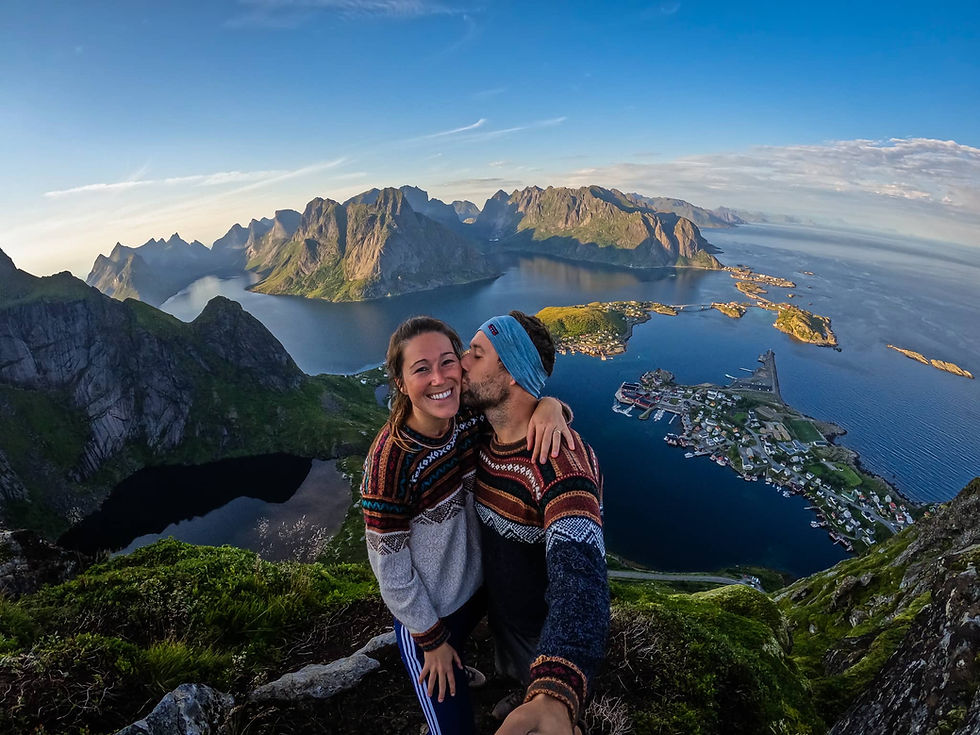
Best Hikes (click link to follow route map ): Blåvatnet hike , Guided glacier hike
Highlights: , Sami farm
Where we stayed: Magic mountain lodge
Finally, it’s time to head back towards Tromsø to finish the road trip. From Reine, it’s a long drive back along the E10 Highway . But before you jet off, try to fit in one more hidden gem. The Lyngen Alps are just 2 hours north of Tromsø and a true nature paradise. Home to more than 140 glaciers, there are tons of great hiking trails, guided glacier hikes, and climbing. We did the Blåvatnet hike and highly recommend it if you’re in the area. It’s about 8km total and has minimal elevation gain, so anyone can do it. It’s a great way to end your trip around Northern Norway and the Lofoten Islands!
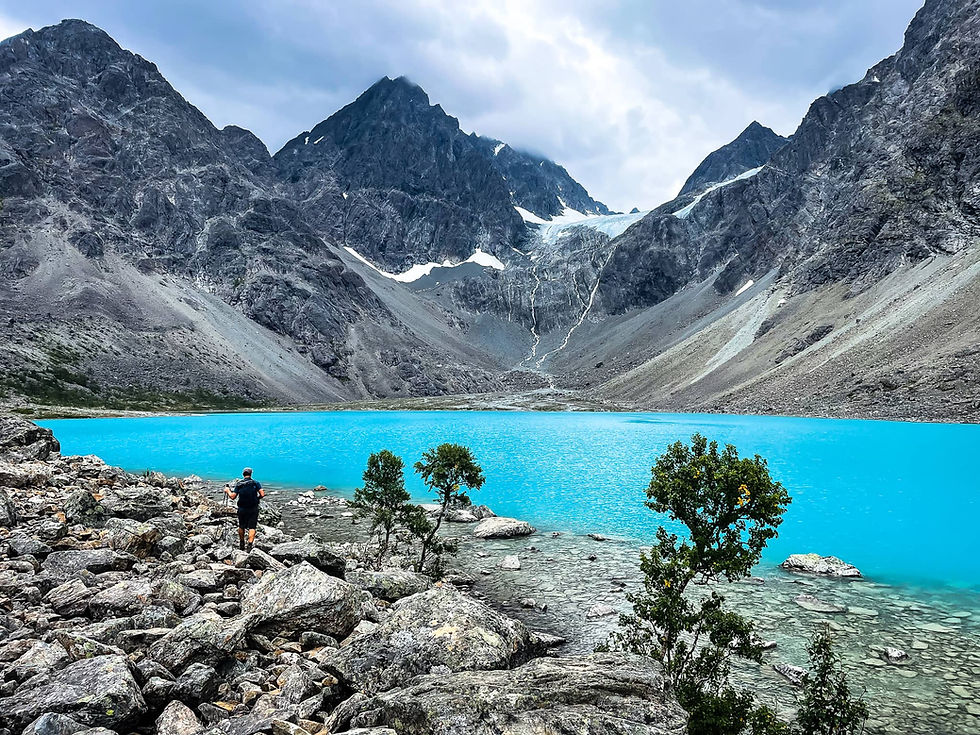
Use These Websites To Save Money On Your Tromsø Trip
Booking.com for places to stay
Skyscanner for cheap flights
GetYourGuide for local tours
Rentalcars.com for affordable car rentals
Free Giveaway
Did you enjoy our article about the Lofoten Islands and Northern Norway? Download our free giveaway and get inspired by the 100 most beautiful hikes in the world!

Other Top Lofoten Islands resources:
If you're looking for some other suggestions and tips on the Lofoten Islands, here are some great articles that will help you:
1. The official Visit Norway website with general information on the Lofoten Islands
2. Another 10-day road trip itinerary by Earth Trekkers
3. A list of hikes on the Lofoten Islands by 68 North
4. Our video about all the Lofoten hikes we mention in this article
Need more travel inspiration? Check out our other destinations and other articles about Norway:
Western Norway Road Trip Itinerary for 10 Days
Bergen, Norway Travel Guide
Tromsø, Norway: A Complete Travel Guide

Related Posts
Western Norway road trip itinerary for the outdoor adventurer
Bergen, Norway: A Complete Travel Guide
Tromsø, Norway: Full Travel Guide

Hi! We are Ine & Zac. An international travel couple from Belgium and the US. We created World Wild Hearts to inspire life-changing travel experiences like we've had. Use these tips, stories, and guides to inspire your next adventure of a lifetime!
SAVE MONEY ON YOUR TRIPS

DOWNLOAD FREE TRAVEL RESOURCES
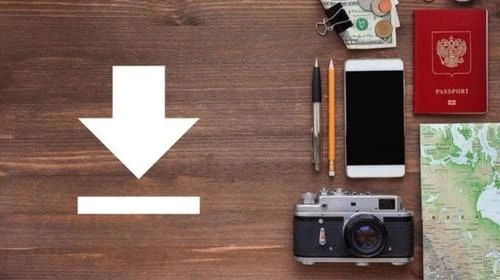
WATCH OUR TRAVEL VIDEOS

This post contains a few affiliate links. That means we may earn a small commission when you click on the links at no additional cost to you. You can read our full disclaimer here . Thanks for supporting our travel blog!

COMPREHENSIVE TRAVEL PLANNER

The Smooth Escape
Nature & adventure travel blog
The perfect Lofoten itinerary: 5 days on the Lofoten Islands
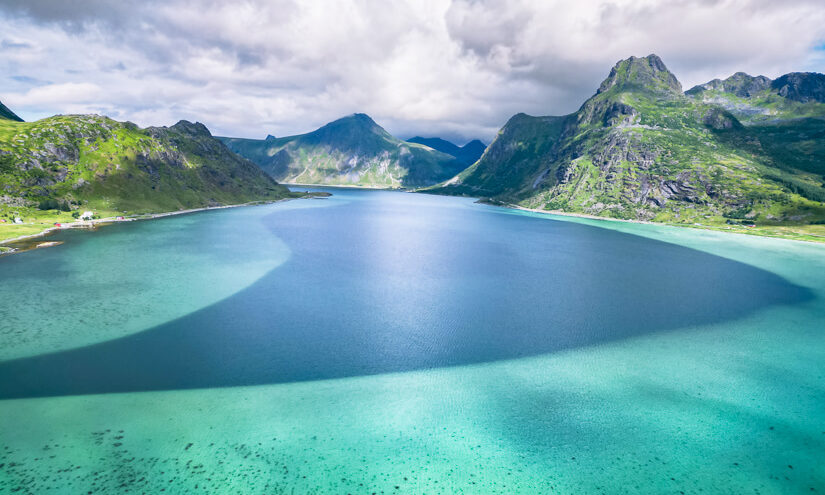
The Lofoten Islands in Northern Norway is a place of extraordinary natural beauty. It’s a wonderland of majestic mountains, deep blue fjords, white sand beaches and endless jaw-dropping views.
In this blog post, I’m sharing my 5-day Lofoten itinerary that showcases the most amazing natural attractions, hiking trails and charming fishing villages in the region. It’s one of the most beautiful road trips I’ve ever done and I’m convinced you’ll love it too!
At the end of this post, I’ve included a map where you can see the exact driving route for this Lofoten Islands itinerary and get a clear overview of where all the top sights are located. You’ll also find my recommendations on what to do if you have more than 5 days in Lofoten as well as my tips on how to get to Lofoten and the best time to visit the region.
Disclosure: This article contains affiliate links from which I may make a commission at no additional cost to you if you make a purchase.
Getting around the Lofoten Islands
The best way to get around Lofoten is by car. Although there is a public bus system, you’d waste a lot of time waiting for the buses and it would be difficult to reach the more remote parts of Lofoten. By having a rental car, you’ll have the freedom to explore more places and travel on your own schedule.
Driving in Lofoten is generally pretty easy and the mesmerizing views make it a fantastic experience in itself. The roads are well-maintained but some are quite narrow so you have to be a bit careful, especially in the summer when there’s more traffic. Lofoten’s main road E10 is a larger road, whereas the side roads are smaller.
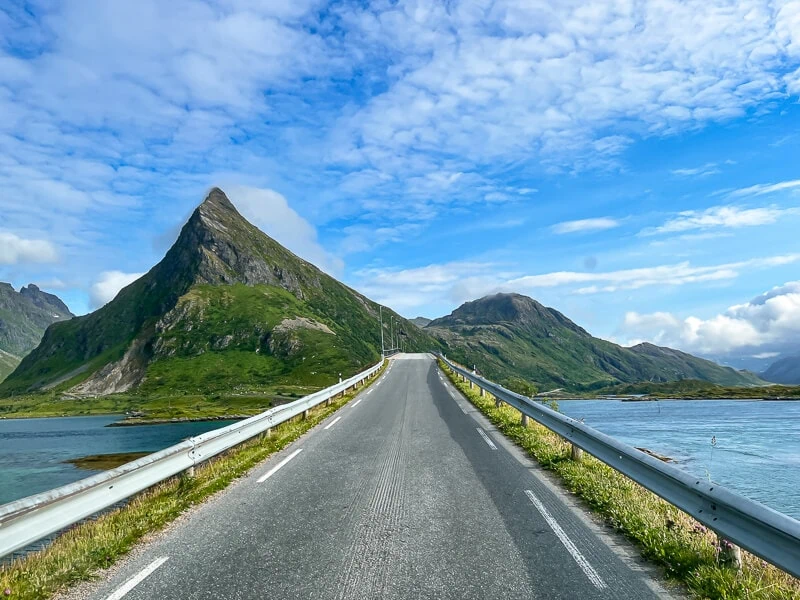
For our Lofoten road trip, we rented a campervan in the city of Tromsø and also visited the spectacular lesser-known Senja Island on the way to Lofoten. We rented the van from a Norwegian company called Wecamp and were really happy with it. For more details about the van and what it was like to travel with this setup, read my post about traveling Norway by campervan .
If you plan to visit Lofoten in the summer like we did, book your rental car or van well in advance as they tend to get sold out pretty quickly.
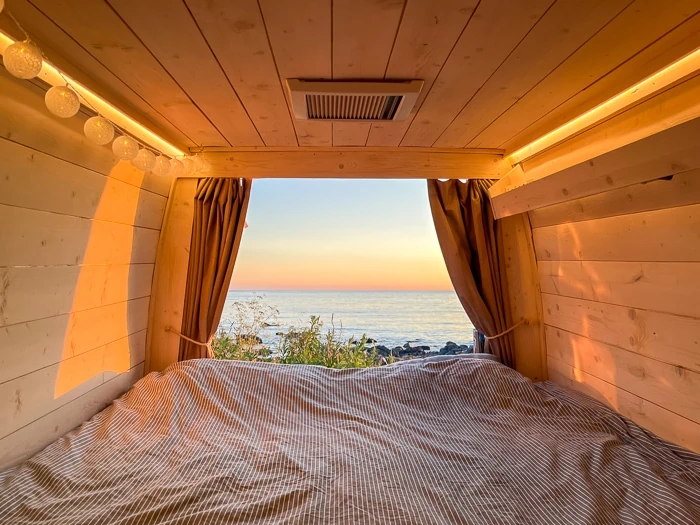
Lofoten itinerary: How to spend 5 days in Lofoten
This Lofoten Islands itinerary starts in the town of Svolvær in the eastern part of Lofoten and continues southwest over 5 days. It takes you all the way until almost the end of the Lofoten archipelago and then ends back at Svolvær. The total driving distance is around 350km (217 mi).
Since we explored the Lofoten Islands with a campervan, we didn’t stay in any hotels but if camping is not your thing, I’ve also listed the best hotels for different budget levels for each of the days in this itinerary.
Day 1: Svolvær, Trollfjord & Torsketunga
Svolvær is the largest town on the Lofoten Islands and is known as the gateway to Lofoten. You can get there either by flying, taking the ferry or driving from the mainland. I will share more details about getting to Lofoten at the end of this blog post.
Surrounded by pointy mountains, the town of Svolvær has a lovely harborfront with restaurants, souvenir shops and various tour operators. The main reason I recommend going to Svolvær though is to do the Silent Cruise to Trollfjord.
On this 3.5-hour cruise, you’ll be sailing onboard a hybrid-electric catamaran past spectacular coastal landscapes before arriving at the postcard-perfect Trollfjord. For more photos and details on what to expect on this beautiful cruise, read my Silent Trollfjord Cruise blog post .
You can book the tickets for the cruise online at Brim Explorer (the company that runs the cruise). If you use my discount code ‘smoothescape’, you can get 5% off your booking.
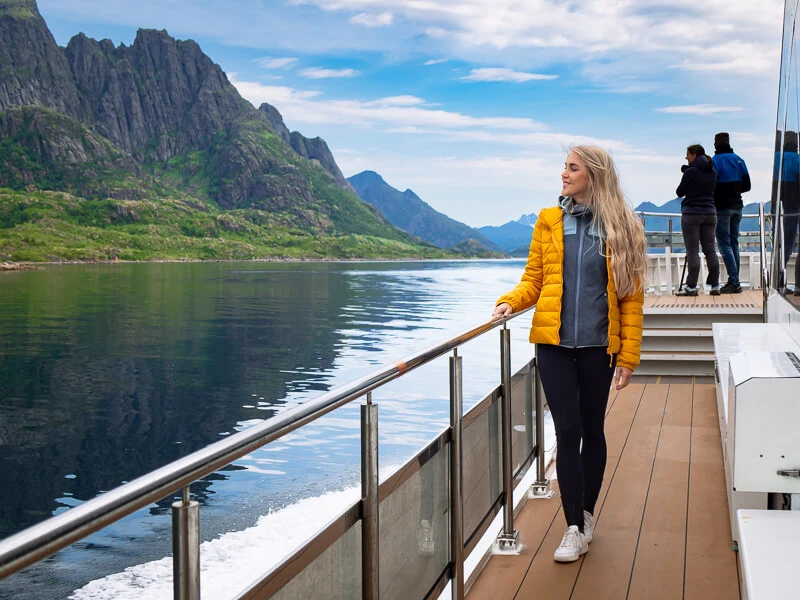
If you prefer something a bit more adventurous, you might want to take this 2-hour Sea Eagle Safari tour on a RIB boat instead.
After visiting Svolvær, drive west along E10, the main road of Lofoten. Stop at Rørvik Beach to swim in its clear tropical-looking water, visit the quaint fishing village of Henningsvær and do the nearby Festvågtind-Torsketunga hike – one of my favorite hikes in Lofoten .
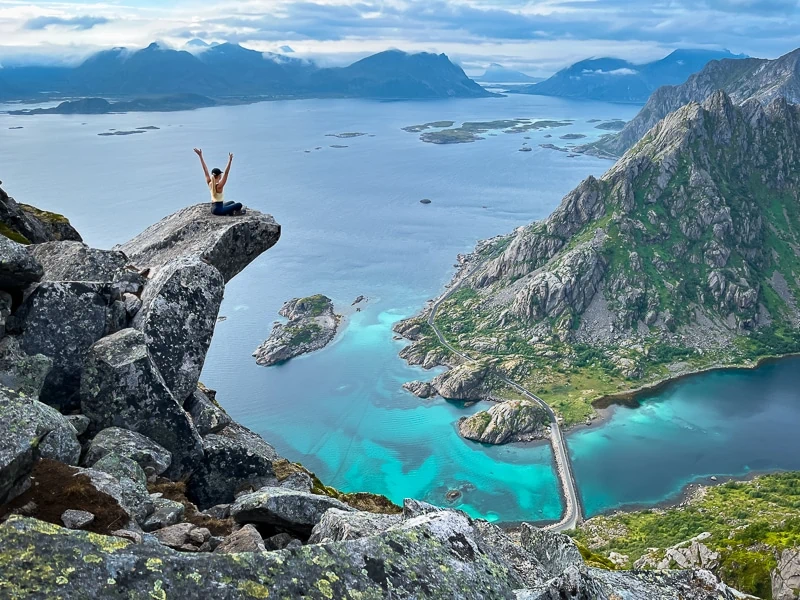
If you’re in Lofoten during the Midnight Sun period (approximately from May 27 to July 17), round off your day with a visit to Gimsøy Beach on the northern coast of Lofoten. As the beach faces north, it’s an excellent place for watching the Midnight Sun.
Where to stay
BUDGET: FURU Hostel & Café A cozy lakeside hostel with both dorms and private rooms, a sauna and a cafe.
MID-RANGE: Tobiasbrygga Stylish seaside apartments with rustic charm in Henningsvær.
Day 2: Eggum Beach, Haukland Beach & Nusfjord
Start the second day of your Lofoten itinerary with a visit to the tiny coastal village of Eggum to see its gorgeous white sand beach and wander along the scenic coastline.
Eggum Beach had the clearest water we saw anywhere in Lofoten. It’s a wonderful place for a refreshing morning dip if the weather allows it. Here you can also take a guided kayaking tour to explore the fjords and islets along the coast. For more details on Eggum, read my guide to the best beaches in Lofoten .
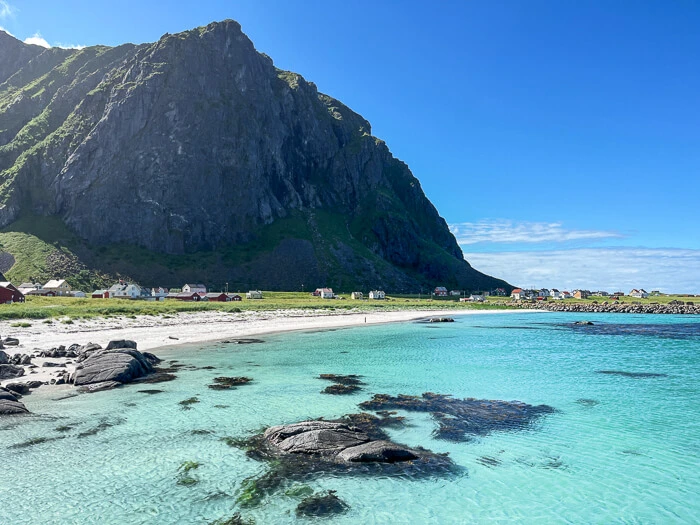
Next, drive to Haukland Beach, another stunningly beautiful beach in Lofoten. The water here is such a vibrant shade of blue and the sand so white that you could easily think you’re somewhere tropical.
Haukland Beach is also the starting point of the hiking trail to the peak of Mannen (400m/1312 ft), one of the most famous hikes in Lofoten . It takes just one hour to get to the peak, where you get a breathtaking view of the beach below.
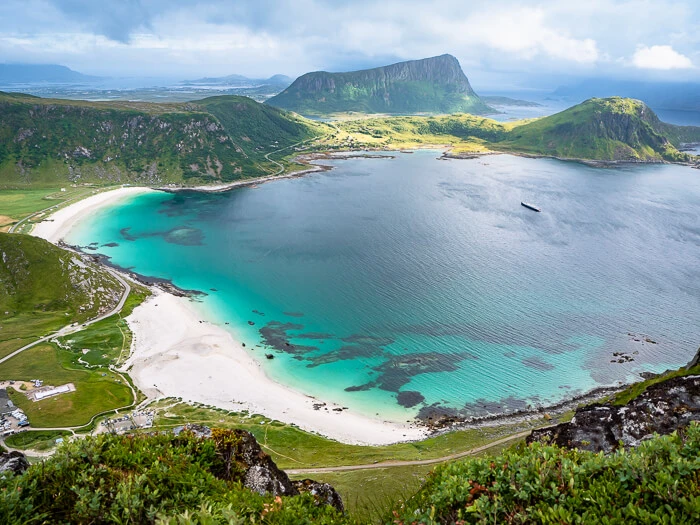
Finish the day with a visit to Nusfjord, a well-preserved historical fishing village on the edge of a small fjord. With its traditional architecture and fishermen’s cabins known as rorbuer , this place is like an open-air museum.
To enter the village of Nusfjord, you have to pay a fee of 100 NOK, unless you’re staying at a hotel in the village. If you don’t want to pay, you can still see Nusfjord from a free viewpoint above the village.
MID-RANGE: Ramberg Gjestegård Cozy cabins with a kitchenette and a sea view, located on the idyllic Ramberg Beach.
LUXURY: Nusfjord Arctic Resort A historic property with beautifully restored fishermen’s cabins, an onsite restaurant and a hot tub with views of the fjord.
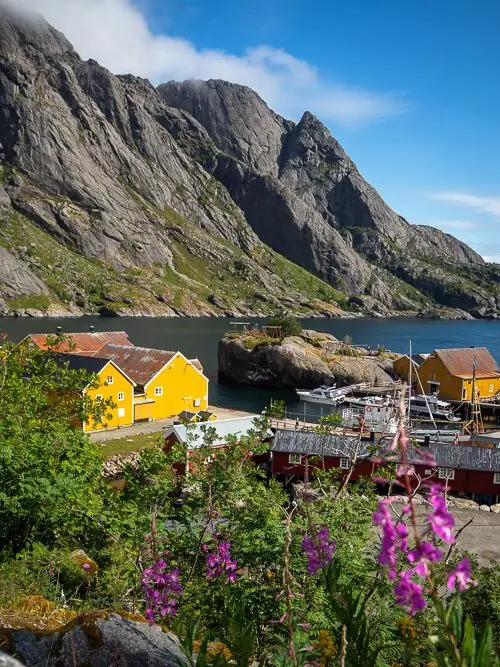
Day 3: Surfing, Ramberg Beach & Reinebringen
Kick off the third day with some Arctic surfing – a once-in-a-lifetime experience! You can rent surf gear or join a surfing class at Lofoten Beach Camp on Skagsanden Beach. This beach is ideal for beginner surfers since there are no dangerous currents or rocks. They also have SUP boards and kayaks for rent.
We went surfing here during our visit in July and it was definitely one of the highlights of my Lofoten itinerary. If you’re worried about the cold water, you really shouldn’t be! The head-to-toe wetsuits will keep you totally warm.
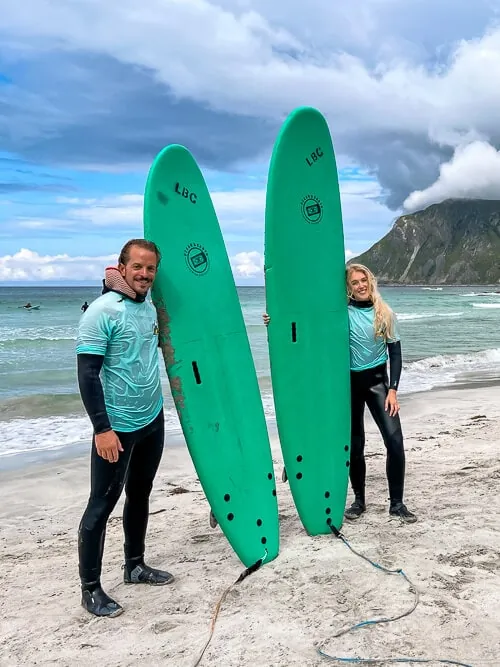
After that, it’s time to continue your Lofoten road trip and head further south along the E10. Soon you’ll reach the beautiful Ramberg Beach with its long strip of white sand and turquoise sea. It’s worth making a stop here to go for a stroll along the beach or go for a swim in case you didn’t get enough of these Arctic waters yet.
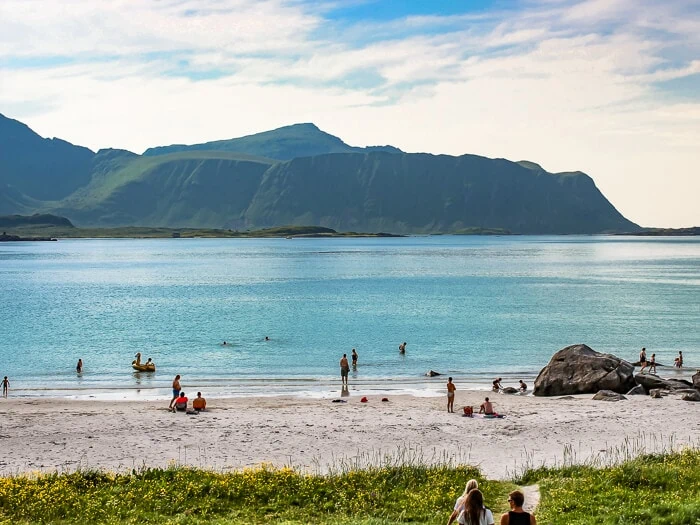
In the afternoon, visit the village of Reine. Tucked between dramatic mountains and fjords, Reine is known as the most scenic village in Lofoten. Because of that, it also gets very crowded in the summer.
Another reason you should visit Reine is to hike the iconic Reinebringen trail – by far the most famous hike on the Lofoten Islands. This short but steep trail takes you to the summit of Reinebringen where you’ll be rewarded with an incredible view of Reinefjord and the pointy mountains around it. If you’re visiting in the summer, I recommend doing this hike in the evening to avoid crowds.
Be sure to read my detailed guide to hiking Reinebringen to know where to find the trailhead, what to expect and what to bring.
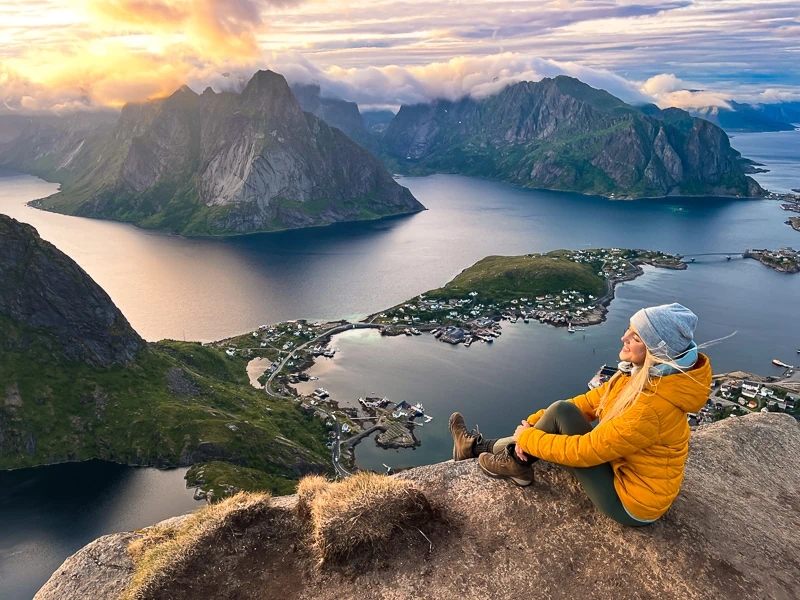
Spend the next two nights in or near the village of Reine.
MID-RANGE: Sakrisøy Gjestegård A charming renovated manor house from 1880; there’s a shared kitchen, a garden and rooms with views of the sea and the mountains.
LUXURY: Reine Rorbuer Stay in one of their traditional fishermen’s huts that has been converted into a cozy rustic cabin – a unique experience in Lofoten.
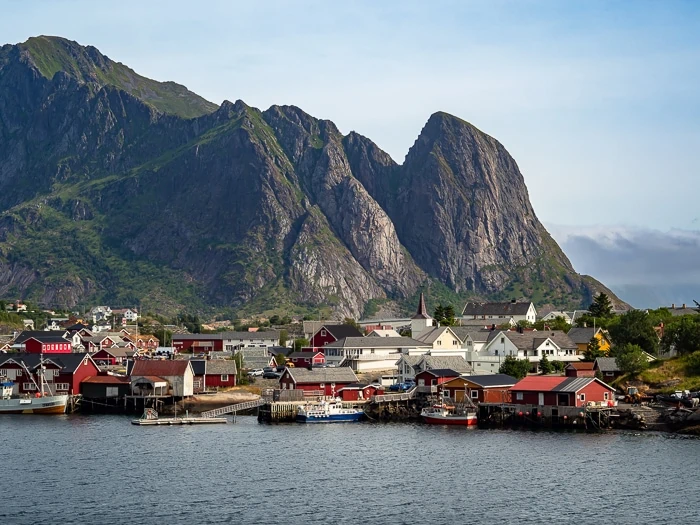
Day 4: Day trip to Værøy island
The 4th day of this Lofoten Islands road trip is all about exploring Værøy, one of the furthermost islands of the Lofoten archipelago.
To get to this tiny remote island, you have to take a ferry from Moskenes port in the morning. The ferry is free of charge for both cars and pedestrians and the journey takes a bit over an hour. Check the ferry schedule and start queueing several hours before the departure if you’re visiting Lofoten in summer to be sure you get a spot.
A must-do activity on Værøy is the hike to the Håen viewpoint. It’s an easy 3.2km (2 mi) hike to the top of a mountain peak offering a surreal view of the otherworldly landscape of western Værøy. I’d even say that this was my favorite view in all of Lofoten.
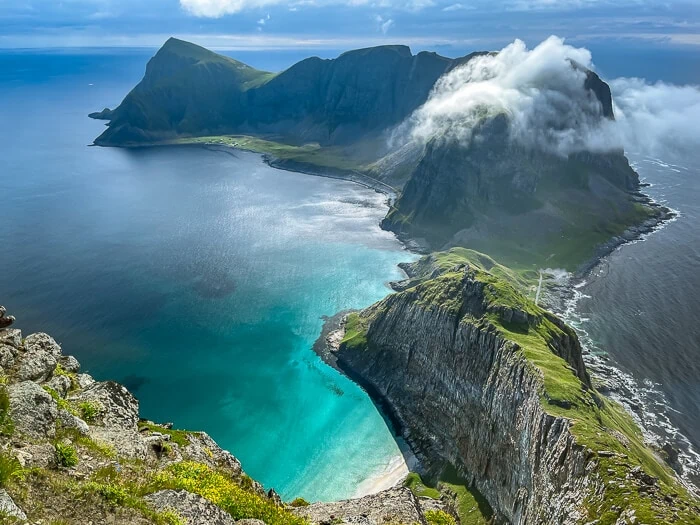
Besides the hike, you can also take a boat to the beautiful secluded Puinn Sand Beach or do a boat tour to see puffins. I also recommend going for a drive along the eastern coast of the island all the way until you reach the end of the road and see an abandoned airstrip. It’s a very scenic drive with amazing views along the way.
In the evening, take the ferry back to Moskenes. If you’re visiting in the summer, get to the port at least two hours in advance to secure your spot.
Note: Outside of the summer months you might not be able to visit Værøy on a day trip because there are fewer ferry departures.
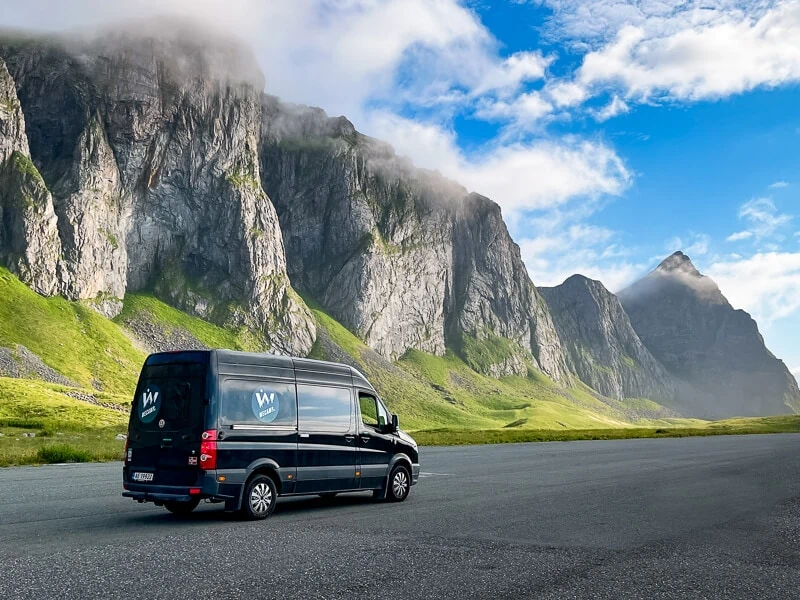
Spend another night in the hotel you stayed at the night before. My recommendations are Sakrisøy Gjestegård and Reine Rorbuer .
Day 5: Kvalvika Beach & Ryten hike
On the final day of your Lofoten trip, do the hike to Kvalvika Beach. Hidden between steep granite mountains, this spectacular isolated beach is considered one of the best beaches in Lofoten .
To get to the trailhead, drive over the scenic Fredvangskrysset bridges to Innersand village. From there, the hike to the beach takes about 1.5 hours. For a fantastic birds-eye view of Kvalvika Beach, you should also do the detour to the peak of Ryten that towers over the beach. This adds another hour or two to the hike.
After that, it’s time to wrap up your 5-day Lofoten itinerary and start heading back towards Svolvær. The drive should take about two hours.
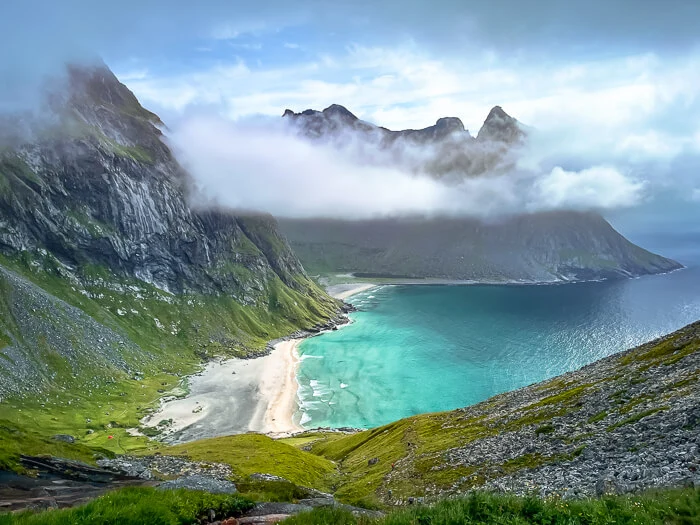
Lofoten Islands itinerary map
On the interactive map below, I’ve marked the exact driving route of this itinerary for Lofoten as well as the points of interest and hotels I mentioned in this post. Click on the top left corner of the map for more details.
Other places to add to your Lofoten itinerary
If you can spend more than 5 days in Lofoten or you’re simply looking to add other stops to your itinerary, here are some places and activities that might interest you:
- Visit Lofotr Viking Museum – In this museum , you can travel 1000 years back in time and see how the Vikings lived. It’s the perfect place to visit on a rainy day.
- Go horseback riding – Explore the beautiful coastline of Lofoten on this guided horse riding tour with Icelandic horses.
- Explore Å – Located on the southern end of the Lofoten archipelago, the village called Å is the furthest point you can drive to in Lofoten (without taking a ferry). Here you’ll find both the Norwegian Fishing Village Museum and the Stockfish Museum.
- Take a Midnight Sun kayaking tour – On this 3-hour kayak tour in Eggum, you can witness the Midnight Sun phenomenon from the water.
- Go to a sauna – It’s the best way to warm up on a chilly day. You can find public saunas in many places in Lofoten. Some examples are Hamnøy Sauna, Hov Gård Sauna and LYST Lofoten Sauna .
- Chase the Northern Lights – Between September and early April you can see the stunning Aurora Borealis in Lofoten. For the best chances of seeing them take a Northern Lights tour with an experienced guide.
Best time to visit the Lofoten Islands
The best time to do this Lofoten road trip is from mid-June to the end of September. In this period, the weather is the best, days are long and hiking trails are free of snow. July and August are the warmest but also the busiest months.
The Midnight Sun period in Lofoten lasts from May 27 to July 17. In this period, the sun never sets and there’s 24 hours of daylight each day. It’s a mind-blowing experience!
Winters in Lofoten are cold and have only a few hours of daylight. During the Polar Night period, which lasts from early December to early January, the sun won’t rise above the horizon at all. It won’t be completely dark though during that time and in the middle of the day you can often see beautiful pastel colors of twilight in the sky. From September to mid-April, you can see the Northern Lights in Lofoten.
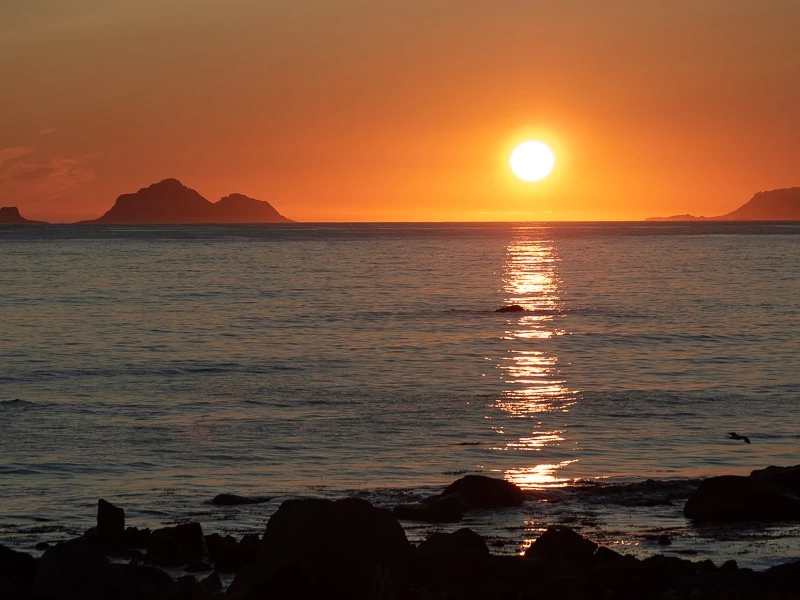
How to get to the Lofoten Islands
The best way to get to the Lofoten Islands is to fly to one of the airports in or around the archipelago. The two airports on the Lofoten Islands are Svolvær and Leknes. Other airports within a reasonable distance from Lofoten are Bodø, Narvik and Tromsø.
From Bodø, you can take a 3.5-hour express boat to Svolvær ( see the schedule ) or a 3-hour ferry to Moskenes ( see the schedule ) in Lofoten. From the other destinations, you can drive to Lofoten. From Tromsø it’s about a 6-hour drive and from Narvik it’s a 3-hour drive.
If you’re looking to rent a campervan for this Lofoten itinerary like we did, I recommend flying to Tromsø, Narvik or Bodø as there aren’t many campervan rental options on the Lofoten Islands.
Related post: Tromsø itinerary for 4 days
Lofoten itinerary: Final thoughts
I hope that this Lofoten Islands itinerary gave you some ideas for planning your own trip to this fantastic corner of Norway. It’s a destination that should be on every nature lover’s bucket list!
If you have any questions about this itinerary or about traveling in Lofoten, let me know in the comments.
For more tips and inspiration for planning your trip, check out my other Norway travel guides:
- Silent Trollfjord Cruise in Lofoten
- Best hiking trails in Lofoten
- Visiting Senja, an off-the-beaten-path island
- The most beautiful beaches in Lofoten
- How to travel by campervan in Norway
- Tips for hiking Reinebringen, Lofoten’s most famous hike
- How to spend 4 days in Tromso
Pin this Lofoten itinerary!
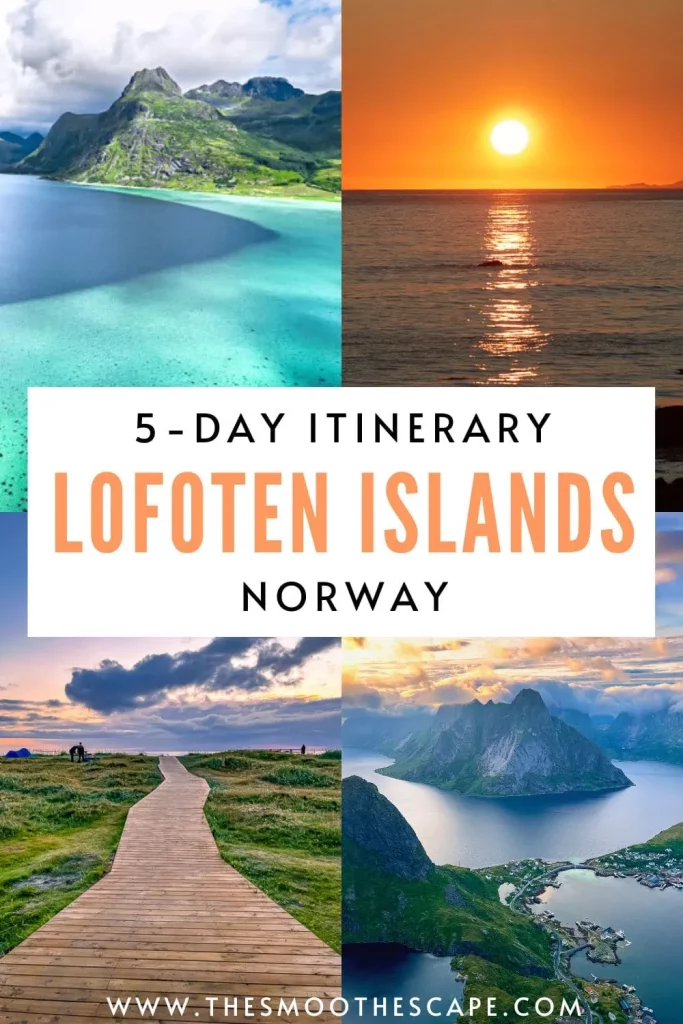
Why you should take a Trollfjord cruise in Lofoten
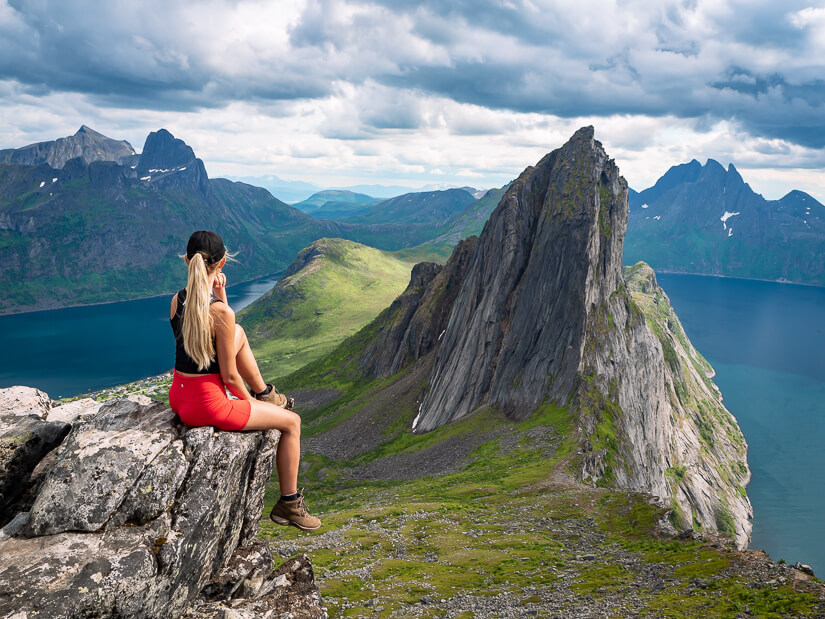
Visiting Senja Island in Norway: A complete travel guide
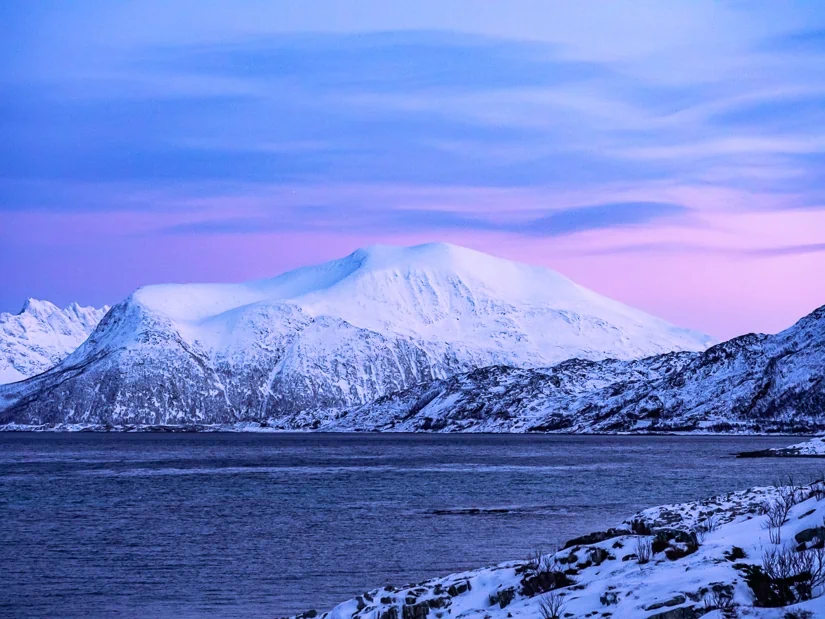
Tromso itinerary for 4 days: The perfect Tromso winter trip
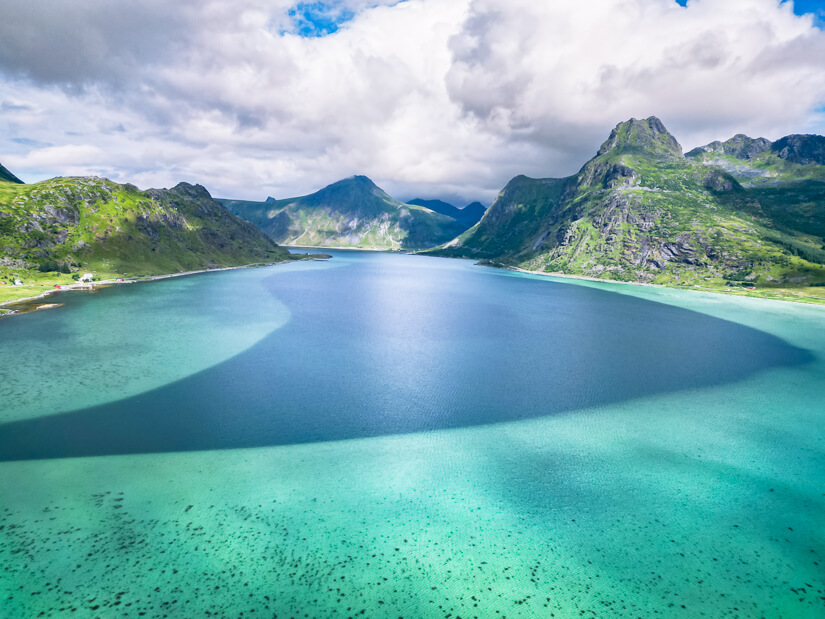
Reinebringen hike: The most famous view in Lofoten, Norway
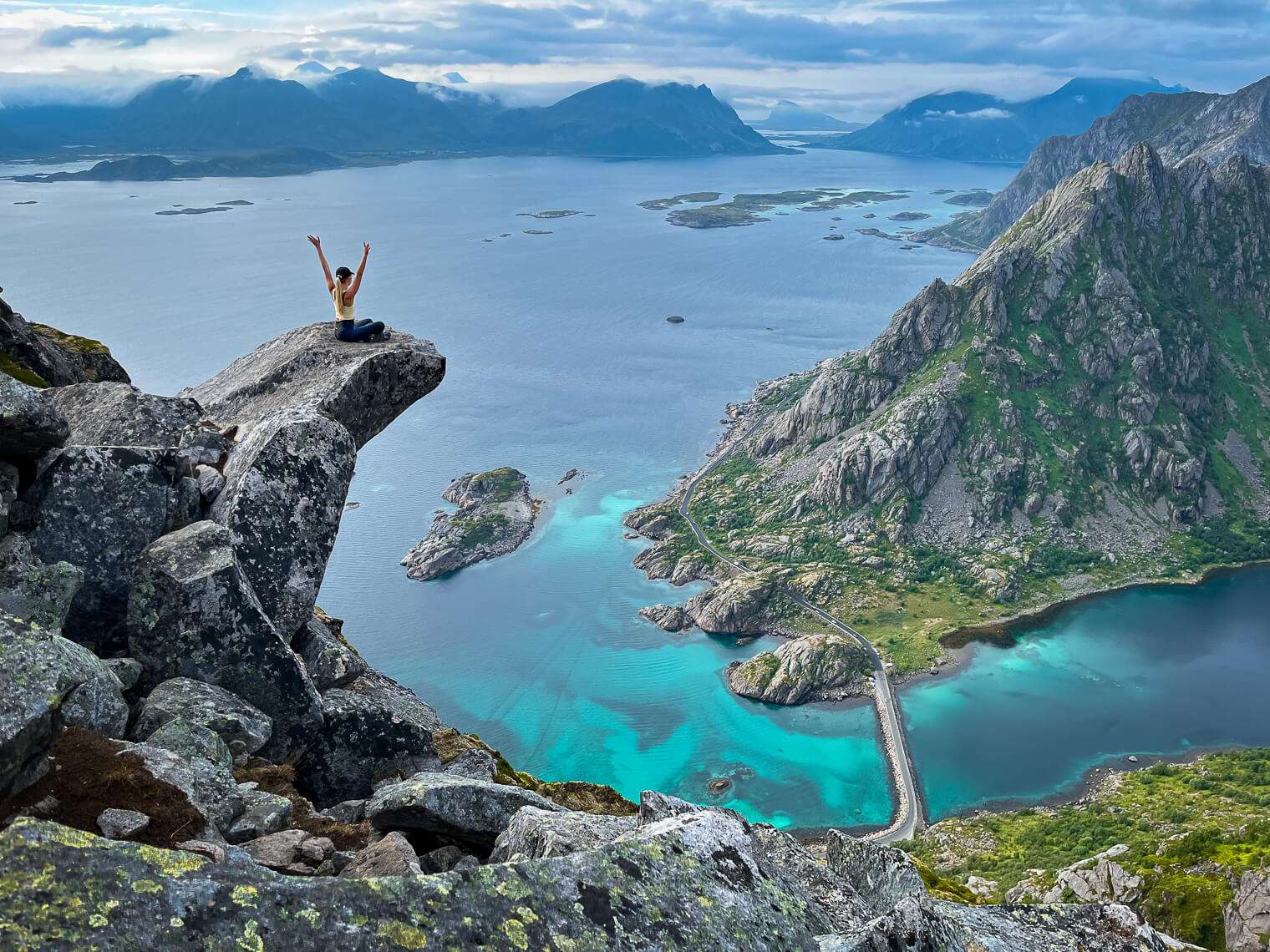
Hiking in Lofoten: 10 epic hikes on Lofoten Islands
Leave a reply cancel reply.
Your email address will not be published. Required fields are marked *
Stunning Outdoors
7 Day Lofoten Itinerary – how to plan an epic road trip
Norway · Road Trips

About the Lofoten itinerary
It is not easy to prepare a guide to places worth visiting in Lofoten Norway. The best Lofoten itinerary could probably be condensed into a short advice – just wander , take a small road, check what’s around the corner and be flexible as much as possible.
And, if we could highlight only one thing to help you plan your trip to Lofoten, that would be – be flexible . We kept changing our plans daily due to various reasons; two most important were the weather and ferries to small islands timetable. We think we were unlucky with the weather when visiting Lofoten, as it rained every day, therefore many days we just tried to chase the sunshine. But, have we really been unlucky, or it’s just a typical arctic summer weather…? We wish, we knew how to better prepare for Lofoten road trip and what to expect .
We are outdoors enthusiasts; hence the road trip itinerary is focused on providing solid information on Lofoten’s hikes, walks and best scenic beaches we experienced. No guide, though, would be completed without a note about MUST SEE fishing villages in Lofoten. They are beating hearts of the archipelago with red and yellow rorbu (or rorbuer), fish racks and harbours.
We travelled through Lofoten in our self-converted camper van and stayed off grid most nights, so we’re sharing camping spots (and campsites) information. By own experience, we know how difficult is finding a suitable overnight stay spot (especially sleeping in tent), hence we believe that many of you will find this information very useful.
Journey to Lofoten
We have already been on the road for a month, and we were getting excited to be closer to Lofoten islands in Norway. Unfortunately, the weather conditions were against us – on the day we were supposed to take ferry from Bodø to Moskenes, we were woken up by heavy rain and wild wind. We already knew we won’t make it to Lofoten that day (ferry was cancelled), we decided however to drive to Bodø and search for a campsite. All day our camper struggled against the elements and upon our arrival to Bodøsjoen campsite we were greeted by huge puddles and not a single soul.
Instead of visiting Bodø, we spent the afternoon at campsite’s kitchen and our lovely camper – the rain never stopped, but weather forecast for next day looked promising. We decided to take 11am ferry, arrived to the terminal early and queued in the ‘no reservation’ line, hoping the ferry will sail. We have heard that the crossing to Lofoten can be rough and yes, we confirm that’s true.
Sailing from Bodø to Moskenes was a rough 3.5 hours journey, and we both felt rather tired and sick upon our arrival to Lofoten. Also happy – we have planned to visit this remote archipelago for several years. I admit, we had high expectations of Lofoten ; and sharp mountain ridges shrouded by low clouds we admired from ferry were a promise of great days to come.
7 DAY ROAD TRIP IN LOFOTEN ITINERARY
Day 1 – Å i Lofoten and Lake Agvatnet Day 2 – Tind, Sorvagen and hike to Munkebu hut Day 3 – Reine, Sakrisøya, Hamnøy, Yttersand Beach and hike to Roren Day 4 – Hiking to Ryten and Kvalvika Beach Day 5 – Nusfjord – Unesco World Heritage Site, and Haukland Beach Day 6 – Uttakleiv Beach and hike to Veggen mountain Day 7 – Henningsvaer and Svolvaer
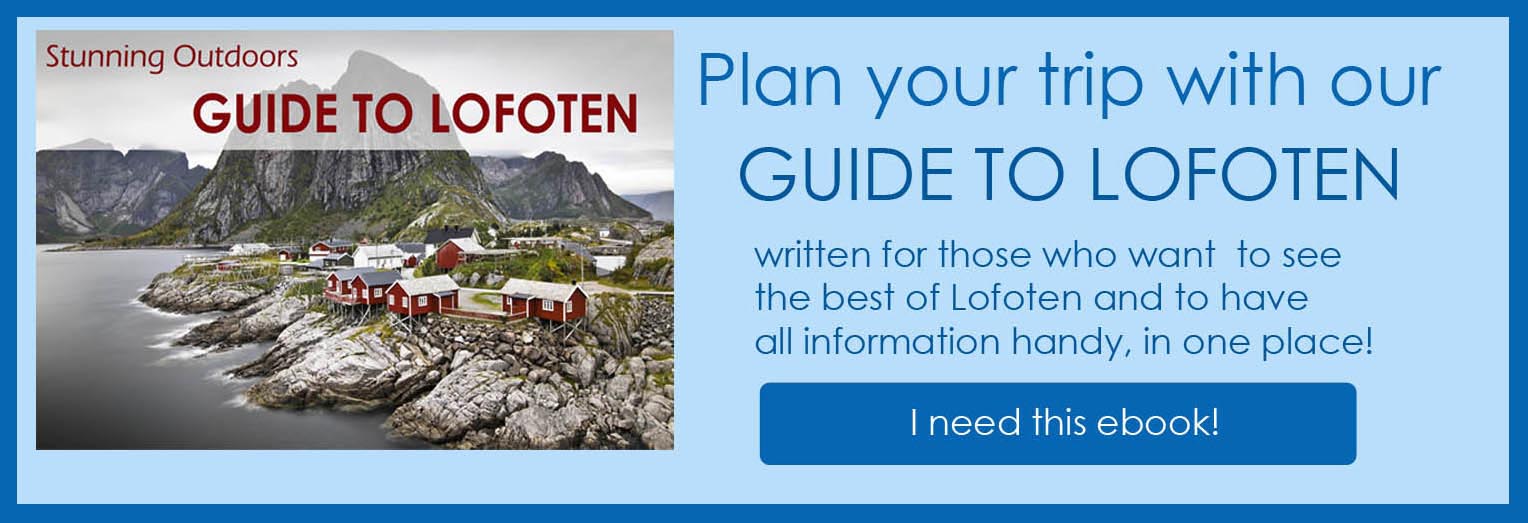
Day 1 – Å i Lofoten and Lake Agvatnet
Our plan was to explore Lofoten from west to east, starting at westernmost point accessible by car – village Å.
Å is often referred to as ‘Å i Lofoten’ (meaning: Å in Lofoten), to distinguish it from several other Å settlements in Norway. Dating back to 16 th century, it was an important fishing port until about 100 years ago. Nowadays, Å is a charming traditional village with circa 100 local residents, very typical for Lofoten, with its red wooden fishermen’s houses built on water (rorbu or rorbuer) and relaxed atmosphere; it’s also a great tourist attraction.
Apart from historic and traditional sights, Å i Lofoten is a perfect location to start a road trip in Lofoten! Why is that? Simply because it’s the beginning of European route E10 (Norway – Sweden) which also happens to be Lofoten’s main road, known as King Olav’s Road.

A i Lofoten is only 5 km west from ferry harbour in Moskenes, so after a short drive we arrived to large visitors car park at the very end of road; where our journey thru Lofoten began.
What a surprise, first impression of Å was spoiled by heavy rain! We reached car park at the very end of E10 just past village Å in total downpour. Luckily, we didn’t have to wait long for rain to pass.
Finally being in Lofoten, surely everyone will be eager to go exploring! As Å is only a small village, sightseeing doesn’t take long, it’s OK to visit in the evening.
For the afternoon we planned a hike to Stokkvika, however it turned out to be much more time consuming than we anticipated and instead of hiking Stokkvika we only explored shores of neaby lake Agvatnet.
We picked one of dozens paths beginning at the far end of car park and slowly progressed to the lake shores. It was our first experience of Lofoten’s trails, but a very typical one. Path was very wet throughout, some sections hardly passable dry footed. The trail itself was a good introduction to hiking in Lofoten. Unfortunately, upon reaching the head of Agvatnet we endured another downpour and, as clouds were not clearing, we decided to call it a day and return to the camper.

Hiking along lake Agvatnet
On the way back we came across a small wooden shed, filled to the full with dry fish heads! No need to mention, that we smelled it even before we saw it! Everyone knows that Lofoten is famous for drying cod; fish hanging about for months on special wooden frames (mainly in spring), known as ‘stock fish’. However, we were a bit puzzled to find a shed full of fish heads; we noted to find out what locals use it for. Would you like to have a guess??? We learned that dried cod heads are exported to Africa, where they are a delicacy! Nothing goes to waste, even dried fish heads!

Shed filled with dried fish heads
Evening was warm and calm, so we headed to village Å for a wander. There is a tourist trail starting at the car park (near gift shop), leading to the village; and it’s only about 10 minutes walk. We took time to explore Å i Lofoten: checked out the dwellings, Stock Fish Museum, local pub and the stream which runs from lake Agvatnet to the ocean thru the village – and actually gives the village its name – Å. Most importantly, we had a close look at Rorbu- Lofoten’s iconic red wooden houses. They used to be homes to fishermen, nowadays are mainly a tourist accommodation.

Exploring A i Lofoten

Visit stock fish museum in Å
Handy information:
- Parking at Å i Lofoten visitors car park (click here for directions) is free of charge. Facilities include a gift shop, toilets (open 24/7) and rubbish bins. Overnight stay in campers is allowed. There also is a bus stop of Lofoten Line 300 (bus routes and timetables in Lofoten) .
- Walking to head of lake Agvatnet (and back) takes about 2 hours, trail is wet and slippery in places.
- Online map of the area is available here (Norgeskart).
- Å i Lofoten weather forecast – click here for information
- Camping information. Nearest campsites are located in Moskenes. We can recommend Moskenes Camping (website) , price for camper van in 2018 was 320 NOK (340 NOK including electricity). Wild camping – staying overnight is allowed at visitors car park in Å (camper); despite it being a busy spot we stayed there for 2 nights without any trouble, and recommend it. Pitching a tent around the car park is not allowed and the only option is to camp up in the hills or over lake Agvatnet. Be prepared to spend some time searching for a suitable spot as the ground is very wet.
- How to see Å i Lofoten from above? Hike to Tindstinden , a stunning viewpoint over Å!
Return to top of page

Day 2 – Tind, Sorvagen and hike to Munkebu hut
We woke up to a glorious morning! If only weather in Lofoten spoiled us with sunshine more often!
Rested and happy we had breakfast outside, enjoyed morning coffee with the view! Soon, we were ready to begin the adventure, head east along E10 road and explore the islands!

Wooden racks for drying cod are integral part of Lofoten’s landscape. Fish drying season starts in mid-February and lasts till end of April
Being Lofoten newbies, we didn’t drive far before safely leaving the camper along the road, to take photographs. In fact, we only drove 2 kilometres before stopping for a photo break in Tind, and then stopping again 1 kilometre further, in Sorvagen. We felt that it would be much better and wiser to leave the car somewhere and just walk along the road! Scenery in front of us was fantastic, it was impossible to resist taking photographs!

We jumped in the car again and followed E10 road thru Sorvagen. But only a minute later we spotted a signpost on left hand side, to a waterfall. ‘Nothing wrong with a quick visit to a waterfall’, I said and Bea agreed. Having arrived to dedicated car park we noticed more signposts – to waterfall as well as to Munkebu mountain hut.
The waterfall was only a short walk away, worth visiting. But as we admired it, a thought came to my mind – why not find out more about Munkebu hut hike, maybe it’s worth a visit too? Bea was very keen on exploring it as well, therefore after a quick research we changed; geared with hiking boots we headed to Munkebu h ut . It was a great adventure and highlight of the trip to Lofoten!
Again, we cannot highlight enough how important it is to be flexible and go with a flow.

Munkebu hut, in the wilderness of Lofoten’s mountains
Munkebu hut is located in wilderness of Lofoten’s mountains, surrounded by rocky peaks and blue lakes. Along the way we passed dozens of waterfalls. The only regret we had was starting the hike a bit too late (mid-day); if we started earlier we would be able to extend the hike and climb rocky summit over Munkebu hut – Munken ( we did conquer Munken on our second visit to Lofoten. What is more, we also challenged ourselves to the highest peak on Moskenesoya island, Hermannsdalstinden , with a sleepover at Munkebu hut)

Hiking thru Lofoten’s mountains
We returned from Munkebu hut some 6 hours later, in late afternoon. It was time to look for an overnight stay spot, and, as we were still near village A i Lofoten, we drove back to the large car park at road’s end.
What a day, we managed to only drive 3 kilometres from where we started in the morning!

- There are no facilities at the free waterfall and Munkebu hut dedicated car park in Sorvagen (directions)
- Sorvagen is home to two grocery shops
- Munkebu hut weather forecast – click here for information
- Camping information. Nearest campsites are located in Moskenes. We can recommend Moskenes Camping (website) , price for camper van in 2018 was 320 NOK (340 NOK including electricity). Wild camping – staying overnight is allowed at visitors car park in Å (camper); despite it being a busy spot we stayed there for 2 nights without any trouble, and recommend it. Pitching a tent around the car park is not allowed and the only option is to go up the hills over the lake Agvatnet. Be prepare to spend some time searching for a suitable as the ground is very wet.
- Wild camping in Sorvagen is only allowed on higher ground in mountains.
- Lofoten public transport routes and timetables, click here
- Detailed information about hikes from Sorvagen: Munkebu hut and Munken , Tindstinden, Hermannsdalstinden.
Other epic road trips in Norway!
Drive along Helgelandskysten and explore scenic tourist route along the shores of Helgeland, visit small arctic islands! Or why not discover Lyngen fjord, with its scenic roads and dramatic mountains? Are you more of an ‘islands’ person? Let us take you on a road trip of a lifetime in Senja , or show you the hidden gems of Vesteralen !

Day 3 Reine, Sakrisøya, Hamnøy, Yttersand Beach and hike to Roren
We left Å i Lofoten (again!) looking forward to new adventures!
We briefly stopped in Moskenes, only to visit tourist information office and buy a hiking map, as we planned to do some walking in Lofoten. Unbelievably, tourist office had just ran out of hiking maps, what were the chances?! In this instance we were forced to search for online maps, and eventually lack of printed materials at tourist office worked to our benefit – we found a good online map with marked hiking trails (and used it ever since) which was perfectly sufficient for our needs. Check out online Norgeskart map (here) , it comes very handy!

Reine, Lofoten
We headed to Reine with hope that weather will hold (it was so warm and sunny!) and plan to conquer Reinebringen – the iconic viewpoint over Reine village and world-famous views to islands scattered over Reinefjorden.
We decided to skip hiking Reinebringen thou. Why was that? As the viewpoint has been extremely popular over the years, the steep and rugged mountain trail deteriorated and eroded greatly. That led, over the years, to increased number of accidents on the in-maintained trail, including several serious injuries. Local authorities decided that a new trail is needed, the Sherpa team was brought in from Nepal to carry out work. Work on new trail started in 2016, it’s a slow process and, as we understand, there is no deadline. In October 2018, 870 steps have been completed and work will continue again from August of 2019. Local community asks tourist not to walk on the trail while works are carried out.

We though it is only right to respect the local community, and decided to choose other hikes in Lofoten. There are plenty to choose from – all with amazing views. Please think twice before deciding of going up to Reinbringen view point and check with Moskenes Tourist Information what is the situation with the trail. Remember, be flexible.

Instead, we set to explore village Reine .
Free parking in Reine Lofoten is located just off main road E10 (directions) and fits up to 20 cars. It’s less than 1 kilometre to village’s harbour and rorbu (red fishermen’s houses). There are other, more central car parks in Reine, however charge applies.

Reine. Having a look around you might come to some surprising discoveries!
What we really liked about using the free car park was the short walk to village’s heart. On the approach to village we could admire its beautiful location – calm waters of Reinefjorden, rorbu and mountains towering in background. Heart of Reine consists of a small boat harbour and rorbu; also at main square we found cafés, gift shop and a tiny self-service petrol station. Reine definitely is worth a couple of hours visit. We had a wander around the village; discovered that some locals store their boats in special shelters at house-side, or even under the house! We’ve never seen such thing, it still brings smile to my face… Lofoten are just SPECIAL.

Our next stop were Sakrisoya and Olenilsoya , approximately 2 kilometres past Reine, along road E10.
The islands are best visited together – the best views to Sakrisoya’s famous yellow rorbu are from western shores of Olenilsoya island. The only place of interest apart from yellow rorbu on Sakrisoya is a very popular café and delicatessen –Anita’s Seafood. Its interior is styled typically to Lofoten, so we encourage everyone to have a look inside. Also, the delicatessen sells genuine stock fish (Lofoten’s famous dried cold) as well as smoked fish of all kinds. We really enjoyed oat cakes with cream cheese and locally smoked salmon from Sakrisoya!

Sakrisoya’s delicatessen – stockfish (dried cod) at Anita’s Seafood
Olenilsoya itself is less interesting with sparse modern houses, but makes a fantastic viewpoint to its smaller neighbour –Sakrisoya. Why not take a small path to its highest point (walking distance 300 metres) for an overview of the area?

Sakrisoya’s rorbu
Less than a kilometre north from Sakrisøya is another world-famous fishing village, Hamnøy .
Who hasn’t seen the iconic photo of Hamnøy’s red rorbu?! I’m sure that many of Lofoten’s visitors are actually drawn to the islands by that single shot – blue fjord waters, red rorbu with a dramatic rock behind. And we were too! Only to find that in reality Hamnøy isn’t a scenic little gem of Lofoten… Based on the iconic photograph, we imagined the village to be located in wilderness, breath taking, and remote.

We found out that Hamnøya is not only divided in two by main road E10, but also industrialised. The famous red rorbu photo reflects only one side of Hamnøy and, in fact, is misleading! The photograph is taken from one specific spot along main road to the village. We sadly admit, that Hamnøya was one of disappointments we experienced in Lofoten, as in real life it’s just different to what you see on social media.

Nonetheless, visit Hamnøya – take a walk amongst rorbu and to the harbour, find its real face and decide for yourself whether it lives up to your expectations.

Leaving Hamnøy, we continued north, stopping along the road only occasionally. We followed E10 to the very end of Selfjorden where we turned left, towards the most northerly tip of Moskenesoya island. There, at the very end of the road Fv806 was our next destination – village Yttersand.

Yttersand Beach from Roren
We found out that nearby area offered great hiking trails and amazing white sanded beaches, therefore we were keen to explore it. As a warm up we planned a nice, short hike to Roren , a viewpoint over Yttersand Beach . It takes only a couple of hours, but offers great view to the beach and nearby mountains, as well as the next island of Lofoten archipelago – Flakstadoya.

Yttersand Beach
It was a great idea to finish the day with a visit to Roren viewpoint, we greatly enjoyed the views, the trail and most importantly – the beach walk. After the whole day of photo shooting in Lofoten’s villages, we were finally in nature, which we always enjoy the most!
Apart from Roren and Yttersand Beach, the area offers another amazing ‘mountain + beach’ hike: Ryten and Kvalvika Beach . Obviously, we couldn’t resist that one either and made it our next adventure!
- Nearest tourists information offices are located at Moskenes harbour and Ramberg
- Free car park in Reine (directions)
- Nearest petrol stations: Reine (directions) , Ramberg (directions)
- Nearest supermarkets: near Reine (directions) , near Ramberg (directions)
- Sakrisoya delicatessen – Anita’s Seafood (directions)
- Free parking at Hamnoy (directions)
- Reine weather forecast – click here for information
- Roren weather forecast – click here for information
- Camping information. Campsites: Moskenes Camping (website) , price for camper van in 2018 was 320 NOK (340 NOK including electricity) or alternatively Fredvang Strand Camping at the far end of Yttersand Beach. Wild camping – it’s generally tricky to find a wild camping spot (especially camping in a tent), as it’s forbidden by land owners in most suitable places. One can camp at Roren ridge, or alternatively there are small parking bays along E10 towards Moskenes (directions) and we stayed there 2 nights in camper van.
- Lofoten public transport routes and timetables (click here)
- Detailed information on hiking to Roren viewpoint and visiting Yttersand Beach
- Detailed information on hiking to Ryten and Kvalvika Beach

Day 4 – Hiking to Ryten and Kvalvika Beach
Next day we woke up to horrendous weather; torrential rain and wind so strong that the camper was rocking like a toy boat on the sea. We didn’t have much choice but stay put, wait for conditions to improve. This is the very reason why I mentioned that you’ll have to keep and open mind and be flexible while working on your Lofoten itinerary – sometimes you’ll loose a day or two simply because weather is too wild!
Travelling in a camper van, we had luxury of dry and warm place to stay without need to look for café or accommodation. Hence, from the parking bay we slept at, we drove to nearby Fredvang Rest Stop (large car park with toilet, directions ) to wait for weather improvement. Sadly, conditions improved only in the evening, and it was too late to hit the trail. As overnight stay is forbidden at the rest stop, we moved back to the same parking bay as night before, hoping to hike Ryten and Kvalvika Beach next morning.

At Fredvang Rest Stop
To our great relief, wind calmed overnight and morning was quiet and warm; there was nothing to stop us from heading to Ryten trailhead, just past Fredvang village.

At Ryten summit
We both really enjoyed the hike and encourage everyone to check it out! Total distance is about 7.5 kilometre, total time (including chill out at Kvalvika Beach) is 5-6 hours. Path is very easy to follow for most of the hike.

Cliffs of Ryten towering above Kvalvika Beach
We set off to Ryten early in the morning, and reached the summit at 9.48am! I think, it’s one of the earliest conquered mountain tops in our hiking career. At the summit we only met one other couple, which was great, as Ryten is one of most popular hikes in Lofoten and tends to be busy. From Ryten, we descended to Kvalvika Beach – an amazing, white sanded beach hidden behind mountain wall. It was a great spot to relax – we walked along water edge, escaping incoming waves, picking up sea shells and pebbles. Oh, Kvalvika Beach was fantastic!
Kvalvika Beach was busier than Ryten summit; there were campers (some still sleeping in their tents!) as well as dozens other visitors. Where did they all come from since we didn’t meet that many walkers coming from Ryten? You’ll be glad to know, that there is an easier, direct way to visit Kvalvika Beach – without need to hike a mountain, and many tourists take that trail.

Hiking to Ryten, view to Flakstad
How to visit Kvalvika Beach directly? Further along road Fv808 past Fredvang is another small car park, direct trail to Kvalvika Beach starts there. It’s an easy trail, therefore many walkers choose this route when visiting with children, or simply if they’re tight on time.
How to extend Ryten and Kvalvika Beach hike? Keen hikers may consider extending the hike by taking a different return path from Kvalvika Beach. It is signposted as ‘Markjorda via Vestervika’ – walk all the way to the western end of the beach, then turn left, follow a path climbing to mountain pass, and later passing two lakes. By taking this route you’ll add 4.5 km to the hike.

Kvalvika Beach Lofoten
After about 6 hours of hiking bliss, we returned to the camper and looked for campsites nearby. Unfortunately, apart from infamous Fredvang Strand, there were none! Eventually we decided to drive back to Moskenes Campsite – this one, at least, was open, had good reviews and facilities. After a well-deserved hot shower we spent quiet evening at campsite’s kitchen, cooking and chatting.
Handy information: – Nearest tourists information office: Ramberg (directions) – Nearest petrol station: Ramberg (directions) – Nearest supermarket: Ramberg (directions) – Ryten weather forecast – click here for information – Camping information. Campsites: Moskenes Camping (website) , price for camper van in 2018 was 320 NOK (340 NOK including electricity), Skagen Camping in Flakstad (website) or alternatively Fredvang Strand Camping at the far end of Yttersand Beach. Wild camping – it’s generally tricky to find a wild camping spot (especially camping in a tent) however, there were many good wild camping locations along the trail, especially at Ryten summit and Kvalvika beach. Alternatively, there are suitable, small parking bays along E10 towards Moskenes which we stayed at for 2 nights (directions) – Lofoten public transport routes and timetables, click here . – Detailed information on Kvalvika Beach and Ryten hike, with full explanation of the trail, hiking map and shorten/extend options.

Day 5 – Nusfjord – Unesco World Heritage Site, and Haukland Beach
Oh, how much we would love to admire roadside views and sights in sunshine, this would be a totally different experience! Instead, Lofoten treated us with its typical weather. Despite getting used to rain & wind over the 8 days we spent on archipelago, we still longed for warmer and sunny days. It seemed that every single day of our visit to Lofoten we had to shelter from rain; visit to Nusfjord was no exception!
Nusfjord was our next destination, and we were excited to visit this unique village, hidden behind a wall of rocky mountains.

Nusfjord Lofoten
Since we left main road E10 and turned into road 807 taking us directly to Nusfjord, the scenery became very dramatic. The road followed narrow valley between rugged mountains, their tops constantly in clouds. Maybe it’s hard to imagine that views, although half obscured by low clouds, can still be amazing. Road to Nusfjord was spectacular!

Welcome to Nusfjord!
It rained mercilessly all the way to the fjord, rained still when we arrived to Nusfjord. Bea suggested we could have the dinner first and then see if rain stops. It was a very good idea, as about 20 minutes later the sun came out (only briefly) and we set to explore the village.
Nusfjord is a small fishing village on Flakstadoya island. What’s so unique about it? Nusfjord has been an Unesco World Heritage Site since 1975 as one of best preserved fishing villages in Norway. The greatest attraction is its old part – yellow rorbu and original tran (cod liver oil) refinery. Looking at Nusfjord now, we easily imagined how busy it must have been back in the day; fishermen landing cod in the harbour, then moving it to refinery where oil was cooked. OK, Nusfjord is a small village nowadays, but in past used to be an important spot on fish oil industry map!

Dried fish heads at Nusfjord harbour
Nusfjord has a marked tourist trail, taking visitors to its most important locations. Bea and I followed it to ensure we don’t miss anything – red rorbu, old harbour, yellow rorbu – oldest buildings in the village, and the historic cod liver oil refinery, ever present wooden fish racks.

Rorbu at Nusfjord
First we focused on red rorbu at the edge of Nusfjord. We followed a wooden walkway thru a maze of small houses. I was surprised to see how many there were!

Nusfjord oldest buildings
Then, we visited the oldest part of Nusfjord, yellow wooden buildings concentrated along the harbour. These old houses are still habituated and used today – as a warehouse, post office, pub and a shop.
Further, we continued to the other side of harbour, to the oldest ‘Trandamperiet’ (cod liver oil refinery), now a museum. Directly past the refinery is a small hill, fantastic viewpoint to the village! We took the best photos of Nusfjord from that viewpoint and recommend checking it out.

Old cod liver oil refinery (left) and harbour
Nusfjord has its own small bakery (a small roll costs over 40 NOK!), a restaurant, post office and, of course, lots of tourist accommodation in rorbu.
Regrettably, during our visit it rained on and off, we didn’t spend as much time in Nusfjord as we hoped to. We intended to have a walk from Nusfjord, along fjord shores to Nesland (at the tip of peninsula), but conditions prevailed.
Nonetheless, we enjoyed visiting the village and learned a lot about fish oil industry.

Evening at Haukland Beach in Lofoten
Having left Nusfjord and still trying to chase the sun, we drove further north-west, to explore famous Haukland and Uttakleiv beaches.
What a joy to finally catch sunshine at Haukland Beach ! We stopped at large, free car park just over the beach, a perfect spot for overnight stay.
Evening at Haukland Beach was peaceful and quiet, although there were several other campers, we didn’t disturb one another. I took a camera and walked to the beach, trying to capture its uniqueness and serene ambience. Suddenly, skies turned dark and I knew what’s coming. For a moment I admired turquoise water contrasting with white sand and navy blue sky, but the bliss didn’t last long… and I ran to hide from the rain! That’s how the day ended.

Haukland Beach
Haukland Beach is best visited together with nearby Uttakleiv Beach. You can walk between them along the coast – there is a well maintained coastal track (distance 4.5 kilometres), or alternatively hike from Haukland to Uttakleiv beach via a low mountain pass at Mannen mountain. We strongly recommend visiting the two beautiful beaches together, and turning two short beach visits into a day adventure! You can also extend the visit to Haukland/Uttakleiv area by hiking to the best viewpoints over the beaches: Mannen or Veggen .
This corner of Vestvagoya island is spectacular with its beaches and rugged mountains, it’s totally worth spending more time exploring it.

At Uttakleiv Beach Lofoten
- Nearest tourists information office: Ramberg and Leknes (directions)
- Nearest petrol stations: Ramberg and Leknes
- Nearest supermarkets: Ramberg and Leknes
- Nusfjord weather forecast – click here for information
- Haukland Beach weather forecast – click here for information
- Free car park at Haukland Beach
- Camping information. Campsites: Skagen Camping in Flakstad (website) and small serf-service campsite at Uttakleiv Beach (directions) . Wild camping: Haukland Beach car park is a great spot to stay overnight, alternatively one can pitch a tent higher up, along the Mannen mountain ridge
- How to turn a visit to Haukland and Uttakleiv beach into a full day adventure
- Details on hike to Mannen
- Details on hike to Veggen
- Lofoten public transport routes and timetables, click here.

Day 6 – Uttakleiv Beach and hike to Veggen mountain
Haukland Beach (where we stayed overnight) had a very relaxed ambience, no wonder that we got up rested and happy to spend more time in this serene area. Only this time, we wanted to see the stunning beaches – Haukland and Uttakleiv, from above, by hiking nearby mountains.
Two best viewpoints in the area are Mannen and Veggen mountains. They’re both located perfectly between the beaches – Mannen is lower, gentler and hence more popular with hikers, whereas Veggen is steeper and less visited. Very typically of us, we decided to hike Mannen, but at very last minute casually swapped it to Veggen!

Famous rocks at Uttakleiv Beach (‘Viking Eye’)
The day started with visit to Uttakleiv Beach. We managed to enjoy it at low tide, what a perfect timing! I also took time to explore Uttakleiv’s unique rocky coast, at beach end are famous rock formations known as Viking Eye. Any keen photographer will be eager to find and capture them. I won’t give away its exact location – spend some time wondering along the beach and you will find it yourself!

Hiking Veggen summit ridge
After beach walk, it was time to do some hiking! Veggen trailhead is located at Uttakleiv Beach car park. Hiking Veggen can be challenging at times – there are some steep or wet sections, and care is needed. Your efforts will be well rewarded thou, by views along the trail and especially at the summit. Definitely, we recommend this short hike, in can be completed in approximately 3 hours.
Let’s be honest, who doesn’t love admiring sandy beaches from above?! What about walking bare-feet on fine sand?

Haukland Beach from Veggen
Veggen mountain is also a good spot for eagle watching, as there is a pair nesting in Veggen’s crags. During our hike, we spotted them gliding peacefully above out heads, also witnessed an eagles’ fight!
- Nearest petrol stations: Leknes
- Nearest supermarkets: Leknes
- Veggen weather forecast – click here for information
- Free car park at Haukland Beach (directions)
- Car park at Uttakleiv Beach (directions) . Charge 40 NOK per 3 hours.
- Camping information. Campsites: small serf-service campsite at Uttakleiv Beach (directions) . Wild camping: Haukland Beach car park is a great spot to stay overnight, alternatively one can pitch a tent higher up, along trail to Veggen mountain
- Detailed information on hiking to Veggen from Uttakleiv Beach
- Detailed information on hiking to Mannen from Haukland Beach
- Detailed information on visiting Uttakleiv and Haukland beaches in one go – turn two short beach visits into a day adventure!

Day 7 – Henningsvaer and Svolvaer
Driving to Henninsgvaer has already been amazing, small road no 816 is somehow squeezed between sea and mountains, winds along the rocky coast – with breath taking views at every corner.
Upon the arrival we instantly liked Henningsvaer! It caught the eye with its colourful cabins and houses, silently reflected in mirror of still sea. We left the car at large visitors car park (directions) and set to explore this picturesque village.

Henningsvaer cabins
So, what’s so unique about Henningsvaer?
Henninsgvaer is located on several small islands connected by bridges and footways therefore it’s sometimes called ‘Venice of the North’. I can’t think of a better description! The village has very strong artistic vibes, there are countless cafes, restaurants, art galleries, photo studios. But it’s not all; Henningsvaer community, one of the first in Lofoten, succeeded in giving new life to old, abandoned industrial sites. Have a wander around the village, check out its farthest corners and you’ll find cafes or pubs now beating hearts of several old warehouses or fish factories.
Haenningsvaer was our favourite fishing village in Lofoten.

Artsy pub located in ex-fish factory building at the edge of Henningsvaer
Apart from being a local art-centre, Henninsgvaer is a busy and important place when it comes to fishing. Wherever we went, we always came across fish racks (used to dry cod in spring), they’re an integral part of landscape around Henninsgvaer (and all Lofoten).

Exploring Henningsvaer

Henningsvaer
We recommend having a wander around the village, take ‘random’ turns, check out small lanes and road ends. This way you’re more likely to see real Henninsgvaer.

Don’t forget to visit the football pitch located at the southern end of Hellandsoya (one of Henninsgvaer’s islands). The pitch became famous after being photographed from air – viewpoint located over the pitch doesn’t provide such spectacular overview, however it’s still worth a walk. And, if one feels like getting an aerial photo of Henninsgvaer, it could be purchased at tourist information office, a gift shop or photo studio.

Henningsvaer football stadium

View to Henningsvaer’s smaller islands
Having spent most of the day in Henningsvaer, we headed to our next destination- Svolvaer late in the afternoon.
Svolvaer is a town in western Austvagoya, our last stop on road trip in Lofoten. Luckily, when we finally arrived to town, we found a shopping centre near Svolvaer’s harbour, totally by chance. It was a good spot to drop the car for a couple of hours, free of charge.

Rorbu at Svolvaer harbour
Svolvaer is a small town, beautifully walled by mountains to the north, however we felt it was a little bit run down.
Older buildings are mainly concentrated near harbour, with red rorbu along the shore; the oldest are large wooden warehouses built on an island Bukkedauden.

The town is known to be a good base for exploration of nearby mountains. We especially recommend the route to Floya, Djevelporten boulder, Blatinden and Tuva. This challenging hiking route begin at northern end of Svolvaer (Blatindveien and Knutvikveien).
Another stunning hike, only a short drive away is Matmora . Located at the quiet, northern tip of Austvagoya island, Matmora offers spectacular views, without the crowds of the more popular Lofoten hikes. We strongly recommend exploring this, lesser-known area of Lofoten!
- Nearest petrol stations: Henningsvaer and Svolvaer
- Nearest supermarkets: Henningsvaer and Svolvaer
- Henningsvaer weather forecast – click here for information
- Svolvaer weather forecast – click here for information
- Car park at Henningsvaer (directions)
- Car park at Svolvaer (directions)
- Camping information. Campsites: Lofoten Feriesenter in Svolvaer (directions) , Lofoten Bobilcamping near Henningsvaer (directions) . Wild camping: no wild camping spots for tents along road 816. Camper vans – only suitable spot is a car park at Rorvikstranda (at junction of road E10 and 816)
- How to hike to Floya, Djevelporten boulder, Blatinden and Tuva
- How to hike to Matmora at the northern tip of Austvagoya
We hope that you enjoyed the 7 day Lofoten road trip itinerary! Share your experience with us, once you’re back! We would love to hear from you!
Sharing is caring!
26/01/2020 at 10:43
This is such a fabulous guide and your photos are stunning. I am currently planning my own trip to the islands but am a bit worried about the never ending rain. I am planning to go june\july. When did you go?
30/01/2020 at 19:25
Hi Angela, We are glad you find the guide helpful and thanks for your kind words about our photographs! To be frank – the weather on Lofoten islands is unpredictable. Just be prepared for the rain and you will be fine. We visited first mid August and then July. Mid August was practically end of the summer and it was quite cold, but there was much less people. July 19 was fabulous, the sun was practically moving with us and it rained maybe one during our 2 week visit. Are you planning to hike? Bear in mind that most trails are VERY boggy in wet weather and can still be boggy in dry weather. Hope this helps.
Leave a Reply Cancel reply
Your email address will not be published. Required fields are marked *
Disclosure: please note that some of the links on this website are affiliate links. If you make a purchase through one of those links, you won’t pay a penny more, but we will get a small commission, which supports us in our travels. Cheers!
No part of this site may be reproduced without prior permission from Stunning Outdoors. This includes logos, graphics, words and photographs.
The locations and hikes on the website have been researched, visited and tested by Stunning Outdoors and are believed to be true at the time of publishing. Stunning Outdoors can accept no responsibility for any unforeseen circumstances encountered while following the routes and/or advice. Users should be aware of their own skills level and experience and should ensure to be able to navigate using map and compass when required.
By using this website you accept and agree to be bound and abide by the Privacy Policy.
That One Point of View
Unique Travel Guides

- Terms of Use
Looking for Something?
Europe , Itineraries , Norway · August 13, 2023
Unforgettable 4-Day Lofoten Islands Norway Itinerary

Spending 4 days in the Lofoten Islands out of our full 10-day road trip in Norway was one of the best decisions we have ever made. This portion of the trip is one of my most cherished travel memories to date.
This portion of the trip convinced me that you NEED to add the Lofoten Islands in Norway to your Norway travel itinerary! If you can’t feel my excitement jumping off the screen already, just take a look at the photos below to help support my case.
In this post, I’m going to show you the perfect 4-day Lofoten Islands Itinerary including where to eat, stay, and how to get there!
No time to read now? Pin it for later!

How to Get to the Lofoten Islands in Norway?
How many days do you need in the lofoten islands, what is the best way to get around the lofoten islands, driving in the lofoten islands, the lofoten islands norway itinerary, lofoten islands itinerary day 1 – drive e10 starting from å to ramberg beach, lofoten islands itinerary day 2 – nusfjord & reinebringen, lofoten islands itinerary day 3 – drive north towards henningsvær, lofoten islands itinerary day 4 – more lofoten hikes, additional overnight trip to værøy, best places to stay on the lofoten islands, where to eat on the lofoten islands.
This post may include affiliate links . I may receive a small commission (at no additional cost to you) if you make a purchase through my affiliate link. Please read my full disclosure & privacy policy for more information.
Getting to the Lofoten Islands by Plane
The flight costs to the Lofoten Islands and northern Norway were extremely expensive by European flight standards. But believe me when I tell you, visiting the Lofoten Islands was one of the best decisions we’ve ever made.
From any major city in Norway, you can fly to the Lofoten Island via connecting flight likely with a layer in either Bodø or Tromsø. From there, you will catch another flight into the Leknes airport, the only airport on the Lofoten Islands.
Once you arrive at the Leknes airport, I suggest renting a car from the airport for your time exploring Lofoten.
Getting to the Lofoten Islands by Boat – Bodø to Svolvær
Alternatively, if you have already made your way to Bodø, you can take the express boat to Svolvær which makes multiple stops along the way.
The express boat has only one departure each day at 6pm, arriving at 9:25pm in Svolvær. Make sure to pre-book tickets for the express boat because it is a popular mode of transportation in the summer months.
I would suggest at least 3 full days in the Lofoten Islands to make the travel time worth it.
Once you arrive in the Lofoten Islands in Norway, I promise that you won’t want to leave.
It takes so much time and money to get there, that you would be kicking yourself if you didn’t have at least 3 full days to explore. If you are able to spare a 4th day, this opens up some additional hike opportunities that I don’t think you will want to miss!

The best way to get around the Lofoten Islands is via rental car. While not the cheapest option, it is the most flexible.
Trust me, you will want the freedom to explore remote places of the islands on your schedule.
There is a public bus system on the island, but you could spend hours waiting at bus stops if you plan to see multiple villages.
There is surprisingly an option to rent a car from the Leknes airport that you will likely fly into. I found this surprising because the Leknes airport is so small the guy that brings in the airplane is also the one that works the rental car desk. We rented our car directly through Discover Cars as we always do because of their competitive pricing and great cancellation policy.

Driving on the Lofoten Islands is such a treat! You will be rewarded with the most amazing views of your life. I mean, you can get postcards views right from the parking lots!
Driving in the Lofoten Islands is not difficult at all, but there are a few rules and precautions that you should be aware of ahead of time.
Here are my top 6 tips on driving in the Lofoten Islands:
- You will drive on the right side of the road, easy enough right?
- Don’t drink and drive, the tolerance in Norway is 0.
- You must always carry a safety vest and warning triangle in your car – it’s compulsory. Just check that these are in your rental car before driving off.
- If you are driving during the winter, you must have winter tires on. Again your rental car should come equipped with these, but double check.
- On roads without the “Yellow Diamond” sign, all traffic from your right hand side has the right of way. This is a strange concept to Americans (and even some Europeans), so be aware.
- Be on the lookout for animals, we saw sheep many times using the roadways!
Now to the good stuff! You will probably spend close to a full day just getting to the Lofoten Islands in Norway. We arrived at right before dusk which made for a beautiful first introduction to the islands on our drive to our Airbnb.
We will call this travel day Day 0, as you probably won’t get to do much else. However, if you are visiting in the Summer, remember that the days are really long, so you may be able to catch a scenic drive like we did.
Driving up and down the E10 is going to be your main route. Here you can find some of the most famous villages in the Lofoten Islands. It is even where I have captured some of the best viewpoints on the islands. You can check out my photography guide to the Lofoten Islands in Summer for more inspiration.
Village of Å

The furthest point that you can drive on the Lofoten Islands is to the village of Å. Here you will find the Norwegian Fishing Village Museum Å which is a museum that uses the historical fishing houses to recreate the daily life of fishermen, their families, and a traditional village life from the 20th century.

One stop in Å that you won’t want to miss is the Bakery. Only open from June 1st through August 31st, make sure to stop by the bakery for a famous cinnamon bun.
There is a fee to enter the museum/village at 100 NOK per adult, roughly 12 USD.
Village of Sørvågen

We actually stayed in the village of Sørvågen, so we didn’t make this one of our stops on Day 1. It is an extremely small town, that many tourists don’t even stop in. However, I thought it was extremely charming, and all the more reason to check it out!

If you were to stop the notable things to do would be stop for refreshments or a bite to eat at Maren Anna , walk along the Sørvågen and admiring the drying fish, or do a quick 7-minute walk to the Lofoten Waterfall starting from the Tindstinden hike trailhead .
Village of Reine

The Village of Reine on the Lofoten Islands is one of the most well known and also claims to be the prettiest. There is no entrance fee to this village like Å. We enjoyed just walking around, looking at the fishing boats coming by, and the seagulls diving for fish in the harbor.
There are numerous places to stay on Reine in the traditional Rorbuer fishing houses and 2 resturants.


Parking in Reine Village
There are two places to park to visit Reine, one is outside of the town right as you turn off of E10. This is also the parking lot with what I call the best parking lot view in the world. This is a small lot, accommodating maybe 15 cars and has a lock box accepting payment for parking. From here it is just a short walk into town.
The second lot is further into town and from what I remember was quite costly. However, it is much larger accommodating more cars if the first lot is already full.
Village of Sakrisøya

Then next village you will encounter as you continue along E10 is Sakrisøya. Sakrisøya is notably different as all the Rorbuer here are painted yellow instead of the traditional red color.

Here you will also find Anita’s Sjømat , one of the best places on the Islands to stop for a fish sandwich or a coffee. There is an outside sitting area that overlooks the fjord, and it is an absolutely magical place to enjoy a quite bite, have a full dinner, or just relax with some wine.
Village of Hamnøy

Admittedly there isn’t much to do in Hamnøy, but you simply can not drive past without stopping by the Hamnøy Bridge for the classic photo of the Rorbuer and the mountains in the background.
This photo is published in magazines everywhere as the classic “Lofoten Islands” photo.
Ramberg Beach

From Hamnøy, you will drive about 30 minutes north until you get to Ramberg Beach. There are many great photography locations along the way which you can find in my photography guide to the Lofoten Islands in Summer .
Ramberg Beach is very large and a great place to stop and enjoy some sandwiches.

On day 2 we tried to get off of the main E10 and just drive around the smaller roads on the island. This is another great day to explore without much of an itinerary and to pack snacks and sandwiches for the car ride! You can pull over and have an instant picnic with guaranteed views.
Village of Nusfjord

The village of Nusfjord is much like Å in that there is a museum located here where you can learn about the life of traditional fishermen in Lofoten.
We walked around admiring the traditional fishing Rorbuer and enjoying a slow morning. This was probably one of my least favorite of the villages that we explored, so if you feel like you had enough from Day 1, I would say to skip over Nusfjord.
Hike to Reinebringen

Ever since I started researching the Lofoten Islands, the Reinebringen hike kept popping up. I knew we had to do it!
In recent years large stones have been laid along the pathway that allow you to more easily make the journey. The hike is not long, but it is STRAIGHT UP. I mean, if you didn’t think you’d be walking straight up for this view you’d be crazy.
It took us about 45 minutes to get up, and less time to get down. The last little bit of the hike did not have stone stairs when we did it, so it was a bit of a scramble, but do-able. Just make sure that you do not kick rocks onto anyone further down the trail.

How to find the Reinebringen trailhead
The Reinebringen hike starts just outside of the village on Reine. To start the hike. we parked our car in the Reine parking lot right off E10. This lot can get really full during the day, so you may need to circle by a few times. The good thing about Norway in the summer is that you can do this hike late into the evening and still have great light.
From the Reine parking lot, you can walk along the side of the road on a designated path which will take you around the car tunnel. Don’t try to walk through the tunnel! The trailhead actually starts on top of the tunnel – you can find the offical Reinebringen trail head here on Google Maps.
It was a bit tricky to know which was the right trail when we went because there is was old dirt trail that still had a sign up saying “Reinebringen hike this way”. The new trail has stone steps the entire way up, and I have seen photos that there is a new sign at the trail head marking the new official trail.
We hiked to Reinebringen in August at about 9pm with great lighting!
Ready to explore another day in the Lofoten Islands? Today we decided to drive further north than we have any day before an explore the town of Henningsvær.
The drive all the way from where we were staying in Sørvågen to Henningsvær took about 2 hours one-way. However, part of the fun WAS the drive and exploring more of the northern islands.
Village of Henningsvær & Festvågtind Hike

The drive out to Henningsvær village was almost an activity on its own. We pulled over many times along the road to take photos. Take the journey slowly and really enjoy the view!
Once you reach town, there will be a big parking lot right as you pull in. The whole town is walking distance, so make sure to park here.
We spent some time looking through the small shops and art galleries that greeted us as we made our way through the village. We even stopped for a glass of wine that we enjoyed outside along the harbor. Honestly, it was the perfect afternoon.

Then we continued our way further into town crossing by the Henningsvær Gjestehavn, where the above photo was taken.
Only about 3 minutes walking from the Henningsvær Gjestehavn you will find the famous Henningsvær Football Stadium that looks like its practically floating in the middle of the water. To get that instafamous shot though, you will need a drone.
If you want to do a hike, the famous Festvågtind hike is located nearby. If you have time and want to explore further north, consider a stop in the village of Svolvær .
Lofotr Viking Museum

Either on the way from the lower Lofoten Islands to the Village of Henningsvær, or on the way back, you will pass by the village of Bøstad which is home to the Lofotr Viking Museum .
At the museum you can walk through traditional viking long houses, partake in axe throwing, horse riding, riding on recreated viking ships, and even stay for a dinner with the vikings.
We did not see the need to purchase tickets in advance. The museum hours change based on the season, so check the times and prices before heading that way.
Bunes Beach Hike

Bunes Beach is located on the northern side of Moskenesøy, in the western part of Lofoten.
This is an easy hike, only needing about 1.5 – 2 hours round trip, however most don’t do this hike because it is only reached by a ferry. The ferry departs daily from Reine and drops you in the small village of Vindstad .
Once you leave the pier in Vindstad, turn right once walk through the village and towards the back of the Fjord. In just over a mile you will find a sign on your left labeled ‘Bunes.’ An easy and well worn trail leads over the small pass and down onto the beach.
Be sure to keep track of time to make sure you catch the ferry back to Reine on time.
Ryten Beach Hike

Another stunning hike on the Lofoten Islands is the Ryten hike to the Kvalvika beach overlook. This hike is a little longer and takes about 4 hours (5.4 miles round trip). The trailhead for this hike is located on road Fv806, right next to one of the possible parking lots .
The first parking lot costs 100 NOK to park in, however you might find it full. A little ways down, you will find a second parking lot that costs 50 NOK during the day to park.
Keep following the signs towards Ryten and you will make it to this spot in no time.
If you have some additional time, you can take a 1-hour ferry to the island of Værøy from the port in Moskenes, located between Sørvågen and Reine villages.
There is only one ferry that departs daily from Moskenes to Værøy, so you will need to plan overnight accommodation on the island. You can check the ferry schedules here .
However if you are able to spare the time, I have hear amazing things about the hike to Mastadfjellet viewpoint and the hikes to Kalkomnan and Måstadheia where you can spot puffins in late June through August. That’s on my bucket list for a next trip to Norway!

The absolute best place to stay when you are visiting the Lofoten Islands is in one of the traditional fishing rorbuer on the water.
Below I have listed some of my favorite Rorbuer with stunning mountain views and cozy interiors. Book fast, because the best locations will book out months in advance!
Rostad Retro Rorbuer

Staying at the Rostad Retro Rorbuer, directly from your front porch, you can actually capture one of my favorite epic photos in the Lofoten Islands . There are many different rorbuer options to accommodate your party from 2 to 6 people. You can check current prices and availability using the button below.
Olstind in Sakrisøy

Have you seen the photo from my epic photography spots in the Lofoten Islands of the little lone yellow cabin and the aligned mountain?
Well this is that yellow cabin and you can actually stay there making this one of the most unique places to stay on the islands. You not only do you have an unobstructed view of the mountain from you couch, but you will basically be living in a postcard.
Andøy Vest Rorbuer Reine

Located in one of the most popular towns in Lofoten, Reine, you will be pleased to know you have the quintessential “Lofoten views” right from your porch.
The insides of these rorbuers have come a long way from what they looked like in the past. No modern necessities or luxuries were spared here. Make sure to book your accommodation in Lofoten months in advance.
Eliassen Rorbuer

Another iconic set of Rorbuer are the Eilassen Rorbuer on Hamnøy. The island here is largely just the Rourbuers and one restaurant which makes for an extremely peaceful experience.
Can you imagine waking up every morning to the view of the Lofoten Mountains from your balcony?
Private Cozy House by the Fjord in Fredvang

This property is located further away from the cluster of lower lofoten islands near Fredvang. Here you will find four separate bedrooms, 2 bathrooms and a washing machine. This property is even pet friendly!
One perk of staying in this area is that it is close to the Ryten Beach Hike and you have access to a private hot tub with views of the fjord!
The Tide Hotel on Sørvågen

If you want more comforts of a hotel, but with the same stunning views, then check out the Tide Hotel on Sørvågen. We stayed on Sørvågen and loved the location for the closeness to the other main cities of Reine and Hamnøy, but it was much quieter.
If you still want to stay in a traditional rorbuer, check out the related Tide Rorbuer .
Catogården in Reine

Catogården is an extremely unique property located on Reine, which is the most populated town in the lower Lofoten Islands.
Close by you can easily explore the Stockfish Museum and Norwegian Fishing Village Museum, go snorkeling and surfing/boogie boarding nearby, or enjoy the great outdoors with hiking/biking trails and mountain climbing. The ferry to Bodø is close by and you are walking distance to the Reinebringen Hike.
For current rates and availability, click the button below.
Reine Rorbuer by Classic Norway

Another classic in Reine are the Reine Rorbuer, with different cabin layouts to choose from sleeping between 2 and 6 people.
Every details has been considered to make the fisherman’s cabins feel like the comfort of a hotel room. The location is excellent nearby to the ferry to Bodø and walking distance to the Reinebringen Hike.

Staying here, you will feel like you are a part of a living museum. The village of Å is the location of the Norwegian Fishing Village Museum Å (including the delicious bakery) and is the furthest point you can drive in the lower Lofoten Islands.
There is a restaurant located on the property as well as a bar and lounge available for guests to enjoy.
Nusfjord Artic Resort

The Nusfjord Artic Resort is located a little ways out in Nusfjord, but is said to be one of the best preserved fishing villages in Norway.
I also added it to my suggestion list because the interiors are so cozy with a perfect Nordic design.
Here you have access to all the amenities including a wood-fired hot tub, fishing, kayaking and hiking, and an onsite restaurant, Restaurant Karoline, offering seafood and fjord views.

There are not a ton of food options on the Islands. And when you find a restaurant, it is going to be pricey, even by Norway standards.
To combat the prices, for a majority of meals we went grocery shopping and cooked dinner in our airbnb, or made sandwiches to take in the car for lunch. We did splurge on a few meals when we felt it was worth it. See below for restaurant options in the Lofoten Islands (I have * the ones that we ate at and can recommend!):
- Brygga Restaurant – Å
- Havet Restaurant – Sørvågen
- Maren Anna * – Sørvågen
- Anita’s Sjømat * – Sakrisøya
- Restaurant Gammelbua – Reine
- Gadus – Hamnøy
If you are looking to do a big grocery store run, try to do it when you are passing through Leknes where there are larger grocery store options. Otherwise, you can get a smaller selection in the lower lofoten Islands at Joker Grocery Store or Coop Reine .
Final Thoughts!
You may have gathered from this post how obsessed I am with the Lofoten Islands. If you are currently planning a trip the Lofoten Islands and have any questions, drop them in the comments below. For more travel inspiration and tips, follow me on Instagram for current updates.
Looking for more Norway Inspiration? You may also enjoy these Norway related posts:
- 24 Epic Photography Spots in Lofoten
- Norway Road Trip Itinerary: 10 Days through Norway
- Hiking Trolltunga: Norway’s Most Epic Hike
Liked this Post? Pin it for Later!
What camera gear do i use.
- Camera Body: Canon EOS 6D Mark ii
- Wide Angle Lens: Canon 16-35mm f/2.8
- Zoom Lens: Canon 24-70mm f/2.8
- Super Zoom Lens: Canon 70-200mm f/2.8
- Portrait Lens: Tamron 35mm f/1.4
- Drone: DJI Mavic Mini 3 Pro with RC Controller
- Camera Bag: Vegan Leather Backpack
- Tripod: Manfrotto Element Traveller
- SD Card: SanDisk Extreme Pro 256 GB
- External Travel SSD: SanDisk Extreme Pro 4 TB
Share this:
- Click to share on Facebook (Opens in new window)
- Click to share on Pinterest (Opens in new window)
- Click to share on Twitter (Opens in new window)
- Click to email a link to a friend (Opens in new window)
About Rebecca
Rebecca is a photographer, travel blogger, and founder of That One Point of View -- a resource for the modern traveler dreamed up after a cross-cultural move abroad to Germany. She's now traveled to over 50+ countries with her husband (and sometimes golden retriever) and creates thoughtful itineraries for you to plan similar trips with ease. She's on a mission to take the intimidation out of traveling to new places and inspire you to finally book that dream trip!
You’ll Also Love

December 29, 2022 at 4:00 am
Hi, thanks for sharing the information of your trip to lofoten. My friend and I planning for a summer trip to lofoten on end of June next year for 4 days. By looking on ur trip, It’s really a great help for us. May I know you are changing the stay every nite or just staying at Sørvågen thru out your stayed at lofoten? Thanks
April 28, 2023 at 9:35 pm
Hi Lee, we stayed our entire time in Sørvågen and made day trips from there. I think that worked out really well for us – enjoy your trip!
July 14, 2023 at 9:12 am
Thank you a lot for sharing this very useful information/article I wish I find yearly this -late to rent best
October 24, 2023 at 9:10 pm
Thank you so much for this amazing post! It makes me want to go even more when I head back to Norway next summer. At which AirBnB did you stay in Sørvågen? (If you don’t mind me asking). Is there a reason you flew into Leknes and rented a car there rather than flying into Bodø and renting and driving from there?
November 23, 2023 at 1:23 pm
Hi Ann – The place we stayed in Sørvågen isn’t on Airbnb anymore, so I included some other options in this post that I would stay at! Leknes airport to Sørvågen where we were staying was only an hour drive (and a BEAUTIFUL drive at that)! From Bodo its three hours including a ferry, so we just took the shorter option. If flights are cheaper in Bodo and the ferry isn’t too pricey, I would consider that route as a good alternative!
December 1, 2023 at 6:26 pm
Thanks for the information:)
February 21, 2024 at 4:10 pm
Hi. Thanks for your 4 day itinerary. Since you stayed each night in Sorvagen, can you please let me know the approximate driving time each day between Sorvagen and the daily trips.
February 25, 2024 at 12:30 pm
Hello! Our longest trip was to Henningsvær, and with the amount of stops along the way, its hard to give you an exact time, but google Maps is very reliable for driving time on the Lofoten Islands. Looks like that trip would take you just over 2 hours one-way with no stopping – but we couldn’t help ourselves to stop and get out of the car to admire the views and snap photos!
Leave a Reply Cancel reply
Your email address will not be published. Required fields are marked *
This site uses Akismet to reduce spam. Learn how your comment data is processed .

Copyright © 2024 That One Point of View · Theme by 17th Avenue
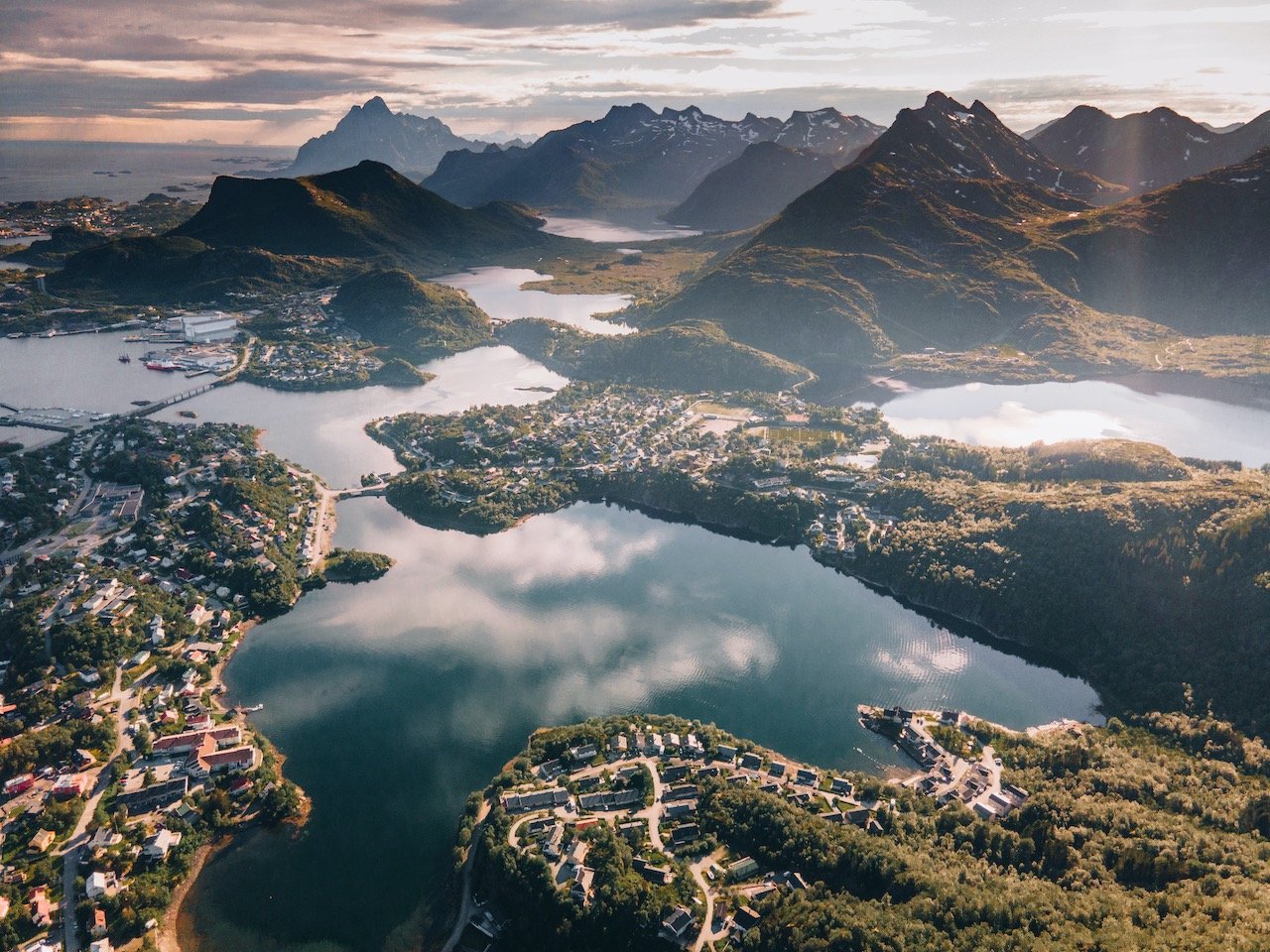
Svolvaer, Lofoten, Norway (ISO 200, 4.5 mm, f /2.8, 1/50 s)
The Epic Lofoten Islands Road Trip
(some links in this post are affiliate links. if you click through and take action, i'll be compensated.) if you are also interested in any prints from any of my posts, be sure to check out my store where you can buy prints as posters, in metal frames or on canvas., **this is a summary post of a 5-post series discussing what to see in the lofoten islands (you can check out the other parts below, separated by each specific island: part 1 , part 2 , part 3 , part 4 , part 5 .**, the lofoten islands are arguably one of the most beautiful archipelagos in the world. it is located in northern norway (nordland county), within the arctic circle tucked between the 68th and 69th northern parallels. i picked up a camper van with arctic campers in tromsø, norway ( blog post: a guide to exploring tromsø, norway’s northernmost city in the arctic circle ) and had started the road trip towards lofoten (about 4-5 hour drive)..

The definition of which islands constitute Lofoten are always up for debate but for the purposes of this blog post series, I will cover 5 of the islands and reference some others. From North to South, they are composed of:
Austvågøya ( blog post: a journey to the lofoten islands: the island of austvågøya ), vestvågøya ( blog post: a journey to the lofoten islands: the island of vestvågøya ), flakstadøya ( blog post: a journey to the lofoten islands: the island of flakstadøya ), moskenesøya ( blog post: a journey to the lofoten islands: the island of moskenesøya ), værøy ( blog post: a journey to the lofoten islands: the island of værøy ), in this blog post, i will break down some of the best places to see in each island of lofoten . a google map of these places i will talk about can be seen at the end of this article..
Ever since I explored Iceland for the first time in a camper van ( Check out my Iceland trips here ), I was hooked. This to me is the best way of exploring a new place with such natural beauty. So when I planned a trip to Lofoten, I knew I wanted to start my trip research by finding a good camper van provider.
I decided to go with arctic campers. they had decent rates and a great fleet of vehicles, which were modern, most with a proper refrigerator, and very easy to drive. unfortunately, they are based in oslo and tromsø, each several hours away from lofoten. therefore, i booked a flight to tromsø, explored the city a bit, then picked up the van and drove the 4 hours down to the top of lofoten..
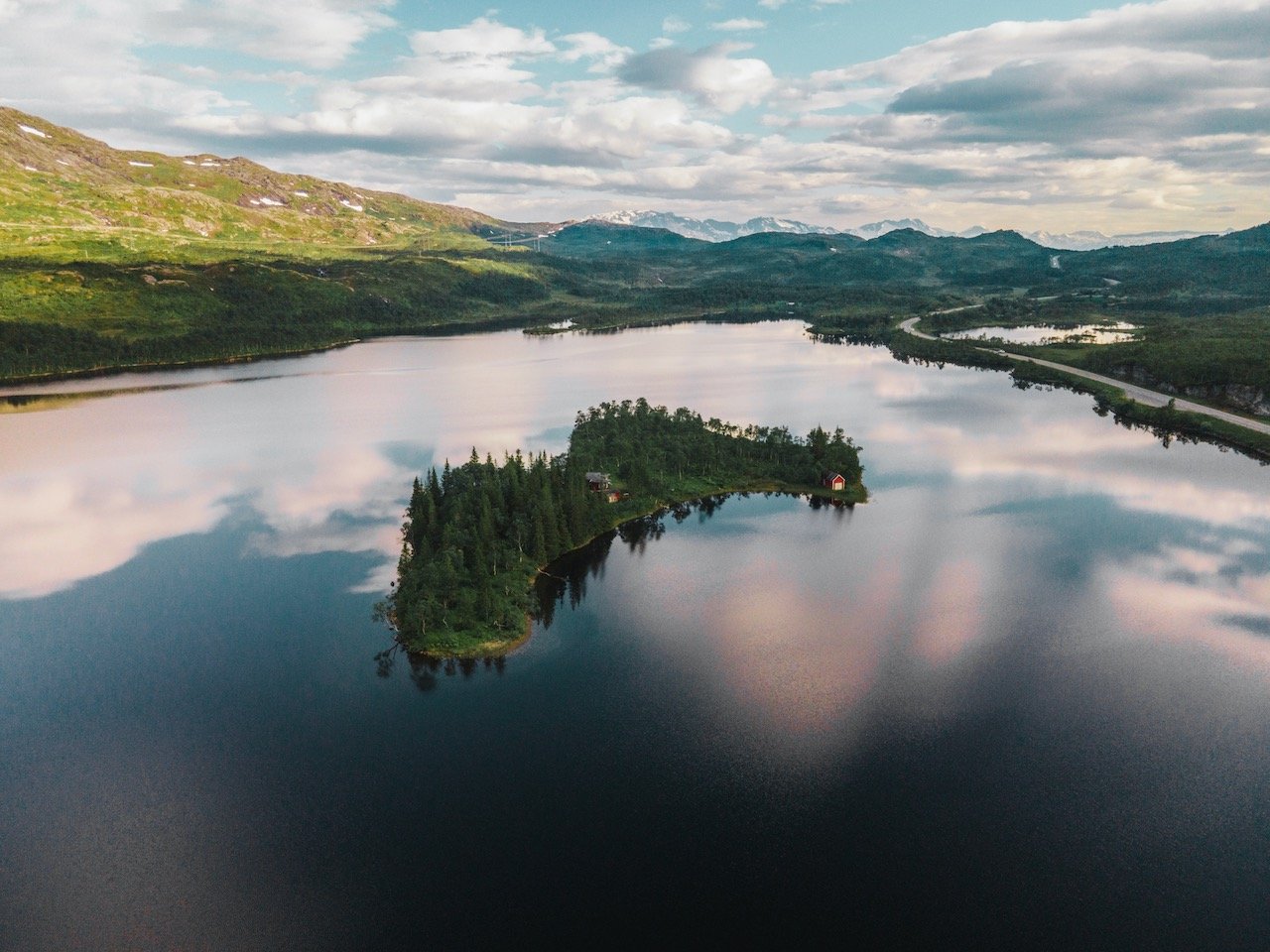
When you come from the US like myself, a 4 hour drive actually isn’t that bad. It’s amazing how far you can get in Europe driving four hours in one direction. In the US, you can still be in the same STATE .
If you like some of my photos that you have come across, just know that i have many prints showcasing a variety of landscapes, including norway, available for purchase below (sold as posters , canvas , or in metal-frames )..
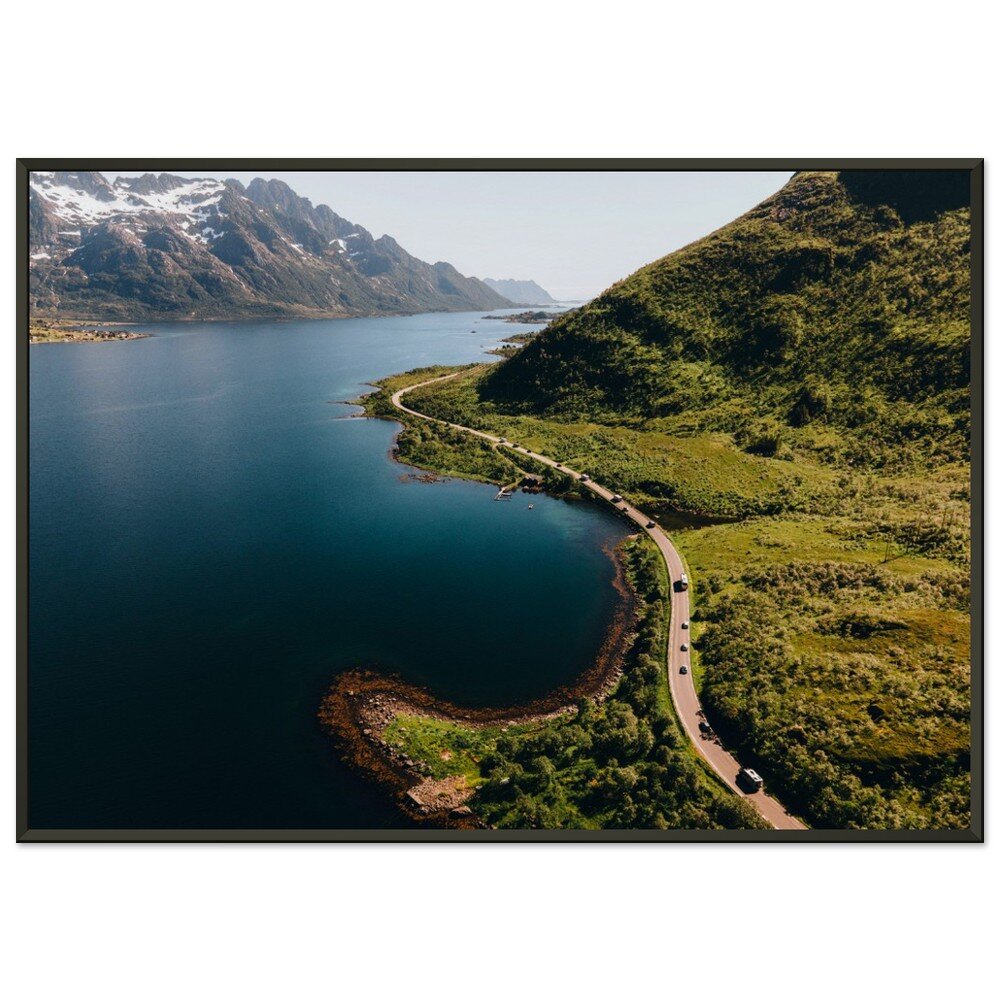
Before you reach Lofoten, you have to drive through the Norwegian countryside a bit, and those views are spectacular. If you managed to stop anytime you wanted to take a photo, you would never reach Lofoten (a GOOD problem to have). Nonetheless, in Nordland County, we took some breaks here and there to stretch and recharge before pressing on to the first Lofoten island of Austvågøya.
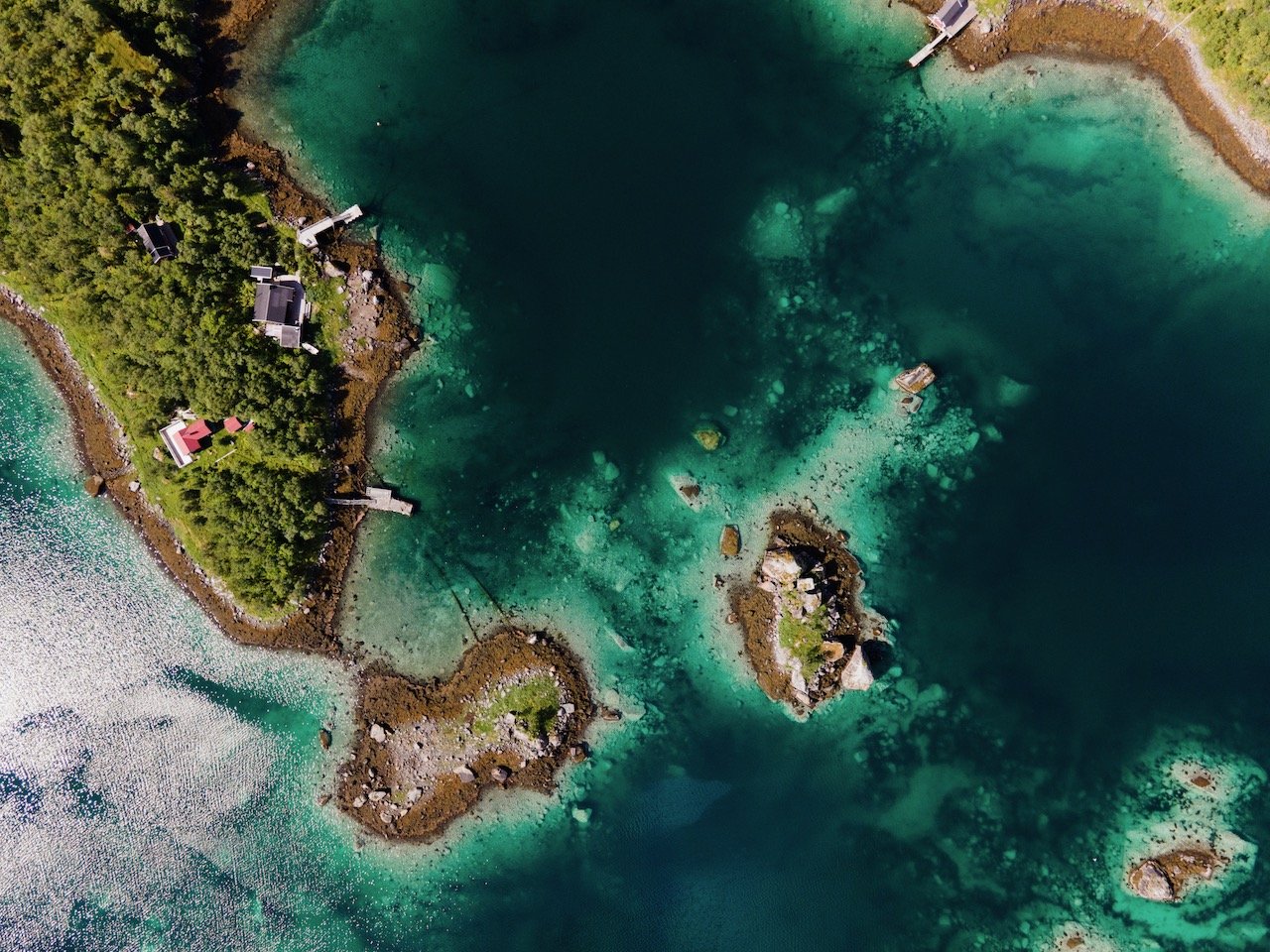
Austvågøya is the largest island in Lofoten, located between the West fjord (Vestfjorden) and the Norwegian Sea. This island has a population of 9,000, with most in the town of Svolvær. This will be the first island you reach if you are coming from Northern Norway via the E10 road. Next to this island in the Lofoten archipelago is Gimsøya (which I have not written about since I didn’t visit it). Here are some of my favorite places from Austvågøya:
Henningsvær - this fishing village was one of my favorites. we parked in the town center and walked around a bit but here you can find a big harbor, cafes, an art gallery, and even a football stadium. make you way to the furthest point in the water to catch a glimpse of the football pitch, which is flanked by dozens of fish drying racks., rørvikstranda - is a beach we saw on the way towards henningsvær. the tide was low and the water was such an intense turquoise color and with the blooming flowers, it made for such an enchanting spot., svolvær - this is the largest city on the island and a perfect spot for a break in your road trip. take a walk around and stop up on food and gas supplies here., fløya, djevelporten - these mountain peaks give you the best views over svolvær. they are of varying difficulty but take at least 2 hours each., vågan church - i thought this church was stunning and it can be found in the small town of kabelvåg., djupfjorden - this area is also on the way towards henningsvær. there is a rocky outcrop here just on the side of the road, perfect for catching the sun and having a picnic. the water color is such a deep emerald/teal here., matmora - this is a mountain hike we did in about 2 hours total. the view over the entire area as well as the beach below easily made it one of our favorites hikes in the whole trip..
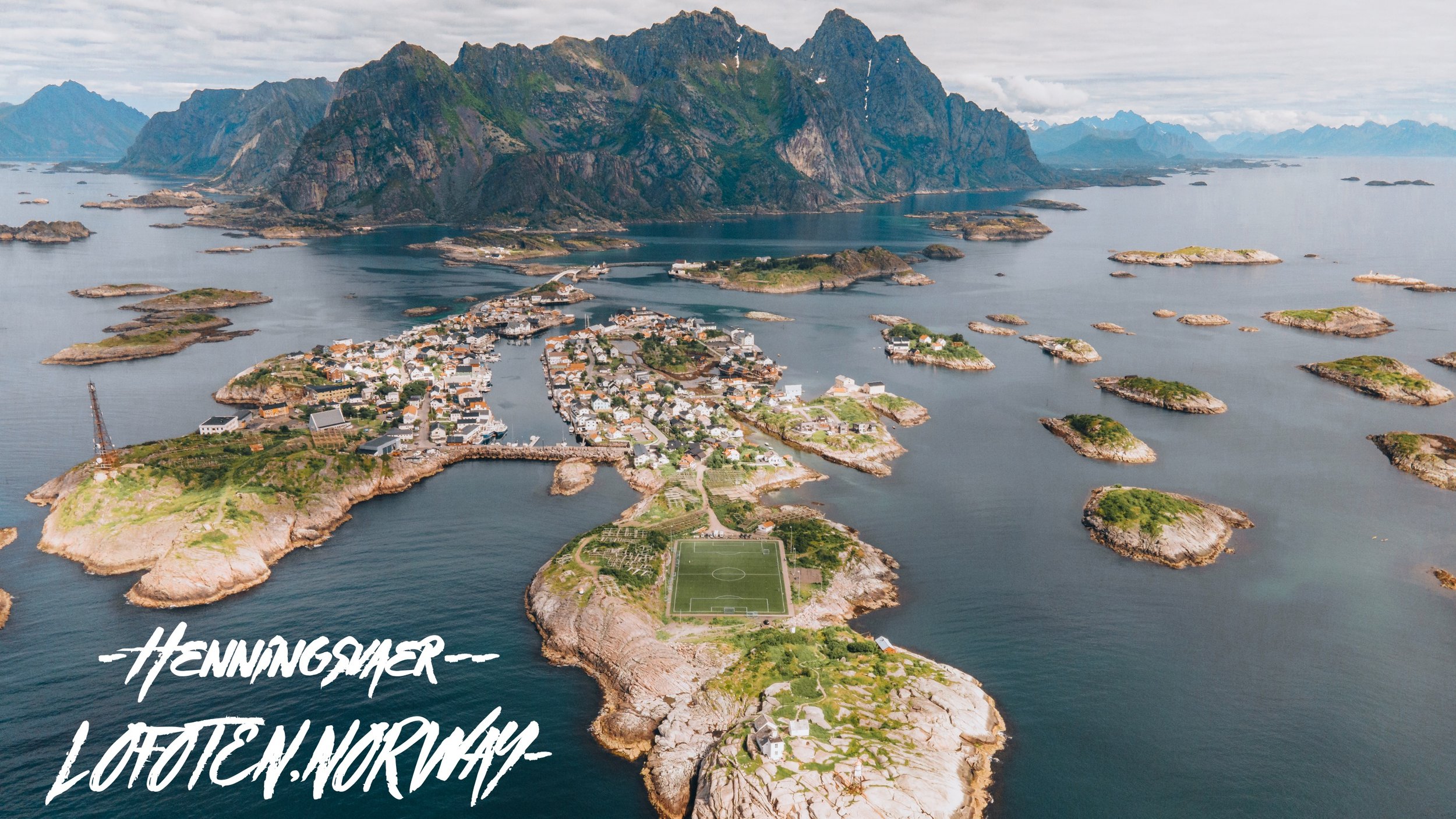
Vestvågøya is the next island in the Lofoten archipelago, accessible via the E10 road and south of Gimsøya. The island is known for having an array of different topographies and geologies. The interior of the island is composed of mostly marsh, while the north and south portions of the islands are very mountainous (the highest point being Himmeltindan at 964 meters high). The town of Leknes is the largest on the island. Here were some of my favorite parts of the island:
Mærvoll - we spent a few hours here after our long hiking days to just relax and do nothing. this can be described as a coastline area with towering mountains in the distance and a rocky beach just in front of you. best of all, we had it all to ourselves., eggum - is also located along the coastline. we set up a midnight kayaking tour here with northern explorer . after some adjustments with our initial reservation to a day with better weather. we went on the coolest kayaking trip you can imagine. we kayaked among a small archipelago, welcomed by eagles, jellyfish, and other animals, while having the intense orange/red rays of the midnight sun in the background. incredible., borge church - a pretty unusual looking church, painted red and white, sitting in the middle of a vast plateau in borg., unstad - this town also has its own beach. surfing is the thing to do here. you can book surfing lessons in a proper surf camp but you can also enjoy the surroundings staying out of the water too. a very serene place., uttakleiv beach - a nice beach adorned with many large boulders that go all the way out into the sea. a great alternative to unstad beach if you had to pick just one., offersøykammen - a hike that took about 2 hours. not much to see on the way up but amazing once you get to the top. you can get a great 360 degree view of the entire island..
Flakstadøya
Flakstadøya is located southwest of vestvågøya and connected to the rest of lofoten via the e10 highway. the island boasts quite a few villages such as fredvang, nusfjord, and vikten. speaking of which, these are some of the places i highly recommend seeing:, nusfjord - this village was totally off my radar. my girlfriend found it and so we went to check it out. after parking in the center of town, we quickly realized we were in someplace special. this village is adorned with red and yellow fisherman cabins, standing over turquoise blue water, with large mountains in the background. we walked around here taking in the sights. it seemed like a great place to spend the night as well (if we didn’t have our camper van)., vikten - is another small village on the northwestern coast of the island. it has a beach but is mostly known for its glass blowing cafe. this cozy spot gives you a glimpse of the glass blowing process as there is always someone making a design to be sold. you can get a beverage at the cafe and chill in one of the many comfortable spaces in the building., flakstad church - i really liked the overall design of this church and its color. it was on the main road so easy to stop by at..
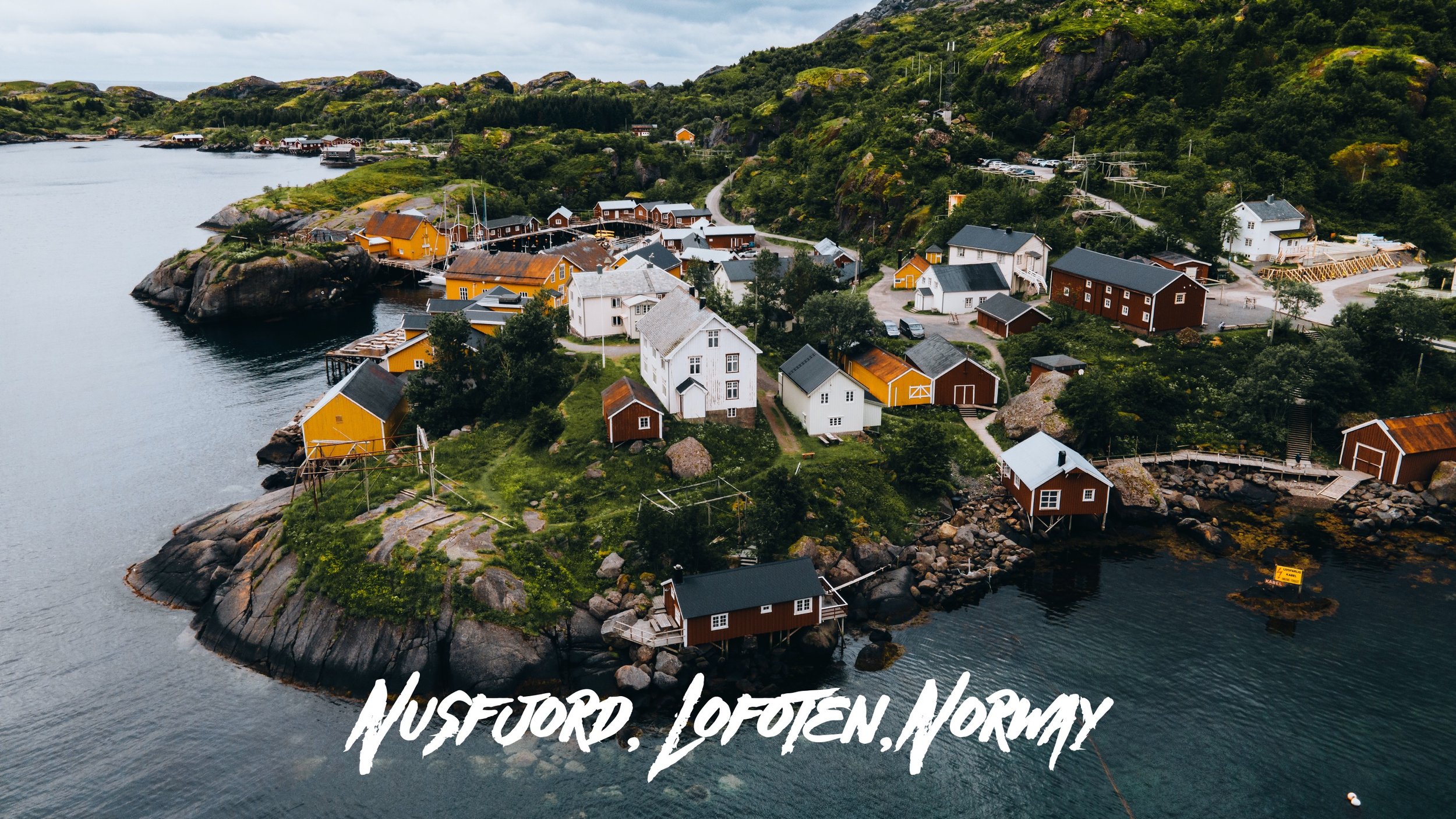
Moskenesøya
Moskenesøya makes up the southern portion of the lofoten archipelago (that is connected to the mainland). the e10 highway takes you here from neighboring flakstadøya. the islands boasts many villages and settlements though mostly inland and on the east side as those that were established along the west coast were abandoned due to severe weather. some great places to see on this island are:, reine - this is a large town on the island that is impossible to miss. here you can also recharge (gas, food, coffee) while also checking out the reine viewpoint as well as hiking reinebringen . the hike requires some decent fitness as the ascent is completely done via a stone stairway. further in this town is a large collection of fish drying racks, in keeping with the norwegian cultural practice., ryten - this is perhaps the most popular hike in all of lofoten, but it is worth it. it took several hours (around 4) and the weather was pretty bad but once we got to the top, the view was gorgeous. the mountain is 543 meters high and gives the best view of kvalvika beach below., kvalvika beach - this is also only reachable by food. you start the ryten hike and veer off to the left of the path on a plateau and then descend again to the beach. when the sun is shining, the water produces a deep emerald color which is just amazing to see with the mountain backdrop. i recommend doing the ryten hike first, followed by this beach hike., hamnøy and sakrisøy - these are classy fishing villages with rorbu or rorbuer (plural), which translate roughly to ‘fisherman’s cabin’. you can rent these cabins and they have various amenities in them, the most common one being a sauna. they are so picturesque as well and as such, are the most common photos seem from lofoten..
Værøy is reachable by ferry from Moskenesøya. It is loosely considered to be a part of Lofoten. The island itself has a rather small population of 728 which had dwindled over the years.
In an effort to boost tourism to the island, the ferry service going to and from the island is free. you can even go from bødo to værøy, then to moskenes by the ferry for free. however, if you go with this route, you must stay in værøy for at least one night., the villages are sørland and nordland. some other spots to check out on the island are:, håen - this hike is gorgeous. after reaching the trailhead, you hike up a valley which then meets a roadway, so you can hike on the road (which is closed to cars) or go via the rougher paths. you will reach a nato radar station here and find sweeping views of the rest of the island. our time here unfortunately was mired with fog, so we can only imagine what the view was like., væroyhornet - this is also another area that you can hike in on the backside of the island. it gives you a different vantage point than håen., there you have it, a general guide on what to do and see in the lofoten islands. for even more specific information on each island, be sure to check out my blog posts outlining each one that i have presented at the top of this post., furthermore, as someone who swears by camper van road trips now, it’s my favorite way to travel. i have been lucky enough to see other destinations by way of camper van as well (with many more to come i’m sure). feel free to check out my posts on iceland and new zealand , both done via camper van..
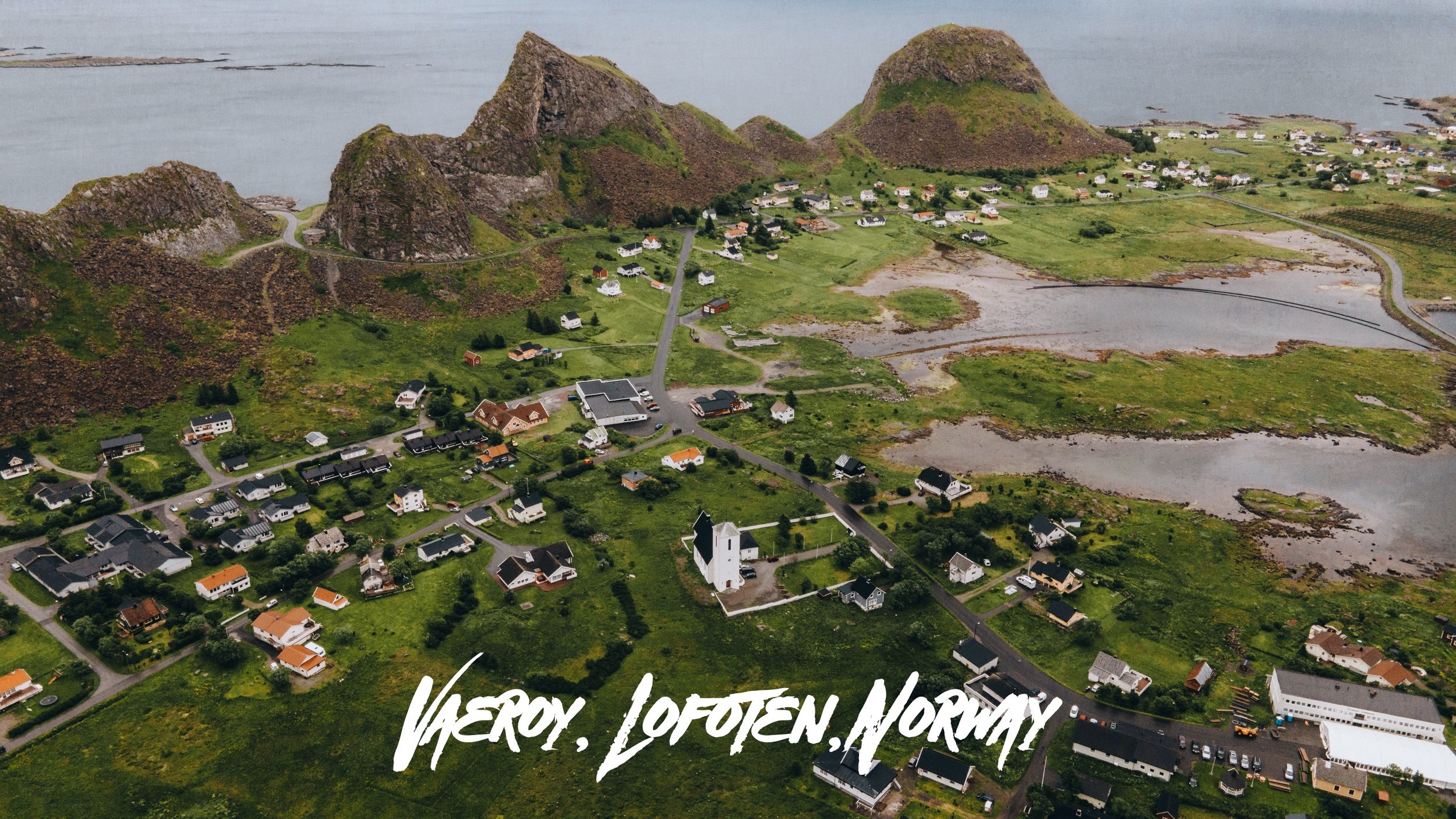
Related Posts


- Norway Road Trip Itineraries Lofoten Islands
Lofoten Islands Road Trip Itinerary: 5 Days Hiking On Norway’s Stunning Archipelago
- February 29, 2024

I have always been fascinated by the Nordic countries and after seeing countless photos of the Lofoten Islands I knew this was the next destination I want to write about.
When the borders finally re-opened I made the 3000 km drive from Austria to Lofoten in my campervan and with Jasper with the intention that I would spend the next two months there. Long story short I quit after 6 weeks. Lofoten tested my love for traveling from day 1.
Luckily I still managed to tick off some hikes and today I can share with you my suggestion for 5 day road trip itinerary around the Lofoten Islands.
Lofoten Islands road trip itinerary: the logistics
Best time to road trip around lofoten islands.
The official hiking season lasts from June until September, but there is no perfect time to travel to the Lofoten. If you have the possibility of planning a spontaneous trip when the weather forecast is good then that’s what you should do. When I visit again one day I will try to do the same.
However, if the forecast is bad think twice about going. Lofoten Islands are very expensive and the last thing you want is to put your money down the drain and for your holidays to be ruined by bad weather. Unfortunately, nice weather is an exception rather than reality here.
Weather warning for the Lofoten Islands

During my 6 weeks spent on the Lofoten Islands, I had good weather for around 7 days. The rest was a combination of cold, rain, and wind. I hated the weather up there so much that my frustration levels reached a zenith and I left from one day to the next, cutting my trip short by a month.
I don’t want to be a negative Nancy here. I do think the Lofoten Islands are magical and I don’t regret my time spent up there one bit, but I also want to be transparent.
TIP: The picture-perfect Lofoten Islands that you see on Instagram with sunny days and turquoise waters are highly curated. Days like these are the exception from a very harsh reality of grey skies and lots of rain.
Getting to the Lofoten Islands

Option 1: Flight to Bodø and ferry to Moskenes
If you want to follow this Lofoten Islands road trip itinerary you have a couple of options to get here. First is to catch an internal flight from Oslo, Bergen, Ålesund, or Trondheim up to Bodø, then from here catch a ferry to Moskenes.
This is perfect if you want to follow one of my itineraries for southern Norway first, then spend a few days in the Lofoten.
Option 2: Fly directly to Leknes
Leknes is the biggest town on Vestvågøy Island and has its own little airport. Flights are limited but if you start your planning early enough you can catch an internal flight within Norway and rent a car directly on the Lofoten Islands.
Lofoten Islands road trip itinerary outline and map
Following my Lofoten road trip plan you will visit three Islands: Moskenesøya, Flakstadøya, and Vestvågøy . That’s where most of the tourist highlights are, including the village of Reine the hike to Ryten, or Unstad Beach.
TIP: If you only have 5 days don’t try to see all of the Lofoten Islands, because you will end up spending most of your time driving instead of enjoying nature and landscapes. Instead, focus on one area by following my itinerary.
The best way to road trip around the Lofoten Islands
I travelled the Lofoten in my campervan which turned out to be a lifesaver. After experiencing the weather up there I would never bet on bringing a tent and camping here.
Rent a campervan with Motorhome Republic

If you want to experience vanlife, Norway is the perfect country for it. If you want to know more about campervan travel in Norway visit my other article.
Campsites in the Lofoten cost ca. 400 NOK ($40) per night. You can rent a campervan in Bodø.
and bring it on a ferry with you. The downside is that campervan rental in northern Norway is ridiculously expensive and in the high season can cost even 1000 bucks per night.
TIP: If you want to check and compare campervan rentals in Norway use Motorhome Republic , where you can find the best deals and request a booking.
Rent a compact car with Discover Cars

This is a more economical option, not only due to lower fuel consumption (gas isn’t cheap in Norway) but mainly due to the rental price. The roads in the Lofoten Islands can be very narrow too, so a smaller car makes navigating much easier.
TIP: For comparing compact car rentals I highly recommend Discover Cars . It’s an award-winning site where you can reserve your car and insurance.
Where to stay on the Lofoten Islands during this road trip?
Thanks to the proximity of all the hikes and photography locations I included in this itinerary you can stay in one hotel for all 5 days and do your exploring from there.
If you want to be right in the middle of it all I recommend that you stay on Flakstadøya (the middle of the 3 islands you will be exploring) or the western side of Vestvågøy.
Below are a few hotel accommodation options that fit the bill and won’t break your wallet. If you are traveling in a campervan, I also marked some campsites on the map.
Ramberg Gjestegård
A 35-minute drive from Moskenes Ferryport
Lofoten Cabins – Kåkern
A 25-minute drive from Moskenes Ferryport
Lofoten Basecamp
A 1-hour drive from Moskenes Ferryport
Suggested 5-day Lofoten Islands hiking itinerary: day-by-day breakdown
Day 1: fly to bodø, take the ferry to moskenes, and hike on the moskenosøya island.
Bodø Airport and the ferry terminal are only 3.7 km ( 2.3 mi) from one another. If you plan your flight for early morning you can still get a lot of your first day once you cross to the Lofoten Islands. The journey from Bodø to Moskenes takes approximately 2.5 hours.
TIP: Look for your ferry connection on Direct Ferries . Prebooking your ferry trip a few days before is a good idea to ensure you get a spot.
Hike to Reinebringen
- Distance: 2.8 km / 1.7 mi
- Elevation gain: 410 m / 1350 ft
- Hiking time roundtrip: 1.5 – 2 hours

Take advantage of those long daylight hours and tackle your first hike – the classic Reinebringen, right on your first day. I did it in the late afternoon and stayed until the golden hour before the storm rolled in.
The trailhead is located on the western side of the Ramsvik tunnel, only a 5-minute drive from the ferry terminal. However, you will need to park your vehicle in Reine Village first and then walk to the trailhead.
Reinbringen hike is known for two things:
- The jaw-dropping views of the Fjords. I won’t exaggerate when I say this was by far the most beautiful view I have seen in my life.
- The million steps that you need to tackle to get to the top. Just kidding, there is only 1800 of them.
Explore the Reine village

Thanks to its epic location Reine has risen to a special high status amongst the visitors to the Lofoten Islands. What’s risen with it, unfortunately, are the accommodation prices. If you want to stay in Reine you will need a big budget for it. It’s not unusual to spend 800-900 Euros a night here.
After the hike to Reinebringen, spend a couple of hours in Reine taking photos at the classic location, such as Hamnøy bridge (more marked on the mao) before moving on to your next destination.
Day 2: Hike on the Flakstadøya Island
Option 1: ryten from innersand.
- Distance: 6.8 km / 4.2 mi
- Elevation gain: 510 m / 1670 ft
- Hiking time: 2-3 hours

Ryten is another classic hike on the Lofoten Islands. The peak is located on Flakstadøya Island and stands high above the famous Kvalvika Beach and Vestervika Beach.
On a rare sunny day, there is usually a pilgrimage of people going to the top. I was there for sunset together with dozens of other hikers. There are several ways to get to the summit. I chose to hike to Ryten from the little village of Innersand.
Option 2: Kitind
- Distance: 6 km / 3.7 mi
- Elevation gain: 750 m / 2460 ft
- Hiking time: 4-5 hours

If you are more the adventuress type who loves to explore off-the-beaten-path trails and stay away from people then opt for hiking to the top of Kitind instead.
Kitind is another summit on Flakstadøya Island with beautiful views over Vestervika Beach. Compared to Ryten this is a much harder trail that requires some navigation skills.
For the best description of the hike, I highly recommend that you purchase the West Lofoten Hikes e-book by fellow photographer Cody Duncan. His book was one of my best resources for planning a trip to the Lofoten Islands.
Day 3: Continue exploring Flakstadøya Island
Option 1: hike to volandstind.
- Distance: 5.4 km / 3.4 mi
- Elevation gain: 440 m / 1440 ft
- Hiking time: 2.5-3 hours

Volandstind is one of those peaks that looks unscalable when you look at its pyramid-shaped western face, but it is one of the easiest trails on this Lofoten Islands road trip itinerary.
From the summit, you get great views of Ramberg Beach and Fredvang Bridge which you crossed before to get to Innersand.
Option 2: Hike to Flakstadtind
- Distance: 3 km / 1.7 mi
- Elevation gain: 460 m / 1510 ft

photo credit: Kate from Bags Always Packed
This would have been my favorite hike in the Lofoten Islands if it wasn’t for the mishap I had at the top. I accidentally dropped my camera which then rolled down the mountain and off the cliffside. All my photos from the previous days were lost in seconds.
Bad memories aside, the hike to Flakstadtind Summit is pretty awesome and with far fewer crowds compared to Ryten or Reinebringen. I only met a few other hikes on the way to and from the summit. At the top, you get great views of the Skagsanden beach down below.
Option 3: Hike to Hestræva
- Distance: 4.8 km / 3 mi
- Elevation gain: 450 m / 1480 ft
- Hiking time: 3-3.5 hours

The trails in the Lofoten Islands tend to be very short but intense. You gain elevation quickly and the paths are steep. The hike to Hestræva is the opposite. It is quite gentle which is a welcomed change.
If you happen to hike to Hestræva on a sunny day you will be graced with fantastic views towards the Flakkstadpollen bay. Its turquoise colors might let you forget for a second that you are above the Arctic Circle and instead think you are on holiday on some tropical islands.
TIP : There are plenty of daylight hours during the Arctic summer so If you are a strong hiker and the weather permits it then you can easily fit two hikes per day.
Day 4: Explore the Vestvågøy Island
Option 1: hike to offersøykamen.
- Elevation gain: 430 m / 1410 ft

Offersøykamen has two trailheads but I recommend that you start the hike from the one which is located near the east entry to the Nappstraum Tunnel. This will make the trail slightly longer, but less steep and with great views right from the start.
I have very fond memories from this trail as I did it with Jasper and 3 of my friends. The sun finally came out after a straight week of storms, heavy rain, and cold temperatures. We certainly made the most of this rare day.
Option 2: Hike to Hornet
- Distance: 3.9 km / 2.4 mi
- Elevation gain: 290 m / 950 ft
- Hiking time: 2-2.5 hours

Hornet is a very short trail with a great views-to-effort ratio. You only gain ca. 300 meters of elevation on this hike, yet you still get to stand on a little summit with a 360-degree view around you.
Hornet is actually on Flakstadøya Island, but its trailhead is only a 20-minute drive from the previously-mentioned Offersøykamen. This hike will be the perfect addition to your 4th day of your Lofoten Island road trip.
Afternoon: Visit Unstad Beach

Unstad Beach is mostly famous for surfing, but you don’t need to be a surfer to enjoy the beach and its surroundings.
There is a lovely coastal walk from Unstad Beach to Eggum or you can just watch the sunset and photograph the surfers brazing the cold arctic waters for a chance to surf that perfect wave.
TIP: Make sure to visit the Unstad Arctic Surf Pub & Café and try their cinnamon buns. They claim that they are the best in the World and I must admit I am yet to have another one that’s better than theirs.
Day 5: Vestvågøy Island + ferry back to Bodø
Morning: hike to mannen.
- Distance: 4.5 km / 2.8 mi
- Elevation gain: 420 m / 1380 ft
- Hiking time: 2.5 -3 hours

The hike to Mannen is the last hike that I recommend on my Lofoten Island road trip itinerary. It leads to a small summit with panoramic views over two beautiful beaches: Haukland and Vik.
It only takes around 3 hours to get to the top and back down, so unless you have an early flight or ferry, you can easily plan this hike for your day of departure.
Afternoon: return to Reine and ferry back to Bodø

If you need to head back to Moskenes to catch a ferry then the drive from Haukland beach will take approximately 1 hour and 10 minutes.
If you fly out of Leknes Airport then it will take you only 15 minutes to get back.
That’s a wrap. I hope you follow my Lofoten Islands road trip itinerary and have lots of fun doing so. If you have any questions post them in the comments below.
Other road trip itineraries around Norway
Support my website.
Hi Reader! If you found any of my articles about Norway useful please consider using the affiliate links in the article or below (at no extra cost to you) when booking your holiday. Thank you.
- Reserve your hotel with Booking.com
- Book your rental car with Discover Cars
- Find your perfect campervan with Motorhome Republic
- Book your tours with Get Your Guide
- Buy your outdoor gear with Backcountry.com (US readers)
Hi! I am the photographer and creator of www.inafarawayland.com. I come from Poland, but I've been living, travelling and working around the globe since I turned 18. A few years ago, during one of my trips to Scotland, I bought my first DSLR and my adventure with photography began. When I am not stuck to my computer editing photos, you can find me hiking somewhere in the mountains.
Related Posts

Stavanger to Bergen in 5-7 days: A Fantastic Road Trip Through Norway’s Iconic Tourist Spots
- May 26, 2023

15 Things To Know About Campervan Travel In Norway In 2024
- May 12, 2023

10-day Norway Road Trip Itinerary For Adventure Seekers (Starting And Ending in Ålesund)
- May 9, 2023
Hi Marta! I’m sorry to hear about the unfortunate weather you had, and hope it is much better whenever you return. I read that you stayed for 6 weeks and saw that a photo caption said mid-July. Would you mind describing the time period that you were there? Was it June to end of July?
Thank you, and beautiful photos as always. The lighting and clouds in the 3rd Offersøykamen photo are my favorite. Cheers!
Hi Megan. I hope the same. Lofoten Islands weather is very capricious. Worse than in Scotland! haha I stayed from mid-July until the last week of August. I hope that helps!
Leave a Reply Cancel Reply
Your email address will not be published. Required fields are marked *
Name *
Email *
Add Comment *
Save my name, email, and website in this browser for the next time I comment.
Post Comment

A Lofoten Road Trip Itinerary — Exploring Norway's Scenic North
Lofoten has always been a dream destination of mine. This archipelago on the northern end of Norway has everything I love: dramatic mountain ridges with unlimited hiking opportunities, scenic coastal views, and small towns that still feel undiscovered, which all make for the perfect road trip opportunity! We spent five days driving back and forth across the islands, and we could have spent so much longer soaking in the beauty of Norway’s north.
Headed to Bergen? Click here for our itinerary exploring Norway’s fjords on the Western Coast!
I’ve broken down some of our favorite points of interest by general region and city. However you really can’t go wrong taking a random road or side path, and I actually encourage that over following a strict itinerary, as I can guarantee you’ll find gems of your own not covered in this post. Isn’t that the beauty of traveling… exploration and adventure?
Affiliate disclaimer: please note that this article includes some affiliate links, which means I may earn a small commission on any purchase made - at no additional cost to you. As always, all opinions are my own. Thank you for supporting the work I do to keep creating meaningful content like this for you!
Table of contents
How to get there, where to stay, useful tips, what to do in lofoten.
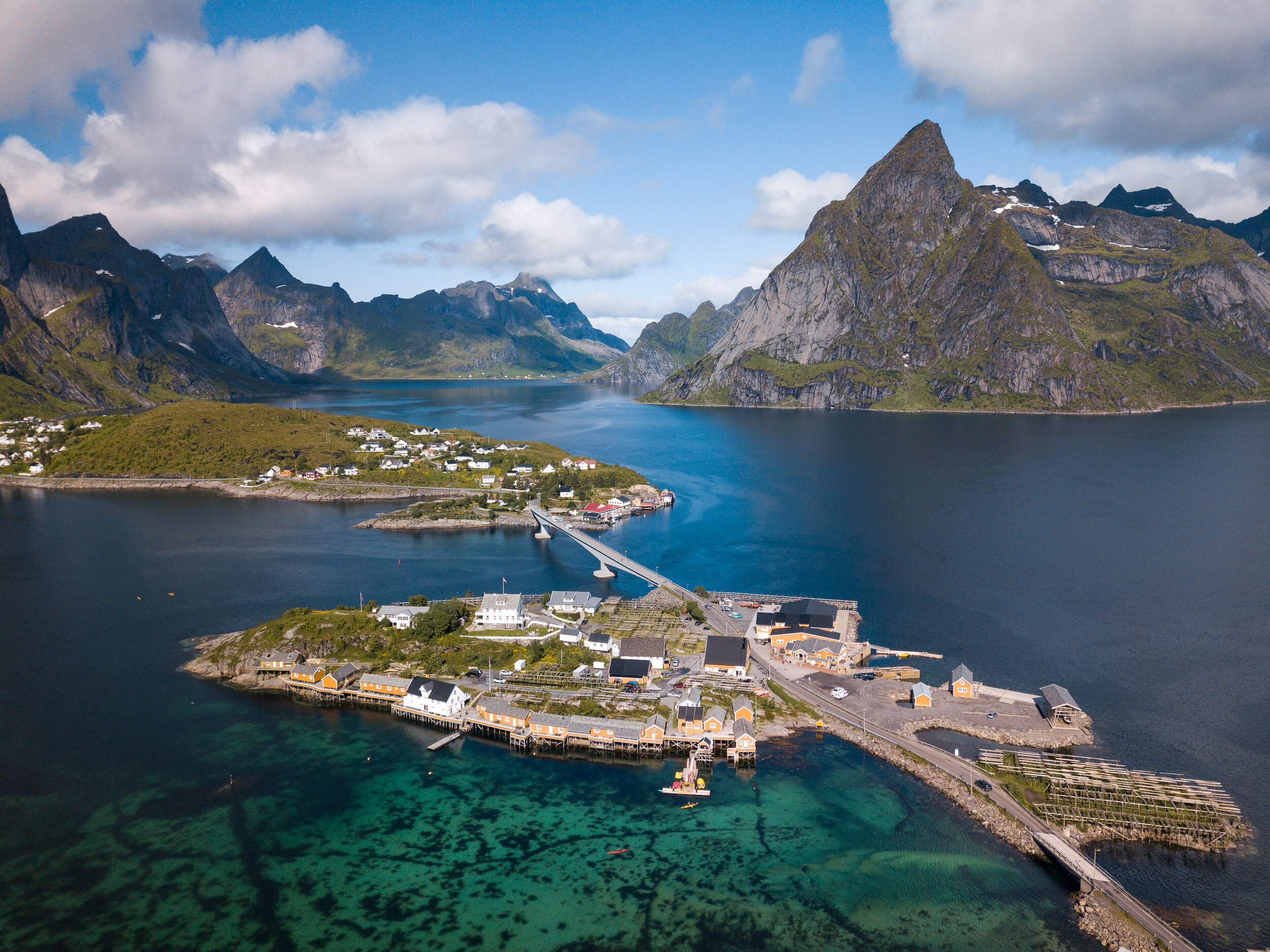
You can get to Lofoten by car, plane, or ferry. After researching and comparing prices of all of the options, we opted to fly into Evenes, Norway and rent a car at that airport.
We knew we wanted the convenience of having a car to explore the islands at our own pace. We toyed around with the idea of taking the ferry from Bodø, where you can pay little extra to take your car on the ferry to the islands, but we were arriving from the U.S. in Oslo and wanted to get to Lofoten as quickly as possible to maximize our time there.
The Evenes airport had the best options and prices for car rentals in all of Lofoten (versus renting in Svolvær or at any of the other ferry ports), so we opted to take a $115 direct flight via Norwegian Airlines and return the car back in Evenes (the one way drop off fees can get pretty steep, so double check!).
Evenes worked for us since we love road trips and do not mind driving back and forth through Lofoten, especially when the roads are so scenic the entire way. On the map Lofoten looks like it would take a while to drive across, but driving from Evenes airport all the way to the town of Å, the western tip of Lofoten, takes only four and a half hours (if you don’t stop, which I can guarantee you will want to!).
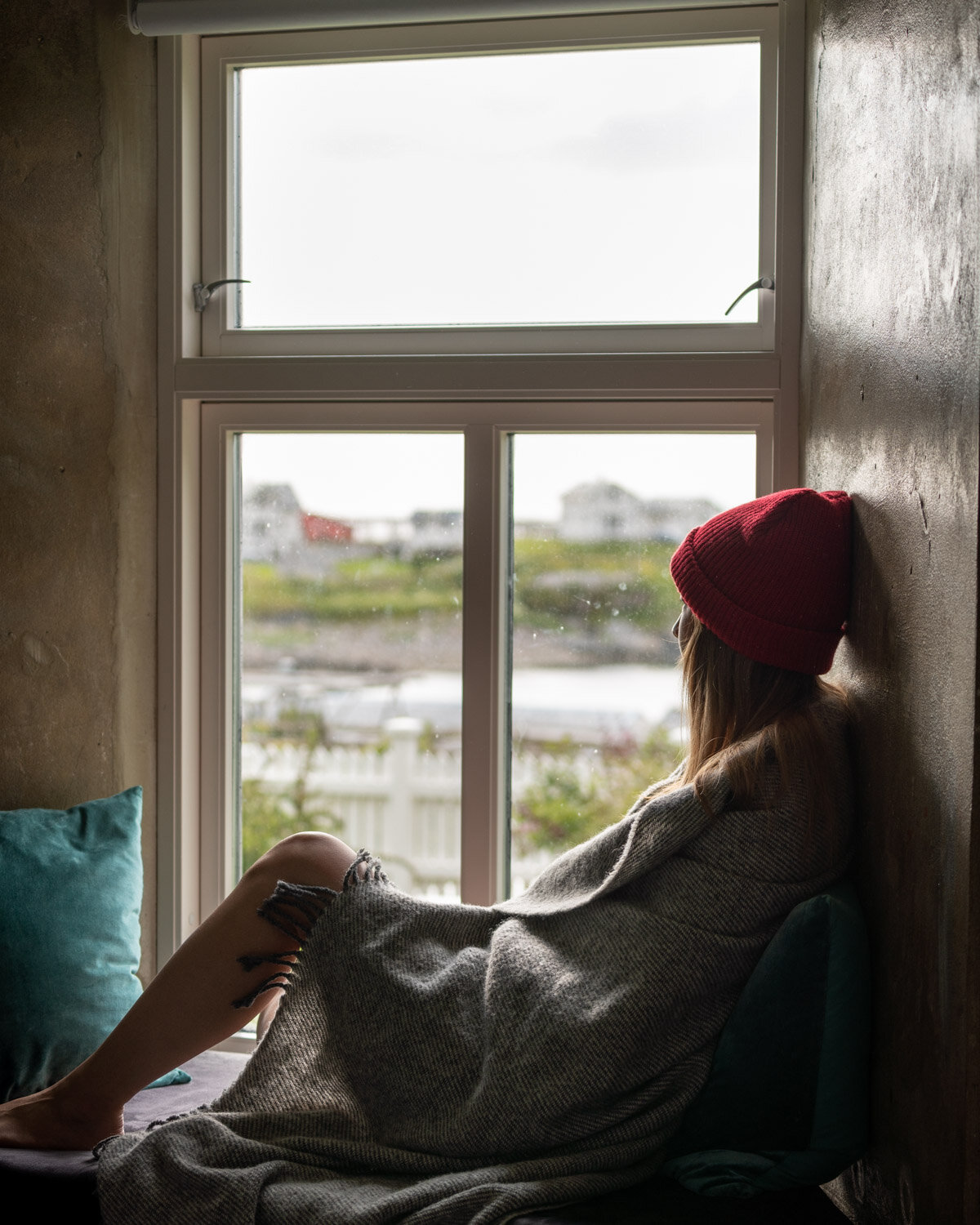
Enjoying the view from our Booking.com manor hotel in Sakirsoy
Picking where to stay was one of the harder parts about planning our Lofoten trip. There are lots of small towns all over the islands to pick from, but we wanted something that was close to our main points of interest, but also something somewhat economical (traveling in Norway can get expensive!).
Be sure to check several hotel booking sites. We used Booking.com , a site that we liked because of its great prices, free rewards program and great cancellation policies.
We also liked using Airbnb to find more unique and boutique stays ( use this referral link for $65 off your first booking ).
If booking online like Booking.com, I highly recommend Rakuten for cash back on your bookings.
Click here for my blog post on saving money and how to I use Rakuten to save on my online purchases!
Since we were flying in and out of Harstad/Narvik Evenes airport, which is on the eastern side of the Lofoten archipelago, we decided to spend three nights in the main Reine area and then spend our final night in Sennesvik to make our final drive back to Evenes just a little bit shorter.

On top of Festvågtind in Henningsvær
As always, don’t forget to download offline Google Maps on your phone for anywhere you think you might be traveling to.
If you are driving, be aware the highways and roads may be narrower and have slower speed limits than you’re used to. Be sure not to speed, as there are speed cameras, and speeding tickets are not cheap.
If traveling during high season, try to book accommodations as early as possible. We booked 5-6 months in advance and noticed prices for hotels and airbnbs increase as each month passed.
If going in the summer, be sure to bring an eye mask to help you sleep! Being so far north, it never gets full dark out since the sun might not ever set. Such a cool experience witnessing midnight sun, but also my sleep would have suffered without an eye mask.
Stop by a local grocery store for snacks and food to cook. Norwegians seem to cook at home a lot, and any eating out we did was quite pricey. Many of our Airbnbs came with kitchens to cook, and we ended up eating a lot of tubed fish, sandwiches, and pasta.
In my opinion, the best way to explore the islands is to get in a car and just start driving! Every inch of the islands is incredibly scenic, and a lot of it still feels unexplored and untouched. I’ll go ahead and list a some of our favorite spots from our time on the road, starting in the east and working west, but feel free to click into the map to see even more potential stops that we would have done if we had more time.
Henningsvær area
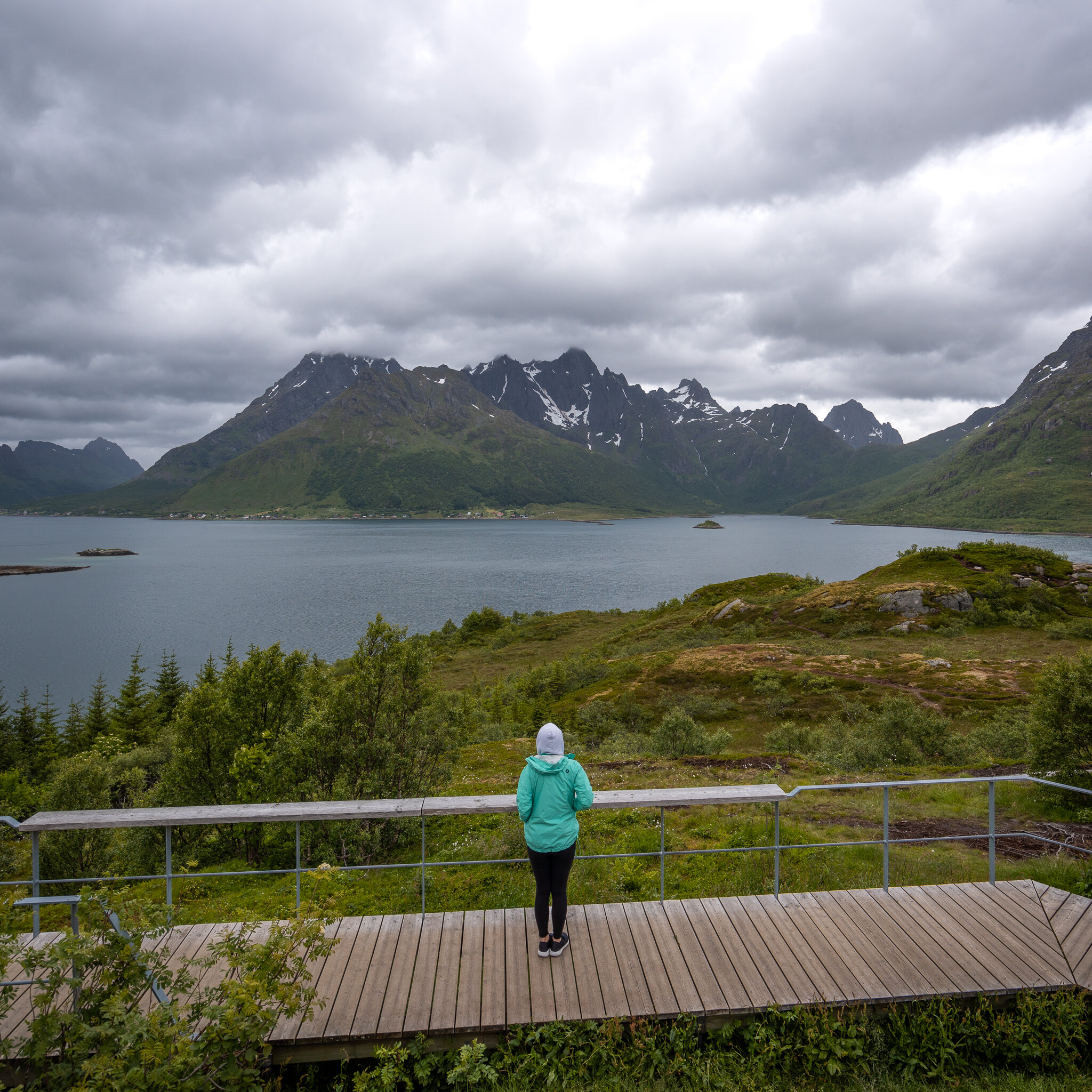
Top left to right: Austnesfjorden picnic area and viewpoint, Rørvikstranda beach, view rom the top of Festvågtind. Bottom left to right: on the hike up Festvågtind with Henningsvær in the background, looking down at the road that leads to Henningsvær, view from the top of Festvågtind.
Austnesfjorden picnic area - the perfect spot for a snack or to get out of the car and stretch your legs while making your way across the islands
Trevarefabrikken cafe - we loved the mood of this cafe, which also happens to be a bar and a hostel. They even offer a gorgeous sauna that has a glass wall looking straight out over the ocean
Rørvikstranda beach - we experienced many northern Norway beaches, and this one was particularly turquoise and teal in color. It might not be warm enough to jump in like we’re used to in California, but I can see this beach being a great picnic spot on nice day!
Festvågtind hike - A 3.8 mile roundtrip hike up the side of a steep mountain up to the top of the mountain ridge. From up here it’s almost hard to believe you’re not on a tropical island - you can see so many islands and turquoise blue water.
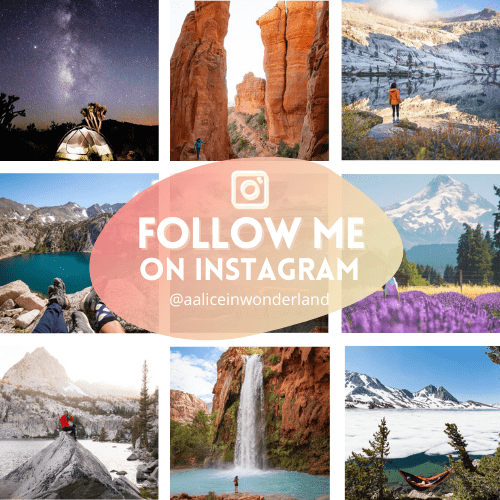
Nusfjord Area

Top left to right: The colorful village of Nusfjord, eating at the waterfront Karoline Restaurant, Storvatnet Lake. Bottom left to right : walking around the cute Nusfjord town, emerging from one of the historic rorbu fishing huts in Nusfjord, the incredibly scenic road on the way to Nusfjord.
Nusfjord fishing village - the cutest village on the water! You can pay a small entrance fee to walk around and explore some of the history behind this century old fishing village. We stopped for a delicious lunch at the beautifully decorated Karoline Restaurant and picked up some fresh pastries from Hansines bakery before leaving.
Scenic roads - we would frequently have to pull over to stop and take a photo of the incredible scenery. We turned the corner at this one spot in the road and found ourselves heading towards a massive and towering rock wall. This was one of my favorite scenic roads in Lofoten.
Storvatnet lake - the largest lake on this particular island. We passed so many random lakes that it's easy to overlook how stunning each one is. This one has several pullouts that would also make a great picnic spot!
Fredvang area
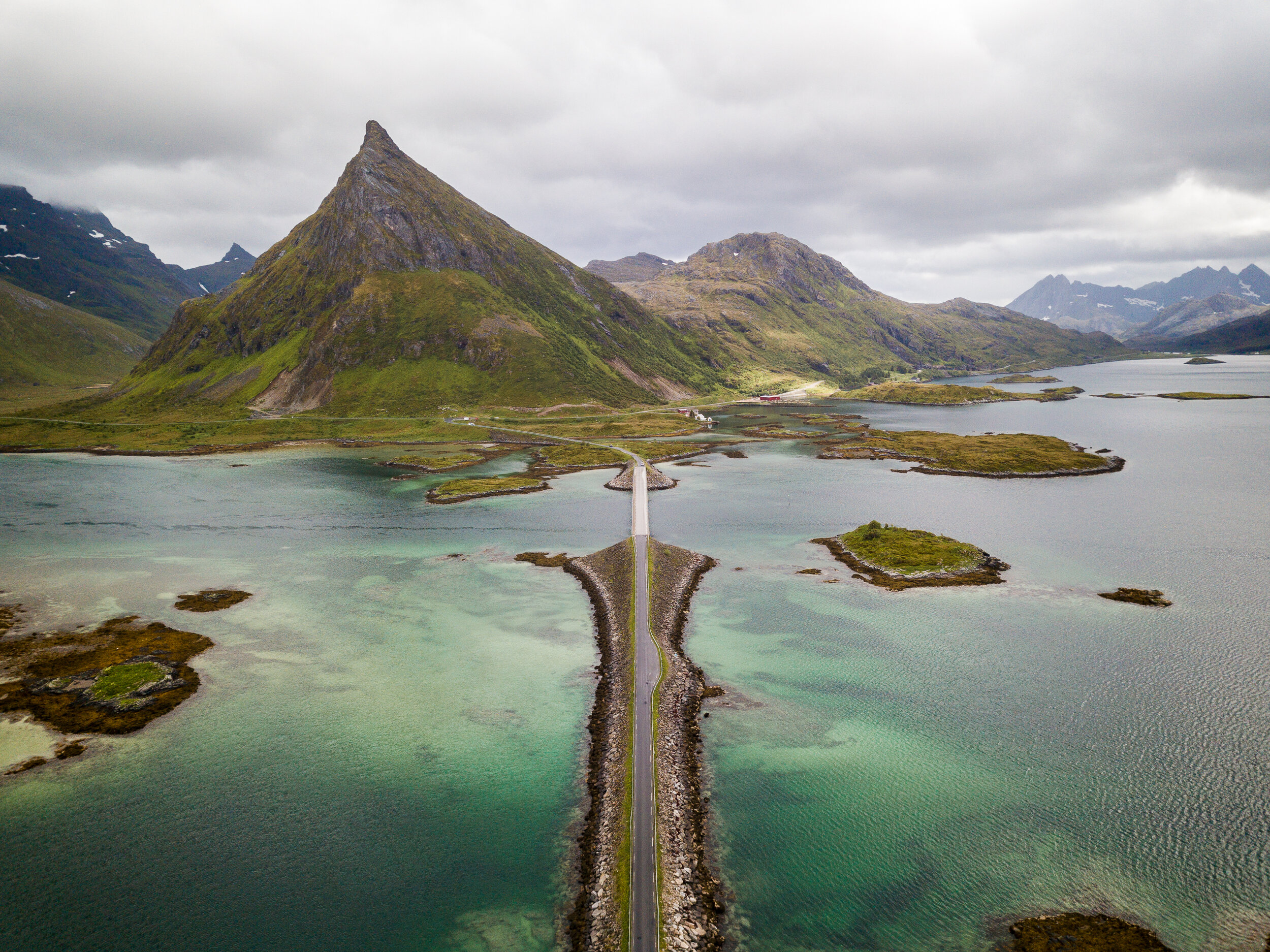
Top left to right: scenic Lofoten roads, stockfish drying in the cold, arctic air. Middle left to right: one of the many dramatic bridges in Lofoten, halfway up the Ryten hike. Bottom left to right: on our way back down from Ryten, overlook of Kvalvika beach from the Ryten trail
Ryten hike - a 5.5 mile round trip hike to the top of Ryten peak, which stands at 1782 feet. The views are incredibly scenic the entire hike, and my favorite spot was the view overlooking Kvalvika beach. There are multiple parking lots, like this one and this one , and you might want to bring small bills in cash if you end up parking in one of the local’s lots.
Our favorite Norwegian we met from the entire trip was the host of one of these parking lots. The elderly man didn’t speak English, but when he saw I didn’t have gloves for the hike, he went inside and insisted on lending me a pair of knit gloves that he had! How cute is he? He definitely knew best, as later on in the hike when I found myself on the edge of a cliff over a blustery ocean, I was so thankful for those hand knit gloves.
Hamnøy & Sakrisøya
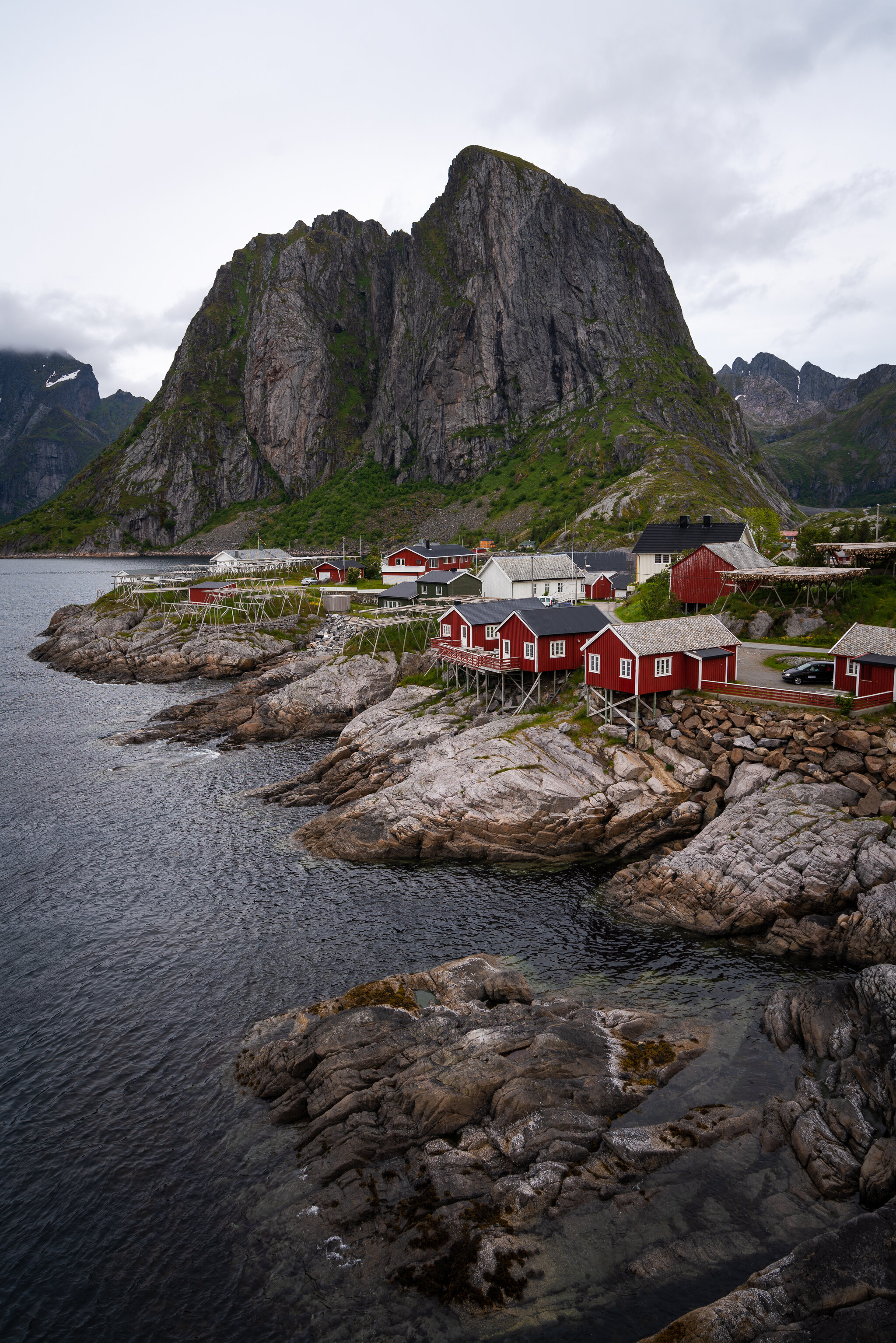
Left to right: Hamnøy village viewed from the bridge, the iconic yellow houses of Sakrisøya, looking at Sakrisøya from across the turquoise bay
Hamnøy - this small fishing village is just a few minutes east of the main Reine area, and in my opinion, Hamnøy is one of the most picturesque spots on the islands. Eliassen Rorbuer is located here, which is one of the top places to stay in Lofoten (be sure to book early!). The best view of this picturesque town is from the bridge, which you can probably spot by finding the one with the most tourists and photographers.
Sakrisøya - instead of staying in the main Reine area, we opted for Sakrisøy, which offers bright yellow fishing huts instead of the classic red found throughout Norway. We stayed at Sakrisøy Gjestegård , a cozy guesthouse perched on top of the hill in the middle of the island.
Anita’s Seafood - we ate here multiple times for lunch and dinner since it was walking distance from our Airbnb. The seafood (particularly the salmon) was SO fresh and tasty, I’m craving some right now! I absolutely love the Norwegian interior decor style of neutral tones, cozy textures, and small nature accents.
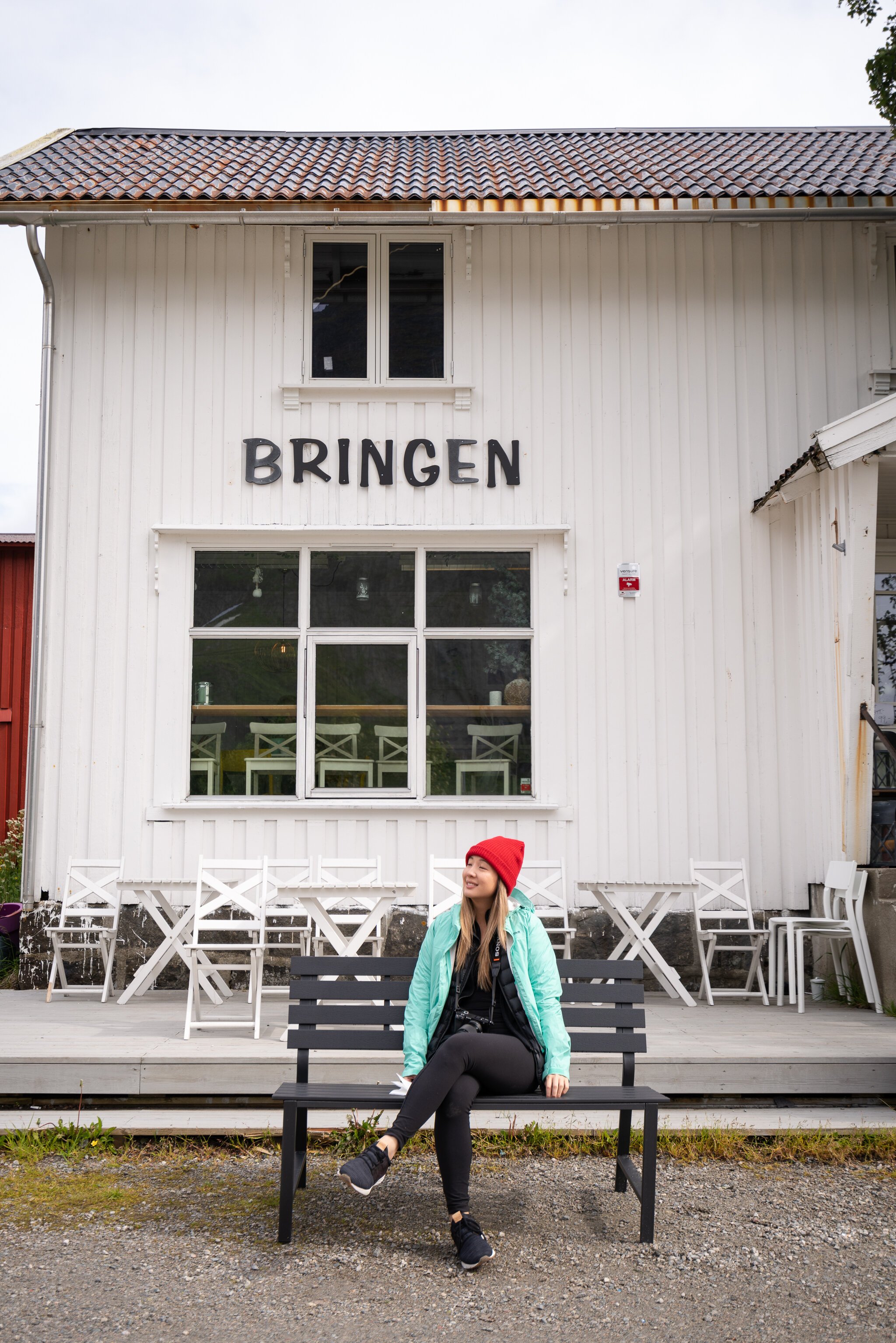
Top left to right: Bringen cafe, Reine’s colorful buildings, on the rocky shoreline of the E10. Bottom left to right: a Norwegian flag flying above Reine, a local wooden bridge, Djupfjorden on a rainy day
Reine - arguably the most famous and iconic spot in all of Lofoten. When we finally reached Reine on the western tip of the archipelago, we realized what the hype was about… the town is postcard perfect. The colorful houses are clustered together at the mouth of the bay and sport stunning backdrop of sheer cliffs and mountain ranges for as far as you can see into the distance.
Reinebringen hike - we were looking forward to this one particular hike for its dramatic views overlooking all of Reine and the surrounding peaks, but the trail happened to be closed for construction the entire the two weeks we were there! Even though we didn’t get to do it, I’d still recommend this popular hike to anyone visiting.
Djupfjorden viewpoint - this smaller fjord sometimes has waterfalls cascading down cliffs, especially after a rain!
Å - If you’re already in Reine, you might as well head all the way to the end of the road. Å is the most southern town on the main archipelago, and you can really feel like you’re at the end of the world here
We were in a constant state of awe over the entire five days we spent in Lofoten. Northern Norway is truly such a unique place with its colorful houses, winding oceanic roads, and dramatic mountain peaks. Even though we didn’t have the best weather and conditions for the hikes we wanted to do, the clouds and rain only added to the moodiness of the scenery and emphasized the turquoise water and blue skies when the sun did come out. I would love to see Lofoten in the winter in the snow!
Favorite gear for this adventure:


How To Get To Lofoten (Full Guide & Multiple Options)
Lofoten is one of Norway’s most popular tourist destinations, but getting there can be a bit of a hassle since it’s far from all the big cities in Norway. So, let’s take a close look at what you can expect you are want to get to Lofoten, and which types of transportation fit your needs.
There are plenty of different options for getting to Lofoten, and the most common ones are to travel to Bodø and take the ferry from Bodø to Svolvær or Mosknes in Lofoten. Other options are to fly directly from Bodø to Svolvær or Leknes, or to Harstad/Narvik Evenes and drive a bus or rental car from there.
All these different options have both positive sides as well as drawbacks, and we will be looking closer at the pros and cons of each method of transportation to get to Lofoten.
I found it a bit confusing the first time I traveled to Lofoten, but hopefully this article will make your planning a bit easier. But be prepared for either a long time on public transport, a long car ride, or having to buy plane tickets. It’s not the easiest place to get to, but it’s well worth it once you’re finally at the beautiful destination!
PS. I got a short travel summary for getting to Lofoten from all the major Norwegian cities at the bottom, so check those out if you want a cheat sheet.
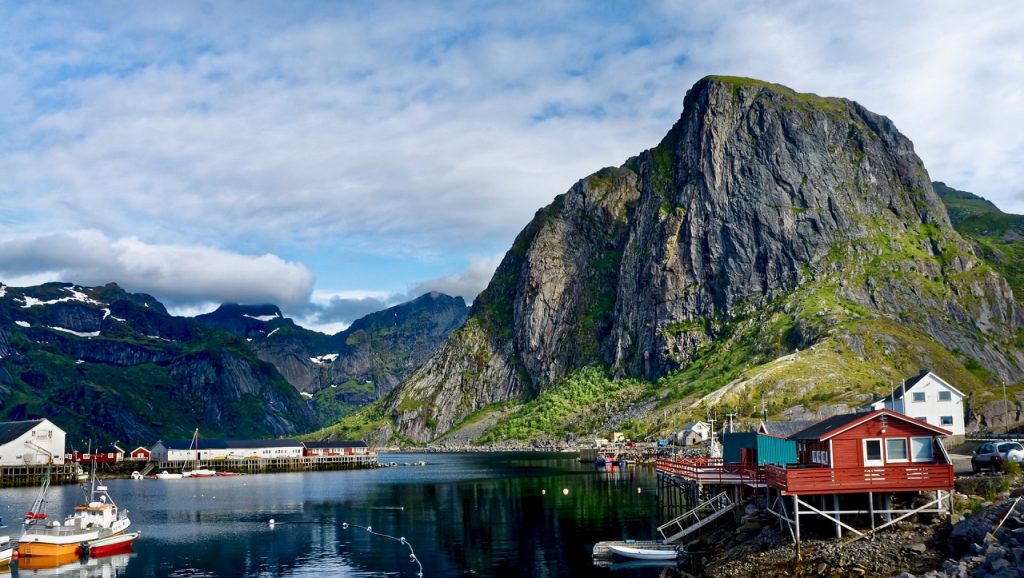
Table of Contents
Getting from Bodø (airport) to Lofoten
Bodø is the biggest city close to Lofoten, and the airport has departures from all the major cities in Norway. You can catch a flight from Oslo, Bergen or Trondheim to Bodø pretty easy, and it’s not going to be very expensive either. It’s also possible to ride the train, buses or drive to Bodø yourself.
If you’re going to Lofoten, chances are that Bodø is going to be your first stop . This is where most of the ferries and local planes depart from, so it’s a good place to aim for as the first stage of the trip. So, get to Bodø, then change transportation there for the final part of the journey.

Fly from Bodø to Lofoten
The airport in Bodø is located just a few kilometers away from the main city center , and it’s a hub of connection flights that take you straight to Lofoten if you want to. You have two different options when it comes to flying from Bodø to Lofoten, and can fly to either Leknes or Svolvær.
Leknes airport to Lofoten
There are flights between Bodø and Leknes during the summer. Leknes is pretty much in the middle of Lofoten, so it’s a great place to start exploring the region. The downside to this is that the plane ticket is pretty expensive , so feel free to do it if you get a good deal or just have some extra money to spare.
Svolvær airport to Lofoten
Svolvær is also in Lofoten, and a great place to start exploring at the one end of the island group. Again, only Bodø airport has connecting flights, so feel free to buy an expensive plane ticket to Svolvær if you don’t want to take the express ferry.
I personally don’t really see any good reason to fly to Svolvær if you get a ferry ticket. The ferry ride is pretty amazing in my opinion, but I suppose you might save a few hours and some hassle by choosing to fly the plane instead . In this case you won’t even need to go down into Bodø, and can just stay at the airport until your flight is ready.

The express ferries from Bodø to Lofoten
Most people opt for the express ferry when traveling from Bodø to Lofoten , since it’s a very scenic ride that is much more affordable than plane tickets. Make sure to book tickets well in advance if you are planning on visiting Lofoten in the middle of summer, since it tends to fill up quickly.
You can ride the ferry either with or without a car, but you will want to leave your car on the ferry to go to the cafeteria to chill out and have a coffee and a svele .
There are two ferry options . One takes you to Svolvær, and the other to Mosknes.
The ferry to Svolvær is called Nordlandsekspressen ( NEX2 ) , and you can find departure times at this website by clicking on the tab called “ Regionale hurtigbåtruter ” then choose NEX2. It leaves once daily during the summer season, and takes about 3 hours and 20 minutes in total.
The ferry to Mosknes is ran by Torghatten Nord , and takes about 4 hours in total. This also tends to be pretty full in the summer, so book well in advance to make sure you get a spot. You can book tickets from Torghatten Nord’s website by clicking here . The Mosknes ferry is the most popular ones for tourists who are traveling to Lofoten.

Driving from Bodø to Lofoten
I would not really recommend driving from Bodø to Lofoten, because it’s a bit of a hassle to get there. You will need to either drive a long way or use the ferry, so the best option for getting your car from Bodø to Lofoten is to ride the ferry with your car directly to Lofoten.
That said, it’s entierly possible to drive from Bodø to Lofoten if you feel like it, or the Lofoten express ferries are fully booked.
If you are driving yourself, drive E6 towards Bognes and ride the ferry to Lødingen from there . This ferry is about a 3 hour drive from Bodø, and then the ferry ride itself is another hour.
When you arrive in Lødingen, drive towards Lofast until you get to Lofoten. The drive from Lødingen is only 1.5 hours away from Svolvær. On other words, be prepared for 8 – 9 hours of travel when driving from Bodø to Lofoten when you include the wait at the harbor in Bognes.
Read more : How many does should you spend in Lofoten?
Harstad/Narvik Evenes airport to Lofoten
If you don’t want to stop at Bodø, flying to the Harstad/Narvik Evenes airport is your best option.
The airport is also close to Lofoten, and you can get from the airport to Lofoten in about 3 hours. There are bus departures that take you from the airport to Svolvær, and you can of course choose to pick up a car rental at the airport instead.

The travel time from the airport to the first destinations in Lofoten is only around 3 hours, and you can ride Flybussen’s bus line all the way to most of the bigger towns in Lofoten. Expect to pay around 350 – 400 NOK for a single adult ticket from Evenes to Lofoten.
Here’s a more detailed article about getting from Harstad/Narvik Evenes to Lofoten .
One of the major reasons to travel to Lofoten from Harstad/Narvik airport is that you don’t have to ride the ferry, so it’s perfect for those of you that are afraid of boats and ferries. It’s also often a decent option if you are traveling from northern Norway and are heading south towards Lofoten.
PS. you don’t need to actually stop by Harstad city when driving from the airport to Lofoten, but it’s well worth a few hours if you got a rental car and want to experience a medium sized city in northern Norway.
Driving to Lofoten
You can do a road trip from anywhere in Norway and head towards Lofoten . Your first goal should be to get to Bodø, and then either drive to Lødingen to catch the ferry from there and drive along the beautiful islands, or just ride the ferry all the way from Bodø to Mosknes or Svolvær.
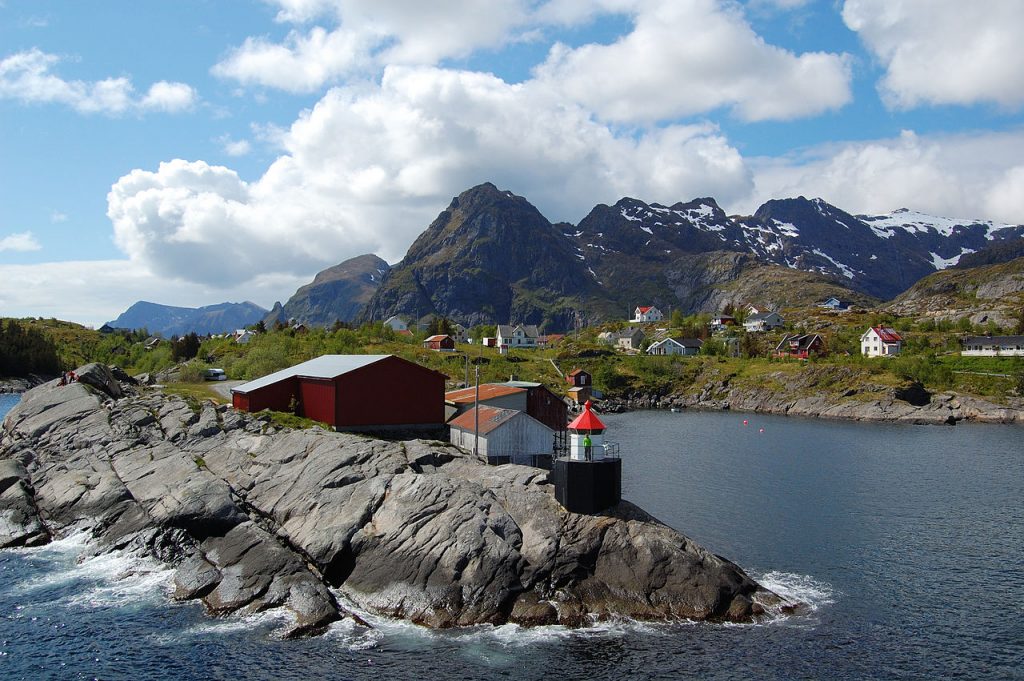
Driving all the way from Oslo is a pretty long journey, and it is expected to take around 16 to 18 hours of driving in total .
There will be plenty of toll booths along the way, so be prepared for some additional expenses. You can get to Lofoten without riding a ferry if you really want it, but it will take much longer if you’re coming from the south.
Here’s a guide on getting from the major cities in Norway to Bodø . You can pretty much drive on E6 the entire trip from Oslo, so it’s a very easy route.
Even though it takes a long time to drive to Lofoten, it can be worth it! The ride itself is incredibly scenic, and it’s a great way to explore the Lofoten islands. And as a bonus, you have a car to use to drive around on Lofoten once you’re there, giving you freedom to explore Lofoten at your own pace.
Riding a train to Lofoten
You can easily get to Lofoten by train if you want, and you pretty much ride the train to Bodø, then catch the ferry from Bodø to either Mosknes or Svolvær. The train to Bodø departs from Trondheim, so you might need to switch train in Trondheim if you are travelling from Oslo or other parts of Southern Norway.
You don’t need two separate tickets, so buy a train ticket from Oslo to Bodø. There are no train tracks north of Bodø, so you depart at the final destination.

Getting from the major cities in Norway to Lofoten as easy as possible
If you just want to get to Lofoten from the big cities in Norway as easily as possible without worrying about all the different options, here’s a short summary for you!
Get from Oslo to Lofoten
The quickest way from Oslo to Lofoten is to catch a plane from Oslo to Bodø. Ride the express ferry from Bodø to either Mosknes or Svolvær, and you’re already in Lofoten. The plane ride is around an hour and a half, and can cost as little as around 1.000 NOK.
Other options are to ride the train to Bodø (takes about 18 hours), or drive your car along E6 all the way to Bodø (takes around 18 hours), then jump on the express ferry (an additional 4 hours).

Get from Stavanger to Lofoten
It’s a bit difficult to get from Stavanger to Lofoten. You will probably want to ride an airplane, but you will have a layover in either Bergen or Oslo. This makes the trip around 3 hours until you are in Bodø, where you must change to the express ferry to get to Mosknes in Lofoten.
Driving from Stavanger to Lofoten is not really recommended, and you can expect around 24 hours of drive time. This will be a long and pretty demanding car ride that will take you along lots of fjords and mountain passes. So only do this if you want to see a lot of Norway, and be aware that there are plenty of better options for actually getting to Lofoten easily.
The same goes for the train ride. To ride the train from Stavanger to Bodø, you first need to ride the train to Oslo, then change there.
Get from Bergen to Lofoten
To get from Bergen to Lofoten easily, ride the airplane from Bergen airport Flesland to Bodø, then get on the express ferry to get to Lofoten. The flight time is only 1 hour and 30 minutes, and is usually reasonably priced.
Bergen has some of the same issues as Stavanger when it comes to both car and trains. It’s a bit of a hassle to drive from Bergen to Bodø, but it’s possible if you are up for a difficult ride that has a lot of amazing scenery. Expect to spend around 20 hours driving to Bodø.

Get from Trondheim to Lofoten
Trondheim is a lot closer to Lofoten than most of the major cities in southern Norway, and the quickest way of getting from Trondheim to Lofoten is to ride the plane to Bodø, then change to the express ferry to Mosknes or Svolvær there.
You can also drive from Trondheim to Bodø pretty easily by following E6 north for around 9 hours, or get on the train between the two cities.
Get from Tromsø to Lofoten
It’s pretty easy to get from Tromsø to Lofoten if you got a car, and the 6 hour drive is pretty amazing. Drive south on E6 until you get to Narvik, then change to E10. Keep driving on E10 until you are in Lofoten! You can also choose to book a plane ticket from Tromsø to Bodø, then get on the express ferry to Lofoten in Bodø.
It’s much more difficult to get from Tromsø to Lofoten with public transport, and it does not seem like there are any direct routes. Your best bet is to ride a bus to Narvik, the change buses in Narvik to get to Lofoten.

Nicklas is the owner and editor of The Norway Guide, and is responsible for most of the content on the website.
He lives in Skien, Norway with his wife and two children. Nicklas is specialized in Norwegian ecology (including Norway’s geology, wildlife and flora) from his degree in Ecology And Nature Management at University of South-Eastern Norway, but has a particular interest in tourism and content creation.
His biggest hobbies are fishkeeping, going on hikes with his dog, and rooting for the local football team.
Leave a Comment Cancel reply
Save my name, email, and website in this browser for the next time I comment.
- Skip to primary navigation
- Skip to content
- Skip to primary sidebar
- Skip to footer
Heart My Backpack uses affiliate links, which means that if you make a purchase through my links, I may earn an affiliate commission.
Our Two Week Trondheim – Helgeland – Lofoten Road Trip Itinerary
February 20, 2020 by Silvia 3 Comments
My friends Sher and Sam visited in January, which made for the perfect excuse to plan a new Norwegian adventure.
I always try to share my Norway itineraries , as personally I get so much inspiration from other people’s itineraries when I’m planning a trip. And I put a lot of thought into this one, as this was Sher and Sam’s first visit to Norway, so I wanted them to experience a good variety of places. I also really wanted them to fall in love with Norway so that they would visit me again. And I think I achieved that? I mean, I really hope so.
And yes, this was a winter trip, but you could do this any time of year – this route would be particularly magical in the summer, as it includes lots of islands and coastal stops.
First of all, I wanted to include a big city. While a lot of people start their Norway trips in Oslo or Bergen , I personally prefer Trondheim, plus that way we could focus more on the northern half of the country, which is my favorite area as the landscape is the most dramatic and there’s the midnight sun in the summer and northern lights in the winter.
They then really wanted to see Lofoten, because Instagram, which made for a good end point because it’s far north enough for good chances of seeing the northern lights.
But I’ve also sort of gone off Lofoten lately. Or at least, while the islands are undeniably beautiful, they’ve become so touristy that I don’t feel like they really give visitors a sense of what Norway is all about. And so I decided to include a couple of islands along the Helgeland coast, for a more authentic taste of Norwegian island life.
Personally I think these islands are equally as beautiful as Lofoten, and I swear the Helgeland islanders are the loveliest people in Norway.
I did have to think for a while about how best to share this itinerary with you, because it involved a lot of driving, and I planned it out of Mosjøen, because that’s where my car and I live. But you probably won’t be flying in and out of Mosjøen. I mean we do have an airport, but it’s tiny and flights can be expensive.
Sam and Sher flew into Trondheim and out of Evenes, up north by Lofoten, connecting to their international flights in Oslo. So it would be ideal if you could do the same, but then there’s the matter of the car.
Probably the hardest thing about planning a road trip in Norway is that in most cases you’ll need to pick up and drop off your rental car in the same location. Sometimes you can pay a fee to drop off somewhere else, but it is not cheap . And because most of Norway is long and thin with just one main highway running from north to south, it’s not always possible to plan your road trip in a loop. In other words, at some point you’re likely going to have to turn around and drive the same route back to where you came from.
But I think I’ve come up with a few ways to get around that with this itinerary, combining car and train journeys and switching around a few of the destinations.
This is a two week trip, though you could very easily extend it for longer, and I’ll give some suggestions for how to do so at the end. Alternatively you could make this shorter, cutting out one or two of the stops, or even just doing half of it – either from Trondheim up to Mosjøen or Mosjøen up to Bodø (I would recommend the latter, unless you really want to see Trondheim).

Table of Contents
Day 1: Arrive in Trondheim
I love starting a trip in Trondheim, and I think it makes for the perfect introduction to Norway.
The downtown area is really pretty and the Bakklandet neighborhood has those cute colorful wooden houses that Norway is known for, but it’s also a proper city, which we don’t really have in northern Norway (Tromsø has a population of only about 70,000 and feels more like a big town).
Trondheim accommodation
We kicked our trip off in style by staying at the Britannia Hotel in downtown Trondheim. The Britannia Hotel first opened in 1870 and over the years has hosted many notable guests including royals from Norway, the UK, and the US (Beyoncé and Jay-Z, of course). Last year the hotel completed a massive renovation, and the inside now is seriously impressive.
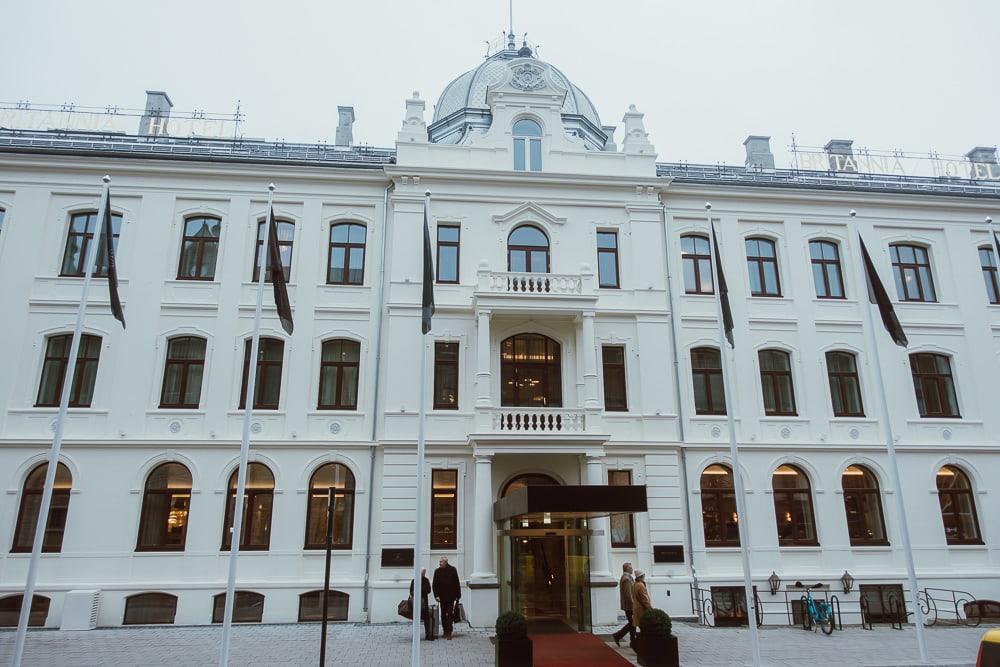
You can find more Trondheim accommodation options for every budget here .
Day 2: Trondheim
While you could stay longer in the city, one full day is really plenty of time to see Trondheim’s highlights.
I used to live in Trondheim so I could go on and on about all there is to do there. Oh wait, I already have – you can find my guide to things to do in Trondehim here .
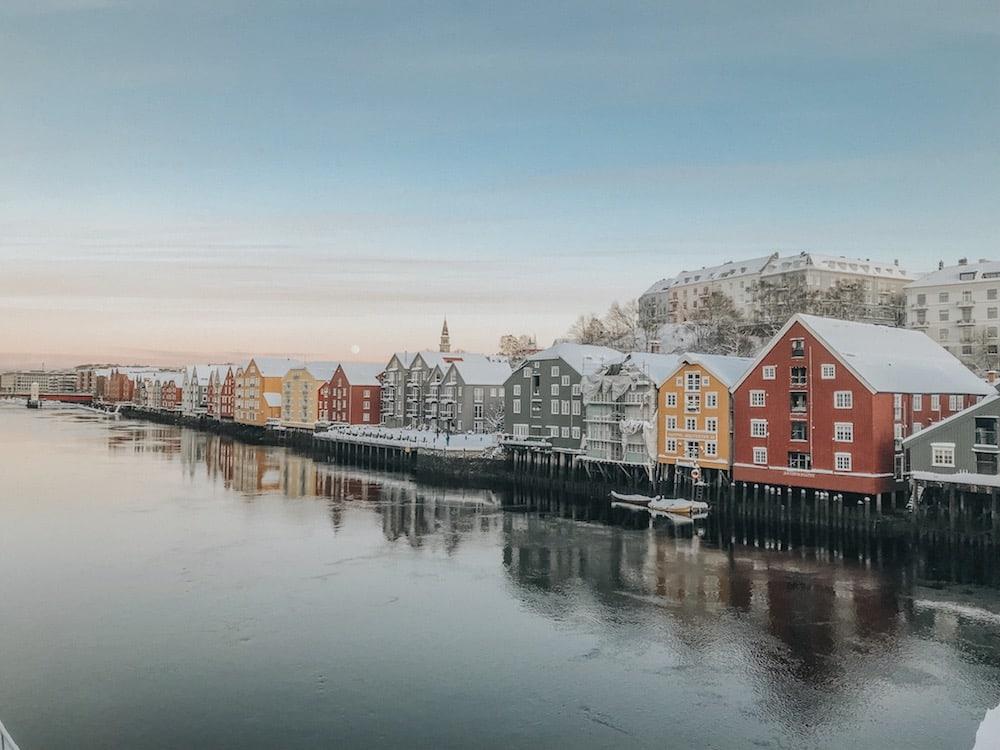
Day 3: Trondheim to Mosjøen
We got the evening train to Mosjøen, but if you’re visiting in the winter and want views out your window you should get the morning train. Though to be honest this train ride goes through a lot of flat, boring areas, so you won’t be missing much if you go at night instead, plus then you can spend the first half of the day in Trondheim.
You can book your train tickets at vy.no up to three months in advance – the earlier you book, the cheaper the tickets will be.

Mosjøen accommodation
The nicest hotel in Mosjøen would be Fru Haugans Hotel, right at the end of Sjøgata. Dating back over 200 years, Fru Haugans is Northern Norway’s oldest hotel and while I haven’t actually stayed here, I’ve eaten at their restaurant Ellen, which is excellent, and their bars tend to be the center of nightlife here. Check prices and availability here
I’ve also stayed at Mosjøen Hotel, which is right across the street from the train station, and about a ten minute walk to the town center. The hotel is older but perfectly comfortable, and I’d say this is the most convenient place to stay since it’s right by the station, so you won’t have to walk far with your luggage. Check current rates and availability here
On my first visit to Mosjøen I stayed in one of the historic apartments on Sjøgata, which are self-catering holiday apartments on Mosjøen’s most beautiful street. They are decorated to look like they did in the 19th century, and while they’re more basic you’ll certainly feel immersed in the culture staying here. You can book the apartments here .
There are also a few Airbnb options in Mosjøen, which you can find here . And if you’re new to Airbnb you can get a discount by signing up through my link here .
Day 4: Mosjøen
Okay so obviously I included Mosjøen in our itinerary so that I could show Sher and Sam where I live, but actually I think Mosjøen is worth the visit on its own as well. It’s a really cute town with lots of cosy cafes and restaurants, and the history of how Mosjøen developed and grew from a small port town to an industrial center is really interesting and offers a great look into life in northern Norway.
I’ve written more about things to do during a visit to Mosjøen here . Definitely take a stroll down Sjøgata, our historic street downtown, and pop into the museum at Jacobsenbrygga to learn more about the area and its history. They also have a really cute gift shop where Sher and Sam bought some Norwegian knitted mittens – a must if you’re visiting in winter.
View this post on Instagram A post shared by s a m a n t h a ✨ (@thereshegoesagn) on Jan 18, 2020 at 3:38am PST
Day 5: Husky sledding in Susendal
This was my favorite day of our trip, mostly because huskies, but also because Susendal was so beautiful covered in snow.
First off you’ll want to pick up your rental car. There are a few car rental places in Mosjøen, so you can compare prices on AutoEurope . The Avis office is most central, while the others are a bit of a walk from downtown, but you can probably get them to pick you up at your hotel if you ask nicely.
And then you can drive to Susendal! Susendal is about an hour and a half from Mosjøen, though it took us closer to two hours because of all the snow. Okay and maybe I’m a really slow driver.
The weather along the Norwegian coast can be unpredictable, and you’re never guaranteed snow, even as far north as Tromsø, so if you want a true winter experience in Norway it’s always a good idea to spend some time inland or in the mountains. Mosjøen already tends to have a lot more snow than the coast, but Susendal was even snowier when we arrived.
I’ve been husky sledding in Susendal before , and it’s still probably my favorite husky sledding place in Norway. Linda of Aaslid Polar houses the huskies on her farm and you can see that each of the dogs totally adores her.
This experience was particularly fun because we started during daylight and then continued into the night. There’s something so incredibly peaceful about sledding in the dark, especially through the Susendal woods, where we were often making our own tracks.
And if you’re visiting in the summer, I’d still recommend a trip out here, as there are tons of hiking trails! It’s a really peaceful part of the country and I’d say one of the best quiet escapes I know.

Susendal accommodation
Depending on when you finish, you might want to spend the night in Susendal, or somewhere on the way to Brønnøysund to shorten your drive tomorrow.
In Susendal I’ve stayed at Furuheim Farm , which I absolutely love. The woman who runs it is so sweet, and it’s a great way to get a peek into rural life in Norway. I’d especially recommend this if you’re traveling with a family, as a farm stay is so much fun!
This cabin near Trofors would be another great option, otherwise I would check Airbnb and look for something on the way to Brønnøysund ( this vacation home looks nice).
Day 6: Brønnøysund
Today you’ll drive to Brønnøysund and depending on when you arrive, you could either catch the ferry to Vega today or explore around Brønnøysund for the day. The Vega ferry leaves from Horn, which is about a fifteen-minute drive from Brønnøysund. You can check the ferry schedule here – you’ll be leaving from Horn (Brønnøy) and going to Igerøy (Vega).
Brønnøysund is a cute little coastal town, and as it’s one of the Hurtigruten stops it is set up quite well for tourists. That said, I’m pretty sure we were the only tourists visiting in January. But it was still lovely! It’s definitely at the top of my bucket list for summer now though – I would love to see Brønnøysund and Vega in the summertime.
I’ve written more about our visit to Brønnøysund here .
Brønnøysund accommodation
We spent the night at the Corner Hotel in downtown Brønnøysund. The rooms are basic, but the location was perfect, the staff friendly, and rooms come with breakfast. Check current rates and availability here
The seaside cabins at the Aquaculture Center are also super cute, though they are a fifteen minute drive out of town. Check current rates and availability here
And then you could also stay at Torgarhaugen for budget friendly accommodation right across from Mount Torghatten. Check current rates and availability here
Day 7: Vega
The Vega archipelago is a UNESCO World Heritage Site and a fantastic place to learn about Norway’s coastal history. The islands are also stunning and there are some lovely hikes here. We went up the Vega Stairs, which has beautiful views out over the coast and other islands.
I’ve written more about our visit to Vega here .

Vega accommodation
On Vega we stayed in a lovely cabin right on the water at Vega Opplevelsesferie. I loved being on the water, and the cabin had a kitchen so we were able to make dinner and breakfast here. Plus there was a cosy wood burning oven, for optimum hygge. Check current rates and availability here
And then again there are a bunch of lovely looking options in Vega on Airbnb, which you can find here .

Day 8: Vega towards Stokkvågen
Vega is just a bit too far from Lovund to make the journey in one day (also because of the ferry schedule), so you’ll need to break up the journey somewhere. We drove back to Mosjøen and spent the night there, mostly because we could stay at my apartment for free.
But I would actually instead recommend you take the coastal road up towards Stokkvågen, where you will catch the ferry to Lovund tomorrow, and spend the night somewhere along the coast. That way you don’t have to drive the same road back to Mosjøen, plus the coastal route is incredibly beautiful.
The only thing you’ll need to be careful about is timing your ferries. Easiest would be to get the ferry from Igerøy (Vega) to Tjøtta, near Sandnessjøen, which is more direct and will cut out one ferry. But the Igerøy – Tjøtta ferry only goes a few times a week during the winter (Tuesdays and Fridays, with an evening departure on Sundays), so you’d need to time your visit accordingly.
Otherwise you’ll need to get the ferry from Igerøy back to Horn, and then from Horn to Andalsvågen, and then the ferry from Forvik to Tjøtta. And then if you’re going all the way to Nesna you’ll get the ferry from Levang to Nesna. None of these have to be booked in advance – you pay by credit card on board – but you do need to time your drive so that you make all of the ferries (the times are set up so that usually if you make the first ferry you can make all of them). You can check all the ferry times here .
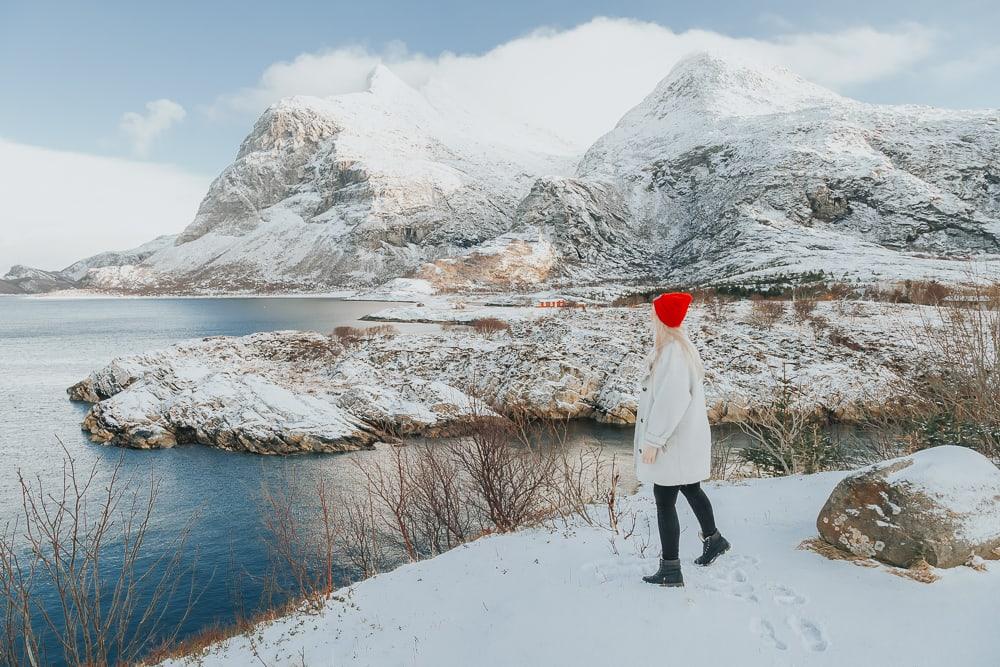
Helgeland coast accommodation
If you want to stay at a hotel, the Scandic in Sandnessjøen is a great option, or if you’re up for the long drive you could stay at Havblikk Helgeland . Or you could check Airbnb for somewhere to stay along your drive – search for Sandnessjøen and then look at the map view to find a place on your route. Some places do require longer stays, but both this cabin on the water and this cottage look lovely and are open for single night reservations.
I keep recommending Airbnb because a lot of Norwegians have cottages and cabins that they rent out (which is great, because otherwise they’d sit empty for a lot of the year), and cabin life is such a key part of Norwegian culture that it’s something you definitely want to experience while here.

Day 9: Lovund
Aside from husky sledding, Lovund was probably the highlight of this trip for me, so I would definitely try to fit it in if you can (if you only have time for one island I would choose Lovund over Vega).
You’ll get the ferry from Stokkvågen to Lovund, and while there is a car ferry going to Lovund there’s no need to bring a car there – plus that way you can take either the ferry or the passenger boat. There’s free parking at the Stokkvågen ferry terminal, so I left my car there for the night we were on Lovund.
I’ve written about our visit to Lovund here .

Lovund accommodation
We stayed at Lovund Hotel, which is an experience in itself. The restaurant especially is fantastic, and the views from the rooms are stunning. I’d say this is one of my favorite places I’ve stayed in quite a while, and definitely worth the trip to Lovund. Check current rates and availability here

Day 10: Lovund to Nesna to Mosjøen
From Lovund we headed north towards Lofoten, overnighting at Ulvsvåg Guest House before getting the ferry from Bognes to Lodingen the next morning and then driving down through Lofoten.
But if you’ve rented a car in Mosjøen you’ll want to head back there to return it, unless you’re happy to make the drive from Lofoten back down to Mosjøen at the end of your trip, which honestly would be more of a pain than it’s probably worth.
The drive from Stokkvågen to Mosjøen takes two and a half hours, but I would recommend breaking it up with a stop in Nesna.
VisitNesna have a RIB safari, where you can go out on their boat to see sea eagles! I haven’t done this myself but I’ve been meaning to. I think this would be a great addition to the itinerary, as it’s always fun to get out on the water, even in the winter. And the sea eagles here are definitely worth seeing.
I did a similar sea eagle safari in Lofoten (which actually you could also do when you’re up there!) and was amazed by how much I loved it.
And then in the evening you can return your rental car and overnight in Mosjøen.
This time I’d opt for Mosjøen Hotel, so you’ll be right by the train station. Check current rates and availability here
Day 11: Mosjøen to Bodø
Today you’ll get to experience Norway’s most beautiful train journey! The train from Oslo to Bergen and the Flåm railway are probably the two most famous train journeys in Norway, but I find the train ride from Mosjøen to Bodø much, much more beautiful and dramatic.
Once you arrive in Bodø you’ll want to get a rental car to take across to Lofoten. Public transport in Lofoten is very limited, so I would definitely try to have a car there, if at all possible. Sixt is my go-to car rental in Norway, but you could also compare prices here .
It’s probably easiest to pick up your rental car when you arrive at the train station in Bodø, but if you want to save money on parking and the rental fee you could pick up your car in the morning instead. Bodø is quite walkable, so you should be able to get from the station to your hotel on foot.
If you have time to explore Bodø, I’ve written about visiting Bodø in winter here , and things to do in Bodø here .

Bodø accommodation
There are a lot of hotel options in Bodø, but my favorite is the Thon Hotel Nordlys , which has the best breakfast buffet in all of Norway – no exaggeration!
I’ve also stayed at both the Scandic Bodø and Bodø Hotel , both of which are also very nice and a bit cheaper than the Thon Hotel. And then if you want a good budget option near the station, City Hotel is perfect. In fact if you’re happy to stay somewhere basic, City Hotel would be the most convenient location.
Day 12: Bodø to Lofoten
Today you will get the ferry from Bodø to Moskenes in Lofoten. You actually might want to book this in advance here (though usually it’s fine to show up the day of). And sometimes the voyage can get rocky, so if you’re prone to motion sickness bring some Sea-Bands !
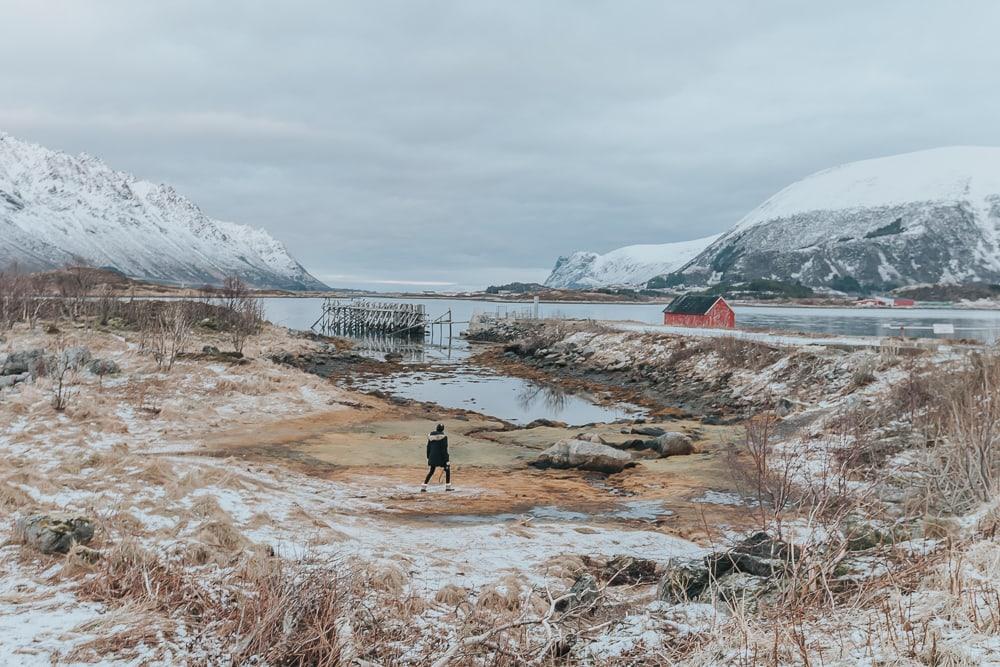
Lofoten accommodation
There are so many accommodation options on Lofoten, so first I would try to narrow down to where you want to stay.
Southern Lofoten is the prettiest, with lots of cute fishing villages, but it’s also the most touristy. Personally I wouldn’t want to stay here in the summer as it gets so crowded with visitors, but if you’re visiting in the winter it won’t be quite as busy.
In the south I absolutely love Eliassen Rorbuer on Hamnøy. Here you get to stay in one of these pretty red cottages!
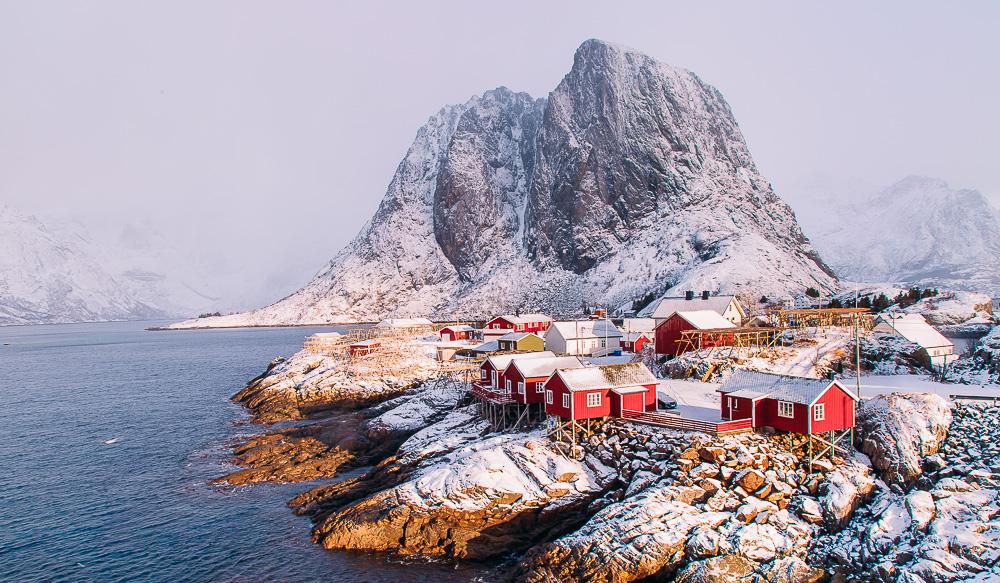
And then farther north my usual go-to is Svinøya Rorbuer , which also has super cute red fisherman cabins right on the water.
This time we stayed at the Scandic Svolvær , which again was right on the water. It’s also right by the harbor so especially convenient if you’ll be doing any tours leaving from Svolvær harbor.
And if you want to get off the beaten path a bit, I can highly recommend Lofoten Links Lodges on Gimsøy, which is ideally situated for northern lights viewing. In fact this is actually the only place I’ve managed to see the northern lights from Lofoten. The cabins have huge windows facing north, and Gimsøy is super dark, which is perfect for aurora hunting.

Day 13: Lofoten
You can of course spend as long on Lofoten as you wish, but I would definitely try to have at least one full day here to explore – two or three would be even better.
I have a bunch of Lofoten travel guides, including planning a Lofoten road trip , things to know for your Lofoten trip , horseback riding in Lofoten , taking a day trip to Lofoten , and taking a sea eagle safari in Lofoten .

Day 14: Lofoten to Bodø -> Home
And then when you’re ready you can get the ferry back to Bodø, return your rental car, and fly home from Bodø! You might need to spend an extra night in Bodø, depending on when your flight leaves and when the ferry gets in.
If you want to extend your trip, you could drive from Lofoten up to Vesterålen. Vesterålen is a bit less touristy than Lofoten, plus you can see whales and reindeer here! I’ve shared more things to do in Vesterålen here .
And then from Vesterålen you could continue over to Narvik and spend a night in this incredible Arctic Dome . From Narvik you can drive back down to Bodø to return your rental car and fly home.
Related Posts
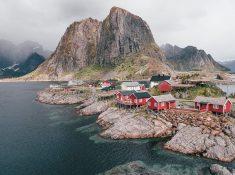
Reader Interactions
Get updates.
Subscribe to my newsletter for exclusive updates and stories from my world travels and life in Norway!
February 27, 2020 at 11:23 am
thanks for sharing
Kristin says
July 15, 2021 at 11:51 am
Hi! Great blog, so much helpful info for people traveling in Norway!
I have a question, My husband and I live in Lofoten and are planning a trip in September to Ålesund, working our way up towards Bodo. We are wanting to do a bit of exploring to some islands and also spend some time relaxing at a cabin on one of the islands. I’m interested in which island you would recommend for a relaxing stay for a 5ish night stay? We haven’t decided on a car yet, but if needed it’s an option! So far these are the ones that we want to visit: Lovund, Træna, Bolga, Støtt, Dønna/Herøy
Thanks for any recommendations!
Silvia says
July 16, 2021 at 12:16 pm
Træna is my favorite and you wouldn’t need a car, but I would probably just look where has the nicest place to stay and go there, as they’re all beautiful.
Leave a Reply Cancel reply
Your email address will not be published. Required fields are marked *
Once a full-time nomad, I'm now trying to find a balance between continuing to explore off the beaten path places around the world while also building a home in Norway. Want to know more? Head to my About page !
COME AND GET IT!
Subscribe to my newsletter for exclusive updates and stories from my world travels and life in Norway:

Lofoten : itinéraire d’une semaine en road trip
Cela faisait quelque temps que je souhaitais partir aux Lofoten en Norvège et au mois de juin de cette année j’ai enfin pu planifier ce voyage qui me faisait tant rêver. Le pays ne m’était pas inconnu puisque j’avais déjà passé 15 jours dans le sud de la Norvège , mais cette fois je suis parti beaucoup plus au nord au delà du cercle polaire pour un itinéraire d’une semaine en road trip aux îles Lofoten .
Pour toutes les informations concernant la préparation de ce voyage (réservation de ferry, voiture de location, vols, budget, matériels, …) vous pouvez consulter l’article du blog : organiser un voyage aux îles Lofoten en Norvège .
Les villages que j’ai visité et les randonnées que j’ai faite lors de mon road trip aux Lofoten sont présentés dans ce billet du blog en partant du sud (Å) vers le nord (Svolvaer) de l’archipel. C’est l’itinéraire classique si vous arrivez par le ferry de Moskenes.
Carte et itinéraire de mon road trip d’une semaine aux îles Lofoten

Arrivée à Bodø
A l’embarquement mon sac à dos fait 19 kilos, je ne suis pas loin de la limite car sur la compagnie Norwegian le poids autorisé est de 20 kg. C’est la première fois qu’il est aussi lourd, faut dire que voyageant seul je suis obligé de porter tout le matériel de camping et la nourriture. Arrivé à Bodø en début de soirée, je récupère la voiture de location à l’aéroport et me dirige vers le camping le plus proche. Je m’arrête en chemin dans une station service pour acheter une cartouche de gaz (70 NOK le grand format), mais ce ne fût pas une bonne idée car il y en avait plusieurs à disposition dans le camping de Bodø. En effet les voyageurs reprenant l’avion laissent leur cartouche plus ou moins pleine sur place.
L’emplacement tente pour une voiture et une personne est à 175 NOK au Bodøsjøen Camping (il y a un code d’accès pour les parties communes). La première nuit a été un peu difficile puisqu’il y avait pas mal de vent et de la pluie sans compter le réveil matinal à 5 h. Le pliage de la tente sous la pluie n’était pas non plus des plus agréables, heureusement ce fût la seule fois de tout le voyage où il a plut.
Ferry Bodø – Moskenes
J’avais réservé le ferry de 7h pour Moskenes et ma réservation indiquée que le dernier appel était à 6h15 (pour les réservations de ferry et les différentes routes tout est expliqué dans l’article du blog organiser son voyage aux îles Lofoten ). Je me suis donc pointé à 5h55 avec un peu d’avance et en fait j’ai pu prendre le ferry de 6h qui partait juste 5 min après. Le ferry était quasiment vide avec seulement 7 véhicules à bord, j’ai pu m’allonger facilement sur les banquettes afin de finir ma nuit. La traversée de 3h30 a été mouvementée, ça tanguait pas mal à cause du mauvais temps, j’avais même un peu peur que la voiture bouge dans la cale. A la sortie du ferry à Moskenes je croise un couple d’allemand qui fait du stop et ça tombe bien pour eux, ils vont au même endroit que moi.
Ile de Moskenesøy
Å (prononcé « O ») est le village le plus au sud des îles Lofoten, à 5 km de Moskenes. C’est également l’un des villages les plus visités de l’archipel (heureusement début juin cela reste assez calme), faut dire que son ensemble de vieilles maisons rouges pleine de charme constitue un musée à ciel ouvert . On retrouve tout ce que l’on pouvait trouver dans un village de pêcheurs du nord de la Norvège dans les années 1800 (magasin général, hangar à bateaux, usine d’huile de foie de morue, forgeron, …). Ne manquez pas de passer par l’ancienne boulangerie ( Bakeriet ) qui propose d’ excellents roulés à la cannelle (49 NOK – 5 €), mais venez le matin car le stock est vite dévalisé par les touristes.
Déambuler dans le village ne vous coutera rien, par contre si vous souhaitez visiter les différents bâtiments faisant office de musée il faudra acheter un billet d’accès à 100 NOK (10 €). Si vous passez par Nusfjord par la suite , vous pourrez visiter gratuitement le même type de bâtiments reconvertis en musée.
Un grand parking gratuit se situe juste après le tunnel, en partant à pied vers le sud on peut explorer les environs, il y a une jolie vue sur la côte et au loin les îles de Vaeroy et Rost. La météo de cette première journée de road trip aux Lofoten a été assez nuageuse (la seule de toute la semaine), je suis donc repassé au village de Å avant de prendre le ferry retour pour Bodø.
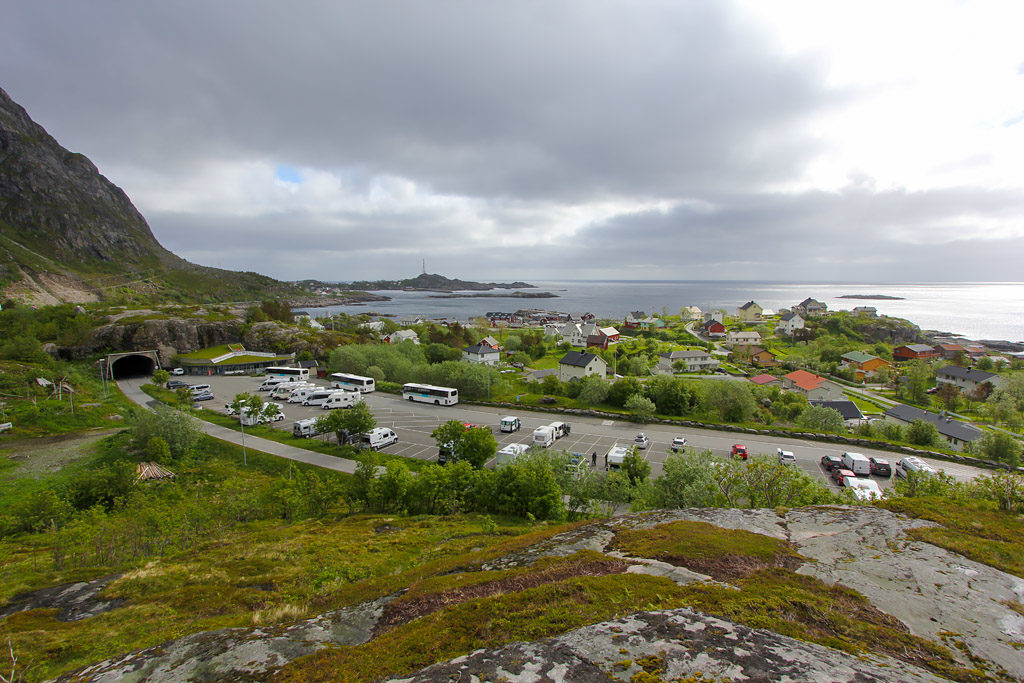
Randonnée lac de Trolldalsvatnet
- Point de départ : Sørvågen (juste avant le village en venant de Å)
- Dénivelé : +200 mètres / -200 mètres
- Durée : 2 heures A/R
- Distance : 4,5 km
- Altitude : entre 0 et 150 m
- Difficulté : facile ★ ☆☆☆☆
J’ai trouvé cette idée de rando en consultant le site rando-lofoten qui répertorie une grande partie des randonnées aux Lofoten. La randonnée du lac de Trolldalsvatnet est facile, il n’y a aucune difficulté physique. Par contre ce n’est pas pour autant qu’elle est adaptée aux enfants car il y a certains passages techniques. La deuxième partie (après le lac Stuvdalsvatnet) est très glissante, il y a des passages où il faut s’aider de cordes pour monter et le sentier passe parfois par des sortes de sables mouvants. J’ai souvent mis les pieds dedans et même réussi à enfoncer de 1 mètre mon bâton de marche ! Comme partout aux Lofoten le sentier n’est pas balisé et la trace GPS que j’avais téléchargé m’a bien aidé à certains endroits.
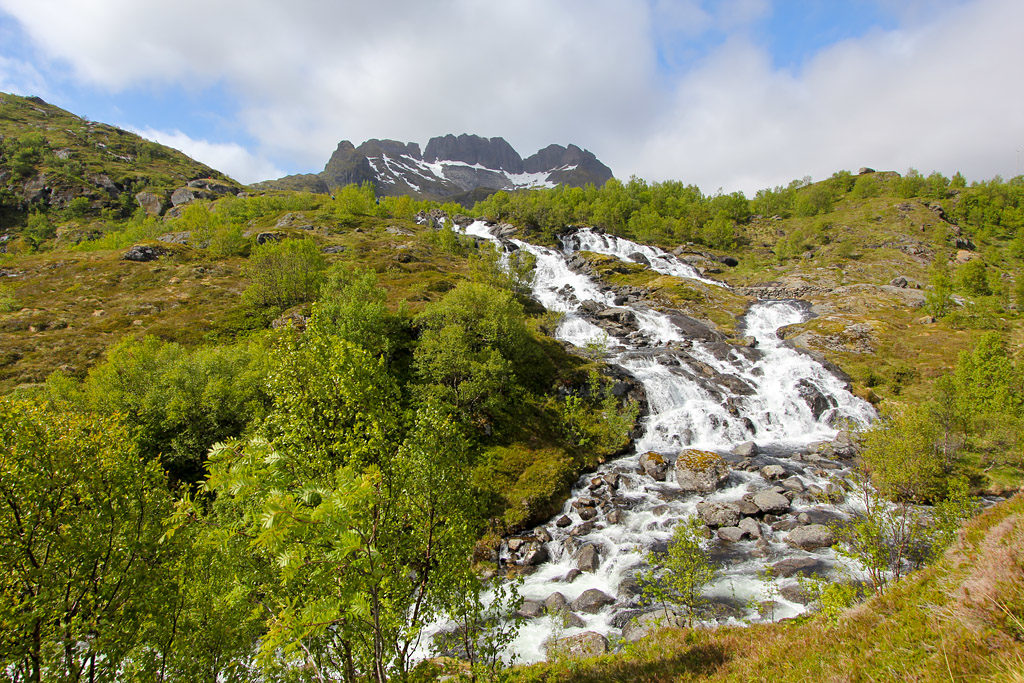
Joli petit port de pêche situé entre Å et Moskenes . Il n’y a pas grand chose à faire à part admirer le paysage. Pour profiter du meilleur point de vue quitter la route E10 pour passer de l’autre côté du port. Nombreuses solutions d’hébergements ( rorbu , lodge ou hôtel ) si vous ne trouvez pas votre bonheur à Å ou Reine.
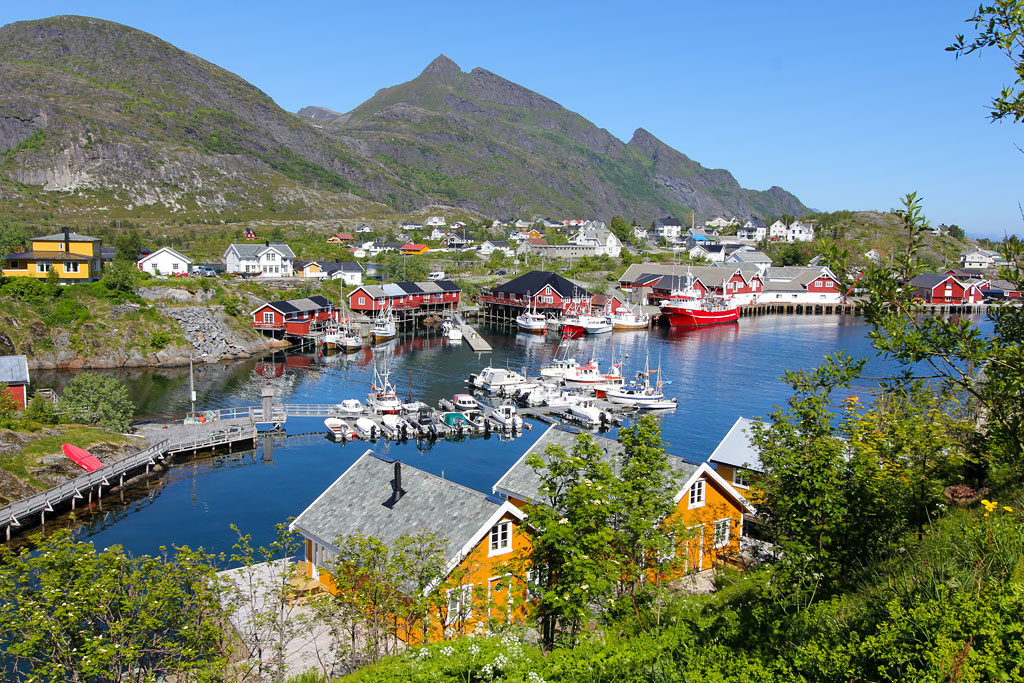
Moskenes (camping)
Pour ma part n’ayant pas le budget pour ces charmantes cabanes de pêcheurs je vais passer la nuit au camping de Moskenes (210 NOK soit 21 € pour une voiture et une tente). Il y a encore beaucoup de vent et il n’est pas évident de trouver un emplacement abrité. Les blocs sanitaires sont propres et assez grands par contre la cuisine est toute petite. Vu le nombre de personnes, notamment en camping-car, il est difficile de l’utiliser. Oui parce que pour la vaisselle par exemple, toi en tant que campeur qui voyage léger tu viens juste laver ton assiette et tes couverts mais le camping-cariste lui débarque avec sa bassine remplit d’une semaine de vaisselle et reste une demi-heure à bloquer l’évier. C’est le même qui vient dès 18h pour préparer son couscous qui prend 3 heures en utilisant toutes les plaques de cuisson. A croire que son super camping-car n’est pas équipé pour faire la cuisine et la vaisselle.
Impossible de ne pas succomber au charme de Reine. Ce village de pêcheurs est situé dans un cadre magnifique à cheval sur plusieurs péninsules et surplombé par de hautes montagnes abruptes. Reine est un peu la carte postale des îles Lofoten, c’est également le point de départ de la célèbre randonnée du point de vue de Reinebringen et du ferry qui permet de rejoindre Vindstad et la plage de Buneset .
Reine dispose d’une station service « Circle K », d’une supérette ouverte le dimanche (bien pratique pour acheter un sandwich quand tout le reste est fermé) et d’un distributeur de billets.
Début juin on trouve encore sur les nombreuses claies de bois qui entourent le village des morues en train de sécher. Les poissons décapités sont séparés, d’un côté sèchent les corps ouverts et vidés et de l’autre les têtes. Ces dernières sont destinées au marché africain où elles sont utilisées dans la confection de soupe.
Ferry Reine – Vindstad
L’été en haute saison il y a 3 départs par jour en semaine : 9h45 – 15h – 17h30 pour un temps de trajet de 20 min entre Reine et Vindstad (horaires détaillés sur la photo ci-dessous). Le bateau ne peut transporter qu’une trentaine de personnes, mieux vaut arriver en avance. De Vindstad on atteint en une heure de marche la célèbre plage de Buneset.
Une excursion populaire consiste à prendre le ferry de Reine à Vindstad, randonner jusqu’à la plage Buneset pour y passer la nuit en camping sauvage puis revenir le lendemain à Reine par le ferry. Sinon vous pouvez y passer simplement la journée (ferry retour en semaine à 17h55 et 20h50 le vendredi).
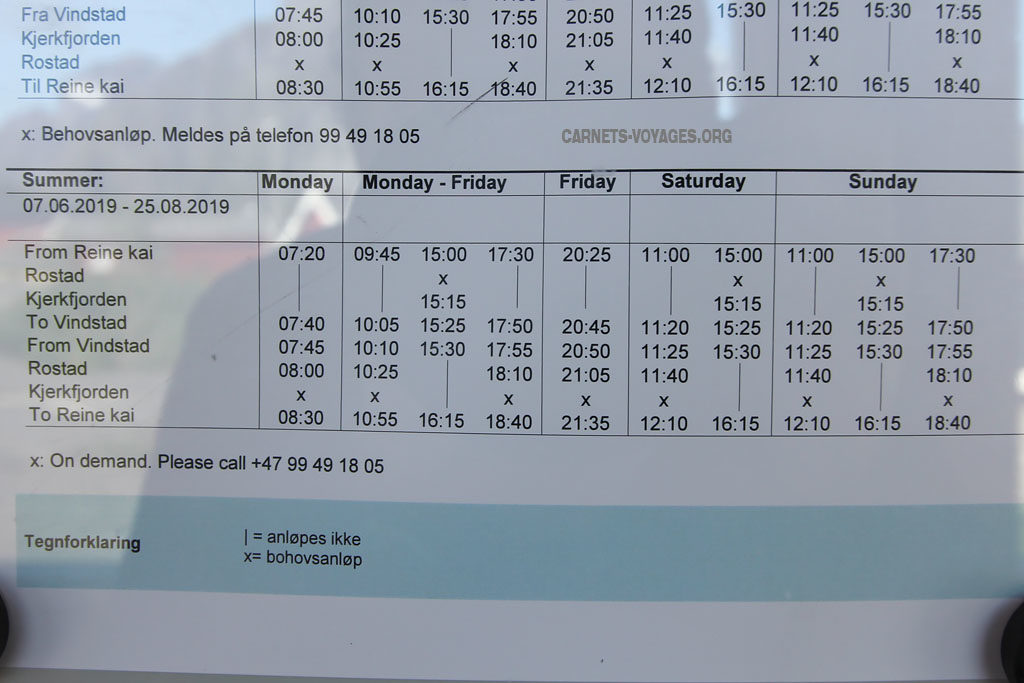
Randonnée Reinebringen
- Point de départ : Reine (juste avant le village, se garer au parking à l’embranchement avec l’E10)
- Dénivelé : +500 mètres / -500 mètres
- Distance : 2,3 km
- Altitude : entre 0 et 450 m
- Difficulté : moyenne ★★ ☆☆☆
Cette randonnée du Reinebringen n’en est pas vraiment une puisque son seul intérêt se limite à une ascension jusqu’à un sommet qui permet d’avoir un impressionnant panorama sur le village de Reine, le fjord et les montagnes . C’est l’une des vues les plus connues des îles Lofoten.
Mais j’ai bien failli ne jamais pouvoir accéder à ce point de vue ! En effet lors de mon premier passage à Reine le 11 juin, le sentier était fermé pour cause de travaux (du 4 juin au 14 juillet). Un ouvrier sur place empêchait toute personne de passer par dessus la barrière. Le sentier étant devenu trop dangereux, ils sont en train de construire des marches d’escaliers jusqu’au sommet (travaux réalisés par des sherpas par ailleurs).
Du coup je suis repassé lors de mon dernier jour et comme c’était un dimanche personne ne travaillait sur le chantier ce qui m’a permis de braver l’interdit (j’étais loin d’être le seul d’ailleurs). Les travaux avaient bien avancé puisque la majeure partie du sentier de randonnée était fait d’escaliers en pierre ce qui facilite grandement la montée. Je pense qu’au moment où vous lirez ces lignes les travaux seront terminés et rendront l’ascension au Reinebringen beaucoup plus facile qu’auparavant.
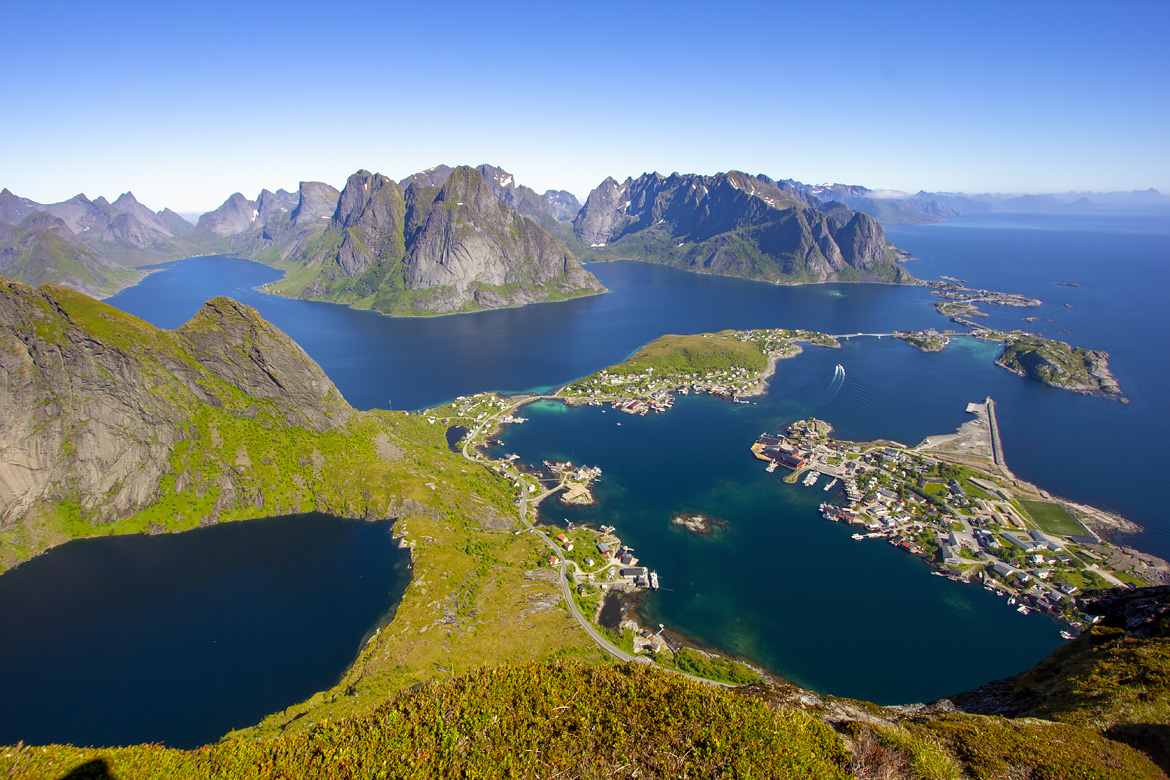
Situé sur une petite île reliée par des ponts à Hamnøy et Reine, le village de Sakrisøy offre de magnifiques panoramas avec ses cabanes de pêcheurs jaunes et son eau translucide. J’ai profité de mon arrêt photo pour déjeuner chez Anitas Sjomat, une boutique du transformeur de poisson local qui réalise de délicieux sandwichs de poisson. J’ai goûté au sandwich saumon et cabillaud, excellent mais à 160 NOK (16 €) ce fut la seule fois ou j’ai fait un écart. La terrasse à l’extérieur avec la superbe vue aide à faire passer l’addition !
Si les cabanes de pêcheurs jaunes de Sakrisøy vous plaisent, il est possible d’y passer la nuit ( Sakrisøy Rorbuer – 115 €).
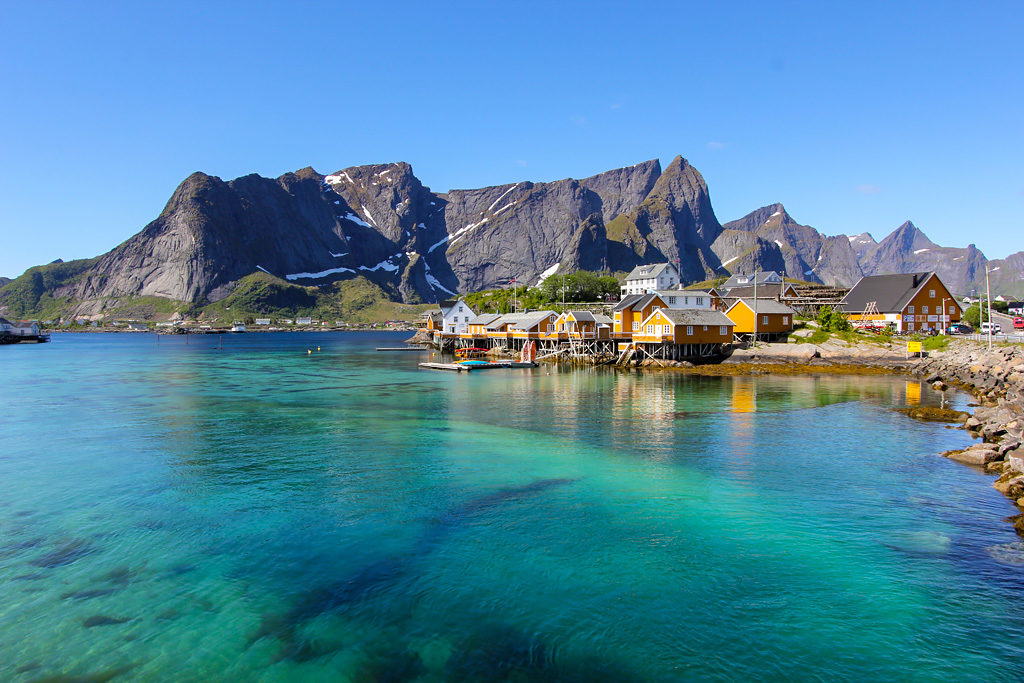
Avec ses rorbuer rouges et son immense falaise en toile de fond, le port de Hamnøy fait partie des sites incontournables à voir lors d’un road trip aux Lofoten. Le cadre est magnifique et ne doit pas vous être totalement inconnu car la photo circule souvent sur les réseaux sociaux pour représenter les îles Lofoten (le meilleur point de vue se trouve depuis le pont).
Hamnøy offre une trentaine d’hébergements en rorbuer rénovés avec tout le confort moderne si vous souhaitez faire étape dans le village (réservation auprès de Eliassen Rorbuer – 129 €).
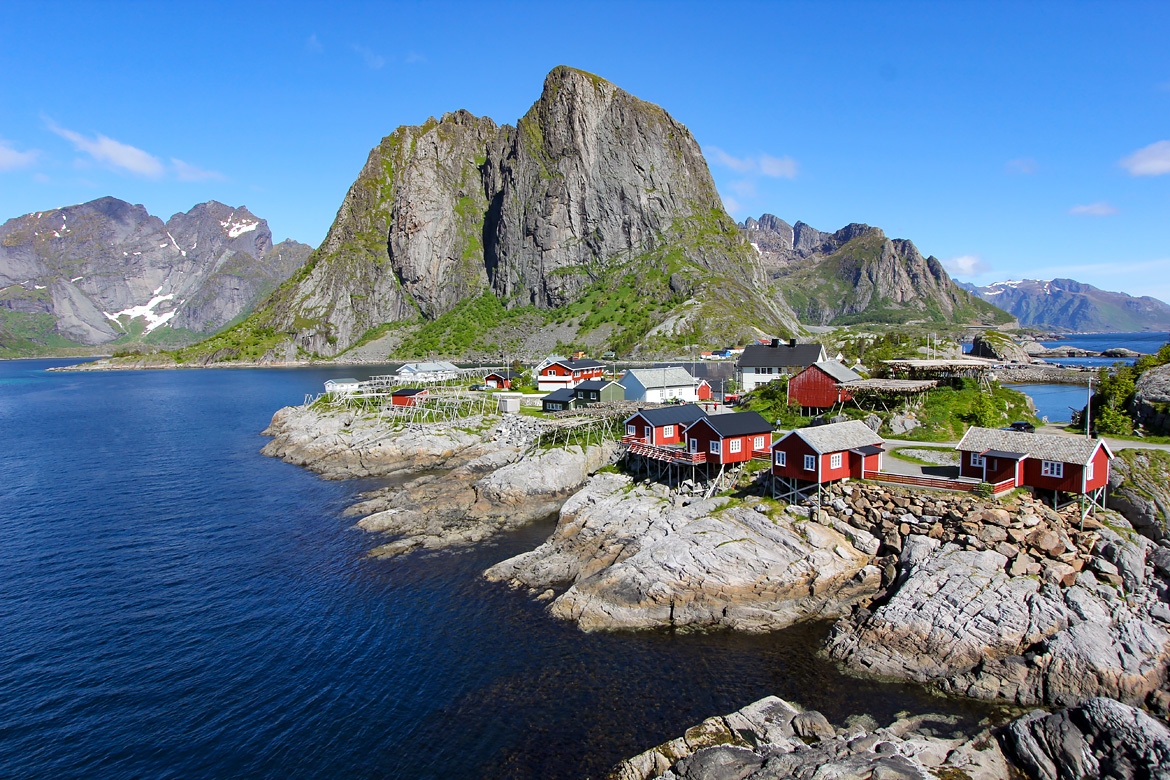
Le petit port de pêche de Fredvang situé tout au nord de l’île de Moskenesøy est accessible par deux ponts qui relie le village à l’île de Flakstadøy. Fredvang possède une superbe plage de sable blanc où il est possible de faire du camping sauvage. Si l’eau n’était pas si froide (environ 12°C) on s’y baignerait. A l’extérieur la température est de 7°C, au soleil quand il n’y a pas de vent il fait bon mais dès que le vent souffle (ce qui arrive souvent) il fait super froid.
Fredvang est le point de départ de la randonnée vers la célèbre plage de Kvalvika accessible uniquement à pied. Lors de mon premier passage la météo était assez nuageuse de l’autre côté de la montagne, du coup j’ai fait cette randonnée lors de mon retour sur Moskenes.
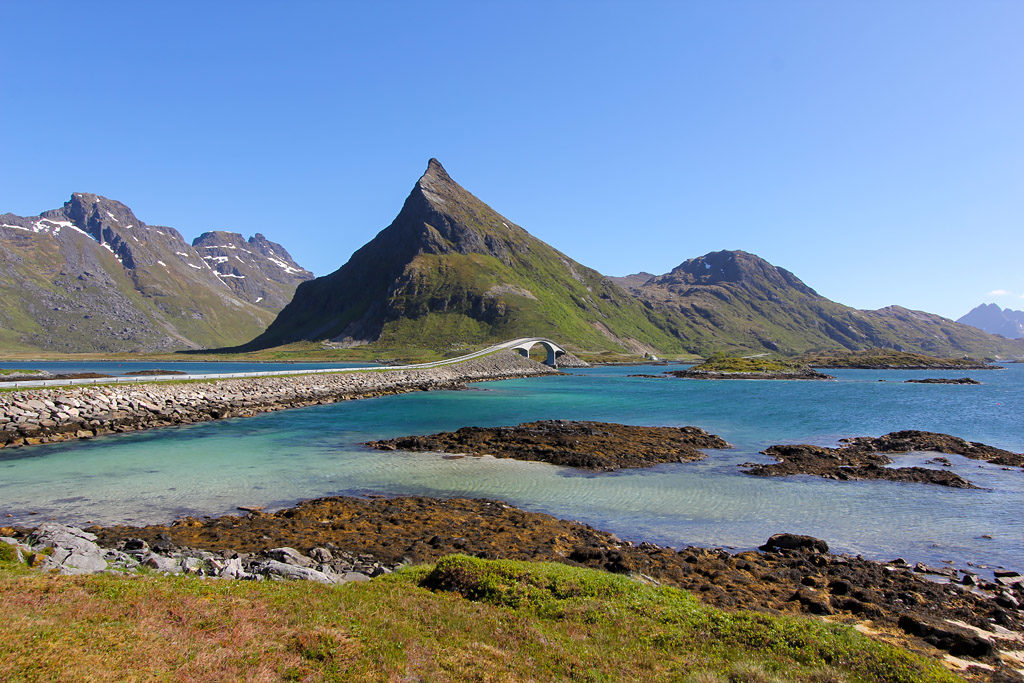
Randonnée de Fredvang à la plage de Kvalvika
- Point de départ : Fredvang (au sud du village sur la route Fv808)
- Dénivelé : +180 mètres / -180 mètres
- Distance : 3 km
- Altitude : entre 0 et 180 m
- Difficulté : facile ★★ ☆☆☆
Kvalvika (qui signifie plage de la baleine) est l’ une des plus belles plages des îles Lofoten . C’est une destination populaire auprès des touristes et randonneurs, le cadre étant prisé pour bivouaquer en camping sauvage et regarder le soleil de minuit. D’ailleurs il n’est pas évidement de trouver une place de stationnement, le petit parking Torsfjord au départ de la randonnée est vite plein.
La plage a été rendue célèbre par deux surfeurs norvégiens qui y ont passé 9 mois en construisant une cabane avec tout ce que la mer rejetait (ils en ont d’ailleurs fait un film « North of the Sun »). Sur place je n’ai pas trouvé la fameuse cabane et je n’avais pas pris soin de regarder où elle se situait exactement. Je m’attendais à une cabane au bord de la plage mais en fait elle est bien cachée dans les rochers. Elle se trouve à gauche de la plage lorsqu’on regarde la mer.
Pour un magnifique panorama vous pouvez pousser la randonnée jusqu’au mont Ryten (alt 540 m). Depuis la plage principale, il est possible d’accéder à une deuxième plage plus à l’ouest où se trouve un petit lac parfait pour y poser sa tente. Mais le sentier qui traverse un amas rocheux est assez casse-gueule et exposé au vide. Il faut s’aider de chaînes sur certains passages et plusieurs « faux » sentiers débouchent dans le vide.
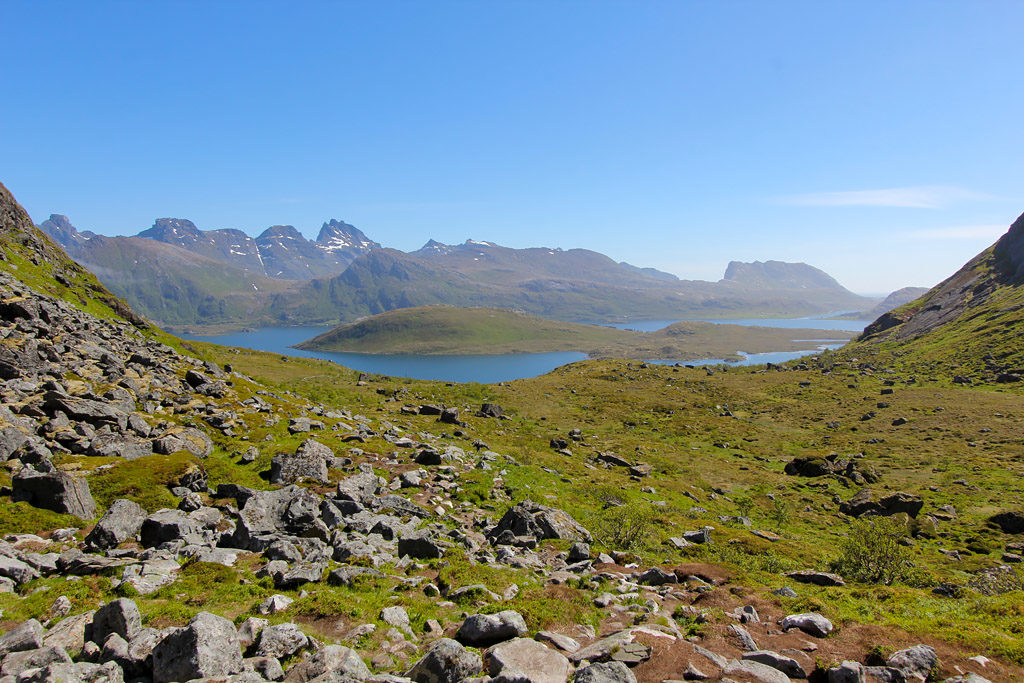
Ile de Flakstadøy
Sund ne se trouve pas forcément sur l’itinéraire d’un road trip aux Lofoten car le village est situé à l’écart de la route E10 tout au sud de l’île de Flakstadøy. Mais si vous avez un peu de temps, ce tout petit port de pêche niché au fond d’un fjord mérite le détour. Ici nous ne croiserez aucun touriste, seulement des ouvriers ramassant les morues séchées (en saison au mois de juin) pour les transformer directement dans les usines sur place.
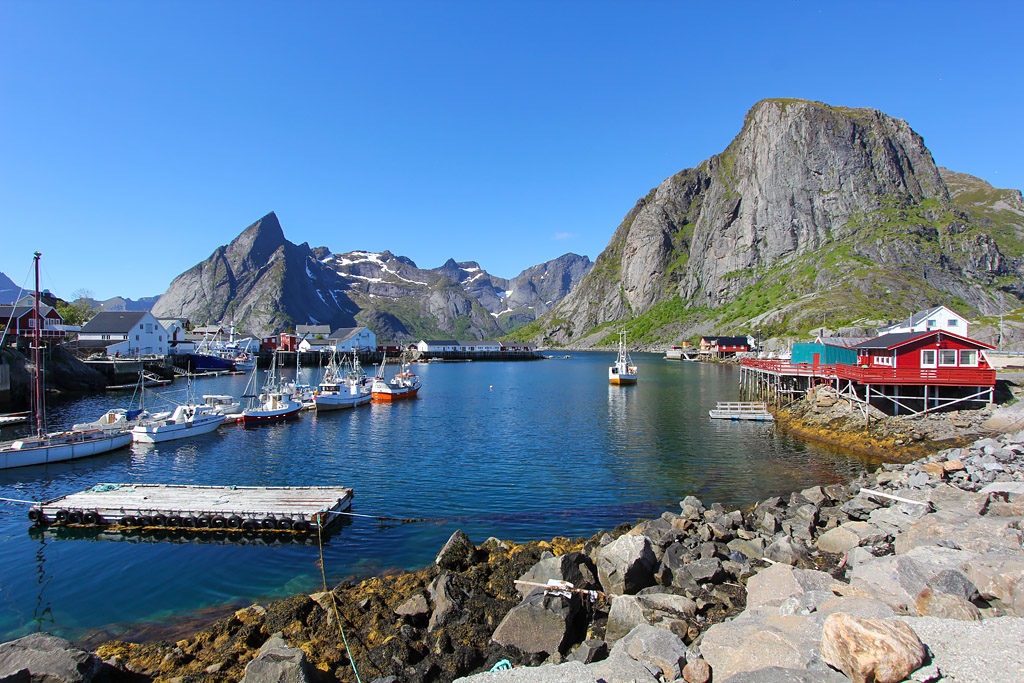
Avant d’arriver à Flakstad je m’arrête à Ramberg faire quelques courses au supermarché du village. Flakstad possède une belle plage de sable blanc, on peut également y voir une vieille église rouge construite en 1780 (visite à 40 NOK).
Je me pose pour la nuit au camping de Flakstad (Lofoten Beach Camp) situé dans un magnifique cadre au bord de la plage et entouré de montagnes. Pour une tente avec une voiture le tarif est de 200 NOK (20 €). L’emplacement est top par contre les infrastructures sont moyennes. La cuisine ne possède que 2 plaques électriques et un micro-ondes, compliqué quand on voit le nombre de campeurs (il y a environ une tente pour 10 camping-cars aux Lofoten). L’eau chaude est payante à la douche, 10 NOK pour 3 minutes et le compteur continue de tourner même si on arrête l’eau. Autant dire que vous vous pressez pour vous laver ! La machine ne prend que les pièces de 10 et 20 NOK, mettez en de côté quand vous en avez.
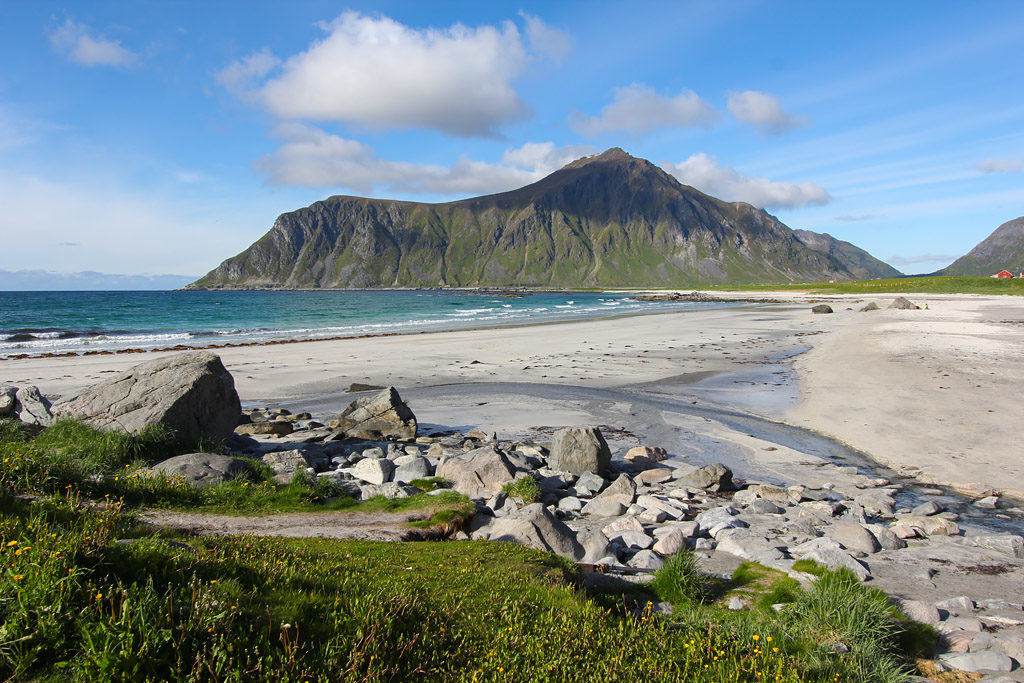
Nusfjord est l’un des sites à ne pas manquer lors d’un road trip aux Lofoten , rien que le trajet le long du fjord est magnifique. Au terme des 6 km de route on atteint le charmant petit port de Nusfjord dont les rorbuer rouges et les entrepôts jaunes sont disposés sur un quai en bois en forme de fer à cheval. Nusfjord est un village musée où l’on peut visiter d’anciens bâtiments reconstitués. On peut voir des garages à bateaux, une scierie, une fabrique d’huile de foie de morue et une boulangerie encore en activité qui vend de délicieux roulés à la cannelle (45 NOK).
L’accès au village est payant entre 10h et 18h de juin à septembre (50 NOK / pers) . Pour ma part je suis arrivé à 9h ce qui m’a permis de visiter Nusfjord gratuitement et quasiment seul avant l’arrivée des bus de tourisme.
Si le cœur (et le porte-monnaie) vous en dit, il est possible de dormir dans les magnifiques rorbuer du village de Nusfjord. Réservation auprès de Lofoten Cottages (160 €) et Nusfjord Rorbuer (220 €).
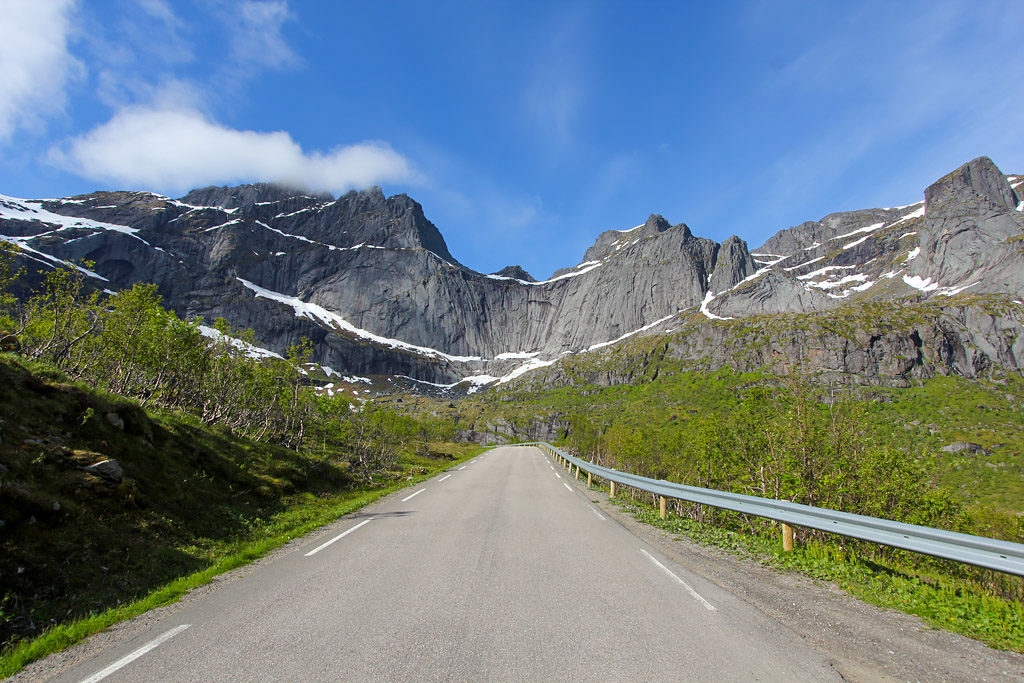
Ile de Vestvåg ø y
De retour de Nusfjord je récupère la route E10 pour continuer ma route vers le nord en direction de Leknes. Avant de quitter l’île de Flakstadøy, je m’arrête à Vareid qui possède une superbe plage aux eaux cristallines.
Ballstad était vendu dans mon guide comme un très joli port de pêche animé. Je dois avouer que je n’ai pas trouvé le port si charmant avec ses installations industrielles de transformation de poisson. Ballstad étant situé tout au sud de l’île de Vestvågøy et nécessitant de faire un détour, c’est une destination que l’on peut facilement éviter.
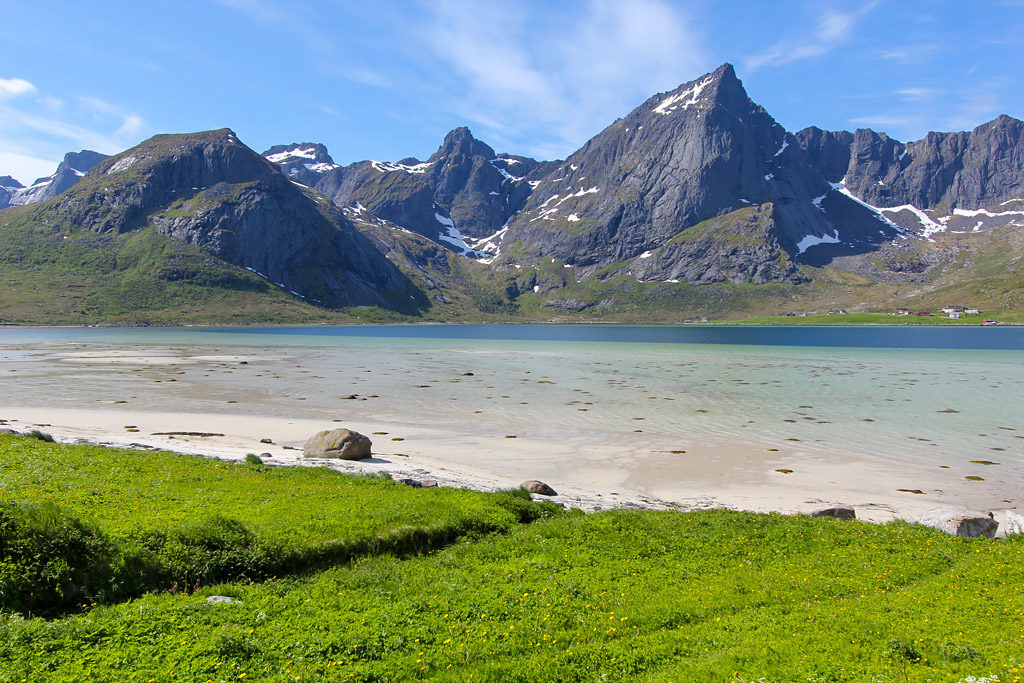
Plages Haukland et Uttakleiv
En venant du sud quittez la route principale E10 sur la gauche en direction d’Uttakleiv pour bientôt longer de superbes plages de sables blanc à l’eau turquoise (Haukland beach) . Mise à jour 2023 : le parking est maintenant payant mais il n’y a aucun contrôle (40 NOK jusqu’à 6 heures – 160 NOK pour la nuit). Toilettes publiques 20 NOK (uniquement par carte bancaire).
De la plage d’Haukland un tunnel permet de passer sous la montagne pour arriver au hameau agricole d’Uttakleiv qui possède une autre plage magnifique sur laquelle on peut observer le soleil de minuit. L’accès à la plage d’Uttakleiv est de 50 NOK (5 €) pour une voiture à déposer dans une boîte (je n’ai vu personne payer). Si vous souhaitez y passer la nuit en camping sauvage il faudra payer 200 NOK (20 €) .
Un itinéraire de randonnée que l’on peut emprunter à pied ou à vélo passe par l’ancienne route côtière qui contourne la montagne Veggen pour relier les plages Haukland et Uttakleiv. Le sentier facile de 4 km se parcourt en un peu moins d’une heure à pied.
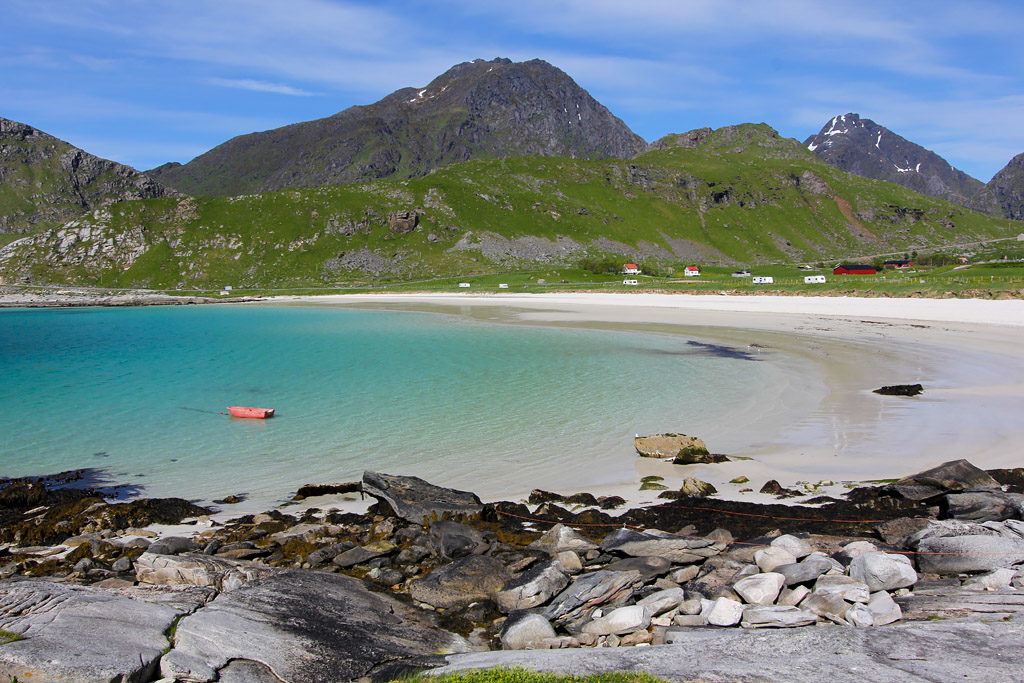
En fin d’après midi, je me dirige vers le village de Stamsund, une des escales de l’Express côtier Hurtigruten. Stamsund n’a rien de particulier à offrir et ne mérite pas spécialement le détour lors d’un road trip aux Lofoten. Cependant si vous n’êtes pas très loin, le village de pêcheur possède une charmante auberge de jeunesse située dans un vieux bâtiment en bois sur le port. Cela changera du camping pour quasiment le même prix (170 NOK ou 17 €). Il n’est pas possible de réserver en ligne, il faut téléphoner (76-08-93-34) ou venir directement sur place. L’eau chaude à la douche est payante (5 NOK pour 4 minutes) et la cuisine se fait sur un vieux poêle à bois.
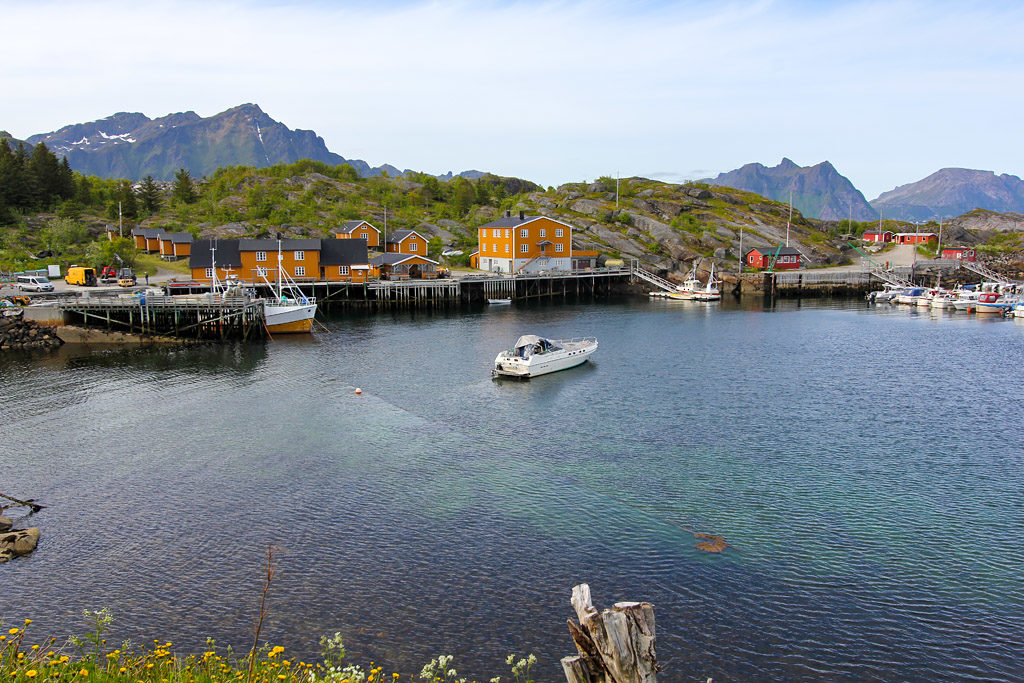
Le lendemain matin je me rends jusqu’à la jolie plage de Unstad sur la côte ouest de l’île de Vestvågøy. La route pour se rendre à ce hameau situé au fond d’un cul de sac est assez plaisante. Il faudra obligatoirement une voiture car Unstad n’est desservi par aucun bus. Le site est réputé pour le surf, on peut louer sur place du matériel, prendre des cours et même y passer la nuit ( Unstad Arctic Surf – 140 €)
Le parking pour accéder à la plage est payant (50 NOK pour une voiture) et il faudra également payer 200 NOK (20 €) pour pouvoir faire du camping sauvage sur la plage (l’argent est à déposer dans une boite).
Après un rapide aperçu des environs, je me dirige vers Eggum , point de départ (ou d’arrivée si on la fait dans l’autre sens) d’une randonnée assez connue qui relie ces deux hameaux. En quittant Unstad, je croise deux allemandes qui font du stop et qui vont justement à Eggum. Elles ont fait la randonnée de Eggum vers Unstad mais ne souhaite pas faire le chemin retour car d’après elles le sentier est assez glissant et dangereux par endroit.

Randonnée de Eggum à Unstad
- Point de départ : Eggum (ou Unstad)
- Durée : 5 heures A/R
- Distance : 9 km
- Altitude : entre 0 et 80 m
- Difficulté : moyen ★★★ ☆☆
Eggum est à l’image d’Unstad, un hameau situé au fond d’une route en cul de sac et non desservi par les transports en commun. Là aussi parking (40 NOK) et camping sauvage (100 NOK pour les tentes – 200 NOK pour les camping-cars) payants . Mais contrairement à Unstad il n’y a pas de sable sur la plage mais des rochers plus ou moins gros. Comme Eggum est orienté plein ouest, c’est un site réputé pour l’ observation du soleil de minuit .
Au départ de la randonnée entre Eggum et Unstad se situe un ancien bunker de la deuxième guerre mondiale ainsi qu’un café. L’itinéraire passe rapidement devant un grand lac puis suit le littoral. Sur les deux tiers du parcours, le sentier ne présente aucune difficulté, j’ai quand même contourné à plusieurs reprises des brebis et leurs agneaux qui étaient posés sur le sentier car elles me regardaient avec une drôle de tête. En se rapprochant d’Unstad le sentier devient plus compliqué, c’est pour cette raison que j’ai classé la difficulté à « moyen ». Il y a des passages très glissants et casse gueule où le chemin se retrouve exposé au vide, évidemment sans aucune protection. Il faut escalader de gros blocs de pierres et vu qu’il n’y a aucun balisage il faut souvent chercher la bonne trace pour ne pas finir sur un à-pic. Une chaîne faisant office de main courante permet d’avancer sur certains passages exposés au vide.
Pour le pique-nique j’avais acheté un pain pizza au supermarché (19 NOK) et j’ai mangé des morceaux de morue séchée que j’avais pris à Sakrisøy (on en trouve également dans les supermarchés), j’ai trouvé ça très bon et j’en ai même ramené en France.
Bien que la cadre soit joli, cette randonnée assez longue est plutôt monotone car le paysage reste le même tout le long du trajet (5 heures) et les passages dangereux ne rendent pas la progression agréable. Si vous ne souhaitez pas vous lancer sur cette rando ou manquez de temps, le mieux est de partir d’Unstad et de marcher sur à peu près 1 km , c’est de là que vous aurez le plus beau point de vue sur la plage d’Unstad.

Eggum : excursion en kayak de mer
Pour changer des randonnées pédestres je vous recommande une sortie en kayak de mer au soleil de minuit . Le point de départ de cette excursion de 4h30 se trouve à Eggum (emplacement exact en cliquant sur le lien). Équipé de combinaisons étanches et de kayaks biplaces vous découvrirez les paysages des Lofoten sous un nouvel angle tout en pagayant. Une fois arrivé sur une plage isolée, le guide préparera un barbecue avec des produits locaux .
Northern Explorer propose d’autres sorties en kayak allant de 3h à 7h dont vous retrouverez le programme sur cette page .
Randonnée de Blaheia
- Point de départ : Valberg
- Dénivelé : +700 mètres / -700 mètres
- Distance : 12 km
- Altitude : entre 0 et 551 m
J’ai réalisé cette randonnée lors du trajet retour de Svolvær à Moskenes. J’ai d’ailleurs fini mon trek à 21h mais grâce au soleil de minuit on peut randonner jusqu’à pas d’heure. La randonnée de Blaheia que j’ai trouvé sur le site rando-lofoten offre un superbe panorama sur l’île de Vestvågøy . Le sentier est peu fréquenté, je n’ai croisé personne durant mes 5 heures de marche mis à part quelques moutons (couverture par la réseau mobile en cas d’urgence).
Le départ de la randonnée de Blaheia se situe 450 m avant le hameau de Valberg en venant du nord sur la route 815. Il faut emprunter une piste en terre sur la droite qui mène à une barrière, c’est ici qu’il faut se garer. Le début du sentier est assez plat et longe une rivière avec quelques passages boueux avant de déboucher sur un joli point de vue. C’est à partir de là que commence véritablement l’ascension de la montagne, à vrai dire je me demandais vraiment comment j’allais pouvoir monter. Le sentier est très peu visible et il faut escalader les blocs de pierres pour avancer. Il restait encore quelques plaques de neige en cette saison que j’ai traversé sans soucis.
Du sommet la vue à 360° sur l’île de Vestvågøy est magnifique, par contre il y a énormément de vent et il est glacial. Je suis équipé de gants, bonnet, pull et coupe-vent même en plein soleil.
De retour à la voiture je rejoins un camping situé à quelques kilomètres de là en bord de mer, Brustranda Sjocamping, 250 NOK (25 €) pour une voiture et une tente. Il était possible de faire du camping sauvage au départ de la rando mais j’avais envie de prendre une bonne douche chaude après ce trek.
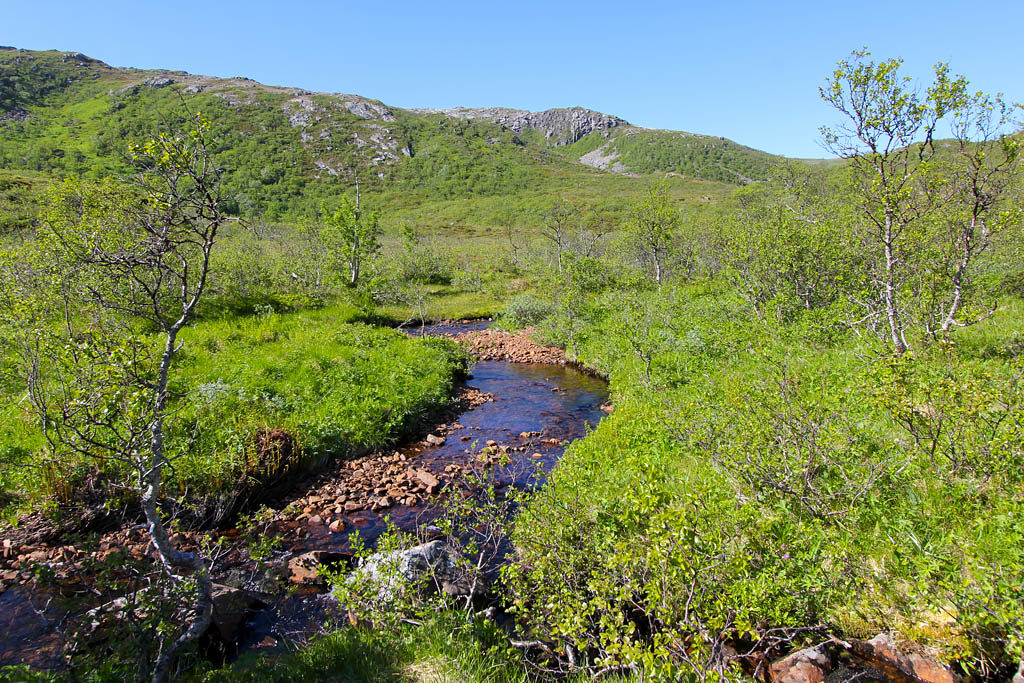
Ile d’Austvåg ø y
Henningsvær.
En fin de journée (après la randonnée de Eggum à Unstad) je rejoins Henningsvær situé tout au sud de l’île d’Austvågøy, la dernière des îles que je visiterai lors de mon road trip aux Lofoten. Le village de pêcheur, le plus grand des Lofoten, se trouve disséminé sur plusieurs îlots reliés entre eux par des ponts. Henningsvær est même surnommée la Venise des Lofoten à cause de toute l’eau qui entoure le village. La destination est assez touristique mais heureusement à 19h la foule a déserté les lieux, ce qui me permet de profiter tranquillement de cette belle lumière de début de soirée (en cette saison il ne fait jamais nuit aux Lofoten).
A 10 km au nord de Henningsvær j’ai trouvé un camping dans un cadre superbe au bord de la mer, le Lyngvaer Lofoten Bobilcamping. Le tarif est de 245 NOK (25 €) la nuit pour une voiture et une tente. Les parties communes sont bien aménagées (wifi gratuit), mais comme souvent l’eau chaude est payante à la douche (10 NOK pour 6 min).
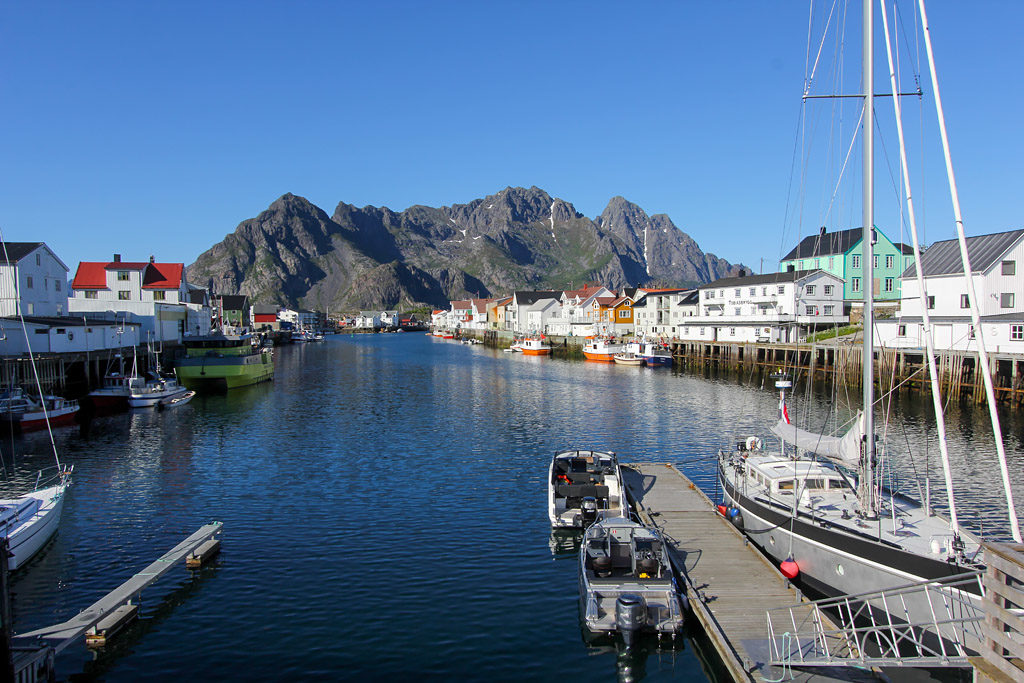
Charmant village avec ses maisons colorées situé à 5 km au sud de Svolvær sur la route principale E10. Kabelvåg possède également une jolie église du début du XII e s, mais l’entrée est payante (40 NOK) ce que je trouve toujours abusé pour une église.
Pour découvrir les îles Lofoten d’une autre manière vous pouvez participer à un safari nature en kayak de mer . Au cours de cette excursion, vous découvrirez des paysages à couper le souffle, des montagnes impressionnantes, des petites îles, des villages de pêcheurs pittoresques et des plages. Vous pourrez également apercevoir des baleines, des phoques et des marsouins, ainsi que de nombreux oiseaux. Vous pouvez vous inscrire sur ce site pour ce safari nature en kayak de mer (durée 2 heures).
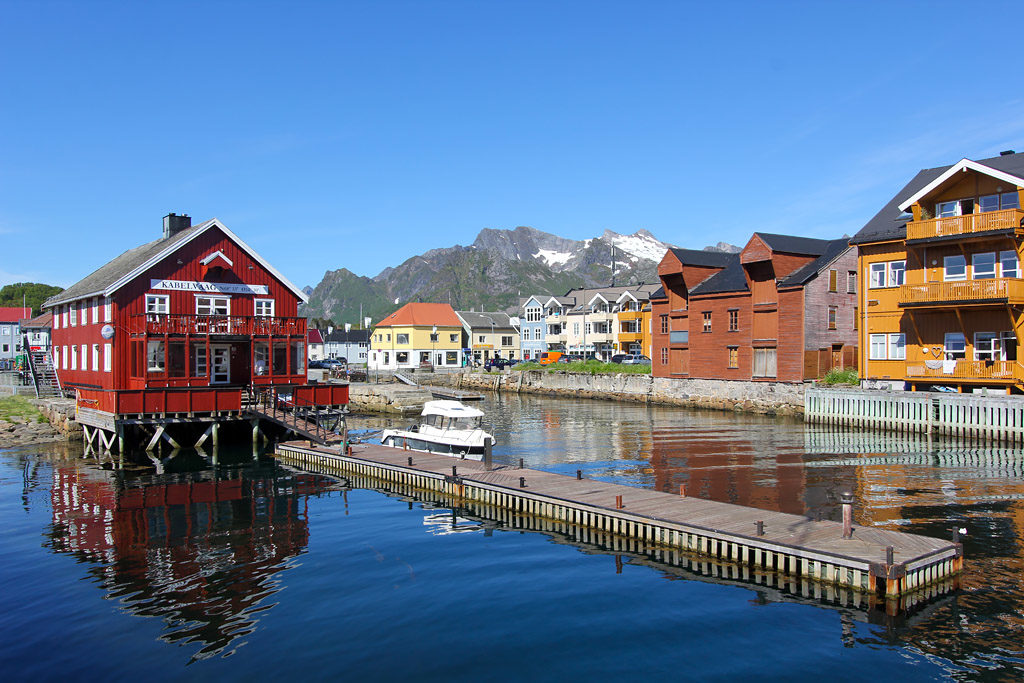
Dernière étape de mon road trip aux îles Lofoten, Svolvær est la capitale de l’archipel avec tout ce que l’on peut trouver comme services : cafés, magasins de souvenirs, excursions, supermarchés et centres commerciaux. Svolvær fait partie des escales de l’Express côtier Hurtigruten, je ne sais pas si c’est pour cette raison mais il y avait beaucoup de touristes en ville, je ne me suis pas trop attardé.
Hormis la possibilité de faire des achats (les supermarchés sont les moins chers des Lofoten) Svolvær n’offre guère d’intérêt , je suis monté jusqu’ici « pour voir » mais la ville peut facilement être évitée si vous avez peu de temps pour un road trip aux Lofoten ou que vous ne prenez pas le ferry.
J’en profite tout de même pour faire quelques courses au supermarché (213 NOK) et pour manger un sandwich au saumon (99 NOK) chez Kringla Bakeri situé sur la place principale de Svolvær.
Pour savoir tout ce que la ville propose je vous invite à lire mon article que faire à Svolvaer que j’ai écrit suite à mon second road trip aux îles Lofoten.

Excursions au départ de Svolvær
Toutes les excursions organisées et les visites guidées se font au départ de Svolvær. Si vous n’avez pas de moyen de locomotion (dans le cas où vous voyagez avec le bateau Hurtigruten par exemple) et préférez vous laisser guider plutôt que d’ organiser votre voyage aux îles Lofoten , cela peut être une solution. Vous trouverez via les activités ci-dessous (cliquez sur l’une pour en découvrir d’autres), tout un tas d’excursions pour découvrir les îles Lofoten en dehors d’un road trip. Croisière, observation des animaux, pêche en mer, visite photographique, aventure en kayak ou observation des aurores boréales sont des exemples d’excursions possibles aux îles Lofoten.
Lors d’un second voyage aux îles Lofoten réalisé en mars 2023, j’ai testé la croisière sur le Trollfjord que je vous recommande. Elle permet d’observer de magnifiques paysages et de voir des aigles de mer.
Fin du road trip aux Lofoten : retour à Moskenes puis Bodø
Je redescends ensuite jusqu’à Moskenes pour prendre le ferry vers Bodø (au passage celui-ci avait deux heures de retard). Il y a beaucoup plus de monde qu’à l’aller mais le ferry n’est pas complet. Arrivé à 20h30 à Bodø je fais le plein de la voiture (l’essence est moins chère ici qu’aux Lofoten) et me rend au même camping que lors de mon arrivée. La boucle de ce road trip d’une semaine aux îles Lofoten se termine avec 560 km au compteur.
J’ai vraiment adoré ce road trip aux îles Lofoten. J’ai en plus profité d’un soleil magnifique pendant presque tout mon séjour, ce fût sans aucun doute l’un de mes plus beaux voyages nature et randonnée . J’ai tellement aimé cet archipel que je pense y revenir en hiver pour profiter des aurores boréales et d’une tout autre ambiance.
J’ai finalement réalisé ce voyage quelques années plus tard en mars 2023. Je vous invite à lire mon article sur les îles Lofoten en hiver . Si vous aimez les paysages enneigés de la Norvège je vous conseille aussi l’article sur mon séjour à Tromso .
Les îles Lofoten en Norvège : comment organiser son voyage
Visiter düsseldorf : les 10 choses à faire et voir, vous aimerez aussi, j’ai testé la croisière au trollfjord en norvège, que faire aux îles lofoten en hiver, trondheim, roros et lillehammer en norvège, nyksund, le village de pêcheurs abandonné en norvège, que faire à svolvaer dans l’archipel des lofoten, visiter les îles vesteralen en road trip, 62 commentaires.
Bonjour, Projetant de partir au mois de juin 2020, j’ai pris un grand plaisir à vous lire et à regarder vos photos. Merci pour ce super compte rendu. Petite question: Y avait-il encore beaucoup de neige sur les hauteurs? Cordialement.
Bonjour JeanSeb, Il n’y a pratiquement plus de neige au mois de juin à part quelques plaques par ci par là sur les sommets (notamment dans les zones à l’ombre). Cela ne pose aucun soucis pour la randonnée en tout cas.
Merci beaucoup pour toutes ces informations précieuses qui vont m’aider à organiser mon voyage. J’y serai en Avril 2020, j’ai hâte ! Pouvez vous me dire quels objectifs vous avez utilisé pour vos photos, qui sont juste sublimes ? Merci
Merci Ana 🙂 J’ai un Canon 10-22, le grand angle est indispensable pour capter la grandeur des paysages des îles Lofoten.
Bonjour merci pour ce récit .., j y vais au mois de mai 8 jours. Je prends l avion à Narvik et j arrive de la aussi c est jouable en 8 jours et en flânant du Nord au sud? Merci
Bonjour Robert, en 8 jours vous aurez le temps de voyager tranquillement au départ de Narvik.
Bonjour, Je viens de passer un bon moment grâce à votre magnifique reportage. Comme l’a dit Ana, vos photos sont splendides 🙂 Merci
Merci Marie, content que mon compte rendu vous ai déjà fait voyager 🙂
Quel beau carnet ! Cela confirme mon envie d’aller faire un roadtrip sur ces îles ! Est-ce que cela semble envisageable avec un enfant de 18 mois ?
Merci Anaïs 🙂 Pas de soucis pour y aller avec un enfant de 18 mois, la Norvège est un pays très moderne et vous trouverez toutes les infrastructures nécessaires même en cas de problèmes. Au vu du vent et du froid qu’il peut faire aux îles Lofoten il faudra juste bien le couvrir.
merci pour ce joli carnet de voyage! Sylvie
Bonjour et merci pour votre splendide carnet de voyage ! 👌
Il est vraiment très plaisant à lire et c’est un régal pour les yeux. Je vais m’en inspirer pour établir mon itinéraire, nous avons un projet de 9 jours aux Lofoten en bivouac et camping l’an prochain début juin en espérant que les frontières soient de nouveau ouvertes bien sûr.
Nous partirons de Narvik en passant les îles Vesteralen puis on descendra doucement vers le sud des Lofoten 😊
Merci Johan 🙂 Très bel itinéraire et en 9 jours vous avez le temps. Profitez bien de votre séjour aux îles Lofoten, c’est l’un de mes plus beaux voyages j’y retournerai volontiers.
Bonjour, Merci pour ce beau récit, cela confirme notre envie d’y aller au printemps prochain ( on va croiser les doigts ) Est-il possible de connaitre le prix de la traversée en ferry de Bodo à Moskenes ? Avez-vous un site à nous recommander pour reserver celle-ci ? Merci d’avance pour votre retour !
Bonjour Anaïs, le tarif pour la traversée Bodo Moskenes en ferry + voiture est de 913 NOK. Tu trouves toutes les infos ainsi que le site pour la réservation du billet de ferry sur l’article organiser son voyage aux îles Lofoten .
Super carnet de voyage, vos photos sont splendides. Chapeau bas. Je vais m’en inspirer pour faire mon voyage, cela me sera plus qu’utile. je croise les doigts pour que d’ici juin les frontières seront ouvertes. Yamani
Merci beaucoup, j’espère que les frontières vont vite rouvrir et que vous pourrez y aller, c’est tellement beau !
Bonjour, je prepare un voyage en camping car pour juin/juillet 2022 à partir de l’Auvergne jusqu’au cap nord en passant par les iles Lofoten, merci pour ces infos et ces magnifiques photos. j’ai pris note de vos aides precieuses. bravo et continuez comme ca !!!
bonjour Nous aussi ns partons debut juin pour le cap nord a partir de la Loire. Peut être pourrions ns échanger des infos notamment sur le parcours que vs avez prévu Cordialement alain
Je viens de vous lire…….super intéressant, je voulais faire un voyage cet été en Norvège, du sud jusqu’au Cap Nord, c’est très compromis, les frontières en Norvège sont toujours fermées
J’espère que les frontières de la Norvège vont rouvrir très vite et que les voyages seront à nouveau possible cet été. En tout cas beau projet, vous allez adorer !
Magnifique, je voudrais les visiter, mais savez à quelle période je pourrais observer les orques et les baleines aux Lofoten. Merci pour votre partage
Bonjour, je ne crois pas qu’il y ait des excursions observation des baleines ou orques directement depuis les îles Lofoten, pour cela il faut aller plus au nord. Pour les baleines on peut en voir toute l’année. En été essentiellement des cachalots avec possibilité d’orques ou globicéphales. En hiver baleines à bosses, rorquals communs et orques.
bonjour Mushu votre carnet de voyage est sublime et très intéressant! vous ne parlez pas de la possibilité de se déplacer en vélo (électrique en ce qui me concerne), l’itinéraire que vous suggérez vous parait il accessible en 2 semaines en prenant notre temps et en s’arrêtant dans 3 ou 4 lieux étapes pour le logement. merci pour vos conseils
Bonjour Nathalie, il est tout à fait possible de visiter les Lofoten à vélo, j’ai d’ailleurs croisé plusieurs cyclistes lors de mon road trip. Il faudra juste adapter les étapes en fonction de votre niveau. Les routes ne sont pas plates (sans qu’il y ait de gros dénivelés non plus) et il y a souvent du vent. Le mieux est de poser sur papier tout votre itinéraire avec le nombre de km à parcourir à vélo en plus des visites ou rando, et de voir si cela vous semble possible. Bon voyage et n’hésitez pas à me faire un retour de votre voyage à vélo aux îles Lofoten 😉
Bonjour et merci pour ce blog qui m’aide à organiser mon voyage pour août 22, vous donnez pleins de détails et c’est top, c’est toujours intéressant d’avoir les retours des voyageurs et de plus avec de belles photos. Je pars essentiellement pour découvrir le grand air mais aussi pour rapporter de beaux clichés ! J’ai pu lire que nous pouvons donc apporter dans notre bagage à soute l’essentiel pour le camping (compagnie Norwegian) mais également nourriture, vous me confirmez que je peux emmener tente et matelas et quelques provision ? J’aurais voulu savoir également si malgré le fait que je ne parle pas très bien l’anglais je n’aurais pas trop de mal à me déplacer par exemple panneaux signalitiques ? En tout cas mille fois merci pour ce retour détaillé qui va m’aider et qui a dû aider plus d’un(e)s
Bonjour, je vous confirme vous pouvez emporter tout votre matériel de camping dans la soute de l’avion. C’est ce que j’ai fait (j’ai également pris Norwegian) et j’avais ma tente, mon sac de couchage, mon matelas et même de la nourriture. La seule chose qui est interdite c’est d’emmener une cartouche de gaz. Il faudra l’acheter sur place dans une station service par exemple. Pour les panneaux aucun soucis, en général c’est les mêmes qu’en France, il y a une harmonisation au niveau mondial pour justement que tout le monde comprenne.
Bonsoir bravo de ce superbe blog , une invitation au voyage. svp nous manquons de temps pour préparer ce voyage aussi j ose vous demander les lieux ou vous avez passé vos nuits
Bonjour, tout est indiqué dans l’article mais pour résumé j’ai passé mes nuits à : Moskenes, Flakstad, Stamsund, Valberg et Henningsvær.
Mushu D abord un grand Merci pour votre rapide réponse mais c est pas evident, je doutais de la partie Moskenes- Flakstad , il y a un grand nombre de centres d interets, 8 dont 5 semblent incontournables, tout ça dans une journée et il y a le retour , je crois comprendre qu il se fait avec la nuit sur Valberg
si je résume , sous votre controle à l aller MOSKENE FLAKSTAD STAMSUND HENNINGSVAER au retour Valberg
Dans l affirmative ne conseillerez vous pas autrement les nuités , je pense à consacrer plus de temps aux iles Moskenoy et Flakstadoy et réduire sur les iles superieures
merci encore du temps que vous nous consacrez
nous espérons pouvoir vivre le même voyage
Pour l’ordre des nuits passés sur place c’est bien ça. Mon road trip aux îles Lofoten n’est qu’un exemple de ce qu’il est possible de faire, évidemment bien d’autres itinéraires existent. Je suis d’accord avec vous, les iles Moskenoy et Flakstadoy sont les plus jolies et c’est celles où je conseille de passer le plus de temps. Il faut savoir que j’ai du faire les randos de la plage Klavika et de Reinebringen au retour à cause de la météo. Au final c’est sur ces deux îles que j’ai passé la plupart de mon séjour et c’est là qu’il y a le plus de sites incontournables à voir. Tout dépend du temps que vous restez sur les îles Lofoten, j’ai eu le temps de tout voir lors de mon road trip d’une semaine sans me presser. Si vous partez au moins 7 jours vous pouvez vous inspirer de mon trajet sinon privilégiez le sud de l’archipel. Si vous voyagez en tente vous n’avez pas besoin de trop préparer à l’avance et vous pourrez adapter le voyage sur place en fonction de ce qui vous plait ou de la météo.
Mushu , merci encore de votre aide , nous reviendrons surement vers vous , ce projet avec vos éléments a de fortes chances d aboutir bonne fin de journée et à bientôt
Merci Mushu pour votre récit . C’est très complet ! Nous projetons de partir début Septembre et se reposer principalement sur votre parcours . Mais vu qu’on ne parte pas en juin (comme vous), faut-il adapter notre parcours ?
Cordialement, Seif
Vous pouvez utilisez le même itinéraire aux îles Lofoten que moi pour le mois de septembre. La seule différence c’est que vous n’aurez pas de soleil de minuit et les journées seront plus courtes (en gros de 6h à 20h).
Bonsoir Mushu Comme prévu nous revenons vers vous, nous avons les billets mais il n y a plus en juillet de logement à un prix raisonnable svp que nous conseillerez vous comme équipement pour le camping
merci encore pour le temps que vous nous consacrez
Bonjour Christophe, je détaille tout le matériel nécessaire (et celui que j’ai utilisé) sur l’article organiser son voyage aux îles Lofoten . Le plus important est d avoir une bonne tente. En juillet il fait pas froid donc pas besoin d un sac de couchage hyper chaud. Ne pas oublier un bon tapis de sol non plus (ça isole du froid du sol et c’est plus confortable).
Bonjour Mushu ! Je suis bien d’accord avec tous, votre carnet est magnifique ! Nous avons également fait le sud de la Norvège en 15 jours il y 4 ans et au mois d’août nous projetons de visiter les îles Lofoten. Arrivée à Narvik et départ de Bodo. Pensez-vous que 15 jours soient une durée trop « longue », sinon quels seraient les lieux à privilégier pour y séjourner plus longtemps. Merci d’avance pour votre retour. Cordialement. Raphaëlle
Bonjour Raphaëlle, A part si vous comptez faire beaucoup de randonnée, 15 jours me semble un peu long pour explorer les îles Lofoten. Vu que vous arrivez à Narvik je vous conseille de visiter les îles Vesterålen en cours de route. C’est un peu la même chose que les Lofoten en un peu moins spectaculaire. Si vous le faites au début c’est mieux car le plus beau se trouve aux îles Lofoten 🙂 Sinon il y a l’île de Senja qui est très jolie aussi mais c’est quand même à 160 km au nord de Narvik. Si vous n’avez pas peur de rouler monter jusqu’à Senja, vous pourrez ensuite prendre un ferry qui vous ramènera tout au nord des îles Vesterålen (Andenes). Peu importe votre choix cela restera un magnifique road trip ! 🙂
Merci beaucoup pour votre retour, je vais faire notre itinéraire en fonction. En tout cas j’ai hâte 🤩 !
Super article. Très bien structuré et détaillé: donc très utile, merci! On compte se rendre dans les Lofoten debut Octobre, pour voir des aurores Boréales. Sais tu si c’est déjà bien ennéigé à cette période et si c’est jouable d’y aller en louant une voiture depuis Tromso ? On planifie 8/10 jours (avec l’A/R à Tromso) ca te parait correct ?
Début octobre je ne pense pas qu’il y ait de la neige, ou alors que sur les sommets. Mais bon la météo étant difficile à prévoir à l’avance c’est dur de se prononcer. En tout cas aucun soucis à se faire, même s’il y a de la neige les routes sont bien déneigées et les voitures de location sont équipées de pneus cloutés en hiver. J’en parle dans mon article sur Tromso car j’y suis allé en hiver. Par contre je trouve que faire l’aller retour Tromso Lofoten en 8/10 jours cela fait beaucoup de route (420 km rien que pour aller à Svolvaer). Pourquoi ne pas louer la voiture directement à Bodo ou sur place ? Au prix de l’essence cela revient assez cher de partir de Tromso pour faire un road trip aux îles Lofoten. Par contre si vous souhaitez visiter les 2 régions cela me semble trop court niveau timing. Pour ma part je suis resté 1 semaine aux Lofoten et 5 jours à Tromso.
Carnet de voyage remarquable. Nous sommes allés en Norvège (Bergen-trondheim) en 2018 et envisageons les Lofoten pour fin juillet l’été prochain, si nous partons 15 jours avec un camping car pensez vous qu’il vaut mieux d’abord aller vers Narvik / Tromso et finir par les iles ou le contraire ? Nous arriverons de Bodo.
Merci pour votre message ! J’avais commencé mon 1er voyage en Norvège par le sud également et c’est déjà le 3ème 🙂 Concernant l’itinéraire de votre road trip je n’ai pas trop de conseil pour le coup. A partir du moment où vous faîtes l’aller retour cela revient au même. Il n’y a pas de meilleur ordre. Je vous suggère d’adapter l’itinéraire en fonction de la météo, qui est très changeante dans cette région et peut être différente à quelques dizaines de kilomètres. Si vous voyez qu’il fait beau lors de votre arrivée allez directement aux îles Lofoten (c’est la partie la plus belle). En été vous pouvez passer par l’île de Senja puis prendre le ferry jusqu’à l’ile de Sommaroy avant de finir à Tromso. J’en parle dans mon guide de voyage à Tromso .
Bonjour Mushu,
Votre carnet de voyage est juste dingue ! Je pars dans les Lofoten la semaine prochaine en arrivant à Tromso par avion. Mais je ne sais pas si il vaut mieux tracer sur les 5 premières heures de voiture pour rejoindre rapidement la pointe y passer la semaine, ou bien y aller plus tranquillement et passer un peu plus de temps dans les « terres » entre Tromso et les Lofoten. Savez-vous si cela vaut le coup de partir tête baissée vers les Lofoten sans se préoccuper des paysages proches de Tromso ?
Bonjour Étienne, c’est dommage d’arriver à Tromso pour débuter un road trip aux îles Lofoten, c’est pas l’aéroport le plus proche 🙂 Entre Tromso et Svolvaer vous pouvez visiter l’île de Senja et les îles Vesterålen, mais les paysages ne sont pas aussi spectaculaires qu’aux îles Lofoten. Tout dépend du nombre de jours dont vous disposez pour votre itinéraire. En automne vous ne pouvez pas prendre le ferry entre Sommaroy (proche Tromso) et Senja, ce qui demande donc de faire un bon détour. Pour profiter pleinement des choses à voir sur le trajet et découvrir les îles Lofoten tranquillement il faudrait 2 semaines. Si vous n’avez qu’une seule semaine foncez directement vers les Lofoten en faisant à la limite un stop avant.
Bonjour Mushu, Je vous remercie pour votre article. Il est magnifique et nous a été très utile. Nous partons ce mois d’août pour 9 jours avec notre fils de 2 ans. Nous arriverons à l’aéroport de Narvik en soirée et resterons donc la nuit à l’hôtel best western. Nous prendrons la route le lendemain pour aller à Reine où nous resterons 4 nuits. Nous prévoyons de faire un arrêt à Svolvaer pour couper le trajet en 2. Pour la deuxième partie de notre voyage, nous avons réservé un hébergement à Kleppstad afin de visiter Henningsvær, Kabelvag, Lyngvaer et ses alentour. Qu’en pensez-vous ? Autre point, je me demandais comment-avez vous procéder pour les paiements, paiement majoritaire en espèce ou carte. Si vous avez effectué des paiements en espèce. Où avez-vous fait le change ? A l’aéroport ? Je vous remercie d’avance pour votre retour.
Bonjour James, votre programme me parait bien. Nous sommes également passés par l’aéroport d’Harstad/Narvik lors de notre deuxième road trip aux îles Lofoten. Vous pouvez si vous avez le temps visiter les îles Vesteralen sur l’itinéraire. La partie la plus jolie des Lofoten est au sud, avec 4 jours à Reine vous aurez le temps d’en profiter pleinement. Pour les paiements tout se paye par carte bancaire en Norvège, quasiment personne n’utilise d’espèces. Lors de mon second voyage cette année j’ai exclusivement utilisé la carte bancaire. A l’aéroport il n’y a plus de vrai bureau de chance mais seulement des machines automatiques. Vous pouvez aussi retirer de l’argent dans un distributeur.
Merci pour ce partage! Je serai aux Lofotens pour 10 jours en fin mai 2024. Je pense louer une voiture à Moskenes. J’arriverai par le traversier de Bodo. J’aimerais réserver deux hébergements pour pouvoir rayonner et découvrir les Lofotens. Quels endroits (hébergements) me conseillez-vous? Merci!
Bonjour Lise, je te conseille de réserver deux hébergements pour ton road trip aux îles Lofoten. Un dans le sud de l’archipel et un au centre ou au nord. Pour le sud je te recommande le Sakrisøy Rorbuer , on y était cet hiver et on a adoré les petites cabanes jaunes au bord de l’eau. Le cadre est magnifique et l’hébergement super charmant. Pour le deuxième hébergement tu peux aller à Henningsvær par exemple, on a apprécié le Henningsvær Rorbuer .
Bonjour Mushu, Je planifie avec mon épouse un road trip aux iles Lofoten, pour le mois de juin 2024, d’une durée de +/- 8 jours. Nous partirons de Bodo. Je vois que lorsque vous avez effectué votre voyage, vous avez repris la route en sens inverse lorsque vous être arrivée à Svolvaer. Est ce juste un choix, ou est ce parce qu’il n’y a « rien d’intéressant » (j’exagère le propos !) après Svolvaer. Nous avions pensé poursuivre la route jusqu’à Lodingen, ensuite le ferry jusqu’à Bognes pour reprendre la E6 vers Fauske et Bodo. Qu’en pensez vous ? En fait au départ, on pensait monter jusqu’à Tromso, mais le coût de la voiture de location est beaucoup plus cher, si on ne la restitue pas au même endroit qu’au départ. Merci d’avance pour votre réponse. Stéphane
Bonjour Stephane, lors de mon 1er voyage j ai fait l’aller retour depuis le ferry Bodo Moskenes car c’était plus simple et plus court. Au final ce fut une bonne idée car j ai pu faire sur le chemin du retour des randonnées que j’avais pas pu faire à l’aller à cause de la météo. Lors de mon second voyage (en hiver cette fois) je suis arrivé par le nord en passant par les îles Vesteralen (justement pour changer et voir d’autres paysages). Ce qui est sûr c’est que le plus beau se trouve au sud de Svolvaer. Le trajet jusqu’à Harstad Narvik est plus monotone. A toi de voir si ça te gêne pas de rouler beaucoup mais après les Lofoten ça te semblera moins impressionnant.
bravo ! quelles photos magnifiques… nous sommes allés aux lofoten en juillet 2022 mais malheureusement le temps n’était pas au RDV . vous me donnez envie d’y retourner en hiver !
Bonjour, je viens de couvrir votre blog et le trouve remarquable comme l’ensemble des commentateurs. Je prépare (2 personnes) pour le mois de juin 2024 pour la première fois en Norvege, un autotour aux Lofoten et peut être un peu les Vesteralen même si je vous en crois c’est moins intéressant que les Lofoten. J’hésite à prendre un vol de France à destination d’Evenes ou de Bodo. Le coût de location de voiture est onéreux et il me semble que la location a Evenes est moins élevée. Que me conseillez-vous, sachant que cela ne nous gêne pas de faire l’aller retour ? En dehors de vous conseils d’hébergement (hotel ou rombière), la restauration dans les restaurant ou fast food est elle vraiment hors de prix? prix moyen repas resto par personne? Merci de votre aide
Bonjour Jean-Pierre, la première fois je suis passé par Bodo et la deuxième fois par Evenes (pour passer par les îles Vesteralen ). A vous de voir en fonction du prix de l’avion, de la location de voiture et de la distance ce qui est le plus intéressant. Le plus rapide est de prendre le ferry à Bodo. Pour la restauration c’est assez cher comme partout en Norvège. Cela dépend de ce que vous mangez mais faut compter au minimum 40-50 € à deux.
très belles photos nous arriverons à Svolvaer le 15 février pour un séjour de 12 jours que pouvez vous nous conseiller avec une voiture a l’avance merci
Je vous conseille de suivre le même itinéraire que moi pour les 7 premiers jours aux Lofoten puis de remonter en direction du nord pour passer 5 jours dans les îles Vesteralen .
Bonjour Merci pour ce super compte rendu détaillé ! On est en train d’organiser notre séjour d’une semaine aux Lofoten.Pouvez vous me dire qu’elle distance vous parcourez chaque jour avec cet itinéraire (approximativement)? Ça paraît un rythme plutôt cool mais j’ai lu 560kms au total. En 6 jour scellement sur place, ça fait quand même pas loin de 100kms par jour… Quel est votre ressenti? Merci pour vos conseils ! Autre question: en trajet de Svolvaer a Moskenes, il faut compter une petite journée non? merci
Bonjour Marie Claire, en fait cela ne fait pas vraiment une moyenne de 100 km par jour car la moitié du parcours (tout le chemin retour) a été fait presque en une fois pour revenir. C’était la seule grosse étape, pour le reste je n’ai vraiment pas eu l’impression de courir. Le trajet de Svolvaer à Moskenes fait 120 km soit environ 2h15 selon Google Map sans les pauses. Mais si on s’arrête tout le temps cela peut prendre la journée c’est sûr 🙂
Bonjour, Merci pour votre blog, il est aussi beau que riche en informations. Nous somme actuellement a Tjeldsund en février sous la neige, et prévoyons d’aller parcourir les Lofoten en quelques jours. Outre les points de passages que vous conseillez, auriez-vous quelques suggestions d’activités par temps d’hiver, guidées ou non, pour remplacer les randonnées rendues hélas impraticables. Peut-être aussi y en a t’il des praticables en raquettes ? Merci a vous
Bonjour Pascal, j’en parle justement dans mon article que faire aux îles Lofoten en hiver (j’y suis retourné en mars de l’année dernière).
Bonjour MUSHU, Bravo pour vos magnifiques photos et votre blog vraiment très bien construite et documenté; Nous retournons en Norvège après un Road-trip en 2017 au cours duquel nous avions visité les magnifiques paysages autour et au Sud de Bergen agrémentés de belles randonnées et nous serons dans les LOFOTEN fin mai; Nous avons comme vous choisi d’atterrir à Bodo où nous louons un camping-car pour la traversée vers Moskenes…Au vu des horaires des avions nous n’avons pas voulu perdre trop de temps en escale mais du coup nous n’aurons pas de bagages en soute …(Seulement nos sac à dos remplis de nos équipements…); Savez vous s’il est possible d’acheter sur place ( ou à Bodo) certains équipements tels que les bâtons de randonnées, on espère en faire quelques unes en 8 jours; Par ailleurs vous avez eu un magnifique soleil mais apparemment beaucoup de vent, avez-vous des recommandations sur l’équipement à cette période fin mai (j’imagine que sans soleil la température était encore plus basse …) Merci d’avance
Bonjour Patrick, vous pouvez acheter du matériel de randonnées aux îles Lofoten mais les prix ne seront pas les mêmes qu’en France. A Bodo il y a notamment la boutique Sports Outlet Bodo . Sinon sur les îles tu as la boutique Skandinavisk Høyfjellsutstyr à Svolvaer. Il y a toujours du vent aux îles Lofoten, il faut donc s’équiper en conséquence avec coupe vent (ou doudoune), gants et bonnet.
Laisser un commentaire Annuler la réponse
Enregistrer mon nom, email et site internet sur ce navigateur pour les prochains commentaires
Nous utilisons des cookies pour vous garantir la meilleure expérience sur notre site. Si vous continuez à utiliser ce dernier, nous considérerons que vous acceptez l'utilisation des cookies. Accepter En savoir plus
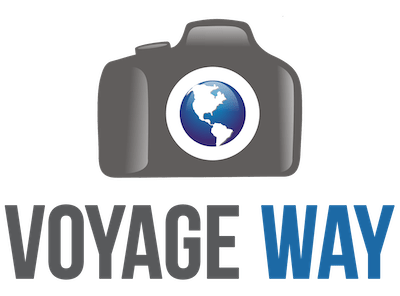
Accueil » Destinations » Norvège » Îles Lofoten en Norvège
Îles Lofoten en Norvège
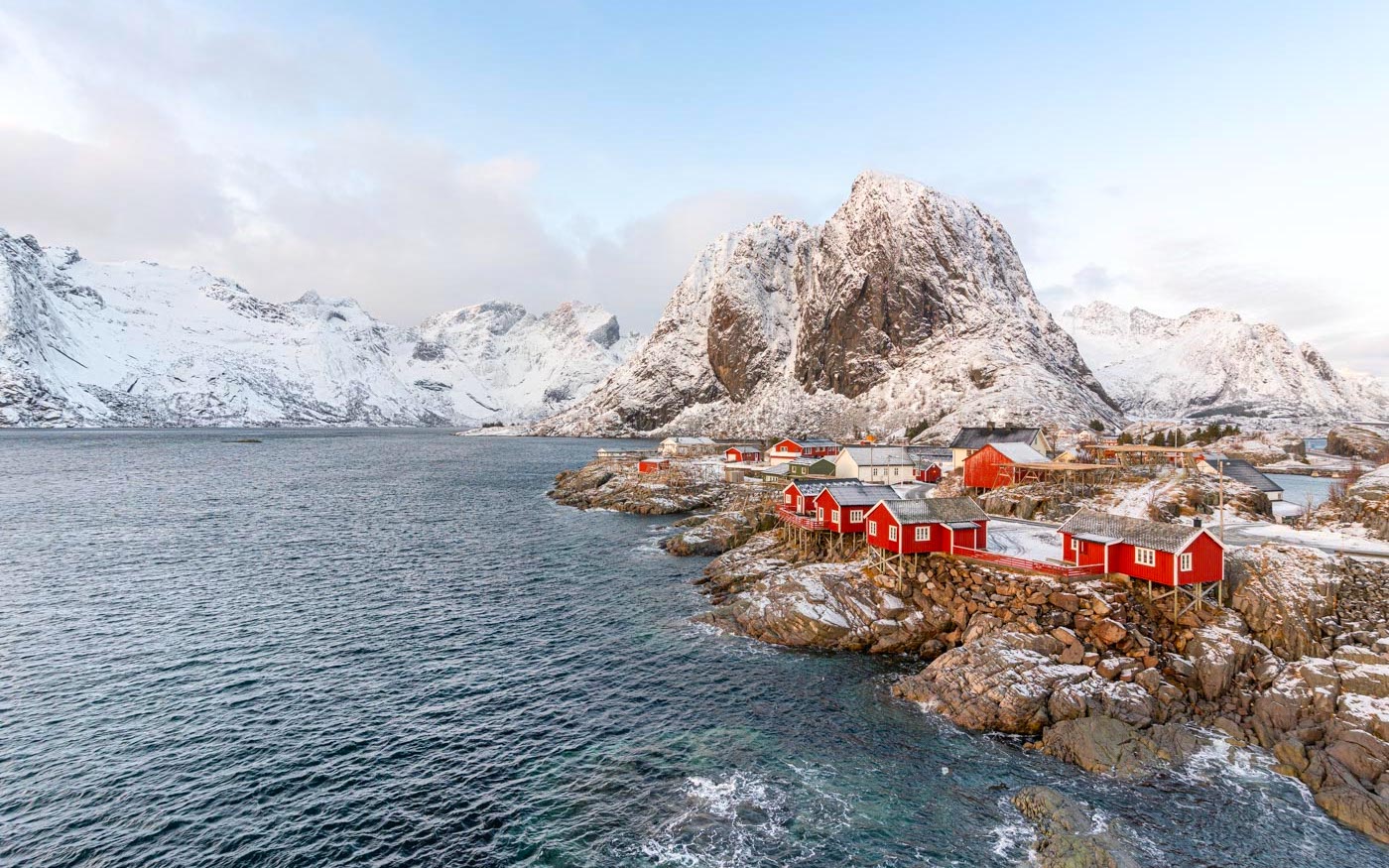
Les îles Lofoten figurent parmi les plus beaux endroits de Norvège. Un road trip aux Lofoten est clairement le meilleur moyen de profiter des paysages magnifiques et des randonnées possibles dans l’archipel.
Dans ce guide pour visiter les îles Lofoten en Norvège, vous devriez trouver tout ce qu’il faut savoir pour préparer votre voyage. Nous allons évoquer les aspects pratiques : quand partir, comment s’y rendre ou encore l’hébergement. Mais bien évidemment, nous aborderons également les choses à faire dans cet archipel norvégien : lieux d’intérêt du tourisme, randonnées, activités possibles, …
Je partagerai également une carte qui vous permettra de situer tous les villages ou endroits à voir. Et cela vous permettra également de mieux planifier l’itinéraire de votre road trip dans l’archipel des Lofoten.
Carte de l’archipel des Lofoten
Comment s’y rendre , comment visiter les lofoten : opter pour un road trip, location de voiture, hébergement dans l’archipel des lofoten, svolvær, plus grande ville de l’archipel, henningsvær, unstad, spot de surf dans les îles lofoten, uttakleiv et haukland, 2 magnifiques plages, nusfjord, un sublime village de pêcheurs des îles lofoten, flakstad & ramberg, des villages & plages à voir, fredvang et la plage de kvalvika, hamnøy, l’un des spots les plus photogéniques des lofoten, reine, l’un des plus beaux villages des îles lofoten, moskenes et sørvågen, å, la commune la plus au sud de l’archipel des lofoten, randonnées dans les lofoten : l’activité phare en été, voir des aigles de mer lors d’une sortie en mer à trollfjord, faire du surf dans l’archipel, observer les aurores boréales dans les lofoten en hiver, kayak dans les îles lofoten, faire une sortie photo pour voir les plus beaux spots, quand partir dans les îles lofoten , quel budget prévoir pour son voyage , combien de jours pour un road trip dans les lofoten, îles lofoten en norvège, un archipel magnifique au nord du cercle arctique.
L’archipel des Lofoten se trouve en Norvège, à environ 300 kilomètres au nord du cercle arctique. Ces îles s’étendent entre entre le 67ème et le 68ème parallèle nord. Elles se situent dans le comté de Nordland.
Il est composé de nombreuses îles, de tailles très variées. Parfois de petits îlots rocheux non habités et d’autres îles bien plus grandes comme Austvågøya, plus grande île de l’archipel et qui dépasse les 500 kilomètres carrés.
Parmi les principales îles des Lofoten, on trouve :
- Austvågøya qui est la plus grande île (525 kilomètres carrés environ). Svolvær, plus grande ville de l’archipel, se trouve sur cette île
- Gimsøya , une île plus petite, nichée entre les 2 plus grandes
- Vestvågøya , île de Våg occidentale, seconde plus grande de l’archipel. La seconde plus grande ville, Leknes, se trouve sur cette île
- Flakstadøya , île de Flakstad
- Moskenesøya , la plus éloignée du continent, surement la plus sauvage également car une bonne partie de l’île est difficilement accessibles. Plusieurs des plus beaux endroits des Lofoten se trouvent ici. Comme les villages de Å, Reine ou Hamnøy
Les principales sont reliées par une route, la route E10, qui permet de les traverser sans devoir prendre un ferry. Il est donc fort probable que votre itinéraire ne vous pousse pas à prendre un ferry. Dans sa longueur, l’archipel s’étend sur un peu plus de 150 kilomètres. Au delà des ses îles principales, il est également composé de nombreuses petites îles, habitées ou non. On peut notamment citer Værøya et l’archipel de Røst (Røstlandet) à l’ouest.
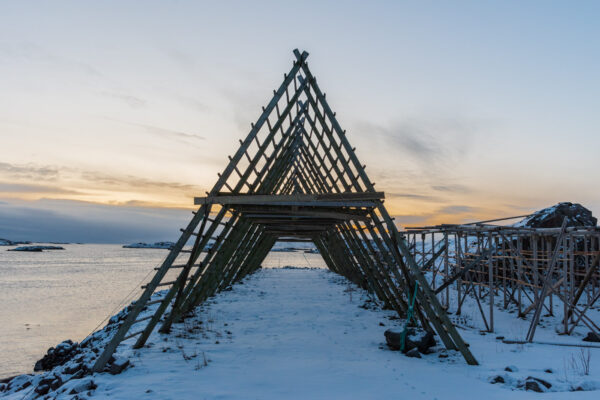
On recense environ 25 000 habitants sur l’archipel. Ce qui est très peu mais qui s’explique en partie par les reliefs très escarpés. On ne trouve pas de grande ville dans la région. Historiquement, la pêche a toujours été l’activité économique principale de l’archipel. Elle occupe toujours une place importante d’ailleurs. Et désormais, le tourisme est également une activité majeure dans la région.
Contrairement aux idées reçues, les températures dans les îles Lofoten en hiver ne sont pas forcément très basses. Le mercure oscille généralement entre -2 et 1 ou 2 degrés lors des mois d’hiver. Cette douceur (relative) est principalement liée à l’influence du Gulf Stream. Néanmoins, en automne et en hiver, le climat reste rude notamment avec neige et vent fort qui frappent souvent cette partie de la Norvège.
Pour mieux comprendre sa géographie mais aussi la localisation des principales villes et villages, je partage ici une carte des îles Lofoten. Cela vous permettra de voir où se trouve les principaux lieux d’intérêt et donc de planifier plus facilement l’itinéraire de votre voyage.
Visiter les Lofoten : bien préparer son voyage
Avant de parler en détails des endroits à voir, il m’apparait utile d’évoquer quelques aspects pratiques. Les thèmes que je vais évoquer ici sont, à mon avis, des questions que tout voyageur se posera avant de planifier un voyage ou un road trip dans les Lofoten en Norvège.
Cette partie du billet devrait vous permettre de planifier les grandes lignes de votre périple : transport, hébergement, choix du mode de voyage, itinéraire, …
Plusieurs options sont possibles pour aller aux îles Lofoten. Certains pourront s’y rendre au cours d’un road trip en Norvège qui ne se limitera pas à l’archipel.
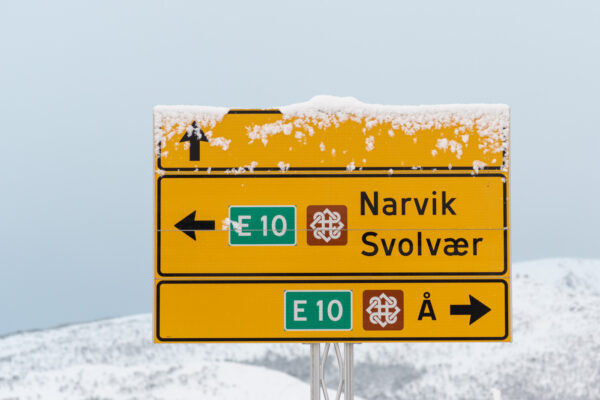
Mais pour la majorité des voyageurs, les îles Lofoten constituent un voyage à part entière. Il faut dire qu’il y a de quoi faire, nous le verrons sur le blog. Dans ce cas, plusieurs aéroports d’arrivée sont à envisager pour s’y rendre. Il y a en 2 au sein même de l’archipel, à Leknes et Svolvær, les 2 plus grandes villes. Mais aussi 2 autres à proximité mais en dehors de l’archipel : Narvik et Bodø.
Bien évidemment, se rendre aux Lofoten en arrivant dans un aéroport de l’archipel est plus pratique. Mais les billets d’avion peuvent être plus chers (et correspondance plus longue). Mais comme souvent pour les billets d’avion, des concessions peuvent être à faire en fonction du budget & prix du billet. Dans un premier temps, vous pouvez comparer les prix en utilisant Skyscanner , l’un des meilleurs comparateurs.
Et pour en savoir plus sur le sujet, je vous invite à consulter mon article intitulé quel aéroport pour les Lofoten ? J’y parle des avantages / inconvénients des 4 aéroports que l’on peut choisir.
Une fois le billet en poche, la question qui se pose est : comment visiter les Lofoten. Et là, il n’y a pour moi aucun doute à avoir, il faut opter pour un road trip. C’est clairement le meilleur mode de voyage pour en profiter pleinement.
Même si des bus existent, notamment sur la route E10 qui traverse l’archipel, la fréquence est basse. Et un voyage dans ce coin de la Norvège, c’est aussi s’arrêter à de nombreux endroits pour profiter de panoramas magiques. En bus, c’est forcément impossible. Et du coup, vous allez devoir vous limiter dans les endroits à voir : étape de village en village principalement. Découvrir les Lofoten sans voiture n’est clairement pas la meilleure option à mon avis.
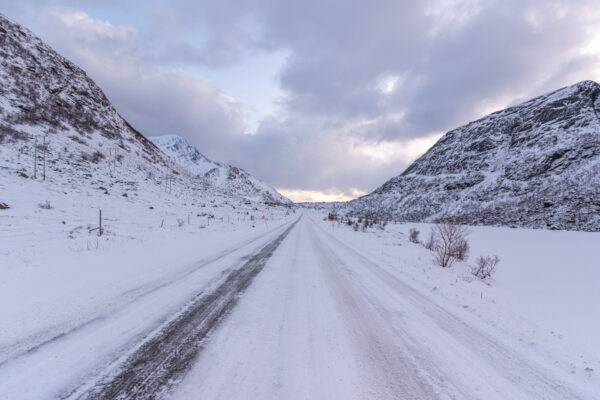
Il est donc clairement préférable de planifier un road trip dans les Lofoten. Concernant le type de véhicule, voiture ou camping-car, c’est une question de choix ! Les 2 sont tout à fait envisageables, la Norvège étant un pays qui se prête parfaitement au camping-car.
Définir les différente étapes d’un itinéraire est assez facile car vous resterez toujours à proximité de la route E10. Il suffit de choisir 2 ou 3 points de chute pour se loger en fonction de la durée du séjour.
Pour louer votre voiture, je vous conseille de passer par RentalCars . Ce site permet de comparer les tarifs de tous les grands loueurs implantés là où vous comptez arriver. Il permet également de bénéficier d’un tarif négocié. En d’autres termes, réserver votre location de voiture sur RentalCars vous coûtera moins cher que si vous faites la même réservation en direct auprès du loueur.
Il faut savoir que les grandes sociétés de location sont implantées dans tous les aéroports cités ci-dessus. Quelque soit votre lieu d’arrivée dans l’archipel, vous pourrez donc directement récupérer votre véhicule de location à l’aéroport. Il faut à mon avis louer la voiture sur l’intégralité du séjour, de votre atterrissage jusqu’au vol retour !
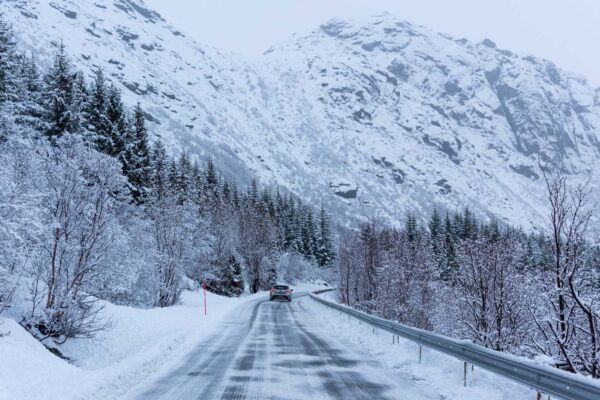
Le camping-car est une excellente option pour visiter les îles Lofoten. Même si le prix de la location peut paraitre élevé, on se rend rapidement compte que cela peut être un bon plan lorsque l’on voit le tarif des hébergements.
A noter, conduire ici en hiver ne présente aucune difficulté particulière. Il convient juste d’être prudent en de réduire sa vitesse en cas de chute de neige ou présence de neige au sol. Il faut savoir que les routes sont très régulièrement déneigées et que les véhicules loués sont équipés de pneus cloutés.
Si vous n’optez pas pour du camping, possible en été, ou pour un camping-car, sachez qu’il faudra prévoir un budget assez conséquent pour l’hébergement.
En dehors de quelques endroits où l’on peut trouver des hébergements à moins de 100 euros la nuit (chambre double), il n’est pas rare de devoir tabler sur un tarif à la nuitée assez élevé. Egalement, on trouve de nombreux rorbuer (pluriel de rorbu), un peu partout dans la région. Ce sont des cabanes de pêche aménagées. Y passer a minima une nuit est une expérience à vivre lors d’un road trip dans les Lofoten. Mais là encore, pour un bon rorbu avec une belle vue, il faut vite mettre 150 euros ou plus pour une nuit !
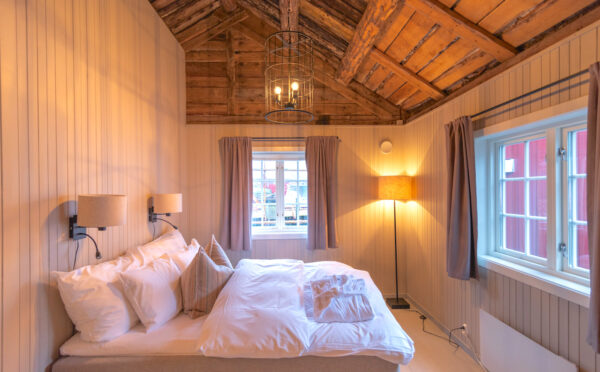
Même si les distances ne semblent pas énormes, je recommande de vraiment planifier son voyage comme un road trip avec un itinéraire et plusieurs étapes. Et donc de réserver 2 ou 3 hébergements si vous prévoyez une semaine dans l’archipel par exemple. Cela vous permettra de rayonner depuis chaque hébergement, sans devoir multiplier les kilomètres. Ceci est encore plus vrai en hiver car la météo peut générer quelques aléas sur les routes …
Voici quelques adresses que je recommande pour se loger dans les îles Lofoten :
- se loger à petit prix n’est clairement pas chose aisée ici … Parmi les hébergements les plus abordables, on peut citer le Fast Hotel à Svolvaer, le Lofoten B&B à Reine ( réservation ici ) ou encore le Sakrisøy Rorbuer qui doit être le rorbu le plus abordable de la région (ou pas loin …)
- avec un budget intermédiaire, le Lofoten Rorbuhotell ( réservation ici ) est vraiment sympa, dans le sud de l’archipel. Vous pouvez opter pour un rorbu ou pour une chambre d’hôtel classique. Dans les 2 principales villes, les hôtels Scandic offrent un bon rapport qualité / prix et un très bon petit déjeuner. Ici à Svolvaer et ici à Leknes.
- à Nusfjord, un sublime village de pêcheur, le Nusfjord Arctic Resort ( réservation ici ) offre surement les meilleurs rorbuer de l’archipel, avec un cadre absolument magique ! Une adresse magnifique, avec accès à un superbe spa (bains chauds et sauna) donnant sur la mer. Pour moi, c’est clairement le meilleur hébergement du coin !
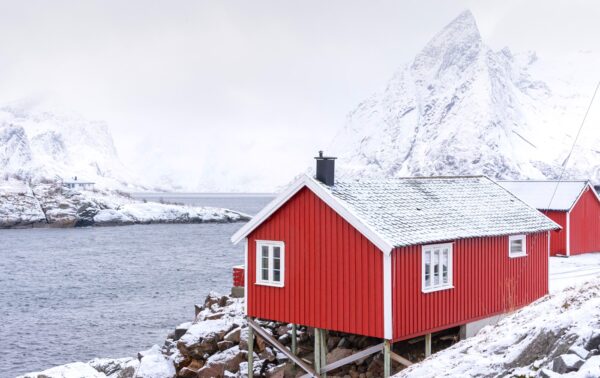
Pour en savoir plus sur les meilleurs endroits où se loger et pour avoir plus de recommandations d’hôtel ou rorbu, je vous recommande de consulter mon article consacré à l’ hébergement dans les Lofoten .
Road trip aux Lofoten : lieux d’intérêt, villes & villages à voir
Après avoir parlé rapidement de la géographie de l’archipel et des préparatifs de road trip, rentrons maintenant dans le vif du sujet. Que faire aux îles Lofoten ? Quels sont les lieux d’intérêt du tourisme dans la région ?
Dans cette partie du guide, je vais évoquer les principaux endroits à voir. Pour cela, je vais vous parler des principaux villages (et villes) en évoquant les curiosités que l’on peut y voir. J’évoquerai rapidement ici les activités à faire autour de ces lieux d’intérêt car j’y consacrerai un paragraphe dédié dans la foulée.
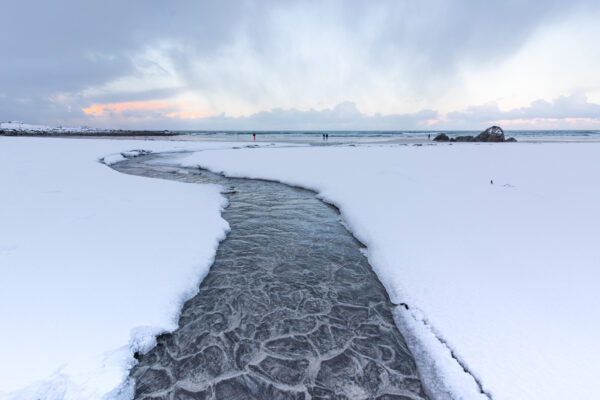
Pour faciliter la compréhension et optimiser la préparation de votre itinéraire, je vais évoquer les villes et villages de l’archipel de l’est vers l’ouest. La grande majorité d’entre eux se situent sur la route E10 ou à proximité.
Pour définir votre itinéraire de road trip dans les Lofoten, vous pouvez suivre l’ordre des lieux d’intérêt évoqués ici. Notamment si vous arrivez via l’aéroport de Narvik ou de Svolvaer. Libre à vous de supprimer / ajouter des étapes dans votre parcours en fonction de ce que vous recherchez mais aussi de la saison à laquelle vous allez y voyager.
Svolvær est la plus grande ville des îles Lofoten même si sa population ne dépasse pas les 5000 habitants. Comme indiqué plus haut dans ce guide, la ville peut être l’un des points d’arrivée dans la région. Elle marque aussi, à mon avis, la limite à l’est où l’on trouve des lieux d’intérêt pour un séjour touristique.
En effet, même si l’archipel se prolonge un peu plus vers l’est, ce n’est pas la plus belle partie à voir. Du coup, vous pouvez considérer que Svolvær est l’endroit le plus à l’est où il faut aller.
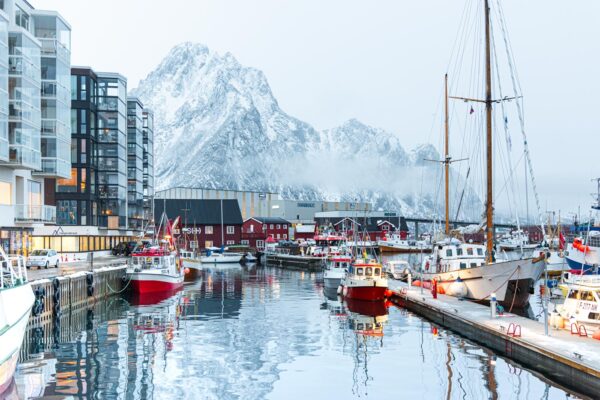
Comme partout dans ce coin de la Norvège, la ville en elle-même est petite mais charmante. Elle est entourée de montagnes et pitons rocheux que l’on peut voir d’un peu partout dans la ville. Parmi les lieux d’intérêt à voir ici, on peut noter :
- balade dans le port et sur Lamholmen (petite île où l’on trouve des rorbuer)
- Svolvær Kirke , une charmante église au coeur du centre-ville
- Fiskerkona , une statue située sur un phare à l’entrée du port
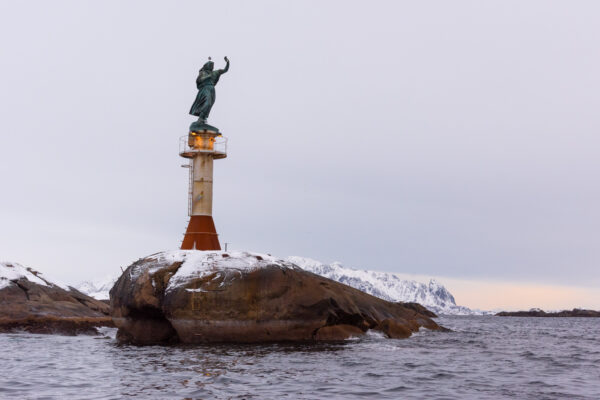
Le phare est assez éloigné du centre-ville, il est préférable d’y aller en voiture et finir le trajet à pied. Vous pouvez vous garer à proximité des séchoirs à poisson en bois, appelés hjell en norvégien. On peut en voir dans de nombreux endroits, souvent aux abords des communes. Ils servent à sécher du filets de poisson à l’air libre. Ces filets sont appelés stockfisch. C’est d’ailleurs l’une des spécialités culinaires à goûter lors d’un road trip dans les Lofoten !
Au delà de ces quelques endroits à voir, la ville est aussi le point de départ de plusieurs excursions :
- sortie en bateau vers le Trollfjord pour observer des aigles de mer ( résa ici )
- excursion pour observer des aurores boréales (de septembre à mars, réservation en ligne ici )
- sortie photo accompagnée dans les plus beaux endroits de l’archipel
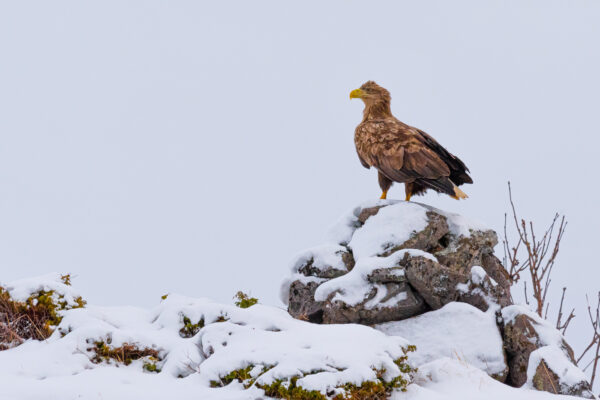
Je ne vais pas m’attarder ici sur ces activités et excursions car j’en parle en détails dans la suite de ce guide pratique. Je tiens juste à préciser ici que la première excursion pour observer les aigles de mer est à mon avis incontournable. C’est l’un de mes coups de coeur dans les îles Lofoten ! Des moments magiques, tant pour l’observation des aigles que pour les paysages magnifiques du fjord depuis le bateau.
Kabelvåg se trouve à 6 kilomètres de Svolvaer. C’est ici une courte étape à faire, non indispensabe. Si le timing de votre road trip est serré, vous pouvez faire l’impasse sur Kabelvåg. Il y a bien d’autres lieux d’intérêt à faire figurer dans votre itinéraire dans les Lofoten …
Kabelvåg est avant tout connue pour la Vågan kirke (église Vågan) qui est surnommée la cathédrale des Lofoten . Construite à la toute fin du XIXème siècle, c’est la seconde plus grande église en bois de Norvège. Il est possible de la visiter mais l’entrée coûte 40 NOK (environ 4 euros). Vous ne pourrez pas la rater car elle se trouve en bordure de la route E10, environ un kilomètre avant d’arriver dans la commune.
Au delà de l’église, il n’y a pas forcément beaucoup de choses à faire ici. On peut tout de même citer le Lofotakvariet , un aquarium. On peut aussi y voir des phoques en bord de mer, juste devant l’aquarium. La place principale et les quelques ruelles qui l’encadrent sont également agréables pour une petite balade.
Henningsvær est une étape à prévoir dans la partie nord de l’archipel. Le village se situe dans la commune de Vågan tout comme Svolvær. Toujours en direct du sud-ouest, Henningsvær se trouve à environ 25 kilomètres de Svolvær (30 minutes de route). Un court détour est à prévoir depuis l’E10, environ 10 minutes.
Henningsvær et son port se trouvent sur plusieurs îles accessibles via des ponts. Avec d’un côté la mer et de nombreuses petites îles et de l’autre une montagne, le cadre y est sublime . C’est clairement la commune le plus touristique de cette partie de l’archipel.

Parmi les endroits où aller à Henningsvær, on peut citer :
- balade au niveau du port d’Henningsvær
- Henningsvær Stadion , un stade situé au sud du village, célèbre pour sa vue aérienne
- à proximité du stade, il y a de nombreux séchoirs à poisson
- petites balades possibles autour du stade avec des vues magnifiques sur les îles proches
- on trouve 2 galeries d’art en bordure du centre (intérêt limité à mon avis …)
- randonnée de Festvagtinden pour un superbe point de vue
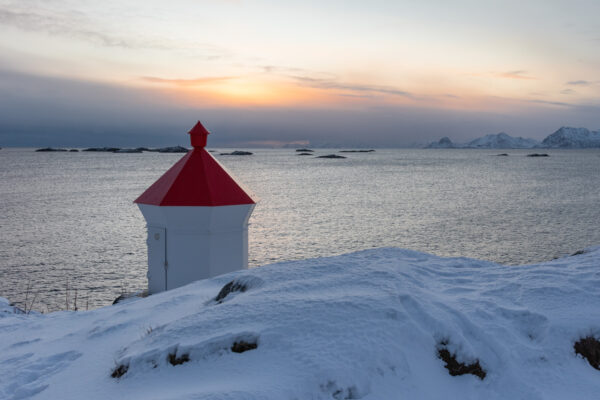
Avant de reprendre la route, vous pouvez faire une petite pause au Henningsvær Lysstøperi and Cafe . L’endroit est charmant (et réchauffe en hiver) et il y a de très bons gâteaux !

Unstad est réputé pour être le meilleur spot de surf de l’archipel. Même s’il existe quelques autres endroits où faire du surf dans la région, c’est clairement l’endroit où vivre cette expérience.
Le village et sa plage se trouvent à une dizaine de kilomètres de la route E10. Unstad se situe sur la côte nord de l’île de Vestvåg. C’est d’ailleurs un spot plutôt bon pour observer les aurores boréales (il faut une vue dégagée vers le nord). Il est assez facile de s’éloigner un peu pour éviter la pollution lumineuse.
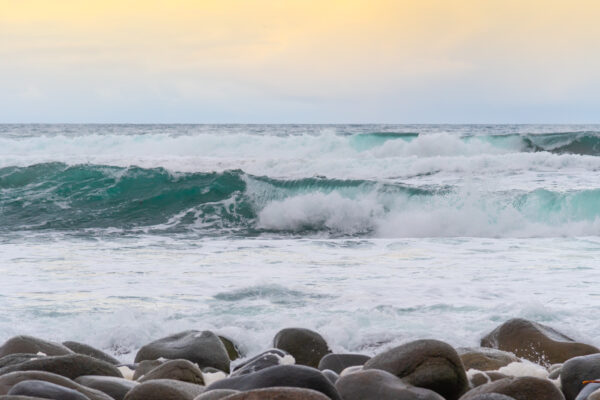
Concernant le surf, l’idéal est de loger au Unstad Arctic Surf . Proche de la plage où surfer et vous pouvez y obtenir matériel et / cours de surf. J’en reparle plus loin dans cet article, dans le paragraphe où je parle des activités à faire dans les îles Lofoten.
Pour le reste, si vous ne comptez pas faire de surf, cet endroit n’a pas de réel intérêt. En dehors peut-être de la randonnée Nonstinden qui fait une boucle autour d’Unstad (7 kilomètres, 500 mètres de dénivelé).
Au bord de la route E10, peu avant de bifurquer pour aller à Unstad, on trouve le musée viking de Lofotr. Ce musée se compose de 2 parties. Une première partie de la visite permet de voir des objets trouvés lors des fouilles sur le site viking de ce village. On peut également y voir un court film sur les vikings.
Ensuite, sur les hauteurs, on peut visiter une reconstitution de la chefferie viking, basée sur les éléments identifiés lors des fouilles archéologiques. On peut aussi y voir des reconstitutions de bateaux viking. La visite est intéressante mais le prix est assez élevé : 170 ou 200 NOK en fonction de la saison.
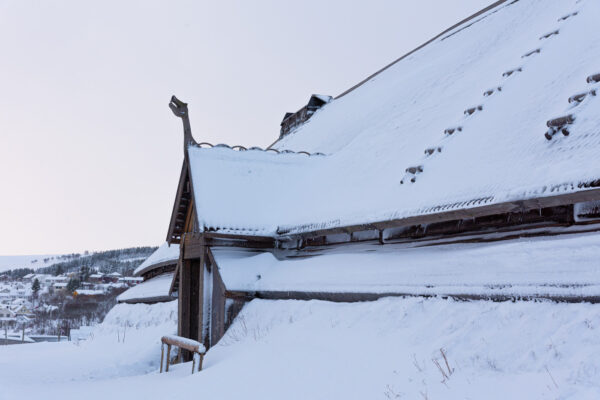
Pour plus de détails sur le musée mais aussi sur les activités proposées (principalement en été), vous pouvez consulter le site officiel ici .
Leknes se situe également sur l’île de Vestvåg. C’est la seconde plus grande ville des Lofoten. La ville n’a pas de réel intérêt même si elle peut être un bon point de chute pour une nuit ou plus. Si vous préférez avoir le choix de quelques restaurants en soirée, c’est certainement un bon endroit où séjourner. Il y plusieurs cafés et restaurants, contrairement aux plus petits villages. Et d’ailleurs, en venant de Svolvaer et du nord de l’archipel, c’est un bon endroit où passer une nuit avant de poursuivre son itinéraire vers le sud.
Surtout qu’il y a 2 endroits à voir absolument à proximité de Leknes, au nord de la ville. Ce sont les plages d’Uttakleiv et Haukland. J’en reparle plus loin. Elles se situent à 15 / 20 minutes de route de Leknes.
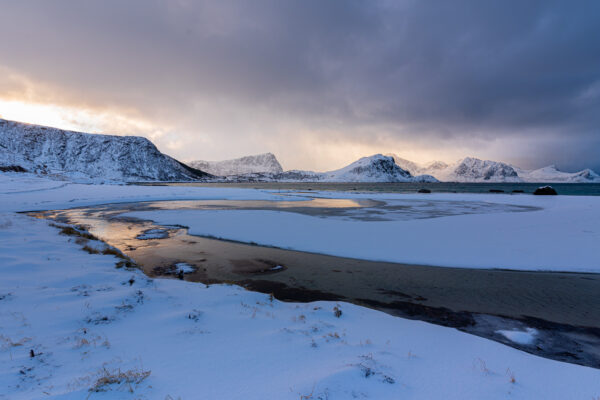
Ballstad est une petite commune située au sud de Leknes, à environ 10 kilomètres. Il ne se situe pas sur la route E10. Ce petit détour n’est pas indispensable. Même si l’on y trouve de charmants rorbuer, ce n’est pas le port de pêche le plus charmant. Il y a plusieurs entrepôts qui donnent un aspect un peu trop industriel ! On y fabrique notamment de l’huile de foie de morue.
Si vous vous y rendez, sur la route qui y mène depuis Leknes, vous pouvez vous arrêter à la Buksnes kirke, une charmante église située à Gradval. A noter, si vous comptez visiter les Lofoten en été, sachez que deux randonnées sont possibles au départ de Ballstad :
- Breidtinden (10 kms, 600 mètres de dénivelé) qui offre des paysages variés
- randonnée vers le plateau Ballstadheia (6.5 kms, dénivelé de 640 mètres)
Comme indiqué précédemment, les plages d’Uttakleiv et d’Haukland sont 2 lieux d’intérêt à voir dans les îles Lofoten. Elles sont proches et facilement accessibles depuis Leknes. Une étape à prévoir dans son itinaire de road trip avant de poursuivre vers le sud de l’archipel.
Depuis Leknes, la Hauklandstranda (plage d’Haukland) est la première à voir. Elle se trouve sur la route menant à Uttakleiv, juste avant le tunnel. La plage d’Haukland est une belle plage de sable blanc. Si la météo est clémente, vous y verrez une eau turquoise ! Et même en hiver, sous la neige, la plage ne manque pas de charme.
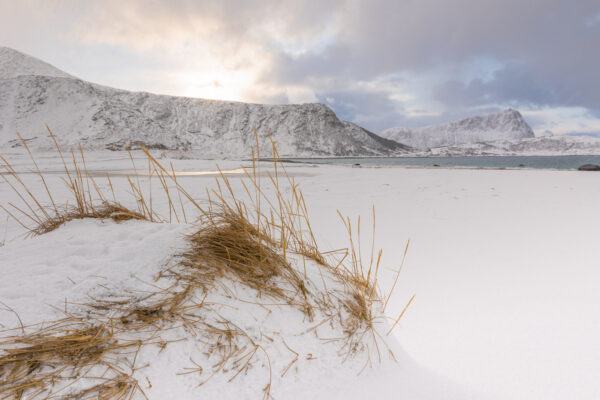
Plus loin, sur la côte nord de l’île se trouve la plage d’Uttakleiv. C’est l’un des spots les plus connus pour :
- profiter des aurores boréales en hiver
- admirer le soleil de minuit en été
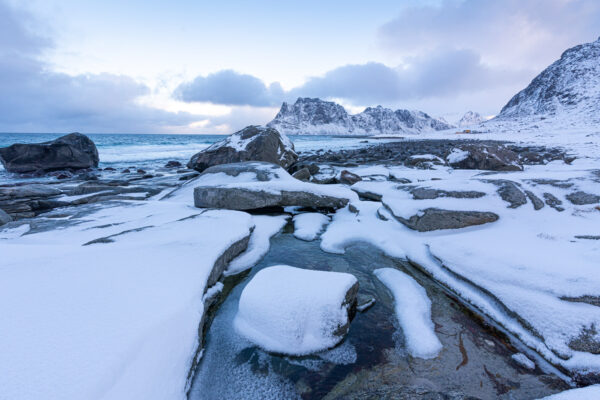
Du coup, même à 22 ou 23 heures, on y croise du monde. Quelque soit la saison ! Un bémol, le parking y est payant, même en pleine nuit … Il y a une machine où il faut payer quelques centaines de mètres avant le parking. Alternative possible en été : y aller à pied depuis la plage d’Haukland (où le parking est gratuit) via un chemin en bord de mer. Comptez 4 kilomètres de marche dans un cadre plutôt sympa.
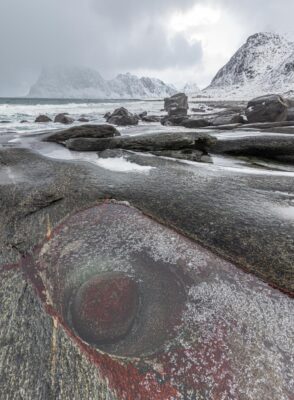
Curiosité à voir à Uttakleiv, The Eye of Uttakleiv ou l’oeil d’Uttakleiv en français. Une pierre ronde se situe dans une petite cavité remplie d’eau. Accessible uniquement à marée basse. J’ai indiqué les coordonnées GPS sur la carte partagée plus haut dans ce guide.
On quitte l’île de Vestvåg pour rejoindre Flakstadøya ou l’île de Flakstad en français. A environ 6 kilomètres au sud de la route E10, une petite route magnifique mène à un village qui l’est tout autant : Nusfjord. Même si c’est un endroit très touristique, c’est pour moi une étape à mettre dans votre itinéraire de road trip aux Lofoten.
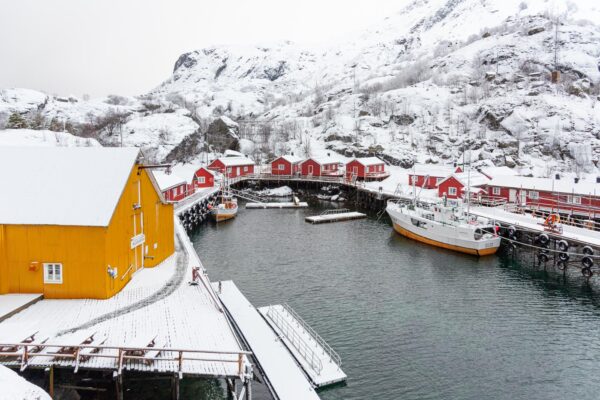
A vrai dire, le village est surtout touristique en été. L’accès y est même payant … En hiver, c’est beaucoup plus calme mais tout aussi beau. C’est aussi pour moi l’endroit à retenir en priorité pour loger dans un rorbu aux Lofoten, notamment au Nusfjord Arctic Resort . Les rorbuer qui donnent sur le fjord ou sur le port sont magnifiques. Et l’hôtel dispose d’un sauna et de bains chauds avec vue sur la mer. Magique ! L’endroit où faire un petit break lors de son voyage.
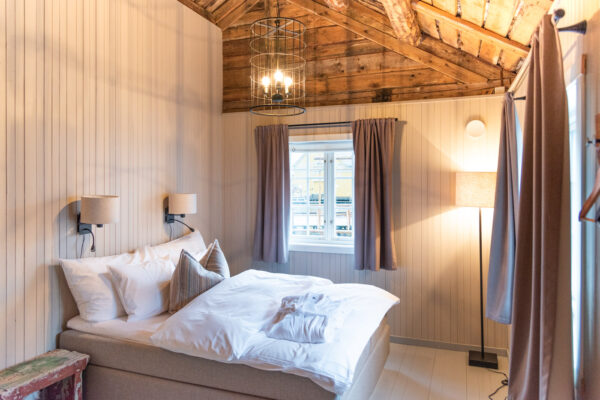
Pour le reste, une balade dans le village et ses abords s’impose. Notamment pour :
- son port de pêche
- grimper sur le rocher au bord du port pour un panorama sur le village et l’entrée du fjord
- balade dans les petites ruelles
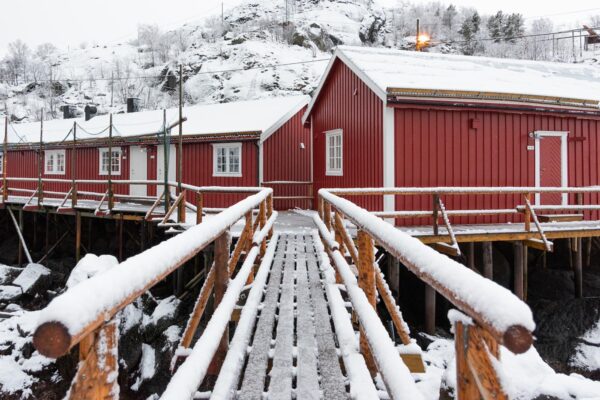
Egalement, vous pouvez aller Nusfjord Landhandel , une boutique et café / restaurant au coeur du bourg. Le cadre y est magnifique, notamment avec une superbe vue sur la mer.
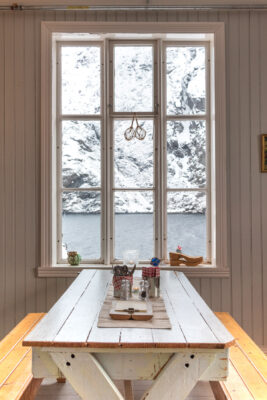
Egalement, prévoyez de nombreux arrêts photo ou simplement pour profiter des paysages sur la route entre Nusfjord et la route E10.
Toujours en continuant la route E10 vers la sud de l’archipel, des arrêts s’imposent à Flakstad et Ramberg, à quelques kilomètres de Nusfjord.
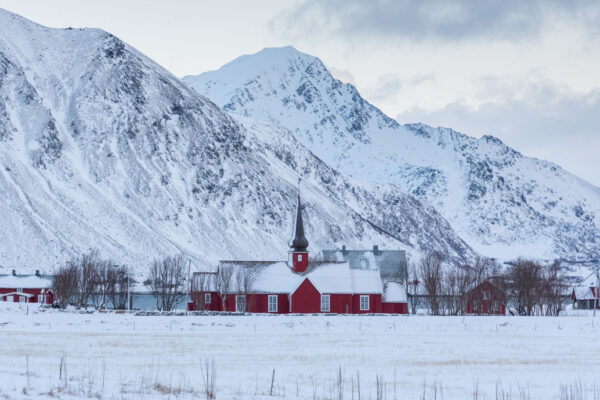
Ces 2 communes sont à proximité de plages de sable blanc. La plage de Flakstad est appelée Skagsanden . Une très belle plage entourée de montagnes. A proximité de la plage se trouve une église, la Flakstad Kirke que l’on peut voir depuis la route, dans un décor impressionnant …
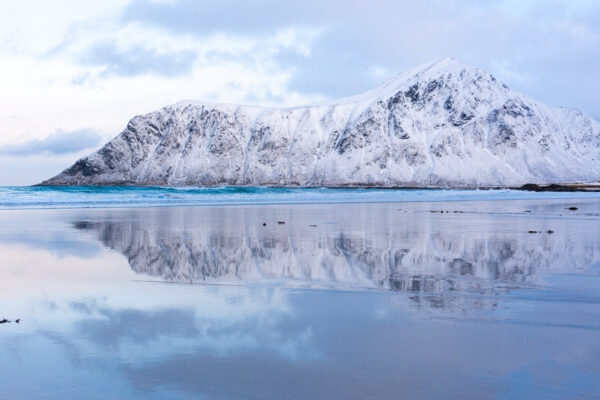
Quelques kilomètres plus loin, on trouve la Rambergstranda , plage de Ramberg. Toujours du sable blanc et encore avec une magnifique vue, notamment dans la partie la plus éloignée du village. Au bord de cette plage, on trouve un cabane de pêche rouge, particulièrement photogénique. Un spot photo très connu dans les îles Lofoten.
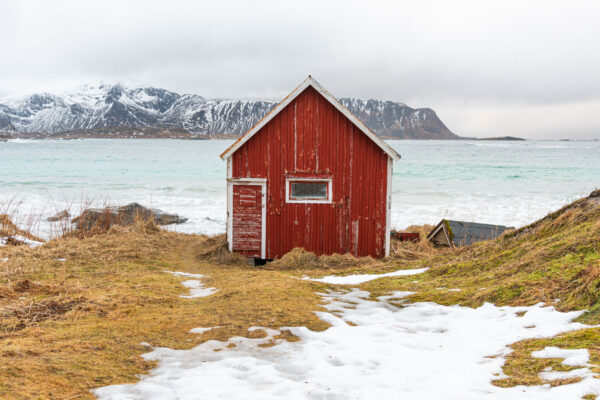
Egalement, pour profiter d’un beau panorama sur Ramberg et sa plage, vous pouvez faire la randonnée qui mène au sommet de la montagne Moltinden . A faire uniquement si la visibilité est bonne sinon la vue n’aura pas d’intérêt … La randonnée débute au coeur du village. Elle est courte mais la pente est raide : 2 kilomètres aller simple pour grimper près de 700 mètres !
Le Kafe Friisgarden , à Ramberg, est un bon endroit pour reprendre des forces après la randonnée ou après avoir bravé le froid de ces 2 plages si vous prévoyez un road trip aux Lofoten en hiver !
Fredvang en soi n’a pas de réel intérêt. Mais il y a de magnifiques endroits dans ses alentours. Quelques minutes de voiture suffisent pour s’y rendre depuis l’E10. Voici les quelques lieux d’intérêt ou randonnées possibles :
- l’incontournable randonnée qui mène à la plage de Kvalvika (et possibilité de continuer jusqu’au sommet de Ryten – au total boucle de 9 kms avec 750 mètres de dénivelé)
- plage d’ Ytresand
- d’autres randonnées sont possibles : Fuglhuken ou encore Moltinden (un autre sommet portant ce même nom)
Ces lieux d’intérêt sont à privilégier si vous prévoyez un road trip en été. Pour ces randonnées magnifiques. En hiver, il faudra se contenter de quelques points de vue. A moins d’être aguerri à la randonnée en montagne dans des conditions hivernales. Si votre timing est serré et que vous vous rendez dans les îles Lofoten en hiver, vous pouvez à mon avis ne pas inclure cette étape dans votre itinéraire.
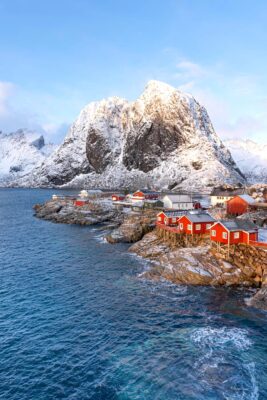
Ce village est surement l’un des plus photographié dans les îles Lofoten . Même si vous ne connaissez pas le nom, vous avez forcément déjà vu une photographie d’Hamnøy et de ses rorbuer.
Hamnøy se situe sur une presqu’île. Depuis le plus célèbre point de vue, situé sur un pont, on se rend bien compte de cette situation géographique. La presqu’île où se trouve les célèbre cabanons de pêcheurs se situe au niveau de l’entrée du Reinefjorden. Rorbu, presqu’île et montagnes, le panorama est magnifique ! Il est possible de dormir dans les rorbuer que l’on voit sur la photographie. Ce sont les Eliassen Rorbuer . Attention, lors de la réservation, tous ne se situent pas en bordure de mer. Mais c’est clairement indiqué.
Sur la presqu’île où se trouve la commune, n’hésitez pas à traverser la route pour vous approcher de la côte. On peut notamment grimper / descendre sur les rochers. Magnifique vue sur la mer et sur les îles / montagnes. Un beau spot au coucher de soleil !
Sakrisøy est un tout petit bourg qui se trouve sur une île. Là encore, l’île se trouve à l’entrée du Reinefjorden. Un court arrêt est possible ici pour profiter de la vue sur les montagnes, depuis l’île ou depuis le pont. On peut ici aussi voir de nombreux séchoirs à poisson.
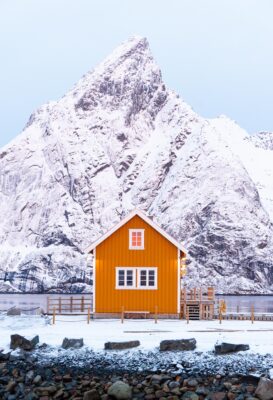
On y trouve également un bon petit café / restaurant, le Anita’s Sjømat. Et juste à côté se trouve aussi un spot photogénique avec un rorbu jaune dans un décor superbe ! Et ce rorbu est disponible à la location, il s’appelle le Olstind in Sakrisøy ( réservation ici ). Il peut accueillir jusqu’à 4 personnes. Vu sa situation et avec la vue qu’il offre depuis l’intérieur, inutile de vous dire qu’il est pris d’assaut (il est seul). Réserver plusieurs mois à l’avance est indispensable.
Quelques kilomètres plus loin se trouve Reine, l’un des plus connus dans l’archipel. Là encore, sa situation géographique contribue à son charme : un port situé sur une presqu’île, entourée par mer, îles et montagnes. Avant de quitter l’E10 pour rejoindre Reine, on peut profiter d’un beau panorama sur son centre ainsi que sur les montagnes environnantes.
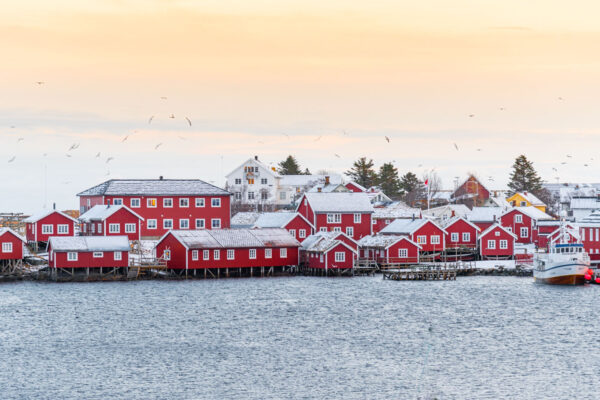
Au niveau des choses à faire ou lieux d’intérêt ici, on peut noter :
- balade dans le village
- Reine kirke , son église
- Bringen , un charmant café qui offre une superbe vue
- ascension de la Reinebringen : montagne située au sud-ouest. Ascension réputée dangereuse mais avec un panorama magnifique. 1 kilomètres aller / simple pour près 500 mètres de dénivelé. A mi-chemin entre la rando et l’escalade ;-)
- randonnée vers le sommet de Veinestinden (10 kms / 950 mètres de dénivelé), assez difficile également, elle offre l’un des plus beaux panoramas des îles Lofoten. Une vue magnifique sur le fjord de Reine
Un bateau permet de rejoindre les villages de Vinstad et Kjerkfjord depuis Reine. Il n’est pas possible de s’y rendre en voiture. Pensez à consulter les horaires de bateau et les noter. Il n’y a généralement qu’un ou deux trajets par jour !
Plusieurs randonnées y sont possibles (et magnifiques). Clairement un endroit où aller, surtout en été. Les plus belles randonnées sont les suivantes :
- plage de Bunes (depuis Vinstad)
- Brunakseltinden (depuis Vinstad également)
- randonnée entre Kjerkfjord et Selfjord
Moskenes est le village où se trouve l’embarcadère pour le ferry reliant les Lofoten à la ville de Bodø. Passage obligatoire si vous rejoignez l’archipel depuis cette ville. Pour le reste, l’endroit n’a pas de réel intérêt.
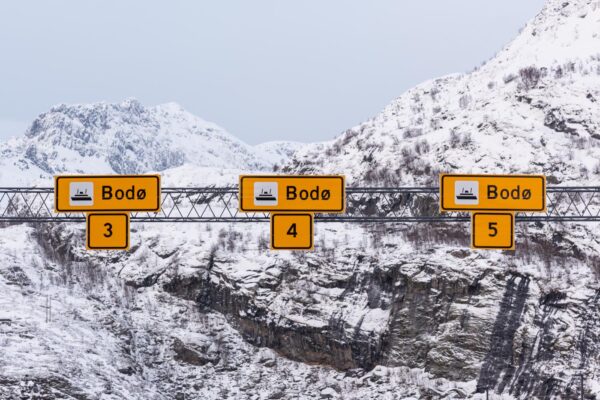
Sørvågen se situe un peu plus au sud, en direction du village de Å. On y trouve des rorbuer sympa et plus abordables qu’à Reine. Et le cadre est là encore magique !
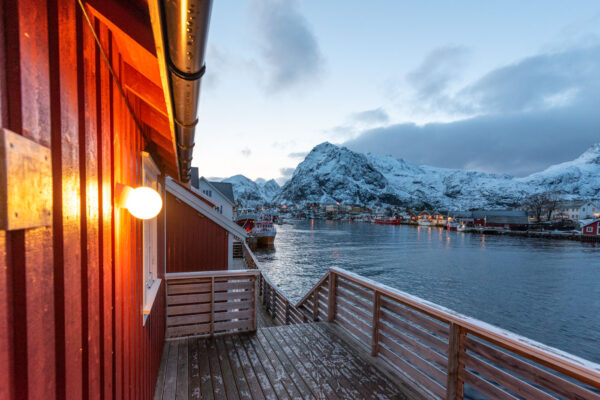
C’est aussi le point de départ de la randonnée de Tindstinden . Assez courte (un peu moins de 6 kilomètres) mais plutôt impressionnante. Au sommet, la vue sur le village de Å i Lofoten est superbe.
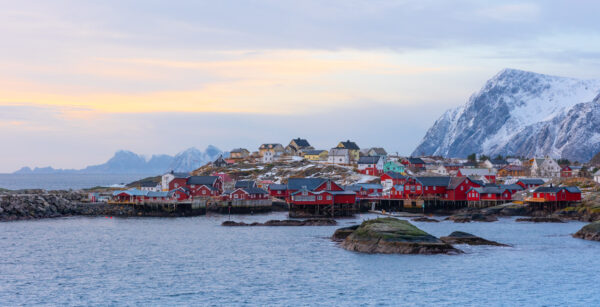
Il marquera certainement l’endroit le plus au sud de votre itinéraire de voyage, sauf si vous avez prévu de vous rendre sur l’île de Værøy mais cela nécessite de partir pour un road trip un peu plus long qu’une semaine.
Dans le village d’Å, vous pouvez visiter le Norwegian Fishing Museum . Le billet global, au tarif de 100 NOK, permet de visiter 7 bâtiments / musées situés dans le centre : maison de pêcheur, entrepôt de fabrication d’huile de foie de morue, boulangerie, atelier de fabrication de bateau, …
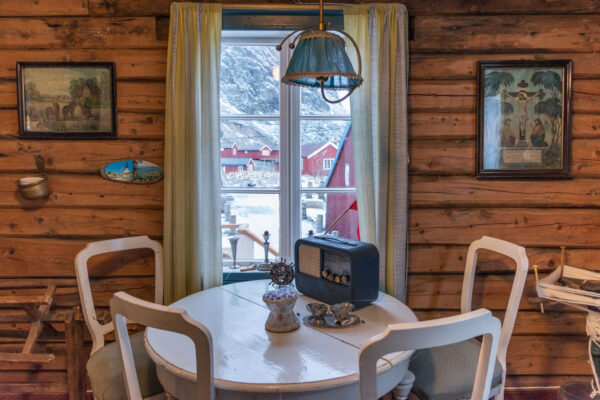
Ces visites permettent d’en savoir plus sur l’histoire de la pêche à la morue dans les Lofoten et sur le mode de vie des pêcheurs à l’époque. Une visite instructives et à faire à mon avis.
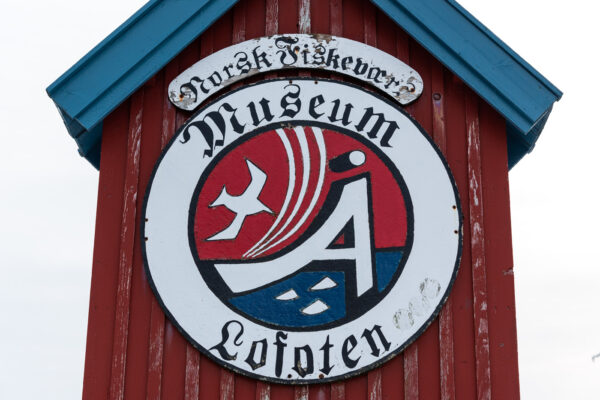
Depuis Å, deux belles randonnées sont également possibles :
- sommet d’ Andstabben qui offre un panorama dégagé sur la pointe sud de l’île de Moskenes
- lac d’Ågvatnet : randonnée possible autour du lac qui se trouve en bordure de la commune
Activités à faire lors d’un voyage dans les îles Lofoten
Au delà des balades, des arrêts photos sur les routes / plages ou de la visite des plus beaux villages, il y a encore bien d’autres choses à faire dans cet archipel de Norvège. Vous vous demandez que faire aux Lofoten ? Vous recherchez une ou plusieurs idées d’activités ?
Voici quelques idées d’activités à faire. Bien évidemment, toutes ces activités ne sont pas réalisables à longueur d’année. En fonction de la saison à laquelle vous comptez y aller : hiver ou été, une sélection s’imposera à vous. Je le préciserai systématiquement pour chaque activité / excursion afin de savoir si vous pouvez en profiter ou non en fonction de la saison durant laquelle vous prévoyez votre road trip dans les Lofoten.
Cette région de Norvège est clairement considérée comme le paradis de la randonnée. Il y en a des dizaines à faire dans l’archipel, plus ou moins longue, plus ou moins difficiles. C’est d’ailleurs l’un des atouts majeurs du tourisme dans les îles Lofoten ! Vous l’avez vu dans la partie précédente de ce guide, il y a vraiment beaucoup de rando à faire.
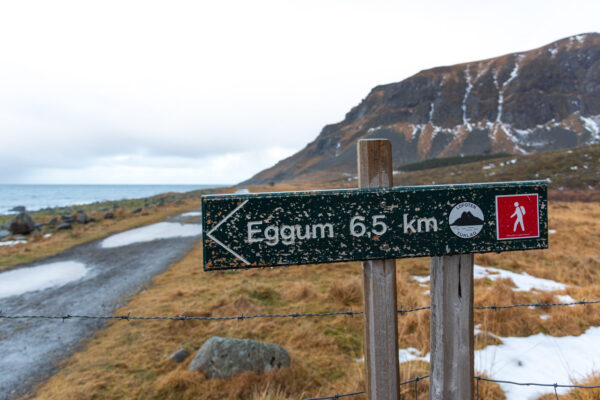
Pour profiter pleinement de la randonnée ici, il faut partir en été, entre la fin du mois de mai et le mois de septembre. Il faut savoir que jusque fin mai, bon nombre des sommets sont toujours enneigés. Ce qui complique la randonnée, du moins si l’on souhaite aller jusqu’au bout de celles qui se terminent à un sommet. Du coup, il est vraiment préférable de visiter les îles Lofoten en été si vous y allez principalement pour cela.
Dans les parties précédentes du billet, j’ai cité les principales randonnées à ne pas manquer. Il faut savoir que la plupart de ces rando demandent entre 3 et 4 heures à allure normale. Il y a bien sûr des randonnées plus longues mais déjà avec des randonnées de 3 ou 4 heures, cela occupe une bonne partie de la journée.
A noter, le terrain pouvant souvent être un peu boueux, je vous recommande de partir avec des chaussures de randonnée imperméables !
Si vous prévoyez de faire plusieurs rando lors de votre road trip, il y a un guide de voyage papier absolument indispensable. Il est entièrement consacré aux randonnées (à acheter en ligne ici ). Ce guide est entièrement dédié à la randonné.
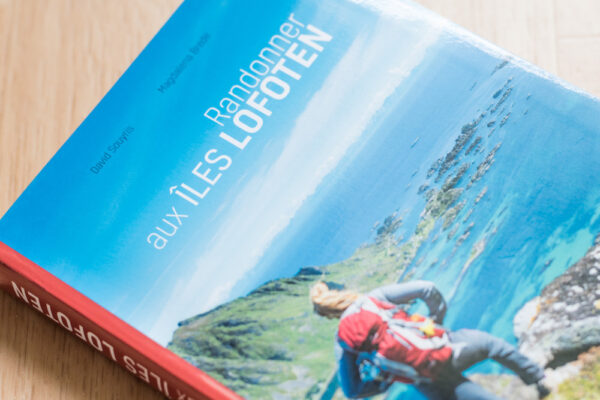
Il donne de nombreuses informations utiles sur plusieurs dizaines de randonnées : saisonnalité, distance, dénivelé, difficulté, commentaires. Ce livre ainsi que l’application Maps.me sont indispensables pour faire de la randonnée dans les Lofoten. Ou du moins très pratique ;-)
L’excursion en mer à Trollfjord est clairement une activité à faire dans les îles Lofoten. Je la recommande fortement. Cette sortie en bateau est possible toute l’année, même en hiver. Elle se fait au départ du port de Svolvær, dans le centre-ville.
Trollfjord se situe au nord-est de Svolvær. Le but principal de la sortie en bateau est d’y observer les aigles de mer. Ce sont plus précisément des pygargues à queue blanche. L’endroit est idéal pour observer ces aigles de mer. On peut en voir sur les rochers en bordure du fjord mais aussi en vol au dessus du bateau. Ou encore, en train d’attraper des poissons dans les eaux du fjord. Des moments magiques !
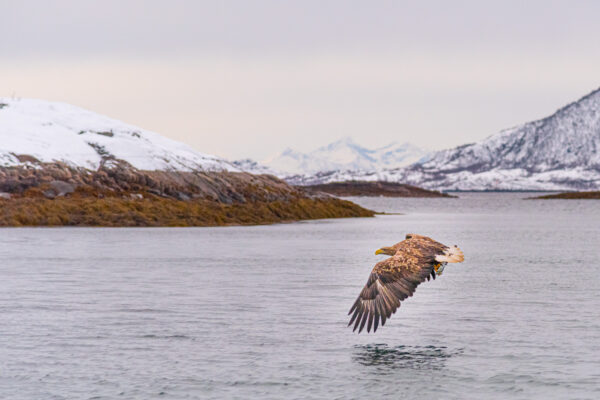
Mais au delà des aigles de mer, cette sortie en mer à Trollfjord permet de profiter des paysages magnifiques. En été ou en hiver, l’endroit est sublime !
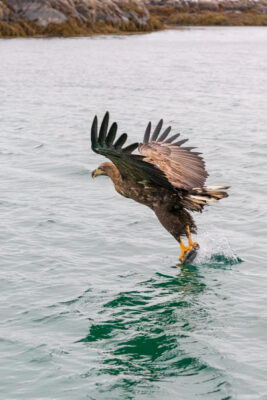
- en zodiac ( réservation ici ), toute l’année (mais pas tous les jours de la semaine en hiver)
- en bateau classique ( ici ) ou en bateau électrique ( ici ), uniquement en été et bateaux bien plus gros
J’ai fait cette excursion en hiver et donc en zodiac car c’était la seule option. Mais même en été, je recommande ce choix car il permet d’être bien plus proches des aigles ! C’est forcément plus impressionnant … La sortie en zodiac dure 2 bonnes heures alors que la croisière à Trollfjord en bateau classique durera plus longtemps, entre 3h30 et 4 heures (le bateau est bien plus lent).
Pour le zodiac, il faut arriver une demi-heure avant le départ pour se préparer. Une combinaison imperméable ainsi que gants / casques et lunettes sont fournis. Même en plein hiver, le froid ne se fait pas trop ressentir car l’équipement est top.
Pour résumer, quelque soit la saison à laquelle vous comptez faire votre road trip aux Lofoten, c’est une activité à faire absolument !
Lorsque l’on se demande que faire dans les îles Lofoten, on ne penserait pas forcément au surf. Et pourtant, c’est une activité possible ! Et même en hiver (de février à novembre, il faut tout de même qu’il fasse jour …) Le spot le plus réputé pour cela est à Unstad, au nord de Leknes.
Si vous comptez faire du surf lors de votre road trip, l’idéal est de séjourner pour une nuit (ou plus) à l’ Unstad Arctic Surf . L’établissement propose matériel (planche + combinaison) et cours de surf si nécessaire. Il se trouve à proximité immédiate de la plage la plus réputée pour le surf, Unstad strand (plage d’Unstad).
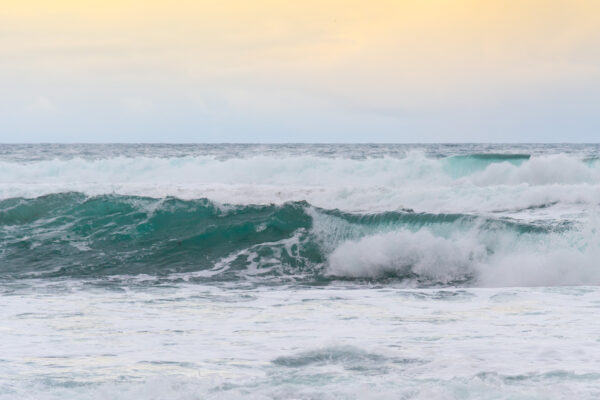
Comme je le disais, il est possible de surfer en hiver, avec potentiellement de la neige sur la plage ! Mais c’est logiquement en été (qui correspond aussi à la haute saison …) que l’on trouve le plus de surfeur à Unstad. Si vous comptez y séjourner, pensez donc à anticiper votre réservation !
Qui dit hiver dans le nord de la Norvège dit aurores boréales ! Il est possible de voir des aurores boréales aux îles Lofoten d’environ début septembre à fin mars.
Lors d’un road trip dans l’archipel, il faut souvent chercher le bon spot pour cela. En effet, avec les nombreuses montagnes, il y a souvent un ou plusieurs pitons rocheux qui cachent en bonne partie le ciel. Et il faut également fuir les éclairages qui sont nombreux dans l’archipel : villages, maisons isolées, … Même s’il n’est pas forcément le meilleur spot de Norvège pour les aurores boréales, il est tout à fait possible d’en observer. Pour identifier les zones sans couverture nuageuse, je vous recommande l’excellente site météo Yr et notamment la fonctionnalité carte qui permet d’avoir une vision globale de la météo dans la région.
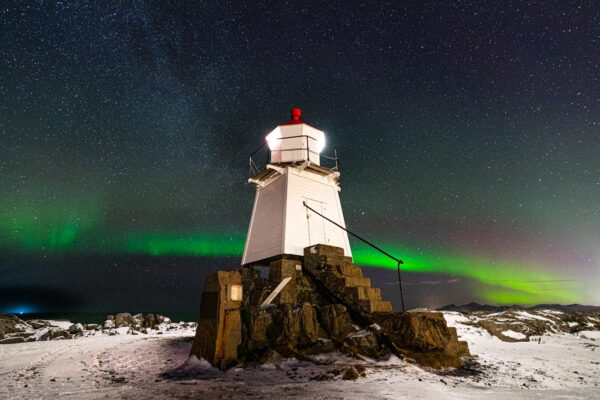
Pour cela, il faut souvent rejoindre la côte nord. En effet, les aurores boréales apparaissent à l’horizon vers le nord. Cela implique souvent de faire plusieurs kilomètres depuis les villes et villages pour se retrouver dans un endroit vierge, loin de toute source lumineuse. Parmi les plus beaux spots où observer des aurores boréales, on peut citer :
- Skagsanden beach à Flakstad
- Uttakleiv Beach au nord de Leknes, spot très connu et qui attire pas mal de monde (parking payant)
- nord de l’île de Gimsøy , notamment près du phare (cf. photo ci-dessus)
- Laukvik et Straumnes au nord de Svolvaer
Si vous ne souhaitez pas y aller par vous-même et que vous préférez passer par une excursion, sachez que cela est possible de septembre à mars, au départ de Svolvær. 2 options sont possibles :
- sortie aurore boréale de 3 heures ( ici )
- excursion de 5 heures ( ici )
Forcément, plus l’excursion est longue, plus vous pourrez profiter des aurores boréales, potentiellement dans des spots différents. Ces excursions sont à privilégier à d’autres car elles se font en petit groupe (8 personnes maximum).
Si vous souhaitez en savoir plus sur le sujet, je vous invite à lire mon article sur les aurores boréales aux îles Lofoten . J’y partage des conseils pour les observer par soi-même et pour photographier ce phénomène naturel. Je recommande également plusieurs spots où voir des aurores boréales dans l’archipel.
En été, le kayak est une activité incontournable. Il faut dire que le cadre s’y prête parfaitement bien. Et d’ailleurs, il est possible de faire du kayak à de nombreux endroits dans les îles Lofoten.
S’il y a un endroit à privilégier pour cela, c’est clairement autour de l’ île de Skrova . Cette île se situe au sud de Svolvaer. Au nord-est de cette île, les fonds sont peu profonds, notamment entre plusieurs petits îlots rocheux. L’endroit est d’ailleurs surnommé Little Hawaii … Si la météo est clémente, l’eau parait turquoise !
Pour s’y rendre, il y a des excursions au départ de Svolvaer ( résa ici ) qui incluent le trajet aller-retour en bateau ainsi que le kayak.
Si vous aimez la photographie, les îles Lofoten seront un vrai paradis pour vous ! Quelque soit la saison, l’archipel est très photogénique même si j’ai une préférence pour l’hiver. D’ailleurs, l’hiver attire de nombreux photographes, professionnels ou non.
Si vous n’avez pas forcément le temps (ou l’envie) de bien préparer votre séjour en notant les spots photo où aller (et à quel moment), une solution existe. Il existe des tours photographie qui permettent de rejoindre différents spots sur une journée. Ces excursions sont proposées au départ de Svolvær.
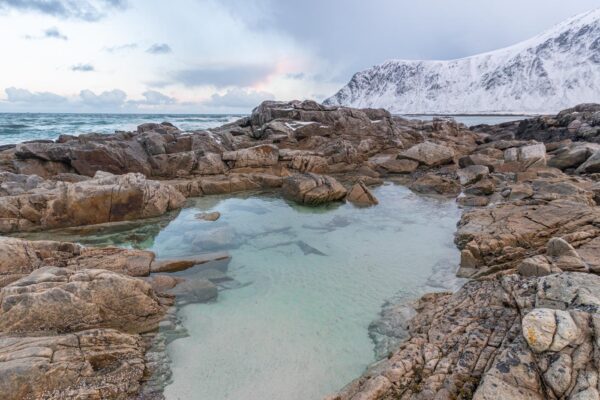
- en hiver, le tour démarre dans la matinée. Il permet de profiter d’un soleil qui rase l’horizon sur l’ensemble de la journée (si le ciel est dégagé bien évidemment …). Idéal pour les photos ! Vous pouvez le réserver en ligne ici
- en été, 2 options sont possibles. En journée ici . C’est plus ou moins l’équivalent du tour hivernal mais avec un soleil qui sera bien plus haut. Forcément. Sinon, l’alternative peut-être de réserver cette excursion ( ici ) pour photographier les Lofoten sous le soleil de minuit. Cette option est possible pour un voyage entre le début du mois de mai et la mi-août
Si vous souhaitez être accompagné ou si vous n’avez pas le temps / l’envie de repérer les spots photographie, c’est une activité à faire. Notamment si vous aimez la photo !
Informations pratiques sur l’archipel des Lofoten en Norvège
Nous avons déjà évoqué quelques points pratiques au début de ce guide pratique. Néanmoins, d’autres questions, parfois secondaires, peuvent se poser. Vous trouverez ci-dessous quelques éléments qui pourront vous être utiles pour préparer un road trip dans les Lofoten.
Bien évidemment, comme toujours sur le blog, les commentaires sont les bienvenus ! Si vous avez prévu de vous y rendre prochainement et que vous avez toujours des interrogations, n’hésitez pas à laisser un commentaire à la fin de cet article. J’y répondrai le plus rapidement possible, si la réponse ne se trouve pas ici ;-)
Le choix de la période pour un road trip est crucial. Au delà du climat sur place, il est important de savoir que les îles Lofoten offrent 2 voyages totalement différents en été et en hiver.
L’hiver est une véritable claque visuelle avec des pitons rocheux enneigés et des aurores boréales. A l’inverse, l’été rime avec randonnée et soleil de minuit. 2 expériences aux antipodes. Pour aller à l’essentiel, voici quelques éléments à avoir en tête avant de choisir la saison à laquelle se rendre dans l’archipel :
- hiver : journées courtes, paysages grandioses, possibilité de voir des aurores boréales
- été : journées très longues, multiples randonnées à faire, soleil de minuit sur juin / juillet
- les saisons intermédiaires sont à éviter car elles offrent principalement que les inconvénients
- privilégier un road trip entre fin janvier et fin mars ou entre fin mai et fin septembre
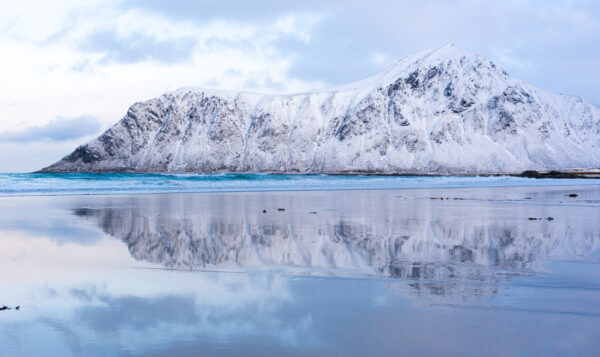
Si vous hésitez concernant le fait de visiter les Lofoten en été ou en hiver, si vous souhaitez en savoir plus sur le climat et les spécificités de chaque saison, je vous recommande de lire mon billet intitulé quand partir aux îles Lofoten . Vous y trouverez plus de conseils pour trancher sur cette question majeure.
Ce n’est pas un secret, la Norvège est un pays où le coût de la vie est assez élevé. Voire même très élevé. Et un road trip dans l’archipel des Lofoten peuvent vite coûter assez cher. Sur le blog, je ne donne jamais de budget global du type autant d’euros pour une semaine. Cela n’a aucun sens.
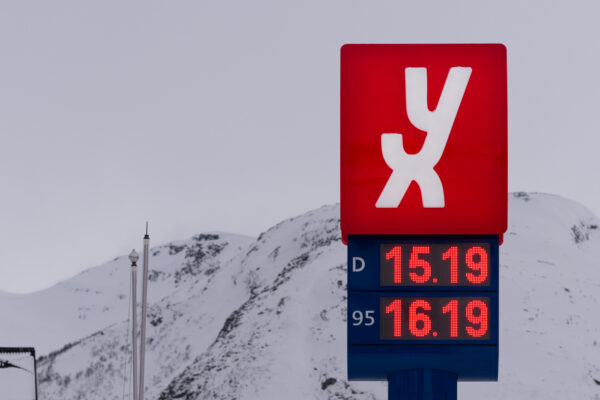
Je préfère donc vous donner quelques exemples de prix pour des dépenses à prévoir. Cela vous permettra de calculer votre budget pour les îles Lofoten :
- billet d’avion pour Leknes ou Svolvaer : 320 à 400 euros en moyenne
- billet d’avion pour l’aéroport de Narvik (à l’est de l’archipel) : 200 à 280 euros en moyenne
- péage pour le road trip : 0 NOK / aucun péage
- prix d’un litre d’essence : 16 NOK environ soit 1.60 euros
- tarif pour une location de voiture : entre 60 et 100 euros la journée (en fonction de la saison, de l’aéroport de prise en charge et de l’anticipation de votre réservation) – tarif pour un véhicule de taille intermédiaire
- nuitée dans un hébergement basique : 70 euros environ (les prix varient fortement en fonction de la saison)
- prix d’une nuit dans un hôtel de catégorie intermédiaire : 120/150 euros environ (voir 180/200 en haute saison)
- excursion en bateau à Trollfjord : environ 90 euros par personne
- sortie en kayak : environ 80 euros par personne
- prix pour un café + pâtisserie : environ 100 NOK
- un plat dans un restaurant : entre 250 et 350 NOK en général
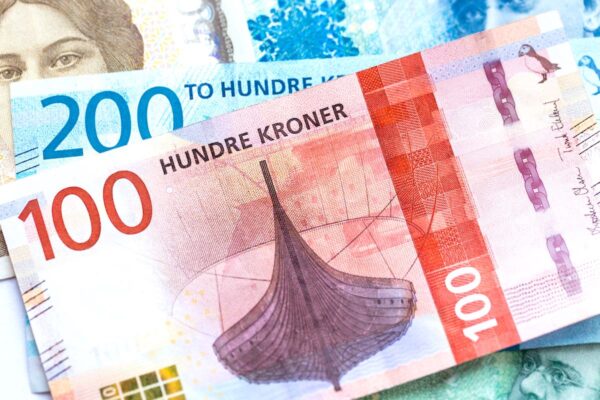
Si vous avez un petit budget, il est clairement préférable d’opter pour du camping si vous prévoyez de visiter les Lofoten en été. Vous économiserez plusieurs centaines d’euros sur l’ensemble du séjour.
Egalement, les repas dans les restaurants représentent un sacré budget sur une semaine de road trip. Pour réduire le budget, il est préférable de pique-niquer le midi (en été …). On trouve de nombreux supermarchés (horaires assez larges) dans les différents villages. Même dans les plus petites communes bien qu’ils soient plus petits. Privilégiez ceux de Leknes et Svolvaer, plus grands et avec des prix un peu plus bas.
Vous le savez très certainement, la monnaie utilisée en Norvège n’est pas l’euro mais la couronne norvégienne. Pour éviter les frais bancaires lors de votre séjour, je vous recommande d’utiliser une carte bancaire N26 ( vous pouvez l’obtenir ici ). Cette carte est gratuite, sans frais à l’ouverture ni cotisation annuelle.
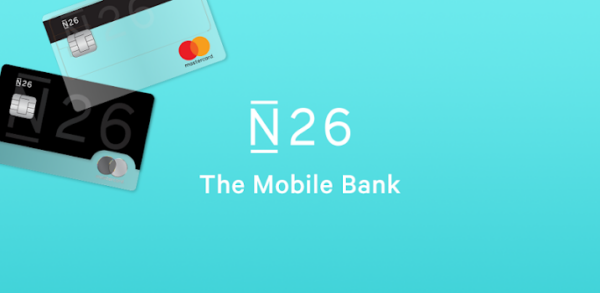
A noter, le parking est systématiquement (ou presque) payant dans les villes et villages. Je recommande d’utiliser l’application EasyPark , très pratique pour payer son stationnement depuis son smartphone. Le concept est simple, il suffit de saisir le numéro du parking ou d’utiliser la géolocalisation.
Avant de réserver son billet d’avion, une question peut se poser : combien de jours prévoir pour visiter les Lofoten. Et la réponse dépendra, à mon avis, de la saison.
En hiver, les journées sont courtes mais les randonnées ne sont pas possibles (à moins d’être expérimenté concernant la randonnée en montagne en hiver). Du coup, même si les journées sont plus courtes, il est possible de bien profiter de l’archipel sur une durée de 5 à 7 jours. Une semaine étant l’idéal pour parer aux intempéries. Il est possible d’avoir une demi-journée par-ci par-là où vous ne pourrez pas faire grand chose à cause d’une tempête de neige par exemple.
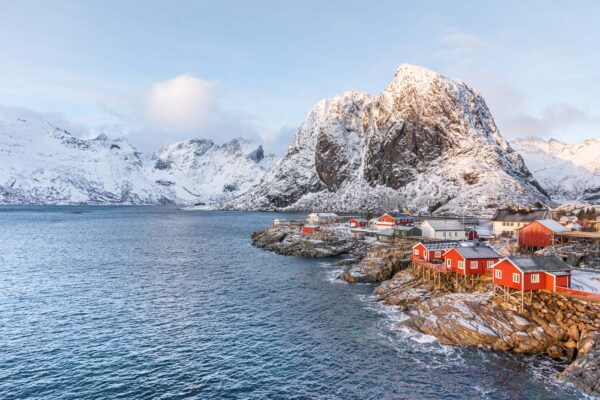
En été, même si les journées sont longues, il y a un nombre impressionnant de randonnées à faire. Vous pouvez vous baser sur 3/4 jours concernant la découverte des villages, visites de musée, … Auxquels vous pouvez ajouter ensuite le nombre de jours pour vos randonnées. A mon avis, il faut y aller pour une semaine ou plus.
Certains voyageurs s’y rendent pour une durée plus courte, 3 ou 4 jours. Notamment lorsque les îles Lofoten représentent une étape d’un périple plus long en Norvège. C’est bien dommage car sur une si courte durée, on ne fait que survoler l’archipel …
Ce guide sur les îles Lofoten en Norvège se termine. J’espère que ce billet vous donnera l’envie de planifier un road trip pour visiter les Lofoten. Que ce soit en hiver ou en été, l’archipel est magnifique. Il offre différentes expériences, en fonction de la saison de votre voyage mais aussi de vos centres d’intérêt. Planifier son itinéraire de voyage est vraiment facile, il faut juste répartir correctement le temps passé dans les différents coins, principalement en fonction des randonnées que vous comptez faire.
Cet archipel norvégien constitue un voyage à part entière. Y consacrer 2 ou 3 jours lors d’un séjour en Norvège sera à mon avis une erreur. Il y a beaucoup de choses à faire dans ces îles norvégiennes et y planifier un road trip d’une semaine (voire même plus) est tout à fait envisageable. Surtout si vous comptez partir dans l’archipel des Lofoten en été car les randonnées possibles sont très nombreuses !
Vous prévoyez d’y voyager prochainement ? Si vous avez une question ou une remarque, n’hésitez pas à commenter ce guide pratique. Je réponds rapidement aux commentaires déposés sur le blog. Et nos échanges seront peut-être utiles à d’autres lecteurs qui comptent partir en road trip aux Lofoten prochainement …
2 réflexions au sujet de “Îles Lofoten en Norvège”
Magnifique ! Les îles Lofoten me font vraiment rêver. Et tes photos sont sublimes. Voilà qui donne envie d’y aller à l’hiver prochain …
Hello, Tes photographies des Lofoten sont magnifiques. Comme une envie d’y aller en hiver du coup :) Je compte y aller cet été. Du moins c’était mon plan : 11 jours de road trip dans l’archipel. Avec l’actualité, je n’ai pas encore réservé mon vol pour ce voyage. J’attends encore quelques jours car a priori on devrait savoir bientôt si cela est possible pour cet été. Mais quand je vois les photographies des Lofoten que tu partages sur ton blog, je me dis que quoiqu’il arrive je finirai par y retourner en hiver …
Laisser un commentaire
Commentaire

IMAGES
VIDEO
COMMENTS
So it actually took us 4 days to finish a stretch of 140 miles on the E10. The lofoten National tourist route or E10 in short is the only major road that runs north to south on Lofoten islands and ends at the town of A. But there are lot of off roads that branch off E10 and we had our fair share of driving on most of them.
Svolvær is the 'capital' of the Lofoten Islands. It is the largest settlement in the archipelago, so it makes sense to begin our Lofoten road trip here. Nestled between soaring mountains and a serene harbour, this charismatic town is home to a rainbow of fishermen's cabins lining the waterfront. Spend the morning strolling around the town.
Lofoten is an all-year-round destination; however, the best time to make a Lofoten road trip is in the summer when the roads and countryside aren't cloaked with snow and driving visibility is good. Travelling to Lofoten in summer will mean not having to walk around wearing numerous layers of clothes! When I visited in July, most of the days ...
Svolvaer is the capital city of Lofoten and the gateway to Lofoten. Therefore, it is the first city you meet when driving into Lofoten and also the transportation hub. There is an airport (Svolvær Airport Helle, one of three airports in Lofoten), and the Hurtigruten stops here every day (both the southbound and northbound route) as well as ferries and speed boats.
The south of Lofoten is definitely the most beautiful. After a quick search, it looks like car rentals in Bodø and Svolvær are about the same price, starting around $100/day for the summer, whereas in the autumn they drop to $60/day. You can check the prices here.
Day 1 | Ferry Port Lodingen to Laukvika. When you leave the ferry in Lodingen on the first day of your Lofoten road trip, you turn directly onto the European road E10. This road crosses Lofoten from north to south. After about half an hour, the Norwegian Scenic Route Lofoten begins almost imperceptibly in Raftsund.
Lofoten Islands & Northern Norway: 10-14 Day Tromsø to Lofoten Road Trip Itinerary. The Lofoten Islands are located within the Arctic Circle in Northern Norway. With jaw-dropping landscapes, long stretches of white-sand beaches, narrow fjords, and small fishing villages, this is truly one of the most beautiful destinations in the entire world ...
The best time to do this Lofoten road trip is from mid-June to the end of September. In this period, the weather is the best, days are long and hiking trails are free of snow. July and August are the warmest but also the busiest months. The Midnight Sun period in Lofoten lasts from May 27 to July 17.
7 DAY ROAD TRIP IN LOFOTEN ITINERARY. Day 1 - Å i Lofoten and Lake Agvatnet. Day 2 - Tind, Sorvagen and hike to Munkebu hut. Day 3 - Reine, Sakrisøya, Hamnøy, Yttersand Beach and hike to Roren. Day 4 - Hiking to Ryten and Kvalvika Beach. Day 5 - Nusfjord - Unesco World Heritage Site, and Haukland Beach. Day 6 - Uttakleiv Beach ...
Lofoten Islands Itinerary Day 1 - Drive E10 Starting from Å to Ramberg Beach. Lofoten Islands Itinerary Day 2 - Nusfjord & Reinebringen. Lofoten Islands Itinerary Day 3 - Drive North Towards Henningsvær. Lofoten Islands Itinerary Day 4 - More Lofoten Hikes. Additional Overnight Trip to Værøy.
Planning a road trip. A road trip through Lofoten is surprisingly easy to navigate. There's just one main road linking all the islands together, the E10, with minor roads running to coastal villages and beaches. The trip from Svolvær to Å is a 128-kilometer (79-mile) drive. Although the distance seems short, your actual mileage count is ...
Lofoten Road Trip (Including Vesterålen) On this wonderful 7-day road trip itinerary, you get to experience the magic of both Lofoten's untouched beauty and the remote vistas of the nearby Vesterålen islands. Lofoten's postcard-perfect landscapes, northern lights, charming fishing villages, and awe-inspiring nature make it the perfect ...
Vestvågøya Vestvågøya is the next island in the Lofoten archipelago, accessible via the E10 road and south of Gimsøya. The island is known for having an array of different topographies and geologies. The interior of the island is composed of mostly marsh, while the north and south portions of the islands are very mountainous (the highest point being Himmeltindan at 964 meters high).
The hike to Mannen is the last hike that I recommend on my Lofoten Island road trip itinerary. It leads to a small summit with panoramic views over two beautiful beaches: Haukland and Vik. It only takes around 3 hours to get to the top and back down, so unless you have an early flight or ferry, you can easily plan this hike for your day of ...
Lofoten has always been a dream destination of mine. This archipelago on the northern end of Norway has everything I love: dramatic mountain ridges with unlimited hiking opportunities, scenic coastal views, and small towns that still feel undiscovered, which all make for the perfect road trip opportunity!
A road trip is a popular choice for exploring Lofoten. While a longer road trip around Norway is a goal of many, you'll realistically need two days just to get up to Bodø from Oslo, and that's without including any sightseeing. From Bodø, the best option for drivers is the daily car ferry to Moskenes at the western end of the archipelago.
Lofoten is a mecca for hiking, climbing, fishing, kayaking, skiing, Arctic surfing (in the summer AND winter), and cycling. The tourism scene there has a very young vibe, with lots of budget accommodation, and even the luxury accommodation markets itself towards adventure seekers.
There are plenty of different options for getting to Lofoten, and the most common ones are to travel to Bodø and take the ferry from Bodø to Svolvær or Mosknes in Lofoten. Other options are to fly directly from Bodø to Svolvær or Leknes, or to Harstad/Narvik Evenes and drive a bus or rental car from there. All these different options have ...
Day 1: Arrive in Trondheim. I love starting a trip in Trondheim, and I think it makes for the perfect introduction to Norway. The downtown area is really pretty and the Bakklandet neighborhood has those cute colorful wooden houses that Norway is known for, but it's also a proper city, which we don't really have in northern Norway (Tromsø has a population of only about 70,000 and feels ...
How to Get from Lofoten to Tromsø. Self-driving the 336 miles (540 km) from the Lofoten Islands (starting in the village of Reine) to Tromsø, the largest city in the northern region of Norway, is the most popular option for travelers looking for flexibility to explore along the way. A road trip will allow you to adventure throughout various ...
Bonjour Mushu, Je planifie avec mon épouse un road trip aux iles Lofoten, pour le mois de juin 2024, d'une durée de +/- 8 jours. Nous partirons de Bodo. Nous partirons de Bodo. Je vois que lorsque vous avez effectué votre voyage, vous avez repris la route en sens inverse lorsque vous être arrivée à Svolvaer.
Les îles Lofoten figurent parmi les plus beaux endroits de Norvège. Un road trip aux Lofoten est clairement le meilleur moyen de profiter des paysages magnifiques et des randonnées possibles dans l'archipel. Dans ce guide pour visiter les îles Lofoten en Norvège, vous devriez trouver tout ce qu'il faut savoir pour préparer votre voyage.